You will be redirected to your dashboard shortly. We will also call you back in 24 hrs .
- These Astounding Places Near Naples Will Make You Extend Your Holiday In Italy
When you think of Italy, the images that pop up in your mind are of Rome and Venice…and of course, pizza! Italy is much more than that. The little towns and cities of this wonderful country has the best of art and a stunning architecture that will blow your breath away and Naples is one such city to visit. While some might say the city is crowded, we say that is the charm of this city, and when you step out of the city, there are many more wonders that await you. There are many places near Naples that are mind-boggling and worth a visit.

Places Near Naples
When you ask us what are the best places to visit near Naples, there are so many that we can think of. But, here are a few select places that should definitely be on your itinerary when you visit Italy.

Image Source
One of the best places to see near Naples, Italy has to be this place. It is not a secret though since every tourist who visits the country, makes sure they visit the ruins. This was an ancient Roman city which was buried after a volcano erupted. But since the time it has been excavated, it has given a sneak peek into the Roman lifestyle many centuries ago; history literally comes alive here. Right from the houses they lived in, their workshops, the furniture they used, drawings on the wall, the language that they used – the entire civilization lies like an open book, for a history buff to explore.
Distance from Naples: 26 kilometres. You could either take a train to the ruins, which is the fastest and best way to travel, or look for other modes of transport.
Must Read: 9 Fabulous Places Where You Can Meet Santa Claus In Italy During Christmas
Europe Holiday Packages On TravelTriangle
Explore the most beautiful places to visit in Europe, from Paris to the Venice canals and from the Greek islands to the Swiss alps. Book customized packages by expert agents on TravelTriangle. Inclusive of airport transfers, cab, resort, sightseeing and meals. Best holiday experience Guaranteed. Book Now

Magnificent Switzerland Holiday 6D/5N Package @ Rs 69,999
Plan your trip today!

Magnificent Europe Tour 7D/6N Package @ Rs 70,975
Get quotes from multiple travel experts.
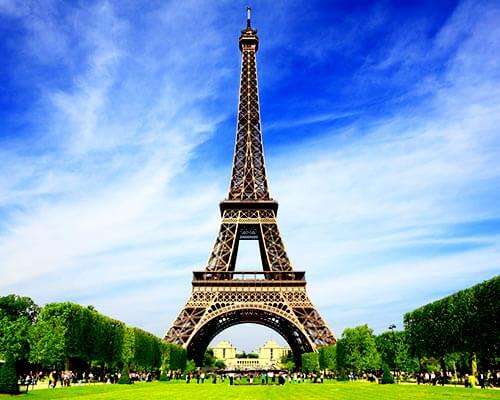
France & Switzerland Tour Package 8D/7N @ Rs 90,000
Compare & customize quotes before booking.
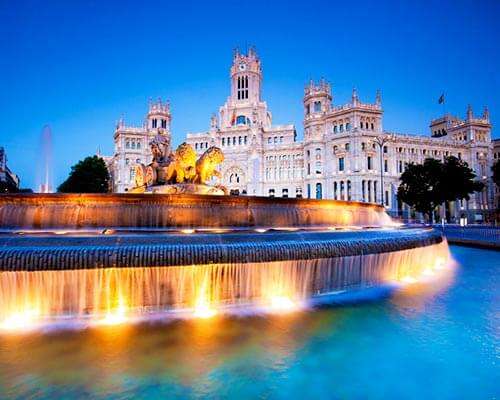
Scintillating Spain & Portugal Tour 11D/10N @ Rs 101,150
Have Questions? Talk to our travel experts today.
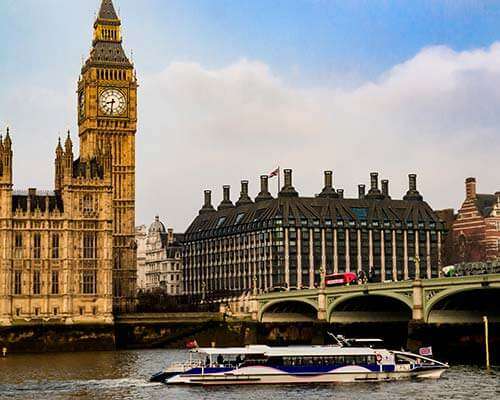
6 Country Europe Tour Package 12D/11N @ Rs 118,650
Best prices guaranteed. EMI option available.

See more at TRAVELTRIANGLE.COM
2. Mount Vesuvius
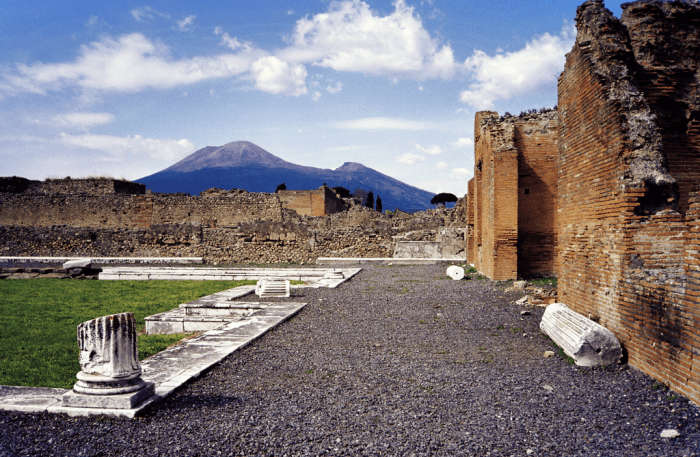
No trip is complete to Pompeii, if you have not been to Mount Vesuvius. It is thrill to hike up to the mountaintop and look down the crater; although to do that, you need an experienced guide with you. Another reason it is thrilling is because it is still an active volcano and one of the dangerous ones in the whole of Europe. But, that being said, it is also one of the most stunning mountains that you will ever lay your eyes on and the view from the top is just amazing. You can look down at the towns of Pompeii, Naples and beyond, up to Amalfi Coast – what a picturesque background would that make for a picture. Instagram-worthy, totally! The hike though is thrilling and it is worth it because of the view. It also considered the mountain that Hercules treaded. Now, who wouldn’t want to boast about climbing the mountain that the strongest man who ever lived walked on also climbed once!
Distance from Naples: 14 kilometres
Suggested Read: 12 Indian Restaurants In Italy Where You Can Satisfy Your Spice Cravings
3. The Amalfi Coast

The coast of Amalfi offers spectacular views and looks like it has jumped out of a postcard. A great place for shopping and exploring the countryside, a day-visit to the Amalfi coast is a must. Positano is the most popular town along the coast and the photo of this town, with colourful buildings is what you see as the first few images of Italy when you search for it. The place has one of the best shoemakers in the world. Yet another town that you have to visit is the small fishing village of Praiano. Why? Well, it is near to another village called Conca dei Marini, where you can take a tour of lemon groves! Yes, they do exist…and while you are at it. you can sip on some limoncello liqueur, which you will also learn how to make. With its amazing architecture and cathedrals that stand proof of it, Amalfi is definitely worth a visit. Added to that, it has some stunning beaches and colourful alleys to explore.
Distance from Naples: 61 kilometres
Suggested Read: 10 Best Beach Resorts In Italy That’ll Let You Have A Serene Vacation In This Glorious Land
4. Herculaneum
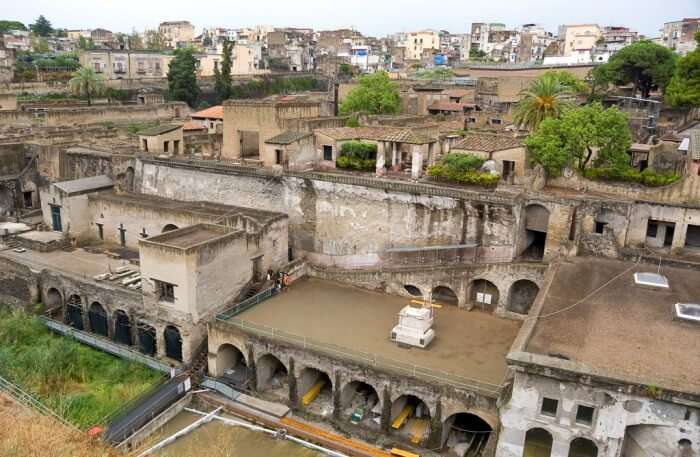
When Mount Vesuvius erupted many centuries age, Pompeii is not the only town that got buried in the lava that it spewed; the town of Herculaneum, home to Hercules, was also destroyed. This is less-crowded than Pompeii and has a wealth of knowledge to show for. It is a UNESCO world heritage site and the town is pretty much conserved to a great extent. You can see the houses and the temples of those era and revel in the architecture of the forgotten eras. The frescoes of that ear gives you a peek into the arts and culture of those times. One interesting thing that you will see when you visit this town is the Villa dei Papiri, which belonged to Julius Caesar’s father-in-law!
Distance from Naples: 12 kilometres
Suggested Read: Lake Como In Italy: Here’s Everything You Should Know Before You Head Out To Explore It
5. Sorrento
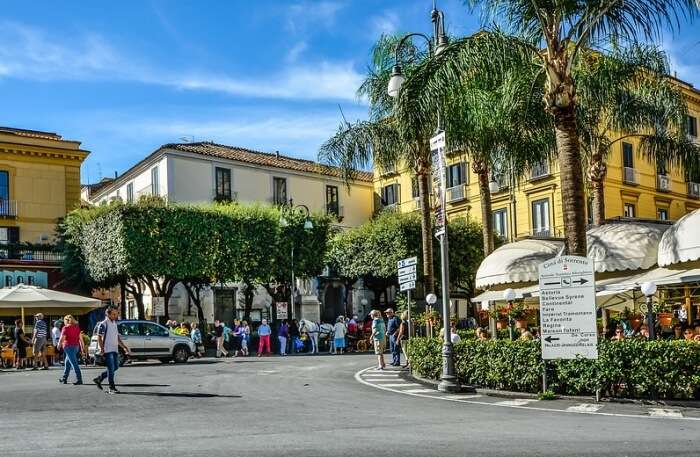
Yet another coastal town, this one is as spectacular as Amalfi and offers a lot of grandeur and architecture to marvel at. One of the places that you must stop by is Piazza Tasso. Why? Well, because it was built over one of the gorges, and these gorges have been made by streams rushing from the hills behind Sorrento. Natural wonder at its best! When you walk down to the lower end of these gorges, you can see the ruins of a water-powered mill, one of the very many that can be found in this region. There is also the Museo della Tarsia Lignea, a wood museum…isn’t that interesting! You will find some fine furniture and lots of wood-related stuff at this place. The coastal town is brimming with cathedrals and each one better than the other. So, make sure you take a complete tour of this town and take time to appreciate the architectural brilliance of these cathedrals.
Distance from Naples: 49 kilometres
Suggested Read: 9 Fabulous Places Where You Can Meet Santa Claus In Italy During Christmas
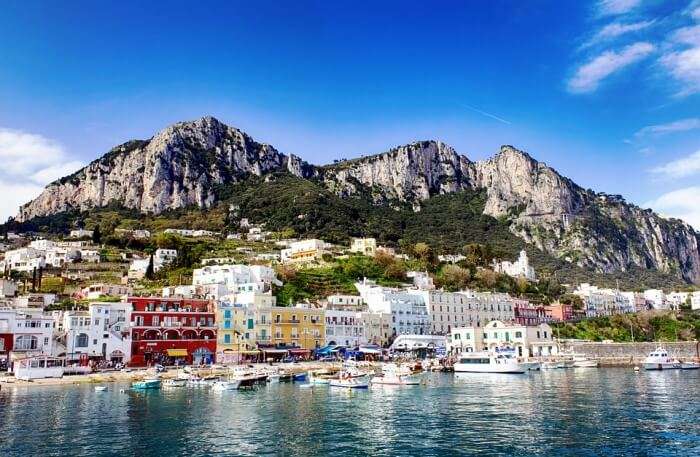
The island of Capri has so many places to see that one day is not enough; you might want to come back the next day too. Your first stop should definitely be Monte Solaro, the highest point in the whole of Capri. The views stop Monet Solaro are just spectacular, to say the least. Yet another gem of a place to visit is the grand landscapes of Villa San Michele. It was built by a Swedish physician, and has one of the most well-kept and magical gardens in the whole of Europe; there is so much greenery here that it will calm your senses and transport you to an enchanted place. Also, don’t forget to explore the underwater cave of Blue Grotto; take in all the marine life that the coastline has to offer and one that is filled with adventure.
Distance from Naples: 39 kilometres
7. Royal Palace of Caserta

This is by far one of the largest palaces in the world, or so it is said. It is as beautiful and grand as any other palaces in the world, just a whole lot bigger. The palace has four outer wings, two interiors and four huge courtyards. They have ‘royal apartments’, so many of them and each unique from the others. The frescoes, the flooring and just about everything else, gives you the sense of grandeur of a royal life. The walk from the gate to the palace is a long one, accompanied by fountains and grand statues. Do not miss this one.
Distance from Naples: 35 kilometres
Further Read: New Year In Italy: For A Refreshing Start To The Most Happening Event In This Scenic Land!
These are our picks of places near Naples that you have to definitely visit. But, there are so many more beautiful towns and islands around Naples that are waiting to be explored. So, next time you take a trip to Europe , you know where to head to!
Disclaimer: TravelTriangle claims no credit for images featured on our blog site unless otherwise noted. All visual content is copyrighted to its respectful owners. We try to link back to original sources whenever possible. If you own the rights to any of the images, and do not wish them to appear on TravelTriangle, please contact us and they will be promptly removed. We believe in providing proper attribution to the original author, artist or photographer.
Please Note: Any information published by TravelTriangle in any form of content is not intended to be a substitute for any kind of medical advice, and one must not take any action before consulting a professional medical expert of their own choice.
Frequently Asked Questions About Places Near Naples
Is Naples Italy worth visiting?
This beautiful city of Italy holds some of the most spectacular forms of art and stunning architecture which adds to the beauty and charm of this wonderful city-making is a must-visit on your Italy trip.
Where can I go from Naples for a day trip?
Here are a few amazing opportunities for your day trip from Naples: 1. Pompeii 2. Mount Vesuvius 3. Amalfi Coast 4. Capri Island 5. Ischia Island
Is Naples dangerous?
Though Naples has had a reputation of being dangerous, its absolutely safe for all tourists. The only risk that you may face would be petty theft by pickpockets.
What should I not miss in Naples Italy?
Some of the fun things to do in Naples are: 1. Climb the volcanic mountain of Mount Vesuvius 2. Go an island boat tour to Amalfi and Capri 3. Taste the finest wines at the Vineyard tour 4. Be a part of some of the most fun events and carnivals of the city. 5. Meet the wild animals at the Zoo di Napoli
Where can you swim in Naples?
Some of the best places to go swimming in Naples are Gaiola, Marechiaro, Riva Fiorita, Baia delle Rocce Verdi, and Bagno Elen.
What is Naples famous for?
Naples is known for its enchanting natural beauty, stunning architecture, most amazing food, and rich cultural history. Its deep blue oceans, Rocky mountains, Lush greenery and ruins of ancient cities attract a large number of tourists each year.
Is Naples safe at night?
Yes. Traveling in Naples at night is largely safe. However, try avoiding the Piazza Garibaldi area which is known to be a source of a number of crimes.
What is the best area to stay in Naples?
Some of the best areas to stay in Naples are: 1. Centro Storico- best for the first-timers 2. Quartieri Spagnoli- Best for a budget stay 3. Vomero- Best for nightlife 4. Piazza del Plebiscito- Best for family stay 5. Chiaia- Best for shopping
Looking To Book An International Holiday?
Book memorable holidays on TravelTriangle with 650+ verified travel agents for 65+ domestic and international destinations.

Trip to Sri Lanka at Rs 13,500/-
Plan Your Vacation Today!

Trip to Singapore at Rs 20,499/-
Get Quotes From Local Experts

Mauritius Holiday Starting at Rs 65,000/-
Talk to Our Experts Today

Maldives Honeymoon Trip at Rs 39,800/-
Pay with easy EMI Option

Europe Trip at Rs 89,999/-
All Inclusive Deals

Vacation in Dubai at Rs 27,499/-

Hong Kong Holiday at Rs 24,999/-
Money Safe Guarantee

Thailand Holiday at Rs 7,999/-
Flights Excluded

Anjana (Guest Author)
Anjana is a writer, journalist, and a full-time wallflower. She holds a Master’s degree in Media and Mass Communication and firmly believes that travel blogging is nothing less than art. Combining her love for writing with her passion for globetrotting, she brings to you some amazing tips on traveling perfectly, be it any season of the year! In her spare time, she loves reading, listening to obscure indie bands, and writing poetry – all of this while being a crazy dog lady.
Places to visit in India
- 30 Best Places To Visit In Bangalore In...
- 64 Best Places To Visit In Kerala For...
- 39 Best Places To Visit In October In...
- 101 Places To Visit In India Before You...
- 20 Places To Visit In Sakleshpur In 2024...
- 35 Exotic Places To Visit In December In...
- 32 Best Places To Visit In January In...
- 20 Best Places To Visit In Meghalaya For...
- 12 Places To Visit In Punjab To Witness...
- Unravel Places To Visit In Uttarakhand For A...
- 26 Best Places To Visit In Jammu For...
- 29 Places To Visit In Monsoon In India...
- Best Places To Visit In August In India...
- 36 Beautiful Places To Visit In Kashmir One...
- 55 Fascinating Places To Visit In Hyderabad In...
- 35 Ultimate Places To Visit In July In...
- 72 Places To Visit In Rajasthan In 2024
- 42 Best Places To Visit In Pondicherry In...
- 33 Spectacular Places To Visit In Mumbai On...
- 43 Places To Visit In West Bengal In...
- 41 Best Places To Visit In June In...
- 35 Best Places To Visit In Mysore In...
- 35 Places To Visit In Coorg For A...
- 54 Best Places To Visit In India In...
- 8 Places To Visit In Jibhi For A...
- 64 Best Tourist Places To Visit In Goa...
- 25 Best Places To Visit In Visakhapatnam In...
- 16 Places To Visit In Lucknow That Showcase...
- 60 Best Places To Visit In Kolkata That...
International Places To Visit
- 35 Best Places To Visit In Japan That...
- 40 Best Places To Visit In Canada In...
- 28 Places To Visit In October In World...
- 28 Stunning Places To Visit In South Korea...
- 25 Places To Visit In Manila In 2024...
- 19 Best Places To Visit In Morocco In...
- 34 Best Places To Visit In Austria In...
- 82 Best Places To Visit In Turkey That...
- 10 Breathtaking Places To Visit In The World...
- 22 Best Places To Visit In Netherlands: The...
- 24 Fabulous Places To Visit In Ireland: The...
- 19 Best Places To Visit In London In...
- Discover 24 Places To Visit In Switzerland In...
- 17 Mystical Places To Visit In Egypt In...
- 15 Places To Visit In United Kingdom That’ll...
- 33 Best Places To Visit In Amsterdam On...
- 19 Best Places To Visit In Kuala Lumpur...
- 42 Best Places To Visit In Bangkok In...
- 11 Popular Places To Visit In Doha For...
- 26 Places To Visit In Germany In 2024...
- 32 Places To Visit In Belgium That Make...
- 15 Places To Visit In USA That Reflect...
- 37 Best Places To Visit In Dubai At...
- 15 Top Places To Visit In Asia To...
- 20 Must-See Places To Visit In Milan In...
- Top 27 Places To Visit In Greece In...
- 31 Places To Visit In Abu Dhabi In...
- 25 Places To Visit In August In The...
- 15 Best Places To Visit In Chicago That...
- 14 Places To Visit In Berlin You Must...
Things To Do
- 40 Things To Do In Pondicherry In 2024...
- 12 Best Things To Do In Matheran In...
- 23 Intoxicating Things To Do In Turkey In...
- Top 14 Interesting Things To Do In Kanyakumari...
- 38 Things To Do In Gokarna To Escape...
- 12 Best Things To Do In Varanasi For...
- 21 Remarkable Things To Do In Krabi In...
- 16 Things To Do On Honeymoon In 2024
- 23 Things To Do In Chennai To Explore...
- 20 Things To Do In Ahmedabad For An...
- 30 Best Things To Do In Wayanad For...
- 37 Amazing Things To Do In Kerala For...
- Top 39 Things To Do In Jaipur
- 19 Things To Do In Mussoorie For A...
- 33 Best Things To Do In Kolkata In...
- Top 25 Things To Do In Kodaikanal For...
- 32 Things To Do In Ooty That Will...
- 15 Things To Do In Srinagar That Will...
- 20 Things To Do In Darjeeling
- 27 Kickass Things To Do In Malaysia
- 25 Best Things To Do In Phuket That...
- 18 Awesome Things To Do In Kasol On...
- 27 Exciting Things To Do In Chikmagalur
- 9 Things To Do In Mathura For An...
- 23 Things To Do In Lonavala For A...
- 10 Best Things To Do In Lakshadweep For...
- 30 Joyful Things To Do In Bhutan
- 38 Exhilarating Things To Do In Udaipur In...
- 18 Best Things To Do In Chandigarh
- 29 Amazing Things To Do In Shimla
- 30 Things To Do In Dehradun In 2024
- 7 Incredible Things To Do In Vrindavan For...
Recent Posts

Discover Deolali Camp A Historical Military Gem In Maharashtra In 2024

Explore The Beauty Of Bhivpuri Falls In Maharashtra In 2024

Unwind The Beauty Of The Nashik Caves On The Next Maharashtra Trip In 2024
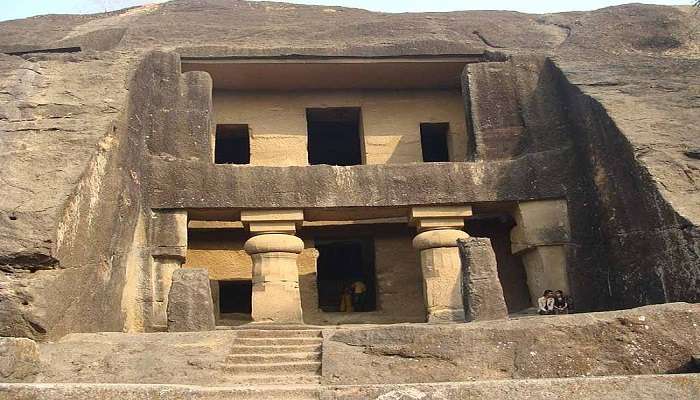
Complete Guide To Visit The Kanheri Caves In Mumbai In 2024
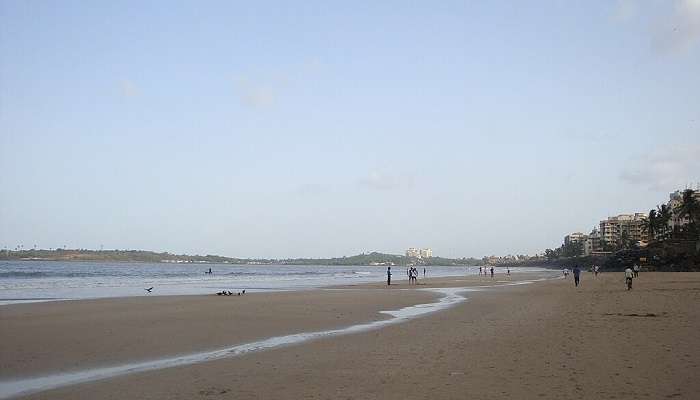
Explore Top Hotels Near Versova Beach For The Perfect Retreat In 2024

Enjoy Fun Activities And Attractions At Aksa Beach In 2024
Trending Blogs

20 Mysterious Places In India To Visit In 2024 More Bizarre Than The Bermuda Triangle

10 Scariest Roads In India That Are A Driver’s Nightmare
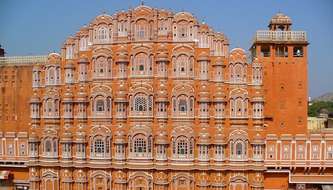
101 Places To Visit In India Before You Turn 30 in 2024

35 Exotic Places To Visit In December In India 2024 To Enjoy A Surreal Vacation

64 Top Honeymoon Destinations In India In 2024

95 Best Honeymoon Destinations In The World In 2023 For A Romantic Escape!
Best Places To Visit In India By Month
Best places to visit outside india by month.
- TravelTriangle
- Places To Visit »
- Tour Packages
- Honeymoon Packages
- Family Packages
- Budget Tour Packages
- Luxury Tour Packages
- Adventure Tour Packages
- Group Tour Packages
- Kerala Tour Packages
- Goa Tour Packages
- Andaman Tour Packages
- Sikkim Tour Packages
- Himachal Tour Packages
- Uttarakhand Tour Packages
- Rajasthan Tour Packages
- Tour Packages From Delhi
- Tour Packages From Mumbai
- Tour Packages From Bangalore
- Tour Packages From Chennai
- Tour Packages From Kolkata
- Tour Packages From Hyderabad
- Tour Packages From Ahmedabad
- Kerala Tourism
- Goa Tourism
- Sikkim Tourism
- Andaman Tourism
- Himachal Tourism
- Uttarakhand Tourism
- Rajasthan Tourism
- Hotels in Kerala
- Hotels in Goa
- Hotels in Sikkim
- Hotels in Andaman
- Hotels in Himachal
- Hotels in Uttarakhand
- Hotels in Rajasthan

Italian Coastal Town Charms – Beach Towns Near Naples [Map Plus Best Beach]
Categories Beach Travel , Towns , Travel
Top Beach Towns in Italy Nearby Naples Plus Surprising Beaches [in Naples]
Key takeaways.
- Naples and its surrounding region are known for their picturesque seaside towns , rich cultural heritage, and delicious culinary delights.
- Highlights of Sorrento include stunning Mediterranean views, vibrant local culture, and mouthwatering local cuisine.
- The coastal town of Positano is renowned for its beautiful beaches , such as Spiaggia Grande and Fornillo Beach, and its fresh seafood dishes.
- The Isle of Capri offers visitors breathtaking views, historical attractions, and the mesmerizing Blue Grotto sea cave.
- Amalfi is known for its stunning coastal views, fresh seafood cuisine, and various beach and water activities .
- Lesser-known beach towns , like Cetara and Acciaroli, offer more secluded experiences and the opportunity to encounter local artisans and experience traditional crafts.
The beach towns near Naples Italy are undoubtedly treasures waiting to be discovered. With their rich cultural heritage, stunning landscapes, and scrumptious local cuisine, these coastal gems offer a little something for every traveler seeking to experience the magic of the Mediterranean. As I venture into this enchanting region, I can’t help but wonder, what are the must-see beach towns near Naples, and what unique experiences can be found in each breathtaking destination?
![Italian Coastal Town Charms – Beach Towns Near Naples [Map Plus Best Beach] 1 man and woman kissing next to a boat in a boat dock beach area in Italy, Italian Coastal Town Charms – Beach Towns Near Naples [Map Plus Best Beach], beach towns near naples, naples beach italy, naples italy beaches, towns near naples italy, beach towns near naples italy, best beach towns near naples italy, best towns near naples italy, best beach towns near naples](https://brightswirl.com/wp-content/uploads/2023/04/Depositphotos_62099843_XL-1024x683.jpg)
What Are the 7 Best Beach Towns Near Naples?
A visit to the beach towns near Naples rewards with seven must-see locations: Sorrento, Positano, Capri, Amalfi, Cetara, Salerno, and Procida. Each town boasts its own distinct charm and attractions, ranging from ancient archaeological sites and medieval architecture to stunning coastal hikes and sun-soaked beaches. Alongside these alluring features, the regions’ delectable coastal cuisine allows visitors to indulge in an authentic taste of Southern Italy while soaking in the picturesque surroundings.
Nestled along the southern coast of Italy, the region surrounding Naples boasts an extraordinary array of picturesque seaside towns that have long captured the hearts and minds of travelers from around the world. Renowned for their striking landscapes, rich cultural heritage, and mouthwatering culinary delights, these enchanting destinations serve as an irresistible magnet for those longing to escape the mundane and embrace the freedom of life under the warm Mediterranean sun .
Table of Contents
I’ll cover in detail the stunning beauty and captivating experiences that await in each of these must-see beach towns . From island adventures and beach bliss to vibrant festivals and gastronomic delights, there is certainly no shortage of unforgettable moments to be cherished in this charming corner of the world.
So join me on this exciting expedition as we uncover the secrets of these coastal gems near Naples and learn how they can inspire dreams of boundless adventures still to come.
![Italian Coastal Town Charms – Beach Towns Near Naples [Map Plus Best Beach] 2 italian tourist town near naples](https://brightswirl.com/wp-content/uploads/2023/09/i0pla0obhq4-1024x683.jpg)
The Charm Of Sorrento
Sorrento, a beach town near Naples, Italy, is home to a vibrant and unique culture that has been shaped by centuries of history.
Visitors to the town will be able to experience stunning views of the Mediterranean, as well as the nearby islands of Capri and Ischia.
The Local Culture
Stepping into Sorrento is like stepping into a vibrant dream, where the rich local culture comes alive in every corner of this picturesque beach town .
The first thing that captures the senses here is the mouthwatering aroma of the local cuisine, which offers a delightful fusion of fresh seafood and sun-kissed fruits and vegetables.
As one wanders through the quaint cobblestone streets lined with family-run trattorias, it becomes evident that food is an integral part of Sorrentine culture and identity.
In addition to its gastronomic delights, Sorrento also boasts an array of cultural festivals throughout the year, providing visitors with unique opportunities to witness traditional music, dance, and artisanal crafts.
Indeed, there is something truly enchanting about this coastal haven near Naples – it invites one to surrender to its charms and embrace a newfound sense of freedom within its colorful embrace.
![Italian Coastal Town Charms – Beach Towns Near Naples [Map Plus Best Beach] 3 italian tourist town near naples](https://brightswirl.com/wp-content/uploads/2023/04/Depositphotos_234751786_XL-1024x683.jpg)
Stunning Views
Apart from its culinary and cultural richness, the charm of Sorrento is further amplified by the stunning views it offers. Nestled on a cliff overlooking the Tyrrhenian Sea, the town presents breathtaking sunsets that paint the sky in warm hues of orange and pink while casting a golden glow upon the waters below.
This enthralling visual experience can be best appreciated through coastal hikes along well-trodden paths that snake through lush olive groves and lemon orchards. As one ascends higher along these trails, panoramic vistas unfurl to reveal terraced vineyards cascading down into azure bays dotted with sailboats.
The captivating scenery serves as a reminder of nature’s unbridled beauty and its ability to instill a sense of liberation in those who take the time to appreciate it.
Discovering Positano
- With its many beaches, Positano offers visitors a chance to experience the Mediterranean Sea in all its glory.
- From fresh seafood to traditional Italian fare, Positano’s restaurants serve up a variety of culinary delights .
- From local artisans to high-end designer boutiques, shopping in Positano provides a unique and memorable experience.
Exploring Positano’s Beaches
The breathtaking beauty of Positano’s beaches is undeniable, drawing visitors from around the world who seek to experience its idyllic shores.
As one wanders through the charming streets of this picturesque town , there is a palpable sense of freedom and tranquility that inspires exploration beyond the ordinary.
A leisurely stroll along the coastline reveals an array of stunning beaches , each offering a unique ambiance and captivating views of the turquoise sea.
Among these must-visit spots are Spiaggia Grande, Positano’s main beach renowned for its lively atmosphere, and Fornillo Beach, a more secluded option perfect for quiet relaxation.
While embracing the sun-soaked sands and crystalline waters, travelers should relish in Positano’s rich culinary traditions by sampling local delicacies at nearby beachfront establishments.
The fresh seafood dishes are especially enticing, reflecting the essence of Mediterranean flavors and showcasing the skillful artistry behind Positano cuisine.
For those wishing to fully immerse themselves in this enchanting seaside haven, Cliffside hotels offer unparalleled accommodations with awe-inspiring vistas that elevate any holiday experience .
As one gazes out upon the vast expanse of azure waves stretching into the horizon, it becomes evident that discovering Positano’s pristine beaches is an unforgettable journey worth embarking upon.
Experiencing Positano’s Cuisine
Transitioning from the sun-kissed shores of Positano’s beaches, an exploration of the town’s culinary landscape presents a delightful opportunity to indulge in authentic Mediterranean flavors.
Positano’s specialties showcase the richness of local ingredients, with fresh seafood taking center stage in various dishes that reflect the essence of seaside living.
Unique dining experiences abound throughout this charming destination, where traditional trattorias and elegant restaurants alike offer a diverse array of gastronomic delights.
![Italian Coastal Town Charms – Beach Towns Near Naples [Map Plus Best Beach] 4 italian tourist town near naples](https://brightswirl.com/wp-content/uploads/2023/09/jx0sk5r90c8-edited.jpg)
As visitors delight their palates with exquisite tastes, they can also relish in the sense of freedom and discovery that accompanies each meal shared amidst breathtaking surroundings, further enhancing their immersion into Positano’s enchanting allure.
Shopping In Positano
Beyond the gastronomic delights that characterize Positano’s vibrant culinary scene, the town also beckons visitors to explore its rich retail offerings, presenting a unique opportunity to discover an array of treasures nestled within its picturesque streets.
Local artisans and craftsmen display their skills through exquisite creations that embody the essence of Positano’s charm, while a variety of boutiques showcase both traditional and contemporary fashion trends.
The meandering pathways that lead to these enticing establishments invite visitors on a leisurely journey, allowing them to indulge in the liberating sense of exploration as they uncover hidden gems amidst breathtaking surroundings.
This seamless integration of artistry and commerce serves as yet another facet of Positano’s enchanting allure, further captivating those who venture into this idyllic coastal haven .
Personal Thoughts and Experiences About Beach Towns Near Naples Italy
I’ve visited Italy more than 30 times and each trip was a learning experience. The majority of my trips were for business, when I worked at Nokia Mobile Phones. Over an eight year period, Italy was one of the countries in my responsibility. So, the majority of my trips were to Rome and Milan. I was on holiday once in Lido di Jesolo and I had a team meeting in Sicily. Nevertheless, I have always wanted to go and see the Cinque Terre. It is still in the plans.
If I had the opportunity to visit the beautiful beach towns near Naples, Italy, I would make sure to visit the island of Capri and Positano. I have always been fascinated by Capri’s pristine beaches, vibrant history and enchanting Blue Grotto – a mesmerizing sea cave illuminated by an ethereal blue light. I would undoubtedly embark on a boat tour of the Grotto and visit the ancient Roman palace of Villa Jovis.
In Positano, I would be excited to spend time in the famous Spiaggia Grande and Fornillo Beach , appreciating their distinct ambiance and breathtaking turquoise sea views. I would also make a point to indulge in Positano cuisine, especially trying out their fresh seafood dishes, and visit local beachfront establishments to take in the full coastal experience . Visiting the Naples Italy beaches is an ideal goal for me!
Exploring The Isle Of Capri
One of the most enchanting destinations near Naples is undoubtedly the Isle of Capri. This picturesque island boasts an array of attractions that cater to various interests, including indulging in authentic Capri cuisine, embarking on a Blue Grotto exploration, immersing oneself in the Villa Jovis history, and discovering Anacapri highlights.
The island’s rich history dates back to ancient Roman times, with evidence of this era found throughout the landscape. From breathtaking views atop Monte Solaro to the stunning gardens of Villa San Michele, Capri offers visitors an unparalleled experience filled with beauty and adventure .
![Italian Coastal Town Charms – Beach Towns Near Naples [Map Plus Best Beach] 5 Isle of Capri blue lagoon photo with pink & purple sunset, Italian Coastal Town Charms – Beach Towns Near Naples [Map Plus Best Beach], best beach towns near naples, towns near naples italy, beach towns near naples italy, best towns near naples italy, naples italy beaches, best beach towns near naples italy, naples beach italy, beach towns near naples](https://brightswirl.com/wp-content/uploads/2023/09/95f790b4-abb9-438e-a83e-825abec6af6f.jpg)
A must-see attraction on the island is the Blue Grotto, a mesmerizing sea cave illuminated by an ethereal blue light. Visitors can embark on guided boat tours that navigate through this natural wonder, providing them with unforgettable memories.
Another noteworthy site is Villa Jovis, an ancient Roman palace built by Emperor Tiberius during his reign. Today, its ruins offer insight into the island’s past while also granting panoramic views of the surrounding area.
For those seeking unique experiences, Anacapri provides a plethora of options such as chairlift adventures up Monte Solaro and exploring Axel Munthe’s exquisite Villa San Michele adorned with art and artifacts from around the world. With its captivating history and striking scenery, Capri serves as an alluring escape for those yearning to embrace freedom and wanderlust.
Relaxing In Amalfi
Exploring the coastline of Amalfi offers visitors breathtaking views of the Mediterranean Sea and the surrounding cliffs. A plethora of activities such as swimming, kayaking, and boat tours are available to those looking to explore the beautiful shoreline.
The local cuisine of Amalfi is renowned for its fresh seafood, homemade pasta, and unique flavors. Savory dishes such as the local specialty known as ‘scialatielli’, a type of spaghetti, can be found in many of the local restaurants.
The views of Amalfi are breathtaking, with the bright blue ocean, rugged cliffs, and quaint towns nestled along the coast . Many overlooks and trails offer stunning panoramic views of the area, allowing visitors a chance to take in the beauty of the Amalfi Coast .
![Italian Coastal Town Charms – Beach Towns Near Naples [Map Plus Best Beach] 6 italian tourist town near naples](https://brightswirl.com/wp-content/uploads/2023/09/d462b762-b840-449e-9ce4-e29512766486.jpg)
Exploring The Coastline
Imagine strolling through the charming streets of Amalfi, the scent of lemons and salty sea air wafting through the air as pastel-colored buildings create a picturesque backdrop.
Here’s an overview of the alluring Amalfi, a beach town located near Naples, Italy. From hidden gems along the coastline, mouthwatering cuisine, to stunning sunset views, there’s so much to enjoy. Here’s a table breaking down these experiences into three distinct categories: Coastal Exploration, Cuisine and Evening Experience.
Eating Local Cuisine
As one wanders through the picturesque streets of Amalfi, it becomes apparent that the culinary delights of this charming coastal town are as captivating as its scenic views.
Savoring seafood is an essential part of the Amalfi experience, with local fishermen providing a bounty of fresh catch daily to satisfy even the most discerning palate.
Delectable dishes such as spaghetti alla scoglio and grilled anchovies showcase the region’s culinary expertise in crafting simple yet flavorful meals that celebrate the richness of the sea.
Authentic pizzerias can also be found nestled among pastel-colored buildings, tantalizing both locals and visitors with their wood-fired creations.
The irresistible aroma of pizza Margherita adorned with juicy tomatoes, creamy mozzarella, and fragrant basil wafts through the air, effortlessly luring passersby into these gastronomic havens.
In Amalfi, indulging in exquisite local cuisine becomes an integral aspect of immersing oneself in the enchanting coastal atmosphere that so effortlessly inspires a sense of freedom and rejuvenation.
Taking In The Views
Beyond the indulgence in coastal cuisine , another quintessential aspect of the Amalfi experience is taking in its breathtaking views.
As visitors venture through the town’s winding cobblestone streets, they are often rewarded with panoramic vistas of the shimmering Mediterranean Sea, verdant mountains, and pastel-hued buildings that cling to the cliffsides.
Embarking on scenic hikes allows a deeper appreciation for the region’s natural beauty and provides a sense of escape from everyday life.
The juxtaposition of these mesmerizing landscapes and vibrant local flavors effortlessly transports visitors to an idyllic realm where freedom abounds and rejuvenation becomes inevitable.
Unwinding In Cetara
Imagine the scent of fresh lemons wafting through the air, mingling with the salty sea breeze—a delightful sensory experience that can only be found in the picturesque village of Cetara. Nestled along the Amalfi Coast , Cetara offers a serene escape from the bustling city life of Naples, providing visitors with an authentic taste of Southern Italy’s charm and warmth. The town’s rich history and cherished traditions are evident in every corner, from its medieval architecture to its vibrant local festivals.
- Lemon groves tour: Stroll through lush lemon groves, where you can learn about Cetara’s long-standing tradition of cultivating this beloved citrus fruit.
- Medieval architecture: Marvel at well-preserved historic structures, such as the Church of San Pietro, which dates back to the 10th century.
- Local festivals: Immerse yourself in Cetara’s lively celebrations, like the Festa della ‘nzalata e cacafuioco,’ which commemorates Saint Peter—patron saint of fishermen.
As one meanders through its narrow streets and alleyways lined with colorful houses, Cetara’s strong fishing traditions become apparent. The village is renowned for its exceptional seafood cuisine, particularly its anchovy-based dishes like colatura di alici—an exquisite sauce made from fermented anchovies that has been a staple in Cetara cuisine for centuries.
A visit to this enchanting coastal gem would not be complete without indulging in freshly caught seafood dishes prepared by skilled local chefs. So take a moment to unwind and immerse yourself in all that Cetara has to offer; let it serve as a reminder that freedom and tranquility can still be found amidst life’s chaos.
Experiencing The Beauty Of Salerno
Salerno’s coastline offers stunning views of the Mediterranean Sea and its various coves, making it an ideal spot for exploring and relaxing.
The city’s vibrant nightlife scene offers a variety of bars, clubs, and restaurants, creating an exciting atmosphere for visitors to enjoy .
Exploring Salerno’s Coastline
Venture off the beaten path and discover the hidden gems of Salerno’s captivating coastline; a treasure trove of serene beaches , quaint fishing villages, and mouthwatering coastal cuisine awaits.
As one strolls along the scenic shores, marvel at the stunning contrast of rugged cliffs plunging into the shimmering Mediterranean Sea, framing picturesque pebble beaches that beckon sun-seekers and water sports enthusiasts alike.
The allure of Salerno’s coastline extends beyond its natural beauty; delve into its rich history by visiting ancient ruins and charming medieval towns perched atop hillsides overlooking azure waters.
Be sure to indulge in the region’s delectable coastal cuisine, where fresh seafood takes center stage in traditional recipes passed down through generations.
From secluded coves to vibrant seaside communities, Salerno’s coastline is an enchanting escape for those seeking freedom from everyday life and a deeper connection with Italy’s cultural heritage.
Enjoying Salerno’s Nightlife
As the sun sets over Salerno’s breathtaking coastline, a different kind of beauty emerges in the form of its vibrant nightlife.
Visitors who have spent their day exploring secluded beaches and historical landmarks will find themselves drawn to the pulsating energy radiating from lively piazzas and bustling bars.
The city comes alive with an irresistible fusion of modern entertainment and timeless Italian charm.
Immerse yourself in Salerno’s thriving social scene by savoring its renowned coastal cuisine at intimate trattorias or mingling with locals at popular late-night venues.
From casual beachside lounges to sophisticated wine bars, Salerno offers a diverse array of nocturnal experiences that cater to varying tastes and moods, ensuring that each evening is as unforgettable as the last.
Venturing To Procida Island
A journey to the picturesque island of Procida, located just off the coast of Naples, promises a delightful experience for those seeking both relaxation and adventure.
Steeped in rich history and adorned with a kaleidoscope of colorful architecture, this charming destination remains largely untouched by mass tourism. Visitors are afforded an authentic taste of traditional island life while indulging in the delectable flavors of Procida cuisine.
As one wanders through the narrow cobblestone streets, it becomes apparent that fishing remains at the heart of local culture . Traditional fishing methods continue to be practiced today as they have for centuries, ensuring sustainability and preserving the island’s heritage.
Local festivals further showcase this vibrant community spirit, inviting visitors to partake in celebrations such as the Festa del Mare (Festival of the Sea) in August or Holy Week processions leading up to Easter Sunday. These unforgettable experiences provide a glimpse into Procida’s soul while simultaneously evoking a sense of freedom and liberation from everyday constraints.
What’s To See In Naples? More About This Fascinating City
- Naples is a culturally rich city with a wealth of archaeological sites such as Pompeii and Herculaneum.
- One of the most iconic attractions in Naples is Castel dell’Ovo, a medieval castle built on an islet in the Bay of Naples.
- The Amalfi Coast, known for its picturesque towns, stunning beaches and terraced vineyards, is a must-see destination near Naples.
Archaeological Sites
Imagine uncovering hidden treasures and ancient mysteries while exploring the captivating region of Naples, Italy.
This coastal area boasts numerous archaeological sites that are not to be missed by those with an insatiable curiosity about the past.
Delve into history by visiting places like Pompeii and Herculaneum, two cities frozen in time after the devastating eruption of Mount Vesuvius in 79 AD.
Marvel at their remarkably well-preserved ruins, offering a unique glimpse into Roman life from centuries ago.
Another fascinating location is the Phlegraean Fields, a volcanic area steeped in myth and history; it was believed to be the entrance to the underworld in ancient Greek mythology.
These remarkable sites stand as testaments to human ingenuity and resilience against nature’s might, awaiting visitors eager to unlock their secrets and embrace the freedom found in discovering our world’s rich heritage.
Castel Dell’ovo
Transitioning from the ancient archaeological sites of Naples, one must not miss the opportunity to explore the intriguing Castel dell’Ovo. Nestled on a small island in the picturesque Bay of Naples, this imposing fortress boasts an extensive and captivating history that dates back to Roman times.
As visitors traverse its labyrinthine corridors and ascend its towering ramparts, they will undoubtedly be enthralled by the myriad of legends that surround this storied castle. One such Castel legend speaks of a magical egg hidden within its walls which guarantees the fortress’s stability; should it break, disaster would befall not only the castle but also the city of Naples itself.
Delving deeper into Ovo history, one learns about its various transformations over time – from a lavish Roman villa to a formidable medieval stronghold used by Neapolitan rulers for both defense and governance. Today, Castel dell’Ovo stands as an emblem of freedom – beckoning travelers to embark on a journey through time and immerse themselves in the rich tapestry of history that has shaped this enchanting region.
Amalfi Coast
Continuing the exploration of Naples’ rich historical heritage, a visit to the breathtaking Amalfi Coast is an absolute must .
This UNESCO World Heritage Site, with its dramatic cliffs and azure waters, has long been a symbol of freedom and escapism for travelers seeking solace from the mundane.
Amalfi history reveals a fascinating past of maritime prowess and artistic splendor, as this once-prominent maritime republic played a crucial role in Mediterranean trade during the Middle Ages.
The coast’s picturesque villages, each with their unique character and charm, provide ample opportunity for leisurely strolls through narrow cobblestone streets lined with vibrant bougainvillea and historic landmarks.
As one ventures along this idyllic coastline, indulging in coastal cuisine becomes an integral part of the experience.
Fresh seafood, sun-ripened vegetables, and fragrant herbs form the basis of many delectable dishes that showcase the region’s culinary traditions.
With each bite, visitors are transported to a world where simplicity is key – allowing nature’s bounty to shine through every ingredient.
As such, embarking on a culinary journey through the Amalfi Coast not only satiates one’s appetite but also nourishes the soul – further solidifying its reputation as an unparalleled destination for those seeking refuge from life’s everyday constraints.
What Beach Activities Can You Do In Nearby Beach Towns?
The beaches of Naples , Italy offer a variety of activities to engage in.
From swimming and sunbathing, to boating and fishing, there is something for everyone to enjoy.
What else can you do on some of the best beaches in Naples Italy? Snorkeling, surfing, jet skiing, kayaking, windsurfing, beach volleyball , hiking, kite flying, beach picnics, shopping, and dining – there is plenty to do.
Imagine plunging into the crystal-clear waters of the Tyrrhenian Sea, surrounded by breathtaking coastal landscapes and an abundance of marine life .
The beach towns near Naples, Italy, offer numerous opportunities for swimming enthusiasts to indulge in their passion while exploring a whole new world beneath the surface.
Underwater exploration is a popular activity in this region, allowing swimmers to witness first-hand the vibrant coastal wildlife that inhabits these idyllic shores.
From gently lapping waves perfect for leisurely dips to more challenging natural pools that beckon daring adventurers, there is truly something for everyone when it comes to aquatic pursuits in these charming seaside locales.
As one immerses themselves in the refreshing embrace of the sea, they will undoubtedly be captivated by the sense of freedom and adventure that awaits them in these stunning Italian beach towns .
After indulging in the refreshing aquatic pursuits, visitors can bask in the warmth of the Mediterranean sun as they engage in a rejuvenating session of beach yoga or simply relax on the soft golden sands .
The beaches near Naples Italy offer ample opportunities for sunbathing enthusiasts to unwind and soak up some much-needed vitamin D amidst picturesque coastal landscapes.
To enhance their experience, travelers can also embark on scenic coastal hikes that reveal breathtaking views and hidden gems along the way, catering to their innate desire for freedom and exploration.
With a diverse range of activities available at these idyllic seaside destinations, there is no doubt that visitors will find an all-encompassing sense of relaxation and adventure as they immerse themselves in the beauty of nature’s offerings.
Parting Shot
Embarking on a journey to explore these enchanting small towns near Naples, Italy not only promises unforgettable experiences and captivating scenery, but also provides a unique opportunity to rekindle one’s sense of wanderlust and connect with the true spirit of Southern Italy.
As you travel from one coastal gem to another, you’ll discover the untold stories and hidden treasures that await in the lesser-explored corners and alleys of each destination. So, set sail on this adventure with an open heart and a curious mind, allowing the magic of these beach towns to captivate your senses and inspire dreams of boundless horizons that stretch far beyond the sun-kissed shores of Naples.
Frequently Asked Questions
What is the best time of year to visit these beach towns near naples, italy.
Beautiful coastal towns near Naples, Italy, such as Positano, Amalfi, Sorrento, Capri, and Ischia are worth visiting. Naples is surrounded by some of the best beaches near Naples Italy – Positano, Amalfi, Sorrento, Fornillo, Gaiola, and Grande beach.
Positano is particularly noteworthy as one of the best beach towns, offering breathtaking coastal views. For a luxurious beach experience , Naples offers several beach clubs like La Scogliera, Bagni d’Arienzo, and Lido Capri.
Are There Any Lesser-Known Beach Towns In The Area That Are Worth Exploring For A More Secluded Experience?
For a serene experience amidst nature’s splendor, explore the hidden beaches of lesser-known towns or cities near Naples, Italy, like Cetara and Acciaroli.
These destinations offer pristine shores , away from tourist crowds, and coastal hikes revealing stunning landscapes and traditional crafts. The diverse marine life in these undiscovered towns also enhance the visiting experience, offering a sense of rejuvenation and freedom sought by many travelers to Italy’s picturesque coastline .
What Local Delicacies Or Regional Foods Should Visitors Try While Visiting These Beach Towns Near Naples?
Visitors to Naples, Italy’s nearby beach towns should savor local delicacies such as fresh seafood dishes from seaside eateries and the famous thin-crust Neapolitan pizza.
The region’s culinary offerings also include creamy buffalo mozzarella from local farms, used in various pasta dishes. A tasting of the locally-produced limoncello completes this gastronomic adventure .
Are There Any Unique Festivals Or Cultural Events That Take Place In These Beach Towns Throughout The Year?
Throughout the year, the scenic coastal towns near Naples, Italy, host various unique festivals and cultural events. These activities, which include traditional performances, parades, and food and wine festivals , offer visitors a chance to immerse themselves in local customs and rich regional heritage.
Participation in these events adds depth to the travel experience and helps understand the area’s history and culture better.
What Are The Transportation Options For Getting To And Between These Beach Towns Near Naples, Italy?
Naples, Italy boasts a variety of transport options like Trenitalia and Circumvesuviana regional trains, SITA buses, Alilauro and NLG ferries, and car rentals, connecting visitors to its diverse beach towns and attractions.
These services allow tourists to enjoy beach activities , historical landmarks, coastal hikes, shopping, and art galleries conveniently and economically, although car users should be aware of narrow roads and limited parking in popular areas.
What are some beautiful Italian coastal towns near Naples?
Some beautiful Italian coastal towns near Naples include Positano, Amalfi, Sorrento, Capri, and Ischia.
Are there any beaches near Naples?
Yes, there are several beaches near Naples, including Positano beach, Amalfi beach, Sorrento beach, and Fornillo beach.
Which is the best beach town in Italy near Naples?
Positano is often considered one of the best beach towns in Italy near Naples. It offers breathtaking coastal views and a charming atmosphere.
What are the best beaches in Naples?
Some of the best beaches in Naples include Positano beach, Amalfi beach, Sorrento beach, and Fornillo beach. These beaches are known for their beautiful sandy shores and crystal-clear waters.
Which coastal town in Italy is worth visiting near Naples?
Positano is definitely worth visiting. It is a picturesque town located on the Amalfi Coast of Italy and offers stunning views of the surrounding coastline.
Can you recommend any other beautiful coastal towns in Italy?
Yes, some other beautiful coastal towns in Italy include Amalfi, Sorrento, Capri, and Ischia. Each of these towns has its own unique charm and attractions.
What are some surprising beaches in Naples?
Some surprising beaches in Naples include Gaiola beach, Grande beach, and Fornillo beach. These beaches offer a more secluded and tranquil atmosphere compared to the popular tourist beaches.
Are there any beach clubs in Naples?
Yes, there are several beach clubs in Naples where you can enjoy a luxurious beach experience . Some popular beach clubs include La Scogliera, Bagni d’Arienzo, and Lido Capri.
What are the best places to stay near Naples if I want to visit the beaches?
Some of the best places to stay near Naples if you want to visit the beaches are Positano, Amalfi, Sorrento, and Capri. These towns offer easy access to the beaches and a range of accommodation options.
Can you provide a list of the best beaches near Naples?
Yes, some of the best beaches near Naples include Positano beach, Amalfi beach, Sorrento beach, Fornillo beach, Gaiola beach, and Grande beach. These beaches are known for their beauty and crystal-clear waters .

16 of the Most Picturesque Amalfi Coast Towns in Italy
Love it? Share it!
Southern Italy is a mesmerizing heaven of beaches, lemon and orange groves, ancient ruins, and celebrity-approved romantic getaways. These beautiful Amalfi Coast towns located in the south of Naples, are still a favorite European destination for many, as they did centuries ago.
From the charming town of Positano with its cascading pastel-colored houses to the medieval streets of Amalfi, each town along the coast tells its own unique story, inviting travelers to explore and immerse themselves in its rich history and culture.
16 Beautiful Amalfi Coast Towns

Disclosure: This post contains affiliate links. If you click one of them, we may receive a small commission at no extra cost to you.
We have visited the Amalfi Coast both in the busy and off-seasons. The prices of accommodation make a huge difference when you consider when to travel, so do the crowds and weather and activities.
When planning our trips to the Amalfi Coast, we widened our base to include places like Sorrento, Salerno, and Naples. They are perfect for finding cheaper hotels as well as booking day tours (if you are not driving the coast yourself).
Planning a trip to the best towns of Amalfi Coast
There are 13 beautiful towns and villages on the Amalfi Coast : Amalfi, Atrani, Cetara, Conca de’ Marini, Furore, Maiori, Minori, Positano, Praiano, Ravello, Scala, Tramonti, and Vietri sul Mare.
Here is how you can spend one day in Amalfi , or 4 days on the Coast
Amalfi Coast Map

The largest city near the Amalfi Coast is Naples. If flying from North America, Naples is the perfect point of entry. Sorrento is a great base to stay overnight, and then take day trips from there to explore the Coast.
When traveling from Rome to the Amalfi Coast, you can also stop at historical sites such as the ancient ruins of Pompeii, Herculaneum, and Paestum.
Top Tours and Activities to take on the Amalfi Coast
- Day tour of Amalfi: Full day tour of Amalfi Coast from Naples
- Sunset Cruise: Private sunset cruise on the Amalfi Coast
- Amalfi Coast Tour: Cruise tour to the Amalfi Coast from Sorrento
- 3-day tour Amalfi Coast: 3-day tour of Amalfi Coast from Rome
- Pompeii & Vesuvius: Tour of Pompeii & Vesuvius from Naples
So here’s presenting the best 16 Amalfi Coast towns worth adding to your bucket list!
1. Sorrento
By Helga from ShegoWandering

Sorrento is one of the most beautiful, yet less crowded seaside destinations in the region of Campania. The town itself is built on top of immense cliffs, with beaches and a small port at the bottom of them.
Thanks to its location, Sorrento offers an unforgettable experience, with an amazing sunset view from Villa Comunale, over the Tyrrhenian Sea, the bay of Sorrento, and the famous volcano, Mount Vesuvius.
The town is covered in orange and lemon trees, as also the famous Limoncello drink originates from here. Sorrento offers cute beaches, like the Marina Piccola and Marina Grande. Its location makes it easy to travel to the Amalfi Coast, Pompeii, or Capri by bus or ferry boat.
Sorrento is definitely a great summer destination, which is also much more affordable than Positano for example, but it offers the same high standards. In addition, this town has great nightlife, and it’s very popular for youth as well as for families.
There are great accommodations for every budget, starting with the hostel of Le Sirene , budget-friendly resorts like Il Roseto , and 4-5 star hotel rooms with spectacular views, such as the Grand Hotel Capodimonte.
While you’re in Sorrento, you should look for traditional local restaurants to experience some of the best food in the region like the Gnocchi Alla Sorrentina, or a delicious Vesuvio pizza.
One of the best places to go is Ristorante S. Antonino, in the heart of the town. In addition to all the things to do in Sorrento , definitely try and roll in a lemon farm tour, with limoncello tasting!
- Best activities and tours in and around Sorrento: Sightseeing in Old Town Sorrent, food tours, and day trips to the Amalfi. More tours in Sorrento here
- Best hotels stay in Sorrento: Grand Hotel Capodimonte (luxury hotel) | Il Roseto (good value hotel)
2. Amalfi Town
By Stephanie from Bey of Travel
There is the Amalfi Coast and the Amalfi town. The coastline is the actual coast of Italy with the Mediterranean Sea, and the town of Amalfi is one of the many towns located in the region south of Naples.
Amalfi is the largest town on the Amalfi Coast, with a historic cathedral, a bustling main square, and the stunning mountain setting of Mount Cerreto. The town is filled with a labyrinth of streets, and you can expect a lot of walking here to explore it all.
Amalfi is a UNESCO World Heritage Site, and much of the remnants from the Byzantine times have been preserved. The Amalfi Cathedral site dates back to the 9th-10th century, and it had been renovated, added, and removed over the centuries under various rulers (and invaders).
A 20-minute drive from Amalfi is another gorgeous (and Instagrammable) town of Positano. Both these towns should be a part of your Amalfi Coast itinerary .
- Best activities and tours in Amalfi town: Amalfi Atrani 2-Hour Private Walking Tour , sightseeing, culinary
- Best hotels to stay in Amalfi Town: Terrazza Duomo (located at the town center)
3. Positano
By Anda from Travel for a While
Italy isn’t short of beautiful places to visit, and Positano is right there, at the top of the list.
Positano is one of the fishermen’s villages nestled on the stunning Amalfi Coast. It became a tourist attraction when the rich and famous discovered the colorful village spread vertically above the turquoise sea.
The place is ideal for a romantic getaway, but make your way for at least a day trip to Positano , and you’ll be impressed. You can explore the endless picturesque streets and stairs, take a million photos of the views, and watch the most beautiful sunset over the sea.
You can also spend time at the beach, take a boat tour to discover the coastline, or walk the Path of Gods near Positano and enjoy breathtaking views from 500 meters above sea level.
The time will pass quickly, even if you don’t plan an itinerary in Positano. Everywhere you look, you’ll have a pleasant surprise.
Don’t ignore shopping here either. Positano is famous for its linen clothes, Moda Positano, as well as for handmade leather sandals and beautiful ceramic art. It would be hard not to buy anything from the small shops on the narrow streets.

Come evening, find a good table and a refreshing cocktail to watch the sunset play over the Thyrennian Sea.
During summer, Positano is a popular and pretty expensive destination. If you plan to stay in Positano, you need to make your reservations in advance. Villa Gabrisa is a fabulous boutique hotel where each room has a balcony with stunning sea views.
- Best activities and tours in Positano: Positano walking tour with a guide , beach day
- Best places to stay in Positano: Villa Gabrisa
4. Tramonti
Tramonti is a charming town located in the Lattari Mountains, just a short drive from the Amalfi Coast. Surrounded by lush greenery and scenic views, Tramonti is a peaceful retreat for nature lovers and those looking to escape the bustling tourist crowds.
The town is known for its production of wine, particularly the local specialty, “Costa d’Amalfi DOC,” which is made from indigenous grape varieties grown on the steep slopes of the Lattari Mountains.
You can take part in wine tastings and tours at various wineries in the area, learning about the history and production process while enjoying stunning views of the coastline.
Tramonti is also home to several picturesque churches, including the Chapel of San Michele Arcangelo, (located in the district of Gete), which dates back to the 8th to 12th centuries and is known for its tombs of hermit monks who once called it home.
You can also explore the ruins of an ancient castle, the Castle of Santa Maria La Nova, boasting of imposing seven bastions and ten towers, offering panoramic views of the surrounding countryside.
For a taste of traditional Italian cuisine, visitors can dine at one of the many family-run restaurants in Tramonti, where you can enjoy dishes made from locally sourced ingredients and paired with the region’s famous wines.
For a truly unique experience, visitors can stay at one of the many agriturismo (farmhouses) in Tramonti, where they can indulge in homemade meals and immerse themselves in local culture and traditions.
Tramonti offers a tranquil and authentic Italian experience that is sure to leave a lasting impression on every traveler.
- Best activities and tours in Tramonti: Offbeat travel, wineries, culinary
- Best places to stay in Tramonti: Villa Le Murelle
Tucked between Amalfi and Positano is the cutest town of Praiano. If you dig sunsets, this is the spot to be in, at the coast. This town is about ten kilometers away from either of the Amalfi Coast towns.

Praino is perfect for a day trip from Sorrento, Positano, or Amalfi, and you can also ride the local Sita bus. Arrive here in the morning, and along the way admire the Amalfi Coast Drive road built by the ancient Romans, and marvel at their engineering.
In Praiano, admire the Parrocchia Di San Gennaro and its tiled dome. Spend time strolling the Torre di Grado, located at the edge of a gorgeous limestone cliff.
Strap your comfortable walking or hiking shoes, as it has 500 steps to reach the end. But the effort is worth it, as you can soak in amazing views, and enjoy a nice cold drink.
If walking 500 steps is not your thing, hit the beach, and do all the things the Italian coast is known for.
Soak up the sun and enjoy the sunset at the pearly-white sandy beach. You can go kayaking in the beautiful waters or just enjoy a romantic dinner before heading back to Sorrento or Amalfi town.
- Best activities and tours in Praiano: Hiking, beach time, scenic drives
- Best places to stay in Praiano: Hotel La Perla (during the high season you can also book day tours at the reception to Naples and nearby areas).
6. Ravello
Ravello is one of the prettiest towns on the Amalfi Coast. Located at a high cliff of about 350 meters, with mesmerizing coastline views, Ravello delights visitors with lovely beaches, and mouth-watering cuisines and restaurants.
The most picturesque beach is that of Castiglione, located near Atrani.
The location of the town at such a height makes it a unique coastal getaway. Not only that, but if you prefer an active vacation (minus gelato and lazing at the beach), Ravello presents a great hiking opportunity.
From Ravello, you can hike to Amalfi, Minori, or hike to Maiori. You can hike from one town to another in about an hour, and you can add an additional 30 minutes to go as far as Maiori.
Other than the breathtaking scenery and hiking trails, Ravello is known for its 13th-century Moorish-style Villa Rufolo with terraced and manicured gardens and beautiful views. Villa Cimbrone is another garden worthy of a visit.
The town is also well known for its musical fest held in the summer, called the Ravello Festival.
- Best activities and tours in Ravello: Walking tour, beach and hiking trails, villas and garden views
- Best places to stay in Ravello: Rosa e Valentino
By Isabelle from issysescapades

A wonderfully overlooked town along Italy’s Amalfi Coast is that of Minori . In comparison to the other busy, buzzy, and often overcrowded towns of the Amalfi Coast, such as Positano and Amalfi, Minori offers a sleepier alternative in which to escape from the madding crowds.
A small town, located on the sea between Amalfi and Maoiri, a quick ferry of 10-15 minutes will have you in either town in a jiffy, making Minori an extremely well placed town from which to explore the Amalfi Coast.
Sitting in what is quite a sheltered cove, against the dramatic backdrop of soaring cliffs above, Minori sits right beneath the beautiful town of Ravello, which can be reached by foot should you be brave enough to undertake a steep walk of around 45 minutes up the steps that pave the entire way to Ravello.
While taxing, the walk is extremely picturesque and is well worth any huffing and puffing that you might ensure on the way up!
The town of Minori itself is quiet and offers its visitors a small and quintessentially Italian town centre to while away the hours in. Where many of the other Amalfi towns are glitzy and polished, Minori is a little rougher around the edges, making it the ideal escape for those seeking a more authentic experience on the Amalfi Coast.
There is a small beach and lido, which is perfect for those who intend on topping up their suntans.
If you get bored of the beach, there are, rather interestingly, the remains of the Villa Romana, or Roman villa, which succumbed to the eruption of Vesuvius in 79AD and was buried beneath the town of Minori for many centuries, until it was discovered in 1932.
There is a small museum and visitors are free to walk through its underground chambers, which retain some exceptionally well preserved frescoes.
Make sure too, when in Minori, to take your fill of some local pasta. Minori is renowned for its food and is the home of scialatielli – thick ribbon pasta, which you’ll find on most menus.
Stay at the Minori Palace , an elegant four-star boutique hotel located right in the heart of town and mere minutes from the beach.
- Best activities and tours in Minori: Culinary, beach, heritage sites
- Best places to stay in Minori: Minori Palace
By Nick Kembel of Spiritual Travels

The small fishing village of Cetara is an off-the-beaten-track gem on Amalfi Coast. Totally overshadowed by nearby tourist centers like Positano and Ravello, Cetara is located six kilometers west of Salerno, making it one of the first villages on the Amalfi Coast when arriving from the west.
Cetara has an ancient history going back over 1000 years, and Italians know it for having the best seafood on the entire Amalfi Coast.
Cetara is known worldwide for its tonno rosso (red tuna). Locally caught anchovies also feature prominently on menus in town. But one particularly unique Cetara specialty is its colatura di alici, or “anchovy drippings,” a sauce that goes back to Roman times.
A few drops of the sauce give any pasta or even pizza dish an incredible taste. For these reasons, dining at the many local restaurants in town is the top highlight of visiting Cetara, with a far less touristy vibe than other Amalfi Coast towns.
Besides enjoying the local seafood delicacies, visitors can bask in the sun on two beaches, explore the marina, and admire the Torre di Cetara (Tower of Cetara).
Last but not least, Cetara is a good choice for families with kids, as the town isn’t nearly as steep as others on the Amalfi Coast. But there are still enough staircases and atmospheric lanes to make it interesting.
We had a great stay at Marinella Casa Vacanze , a budget-friendly locally-run guesthouse right on the Via Marina (the seaside promenade). The main beach was mere steps from our front door!
- Best things to do in Cetara: Visit churches and beaches, the town is perfect for seafood lovers
- Best places to stay in Cetara: Marinella Casa Vacanze
9. Conca Dei Marini
Conca dei Marini is known as the pearl on the Amalfi Coast, and is almost like a hidden gem, as it is less frequented than the likes of Amalfi or Positano.
It is situated on a hill close to the coast and is located between Amalfi and Furore. This Amalfi Coast town is well-preserved culturally, and its old charm will delight you.

Historically, a fishing village, with white houses perched on the rock, with dark green vegetation sprinkled here and there, the village definitely looks very stunning.
The village stretches itself out along a small bay, overlooked by the Saracen Tower or Torre Saracena, a watch tower from the 16th century.
Grotta dello Smeraldo is the prime attraction at the Conca dei Marini. Widely known as the ‘Emerald Lake’, owing to the green/emerald color of the caves, this grotto is a must-visit.
Just before arriving at the town, you can get down at Furore at the gorge – Fiordo di Furore, where you can relax at a small beach nearby.
- Best things to do in Conca dei Marini: Gorgeous views, beach access, hikes and walks, caves
- Best places to stay in Conca dei Marini: Albergo La Conca Azzurra
10. Vietri sul Mare
By Izzy and Phil from The Gap Decaders
Vietri sul Mare, at the western end of the fabulous Amalfi Coast road , is often overlooked amongst the glitz and glamour of this cool and cosmopolitan corner of Italy.
Authentic and down-to-earth, Vietri Sul Mare is the ceramics capital of Campania. Wander the tangle of narrow streets and alleys in the centro storico (historic centre) and you’ll find tile-fronted shops selling Mediterranean-coloured pottery on every corner, made locally in the town since ancient Roman times.
Such is the skill of the craftsmen here, that their work is considered art, with each piece hand decorated, assuring every item is unique. The best place to buy is Solimene, the largest and most famous of producers, who also offer a pack and send service.
Vietri’s pedestrian thoroughfares fan out from the most important religious building in town, the simple Renaissance Church of Saint John the Baptist, with its ceramic-covered dome and colorful bell tower.
There are no trendy boutiques here or hip bars, but you’ll find warm hospitality and local dishes aplenty.
Stop at a bar for a cool glass of Prosecco or beer and enjoy fantastic locally caught tuna and the town’s other specialty, colatura di alici, a delicious extract of fermented anchovies, referred to locally as liquid gold.
After dinner, sample a lot of the local Limoncello, made from the fat and juicy lemons grown on the slopes of the coast. If the liquor is not for you, go for a slice of mouth-watering delizie al limone, a limoncello-soaked cake slathered in lemon cream.
Stay at the heavenly Palazzo Suriano , for stunning terraced gardens (complete with hot tub), and balconied rooms. Note that the Vietri sul Mare is the only town with a railway station on the Amalfi Coast, which links to Naples and Salerno.
- Best activities and tours in Vietri sul Mare: Castle, church and sightseeing, culinary tours, ceramic tours
- Best places to stay in Vietri sul Mare: Palazzo Suriano | Villa Paradise (with easy access to private beach)
11. Nocelle
By Jyoti from A Story at Every Corner

Nocelle is a little ancient hamlet along the Amalfi coast. Unlike its ultra-popular neighboring towns of Positano, Amalfi, and Montepertuso, it’s a quiet little village for those who love tranquility and peace.
Perched up at 400 meters above sea level, it offers spectacular views of the Mediterranean coastline at its base.
Nocelle is a great base for many incredible hikes you might want to include in your trip to the Amalfi coast.
The most gorgeous of all hikes is the Path of the Gods that passes through Nocelle. From Nocelle, the path heads down to Positano. It’s a short hike from Nocelle to Positano down a very steep staircase – about 1700 steps.
The path offers some of the best views of the Amalfi all along, which serves as a breathtaking distraction from the grueling downhill climb. But that also means one can easily miss a step on the ancient slippery staircase.
If not for a slip & fall, you’ll find calf muscles you never knew existed, the following day and for days thereafter. But a visit to Nocelle and the hike is absolutely worth it.
If you choose to stay in Nocelle, you’ll get to enjoy the beauty of the Amalfi Coast all to yourself. You wouldn’t even notice that you’re in a tourist hotspot in Italy .
When we visited in early April, it was drizzling the entire time so the waterproof jackets come in handy. Be sure to carry warm clothes because it does get a little cooler up in Nocelle.
- Top things to do in Nocelle: Hiking – you can also book this guided tour
12. Capri Island
By Eva Milano from ElevateCalm
Capri is the most well-known island in the Campania region.
Influential people have flocked here for centuries to enjoy the beauty and the peaceful atmosphere of the island. Roman emperor Tiberius, Pablo Neruda, Vladimir Lenin, Audrey Hepburn, Sophia Loren, Ernest Hemingway, and Giorgio Armani are just a few of the notable people who have spent their holidays here.
Nowadays the island is still frequented by celebrities, although most of them prefer to spend their time on a yacht away from the tourists.
On a summer day, the streets around Marina Grande, the main port on the Capri Island, are buzzing with life.

Due to the destination’s popularity, the prices at hotels, restaurants, and even beach access are elevated. This is why most visitors prefer to stay on Capri just for one day rather than spending the night here.
The most prominent natural wonder on the island is the Blue Grotto. The light that enters the cave is filtered in such a way that it gives the clear Mediterranean waters a bizarre bright blue color. Another spectacular sight is the Faraglioni rock formations, which are best observed from Via Tragara.
The Gardens of Augustus are a lovely spot which you can visit for just one euro. They are small but incredibly picturesque, featuring a wide variety of flowers and some of the most amazing and signature views on Capri.
You can relish the view of the Faraglioni rocks or of the winding Via Krupp leading down to the sea.
Although Via Krupp is often closed due to the risk of falling rocks, you can take excellent photographs of the gardens that sit right above it.
For the lovers of majestic views, there is one more spot that is not to be missed – Monte Solaro. You can either hike or take a chairlift to the summit which offers a panoramic sight of the island and the mainland.
- Best activities and tours in Capri: Private boat tour to Capri
- Blue Cave tour: Book this tour from Capri Island Amalfi Coast
Scala is the oldest town on the Amalfi Coast and one of several mountain-top towns in the Lattari Mountains. It’s also one of the most picturesque, with its maze of streets lined by white-washed houses and blooming flowers.

Scala dates back to ancient Roman times, and today, it offers visitors a peaceful escape from the bustling tourist centers on the coast.
One of the top attractions in Scala is its magnificent Cathedral of San Lorenzo, which boasts stunning embellished with valuable works of art. The Cathedral is located in Piazza Municipio, at the heart of Scala.
Another must-visit in Scala is the Church of the Santissima Annunziata from the 11th century. Perched on a promontory, overlooking the steep walls of the Dragon Valley, this church is adorned with exquisite frescoes. The iconographic repertoire draws inspiration from Byzantine themes, transporting you to a world of artistic marvels.
Scala is an excellent base for hikers as it has some of the best hiking trails on the Amalfi Coast.
Ferriere Valley is one of Italy’s forty-one biogenetic reserves, extending from the municipality of Scala to Amalfi. It is captivating not only for its abundant vegetation but also for the remnants of industrial archaeology it holds.
In addition to hiking, you can also enjoy authentic Italian cuisine at local restaurants and cafes in Scala. The town is known for its freshly made pasta dishes, wood-fired pizzas, and locally-grown produce.
- Best activities and tours in Scala: Shopping, hiking, historical sites and sightseeing
- Best places to stay in Scala: Ravello View
Located halfway between Sorrento and the Amalfi Coast, Nerano is a quaint fishing village that offers a more authentic and laid-back experience compared to its bustling neighboring towns.

The name of the village comes from Emperor Tiberio Nerone, who used to spend a lot of time in Capri. During one of his boat trips, he arrived in Marina del Cantone and was enchanted by its beauty. He decided to have another villa built in the area and named the village Neronianum, which is now known as Nerano.
Surrounded by olive groves and lemon trees, Nerano boasts stunning views of the Mediterranean Sea and is known for its crystal-clear waters and secluded beaches.
One of the top sights in Nerano is the small church of Gesù Salvatore, which is located on a hill overlooking the town and offers panoramic views of the surrounding landscape.
When visiting Nerano, you can take part in various water activities, including swimming, snorkeling, kayaking, and boat tours to explore the nearby islands. Bar Bagni Mimi is an amazing spot to hang out with friends and family.
The town is also renowned for its fresh seafood restaurants, where you can indulge in various dishes made from locally caught fish.
- Best activities and tours in Nerano and nearby: Culinary, swimming, snorkeling, kayaking, and boat tours
- Best places to stay in Nerano: Villarena Relais
15. Salerno
Located at the tip of the beautiful Gulf of Salerno, this vibrant city is a hidden gem that often gets overlooked by tourists. But those who take the time to visit will be rewarded with stunning views, delicious food, and an authentic Italian experience.

One of the top attractions in Salerno is undoubtedly its historic center, which boasts numerous medieval churches and palaces. Don’t miss the Salerno Cathedral, an 11th-century masterpiece with a stunning bell tower and impressive crypt.
Other famous landmarks include the Castello di Arechi which is a hilltop castle, offering a gorgeous view of Salerno Italy, the Amalfi Coast, and the Gulf of Salerno.
For those looking to relax and soak up some sun, Salerno has its own stretch of coastline with beautiful beaches and clear waters. You can take a stroll along the promenade, lined with palm trees and cafes, or spend a day at one of the beach clubs offering amenities like sun loungers and water sports.
Food lovers will also be in heaven in Salerno, as it is known for its delicious seafood dishes and locally produced wines. The city’s bustling markets offer fresh produce and other local specialties that you can enjoy at one of the many restaurants or cook at your accommodation.
Salerno serves as a great base for day trips to other popular destinations on the Amalfi Coast, such as Positano and Amalfi. With its strategic location and charming atmosphere, Salerno is a must-visit destination for any traveler looking to experience the true essence of Southern Italy.
- Best activities and tours in Salerno: Sailing, culinary, Day tour to Amalfi Coast on a sailboat with lunch
- Best places to stay in Salerno: Hotel Montestella
16. Herculaneum
By Kate from Our Escape Clause

Buried in the same 79 AD eruption of Mount Vesuvius that famously destroyed nearby Pompeii , the ancient city of Herculaneum, Italy is a delightful place to visit.
Located close to the Amalfi Coast, Herculaneum was once a resort city for the wealthy Roman elite, and even before that, a city of wealthy Greeks–and today, it has been shockingly well-preserved.
Unlike Pompeii , which was buried in ash from the eruption, Herculaneum was buried in mud that hardened into tufa rock that stood 50 feet deep–you can still see it on the edges of the excavation site as you visit Herculaneum today.
As a result, details like wooden objects, clothing, and even food have been well-preserved in Herculaneum–some purport that the city is even better preserved than Pompeii!
Herculaneum is also smaller than its more famous ancient neighbor and gets some shade throughout the day–as a result, it may be a better destination for some visitors looking to tour an ancient than Pompeii (though anyone who has the opportunity to visit both Herculaneum and Pompeii won’t be disappointed).
Some travelers also report that it is easier to “feel” the ancient city come to life in Herculaneum vs Pompeii , as the city is more compact. However, there is no doubt that both cities are absolutely magnificent archaeological sites, and you’ll be able to feel the weight of history in either.
To get to Herculaneum, you’ll want to take the Circumvesuviana train from either Naples or Sorrento to the “Ercolano Scavi” stop. From there, simply walk down the hill through the modern Ercolano town, and you’ll quickly reach the ancient city, complete with everything from intact mansions to detailed frescoes to explore.
- Best activities and tours in Herculaneum: Private tour to Pompeii, Herculaneum & Mt. Vesuvius
Amalfi Coast Itinerary Suggestion
To help you plan your visit to the Amalfi Coast, here is a suggested itinerary that includes some of the must-see destinations and activities in the region:
Day 1: Arrival in Salerno
- Upon arrival in Salerno, take some time to wander around the historic city center and admire its stunning architecture.
- Enjoy a late lunch at one of the local restaurants, where you can try some of Salerno’s famous seafood dishes.
- In the evening, catch a beautiful sunset over the Gulf of Salerno and relax with a refreshing drink at one of the beach clubs.
Day 2: Exploring Amalfi and Positano
- Take a day trip to two of the most popular towns on the Amalfi Coast, Amalfi and Positano.
- In Amalfi, visit the stunning 9th-century Amalfi Cathedral and take a leisurely stroll through the charming streets lined with local shops and cafes.
- Head to Positano for breathtaking views of colorful houses cascading down the cliffs. Don’t forget to stop for some gelato or a refreshing lemonade.
Day 3: A day at the beach
- Spend a relaxing day at one of the beautiful beaches along the Amalfi Coast, such as Marina di Conca in Conca dei Marini.
- Enjoy swimming in the crystal-clear waters and sunbathing on the warm sand.
- End your day with a romantic dinner by the sea, indulging in some local delicacies, and sipping on a glass of wine.
Day 4: Ravello and Villa Cimbrone
- Take a day trip to the charming town of Ravello and visit the stunning Villa Cimbrone, known for its beautiful gardens and breathtaking views.
- Explore the quaint streets of Ravello and visit the iconic Duomo di Ravello, an 11th-century cathedral with intricate architecture.
Day 5: Departure from Salerno
- Before leaving, take one last stroll through the historic center of Salerno and pick up some souvenirs to remember your trip.
- If time allows, you can also visit Castello di Arechi, a medieval castle with panoramic views of the city.
To add Rome to this Italy itinerary , you can add 3 days in the capital city, followed by a day trip (or a side road trip stop) in Pompeii before continuing on to the Amalfi Coast.
From the Pompeii ruins, and villages you can also head to the blue caves with twinkling blue waters on the island of Capri. Although everything sounds very romantic (and expensive) on the Amalfi Coast, it is important to note that many towns and cities had, and still have watchtowers, and defensive forts to protect the communes from Turkey and pirates.
Here is a 2 week Italy Itinerary with Amalfi Coast
Note: Just like its southern beauty, the northern region known as the Italian Riviera, is one of the prettiest villages! Cinque Terre is best explored from Rome, the capital city of Italy.
Additional Tips for the Amalfi Coast
Here are some additional tips to help you make the most of your visit:
Best time to visit the Amalfi Coast
When considering a visit to the stunning Amalfi Coast, it is worth noting that the off-season is an ideal time to avoid crowds and high prices. You can enjoy the beauty of the region without the hustle and bustle typically associated with peak tourist season.
The peak tourist season is from June to September which are also the summer months in Italy. So if you prefer a quieter experience, consider visiting during the months of April-May or October-November.
Note that since the Amalfi Coast experiences mild winters and hot summers, it is advisable to pack appropriate clothing for both warm and cool weather. This way, you can fully embrace the Mediterranean climate and make the most of your time along the coast.
Carry some cash for cheap eats, beach chairs, and souvenirs
Cash will come in handy as you stroll along the towns of Amalfi. We paid for limoncellos, Italian souvenirs , and beach rentals in cash.
It is important to know that the local currency in Italy is the Euro. To ensure a smooth trip, it is advisable to exchange money before your journey or withdraw cash from ATMs once you arrive in Italy.
Transportation on the Amalfi Coast
While exploring the Amalfi Coast, renting a car might not be the best option due to narrow and winding roads. Instead, consider using public transportation or hiring a private driver for a more comfortable and stress-free experience.
As you venture through the picturesque towns of the Amalfi Coast, be prepared for a lot of walking. It is highly recommended to wear comfortable shoes to fully enjoy the charming streets and breathtaking views.
Consider booking early for hotels and attractions
To ensure a seamless trip, it is advisable to book accommodations in advance, especially during the peak tourist season. Consider exploring smaller towns like Tramonti, where you can immerse yourself in an authentic Italian atmosphere and enjoy a more intimate experience.
Or larger cities like Sorrento with a bigger hotel inventory and selection to choose from.
Lastly, don’t miss the opportunity to indulge in the local specialties of the Amalfi Coast.
Indulge in the tantalizing flavors of the local cuisine, where fresh seafood, fragrant lemons, and the finest olive oil take center stage.
Treat yourself to the refreshing taste of limoncello, a traditional lemon liqueur, and savor the delight of sfogliatella, a pastry filled with cream or ricotta cheese. These culinary delights are sure to enhance your experience and leave a lasting impression.
Frequently Asked Questions Prettiest Amalfi Coast Towns
How many towns are located on the Amalfi Coast?
There are 13 beautiful towns and villages on the Amalfi Coast: Amalfi, Atrani, Cetara, Conca de’ Marini, Furore, Maiori, Minori, Positano, Praiano, Ravello, Scala, Tramonti, and Vietri sul Mare.
Which are popular towns on the Amalfi?
Positano and Amalfi towns delight travelers with stunning beaches, colorful cliffside homes, and gorgeous picturesque landscapes. They are one of the most popular ones.
Where to stay on the Amalfi Coast?
With so many charming towns to choose from, it’s difficult to say which one is the best. Each town has its own unique charm and offers a different experience. It ultimately depends on your personal preferences and what you’re looking for in your stay.
If you want a more relaxed and authentic Italian experience, then smaller towns like Tramonti or Minori may be the perfect fit for you. These towns are less crowded and offer a more intimate atmosphere, allowing you to immerse yourself in the local culture.
For those looking for a more upscale and luxurious stay, popular towns like Positano or Amalfi may be the better choice. These towns offer stunning views, high-end restaurants and shops, and plenty of opportunities for relaxation and pampering.
Another factor to consider is the location of your accommodation in relation to other towns and attractions.

If you want to explore more than one town on the Amalfi Coast, staying in a central location like Salerno, or Sorrento may be more convenient for day trips. They will also be a cheaper option during peak seasons.
Is Amalfi Coast worth visiting?
Absolutely! The Amalfi Coast is a breathtaking destination that offers stunning views, charming towns, delicious food, and plenty of opportunities for relaxation and adventure. You can spend your days soaking up the sun on beautiful beaches, exploring picturesque villages, or indulging in local specialties.
With its mild climate and welcoming atmosphere, the Amalfi Coast is worth visiting throughout the year. Whether you’re seeking relaxation on sun-kissed beaches, awe-inspiring hikes along cliffside trails, or simply a taste of la dolce vita, the Amalfi Coast is an absolute must-visit destination that promises an unforgettable experience for every traveler.
Amalfi Coast is a beautiful region and one of the most popular destinations in the world. From sun and sand to ruins, food, and scenic views, all the Amalfi Coast towns and villages are a perfect vacation getaway!
READ NEXT: Most beautiful cities in Italy for your bucket list
More Italy and Europe Travel Tips
- Italy itinerary 10 days
- Italy in November
- What to wear in Italy
Europe Trip Planning:
- First-time Europe Traveler: Get travel-ready with our FREE 7-day email course
- Europe one week itinerary samples, Schengen visa guide , and Europe packing list
- Browse our travel favorites from Amazon here
Pin: Best Amalfi Coast towns to visit this year!

Mayuri is the founder & editor of ToSomePlaceNew. An Indian-Canadian globetrotter, she has traveled to over 100 cities and 40+ countries.
Mayuri has a graduate degree in History and is an MBA. She loves traveling the world particularly Europe, capturing historical nuances, and discussing that over a cup of coffee with her husband, Salil.
She has lived in Portugal, Canada and India.
Similar Posts

Tips for visiting the Colosseum Rome: Complete Guide
Visiting the Colosseum in Rome? Here are some tips to help you get the most out of your visit! The Colosseum is one of the most iconic structures in all of Europe. It’s also one of the largest amphitheaters ever built, and it was used for gladiatorial contests, public spectacles like animal hunts, executions, and…

Venice in November: Everything you need to know
Visiting Venice in November is a great way to experience the city’s cool weather and festive atmosphere. November is also a good month for shopping, as the city’s stores begin to stock up on winter merchandise. And if you’re looking for a festive atmosphere, Venice’s annual Christmas Market opens in November and runs through December….

Interesting facts about Liechtenstein: Fun facts you need to know
Liechtenstein is one of the smallest countries in the world. If you searched for Liechtenstein fun facts, you are at the right spot. We have curated the “must-know” as well as some interesting facts about Liechtenstein. Interesting facts about Liechtenstein: Fun facts you need to know Liechtenstein was founded in the 18th century Liechtenstein was…

Exploring Chichen Itza tour from Playa del Carmen
A major highlight of our Mexico trip was to see Chichen Itza. We were so excited to learn more about its history that we decided to take a guided Chichen Itza tour from Playa del Carmen. As most of you know, Chichen Itza is known for its Mayan Ruins. It is perhaps the largest, most…

18 Best Photo Spots in Venice: Instagram Spots
Are you looking for the best photo spots in Venice? We got you covered. From famous landmarks to hidden gems, a romantic sunset, or a picturesque view from atop one of its many bridges, these Venice Instagram spots will be sure to give you an incredible shot. 18 Best Photo Spots in Venice: Instagram Spots …

24 Interesting facts about Andorra
Located in the heart of the Pyrenees Mountains in Europe, Andorra is an independent microstate bordered by Spain and France. With its stunning landscapes, low taxes, duty-free shopping, and long life expectancy of its citizens, this small nation has much to offer visitors from around the world. Read on to discover more interesting facts about…
Leave a Reply Cancel reply
Your email address will not be published. Required fields are marked *
Save my name, email, and website in this browser for the next time I comment.
This site uses Akismet to reduce spam. Learn how your comment data is processed .

The Veiled Explorer
Solo Muslim Female Traveller | Tech Engineer | #breakingthebias
18 Beautiful South Italian Towns That You Must Visit
As the name suggests, south Italy is the southern region of Italy located in Europe. It is famous for its sunshine, beautiful beaches, and blue coastal waters. Thus making it a great destination for anyone seeking to relax in Europe. In this guide, I’ll be covering all the best things to do, the need to know and the must visit south Italian towns .
Contents Page
Where is south italy, south italian history and culture that you must know, foods that south italians are famous for, 18 must visit south italian towns, the veiled explorer’s takeaway.
South Italy is the southern boot region of Italy, though there are two different interpretations of what South Italy is. According to the EU parliament constituency, there are 6 regions in South Italy. This starts from Abruzzo on the East Coast and on the West, this is from Campania downwards to Calabria.
However, when referring to the old kingdom of Southern Spain otherwise known as Mezzogiorno, there are more regions included. This includes the isles of Sardinia and Sicily.
Map of South Italian Regions
You can view the Google Map of the South Italian regions here .
The South Italian regions are:
Good to Know
When in Italy, you’ll notice that there is a difference between the Northern and Southern Italians. From their looks to their culture and attitudes, it can be a very noticeable difference. To make sure that you don’t do any faux pas, here are some of the need to know historical and cultural facts.
What is the ethnic origin of south Italians?
Southern Italians are the closest to the modern Greeks. Whereas Northern Italians are the closest to the Spaniards and southern French.
What languages do south Italians speak?
Whilst Italian is the official language of Italy, today there are 34 languages and dialects spoken across Italy. Some of the most popular languages and dialects spoken in the south of Italy are Sicilian, Neapolitan and Sardinian. I’m sure that you can correlate these languages/dialects with the areas of southern Italy mentioned above.
North Vs South Divide
When visiting today, you’ll probably hear people talk about the North and South divide. This is nothing more than a political motive. Yes, there are cultural differences and yes there are some that support the divide. But Italians are Italians, and the similarities between the North and South outweighs the differences.
So in the spirit of being a mindful and polite traveller, I highly recommend respecting and embracing the cultures of both the areas. And refraining from adding any more fuel to the fire.
The Kingdom Of The Two Sicilies
Prior to the Italian reunification, the kingdom of the two Sicilies was the largest Italian state. The Kingdom was made up of the Spanish Bourbon Kingdom of Sicily and the Kingdom of Naples. The Kingdom was referred to as the “Two Sicilies” from 1816 until 1860 before it became The Kingdom of Italy in 1861.
- Arancini: During the Arab rule of Sicily, this rice ball delight came into existence. It is a ball made from risotto and stuffed with cheese and sometimes meat. It is then coated in bread crumbs and deep-fried to perfection.
- Seafood: One cannot visit the south without eating seafood, and the southern regions offer seafood in abundance. Whatever seafood option you opt for, it’s best enjoyed with Caponata. A Caponata is an aubergine side dish similar to the French’s ratatouille.
- Pasta Alla Norma: As the name suggests, Pasta alla norma is a pasta dish that originates from Catania on the west coast of the island of Sicily. It is made from a tomato and basil marinara and features aubergine as the star of the show.
- Pane Cunzato: This is a seasoned traditional Italian bread that is commonly referred to as a poor man’s meal. But don’t let that put you off, as this simple sandwich packs a punch of flavour. It is bread that is sliced down the middle, drizzled in olive oil, dusted with oregano and filled with cheese and tomato. And if you’re craving for more, you can also add in olives and even anchovy fillets if you like.
Desserts That South Italians Are Famous For
- Granita: This is a cold south Italian sweet treat. It is made from water, sugar and ice and is constantly stirred so that it’s never fully frozen. Similar to a slush puppy, if you’re familiar with it. It is best enjoyed with a brioche. Sounds like an odd pairing, I know, but don’t knock it until you try it.
- Cannoli: Originating from the island of Sicily, a cannoli is one of the most popular Italian pastries abroad. If you’re not sure what a cannoli is, It is a deep fried pastry dough that is filled with a sweet ricotta cheese filling.
Halal Travel & South Italian Foods
For the Muslim travellers out there, this is good news. Whilst we most often find that travelling in Europe means we can’t usually enjoy the local specialities. In the South Italian towns, however, you’ll find that most of the specialities above suit a Halal diet. And by extension a vegetarian’s diet.
Map of the must visit South Italian Towns. It can be accessed here .
Maratea is an Italian town in the province of Potenza, located on the West coast of Italy, and is known as the Pearl of the Tyrrhenian. It has a rocky shoreline and 20 beaches, meaning there is lots of places to soak in the sunshine here. Given the large number of churches and chapels in the area, it is also known as the town with the 44 churches.
Best Things To See And Do In Maratea , Italy
- Statua del Cristo Redentore di Maratea – Religious point of interest with a great view of the shoreline below.
- La Secca Beach – Great to watch the sunset at.
- Il Mirto Solarium Bar – Popular beach club.
- Grotta delle Meraviglie – For a tour of the caves.
2. Sorrento
Sorrento is one of the towns overlooking the beautiful bay of Naples on the western coast of southern Italy. If you thought Maratea was known for too many things, well Sorrento is famed for more. It is known as the city of lemons and oranges, the land of mermaids, colours, mysteries and legends.
Best Things To See And Do In Sorrento , Italy
- Go shopping for ceramics, lacework and marquetry at the speciality local shops.
- Walk through the historic quarter of the old town , and capture Instagram worthy selfies.
- Go to a Café or people watch in Piazza Tasso .
- Take a drive along the Amalfi coas t.
- Watch the sunset from Bellevue Sirene .
- Take a day trip to Pompeii .
3. Paestum
Paestum is a historical town in the Campania region that used to be a major ancient Greek city in the day. Today, it’s still famous for its preservation of the Greek Temples, thus making it a favourite with history buffs.
There are three Greek temples that you must visit in Paestum , Italy
- Temple of Hera II – Known as the temple of Neptune. This was built around 460 BC and is the best preserved Greek Temple in Pestum.
- Temple of Athena – Known as the temple of Ceres was built around 6th century BC.
- Temple of Hera I – Known as the temple of Basilica was also built around 6th century BC.
4. Alberobello
Alberobello is a small town in the region of Apulia with 10,735 inhabitants and is famed for it’s trullo huts. If you aren’t familiar with Trullo huts, they have a corn shaped roof made from dry stone that gives it a unique look.
Best Things To See And Do In Alberobello , Italy
- I Trulli di Alberobello – World Heritage Site – To stroll through the narrow alleys, view the architecture, shop at the local stores all whilst imagining life during the trulli-era.
- Trullo Sovrano Museum – It’s a historical museum depicting life in the 1800s Trulli, where you’ll be able to see what everyday life was like for the farmers.
- Arte Fredda Gelateria – For an ice cream break.
Tropea is a seaside resort town in the region of Calabria. It is a beautiful town filled with some of the most picturesque beaches in South Italy. However, it’s not just all beaches, as one of the mains draws here is the clifftop church with great views of the landscape below.
Best Things To See And Do In Tropea , Italy
- Beach – With over 2 and a half miles of clean pristine beach, this should be your first stop in Tropea. Here you’ll be able to swimming, canoeing, paddleboarding, snorkelling and even scuba diving to name a few.
- Santa Maria dell’Isola – High above the dreamy beaches, sits the Santa Maria dell’Isola on the clifftop of Tropea. Not only is the cathedral picture perfect, but it also houses a painting of the Madonna of Romania. Who is considered to be the protector of the town.
- Red Onions From The Open Air Markets – Stay with me here, I do mean THE red onions. Be sure to try some during your stay or take some home with you. As the locals are very proud of their delicately sweet purplish onions.
Located in the region of Campania is the beautiful city of Naples that is considered to be the birthplace of pizza. And that’s not just a theory. It is commonly known that the very first slice of pizza ever created was from Naples.
Beyond the pizza, Naples is also famed for its 400 plus churches and historical royal palaces, castles and ruins. With so much to do in Naples, you may want to spend a few days here.
Best Things To See And Do In Naples , Italy
- Eat Pizza – Have a pizza from the birthplace of the very first pizza.
- Underground Naples – Whilst most people will focus on what’s overground, the most popular activity in Napes is a visit underground. There you will find a labyrinth of tunnels, tanks and cavities that forms its own underground city.
- Museo Cappella Sansevero – This art museum was built in the late 1500s that was influenced by Raimondo de Sangro VII, Prince of Sansevero. It is considered a true gem by the Italians, so if you’re into art, you may want to consider a visit.
- Via San Gregorio Armeno – To buy kitsch nativity souvenirs.
7. Capri
The island of Capri lies at the entrance of the Gulf of Naples just off the coast of Sorrento at the South Western end of Italy. It is famed for its breathtaking views, lip-smacking food, and shopping outlets. It’s no wonder that Capri is the playground of the rich and famous looking for somewhere to dock their yacht.
Best Things To See And Do In Capri, Italy
- Boat Tour – See Capri from the waterside whilst combining your tour with a visit to the Blue Grotto.
- Faraglioni – Considered the emblem of the island, Faraglioni is a must-visit scenic point. Here you’ll find history and nature come together to form a breathtaking view.
- Piazzetta – Head to the Piazzetta for some good old people watching.
- Mount Solaro – Climb up Mount Solaro using the chair lift, and enjoy the views from above.
Southeast of Naples within the Campania region lies this historical town of Pompeii at the base of Mount Vesuvius. If you’re wondering whether this is the famous Pompeii from history? Well, you’ll be correct. This is the very Pompeii that was destroyed by the Mount Vesuvius eruption in 79 CE.
Best Things To See And Do In Pompeii, Italy
- Antiquarium Museum – To pay homage to the victims of the Mount Vesuvius eruption. And ofcourse, to view the artefacts that have been recovered during excavations.
- Theaters – Visit the open aired theatres and catch a show if visiting in the summer.
- Temples – Visit the temples of Venus, Jupiter, Isis and Apollo.
9. Herculaneum
Neighbouring Pompeii is the historical town of Herculaneum. During the eruption of Mount Vesuvius eruption in 79 CE Herculaneum was buried under thick volcanic ash. However, that was actually its saving grace. This thick ash prevented the town from being looted and torn apart over the years. Meaning that if you were to visit today, you would find Herculaneum to be pretty much intact.
The best thing to do In Herculaneum, Italy, is to visit the Archaeological Park of Herculaneum . Here you’ll see,
- Ancient Roman Spas
- Skeleton’s house – Yuup this is where a skeleton was found intact.
- House of Neptune and Amphitrite
10. Amalfi Coast
The famous Amalfi Coast is the beautiful stretch of coastline in the South of Italy that overlooks the Tyrrhenian Sea and the Gulf of Salerno. Between the months of February and October, the Amalfi Coast draws in tourists from all over the world. Making this coastline one of the main attractions in South Italy.
Best Things To See And Do In The Amalfi Coast, Italy
- Drive Along The Amalfi Coast – The best thing you can do along the Amalfi Coast, is to drive along its shoreline. And of course stopping and scenic sights and point of interest along the way.
- Hike Sentiero Degli Dei – Known as the Path of The Gods, this is a fantastic hike for anyone looking to get active in the Amalfi Coast. I would highly recommend getting a guide to join you. As the extra local and historical knowledge that a guide can bring, really adds to the experience.
- Duomo di Sant’Andrea – A visit here is a must. Even if it’s just for the view from the tops of the steps.
- Villa Cimbrone Gardens – If there is one thing the Amalfi Coast is famous for (other than the views and beaches, of course), is its gardens. Although Villa Cimbrone may not be the most famous garden in the area, I’m sure many will agree that the views from here are the best. Not to mention, it’s beautiful flowers and plants when they are in bloom.
11. Castelmola
Castelmola is a beautiful small village on the eastern coast of the island of Sicily that is built on the ruins of a Norman castle. It is a hilltop village with dramatic views when seen from below. But the actual small town itself is definitely worth a visit. From the top, it offers panoramic views of the landscape, unmissable restaurants and of course great Sicilian hospitality.
Best Things To See And Do In Castelmola, Italy
- Castillo de Castelmola – Whilst there isn’t much left of the castle, it’s the views from here that many comes for. Why not pack a picnic to enjoy the view? Especially if you plan on walking back down, trust me, you’ll need the energy.
- Piazza Sant’Antonino – This piazza is a must stop when in Castelmola. From souvenir shops to quaint cafés, this is a great place to stop and watch the world go around.
TOP TIP: Take a taxi up and thank me later!
12. Matera
In a remote corner of southern Italy, you’ll find this hidden gem Matera located in the region of Basilicata. If you aren’t familiar with Matera, well picture a beautiful city made of stone, that looks beyond stunning when the sun starts to set and the lights starts to come on.
Best Things To See And Do In Matera, Italy
- Sassi di Matera – The best thing to do is to take a walk and get lost in this beautiful place. Enjoy the views and cafés, or simply enjoy the feeling of feeling like you’ve stepped back in time.
- Casa Grotta di Vico Solitario – If you want to be transported to 1956 Italy and see the everyday life of the then locals, then this is the place to come. You’ll see how the community lived together with livestocks in the same room, kitchen and even the sewage system.
13. Castelmezzano
The most central town on this list is Castelmezzano which is also located within the region of Basilicata. This beautiful small town is famed for its churches, dramatic gorge, and its thrilling activities. But yet it is often branded as the most romantic small town in Italy.
Best Things To See And Do In Castelmezzano , Italy
- Le Dolomiti Lucane – For a beautiful landscape filled with nature, this is the place to come too. It is located in the Natural Park of Gallipoli Cognato, and is great for hikers and rock climbers alike.
- Flight of the Angels – For an exhilarating cable car ride over the mountains, this is for you. Bear in mind, the ride up is fast and not for those with a fear of heights. Nevertheless, this is the most popular activity in Castelmezzano.
Lecce is a small university town located in the Apulia region of South Italy. Whilst the other towns are famed for their nature or architecture, Lecce is famed for its papier mâché. Yup, you read that correctly, these papier mâché were very popular in religious festivals held in the town. And when visiting today, you’ll be able to purchase your own papier mâché from one of the local shops.
Best Things To See And Do In Lecce , Italy
- Basilica di Santa Croce – This is one of the most beautiful churches in Lecce that is famous for it’s Baroque façade architecture.
- Centro Storico – For history and arts buffs, a walk around the city centre is a must when in Puglia. The beautiful old town will definitely char, you with its architecture, squares, cafés and restaurants.
Bari is a traditional harbour city located on the west coast of Italy and is the capital of the Puglia region. It is famed for its tourist attractions which include churches, basilica, Petruzzelli Theatre and Swabian Castle to name a few.
Best Things To See And Do In Bari , Italy
- Basilica San Nicola – Famed for its crypt, which houses the relics of Saint Nicolas. Aka Santa Claus.
- Citta Vecchia – Is a beautiful old town by the sea that’s filled with white buildings and narrow cobbled streets. It’s great to get lost in, people watch or even have a meal in.
- Lungomare e Murat – If you really want to appreciate the coast, the promenade here is a great place to take a stroll.
16. Pescara
In the Abruzzo region on the Eastern coast of Italy lies the capital city of Pescara, which shares its shores with the Adriatic Sea. It is a modern city filled with life and famed for its summer jazz festival and everyday nightlife.
Best Things To See And Do In Pescara , Italy
- Ponte del Mare – A beautiful bridge that you can walk or cycle on. It offers you great views of the city of Pescara and the Adriatic Sea.
- Lungomare – This is the promenade, where you can go for a run, have a seafood meal at a restaurant or take an evening stroll.
- Museo Casa Natale di Gabriele d’Annunzio – A museum to honour the poet and politician and to give tourist a glimpse into what a nobleman’s house would have looked like.
17. Catanzaro
Cantanzaro is a coastal town located in the region of Calabria overlooking the Gulf of Squillace, in the Ionian Sea. This is a top destination for domestic Italian tourists and is famed for its silk and velvet productions. During ancient Greek times, Catanzaro was a Greek settlement, and today you can still see influences of the Byzantine Empire around the town.
Best Things To See And Do In Catanzaro , Italy
- Parco della Biodiversita Mediterranea – This biodiversity park is a great stopping point for a relaxing walk, to view the surrounding mountains and take in the modern sculptures. And of course the main attraction. There’s over 20,000 species of plants here for you to take in.
- Cascata Campanaro – Nestled in the surrounding countryside is this hidden waterfall gem. There are many great hikes to be had here, and the waterfall will prove to be a beautiful respite from it all.
18. Palermo
Located on the northern coast of the island of Sicily is the capital city of Palermo. Palermo is considered to be a cultural melting pot. From street food vendors to an opera house, churches and palaces, there’s lots to be enjoyed here.
Best Things To See And Do In Palermo , Italy
- Cattedrale di Palermo – This Cathedral was started in 1185 and is still open for visitation today. You’ll be to visit the Royal and Imperial tomb of Frederik the II, a medieval crown and much more.
- Norman Palace – To visit a historical Norman palace and garden.
- Teatro Massimo – You can take a tour of the opera house or simply time your visit with an opera show.
More Things To Do In Europe
And there we have it. The top 18 South Italian towns that you must visit, when in south Italy. Not only that, but I’ve also given you the lowdown of the South Italian history, culture and the best things to do in each town.
So which one of the towns are you looking forward to meeting the most? Leave me a comment down below to let me know.
Want to be friends?

Where To Stay In Budapest, Best Hotel And Districts
Best things to do in japan in summer time, the wild carrot restaurant at the four seasons, 3 days in bangkok, solo traveller friendly.

15 beautiful Italian coastal towns to visit
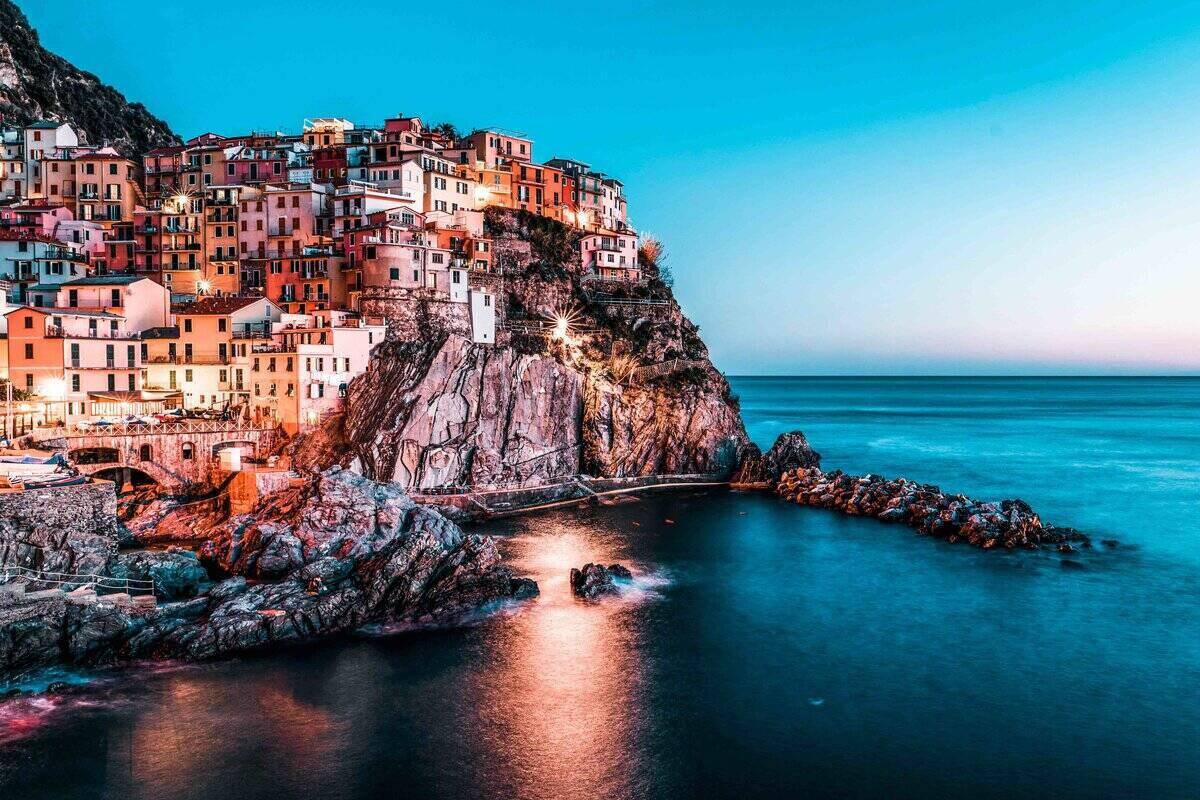
I just adore Italy and, in my opinion, the various Italian coastal towns are without doubt among some of the planet’s most picturesque locations.
Add into the mix the golden sands and pretty ports found at many of these beautiful beach towns in Italy and that might sound like enough of a reason to visit.
Yet I love that the best coastal towns in Italy have so much more to offer besides. Destinations range from smart, upmarket and more famous beach cities in Italy, such as glittering Portofino, elegant Ravello and citrus-scented Sorrento, to smaller villages with heaps of charm.
I have spent a lot of time travelling around Italy, seeking out the prettiest spots along the Italian coast.
Here I have compiled my own personal experiences with recommendations from fellow travellers to compile the ultimate guide to the best Italian coastal towns.
Author Bio: Jessie Moore
Jessie Moore is a luxury travel expert with years of experience travelling the world to find the best destinations, hotels and adventures.
The post contains affiliate links.
Map of my favourite coastal towns in Italy
Use my map below to see where all the best Italian coastal towns are located. I’d recommend trying to combine a few different seaside towns into one stay, to make the most of your time.
15 of the most beautiful Italian coastal towns
1. positano.
Best for: Postcard-perfect town
Nearest airport: Naples
Where to stay: Il San Pietro di Positano
Top activity to book: From Positano: Sorrento Coast & Capri Full-Day Trip by Boat
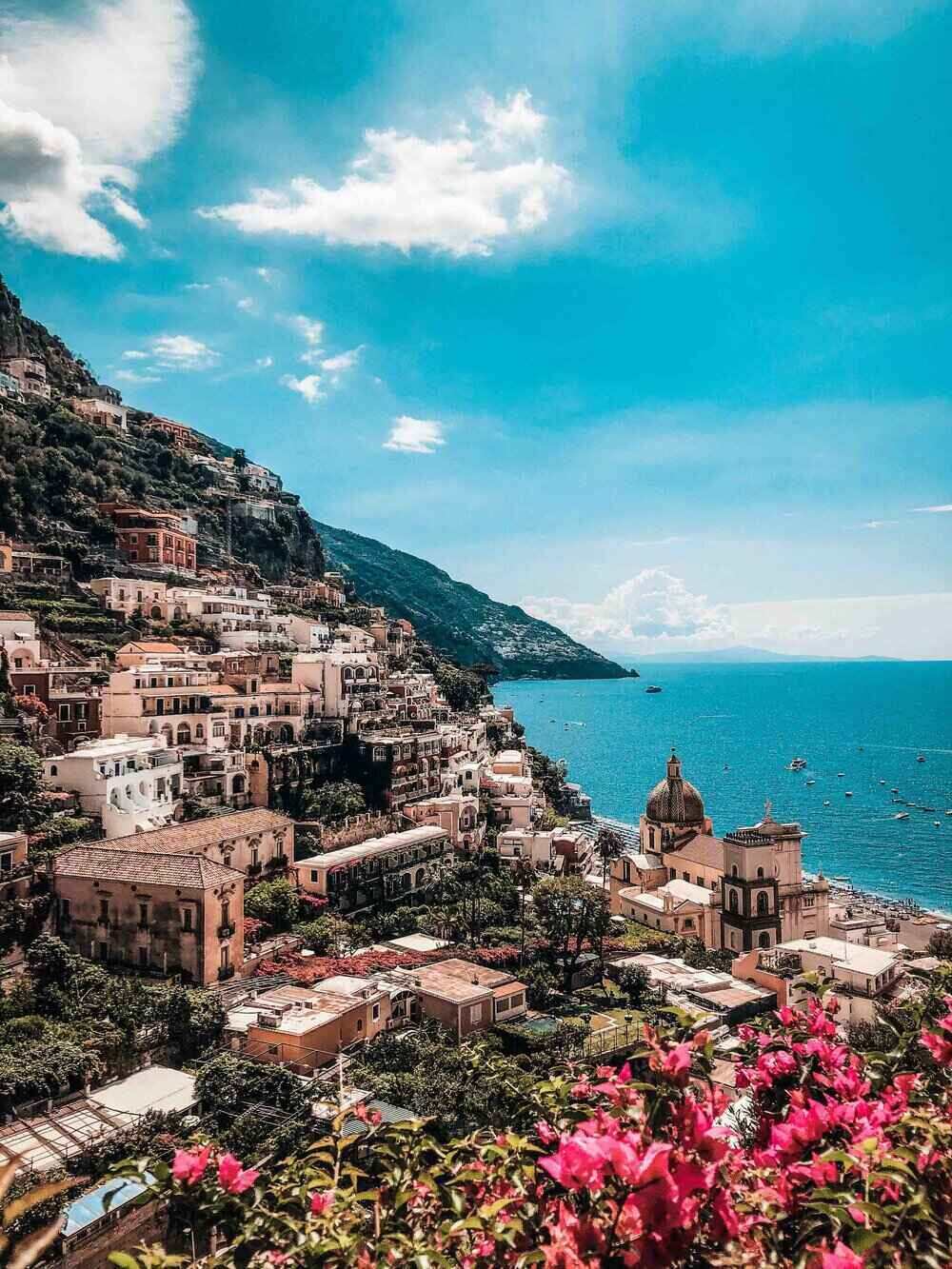
While numerous Italian coastal towns vie for the title of the country’s prettiest town, I believe Positano is a serious contender. This picturesque spot can be found at the heart of the Amalfi Coast.
I first visited Positano when I was a teenager and I’ve returned numerous times over the years. Despite the fact that its appearance borders on the rustic in places, Positano is one of the most refined resorts in Italy.
It is also one of the most costly, but offers visitors easy access by boat to Capri, the Grotta dello Smeraldo, and Ischia.
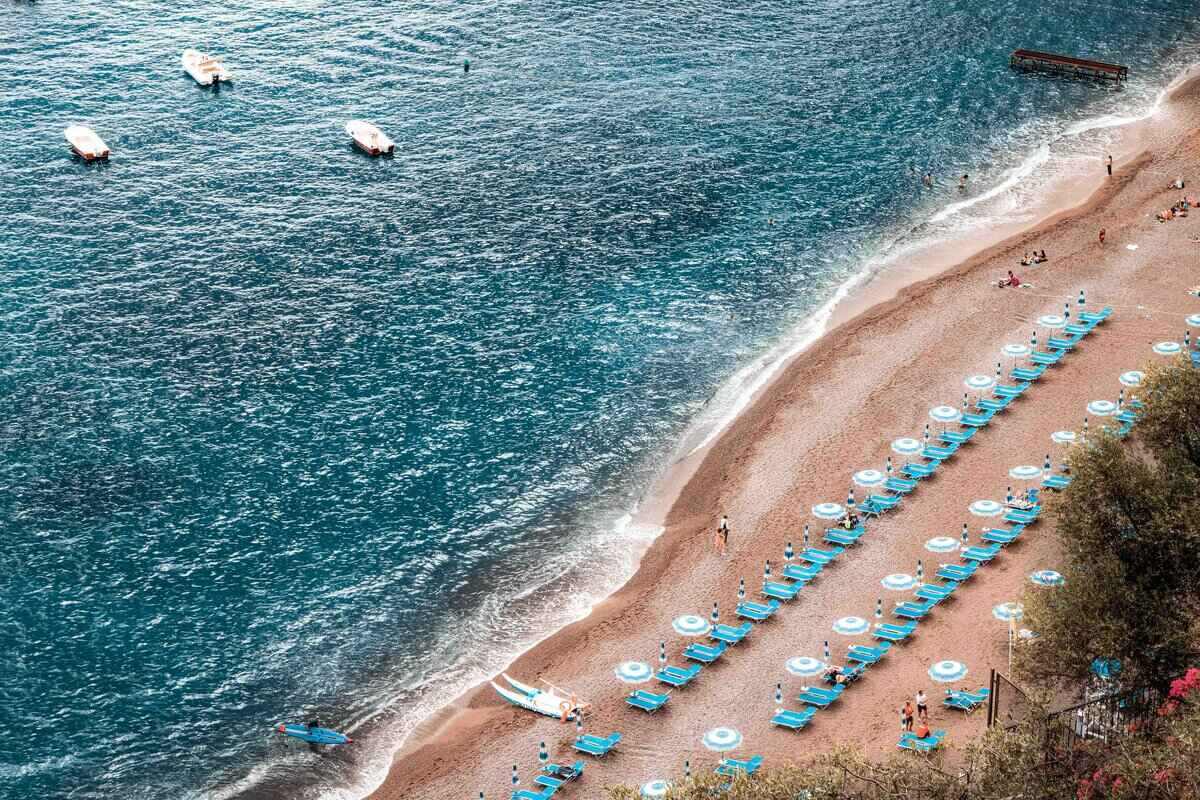
Positano has a couple of attractive beaches. Fornillo is smaller and lesser known than Spiaggia Grande. I think both are incredibly pleasant places to spend the day, with the former being busier and the latter more peaceful.
Insider travel tip: I’d recommend visiting between April and June if you can, for warm weather and lower prices. Plus, witnessing the sight of the colourful cliffside buildings during wisteria season makes for an unforgettable – and extremely photogenic – experience.
Best for: Dramatic scenery
Where to stay: Palazzo Avino
Top activity to book: Amalfi Coast: Boat and Snorkeling Tour with a Captain
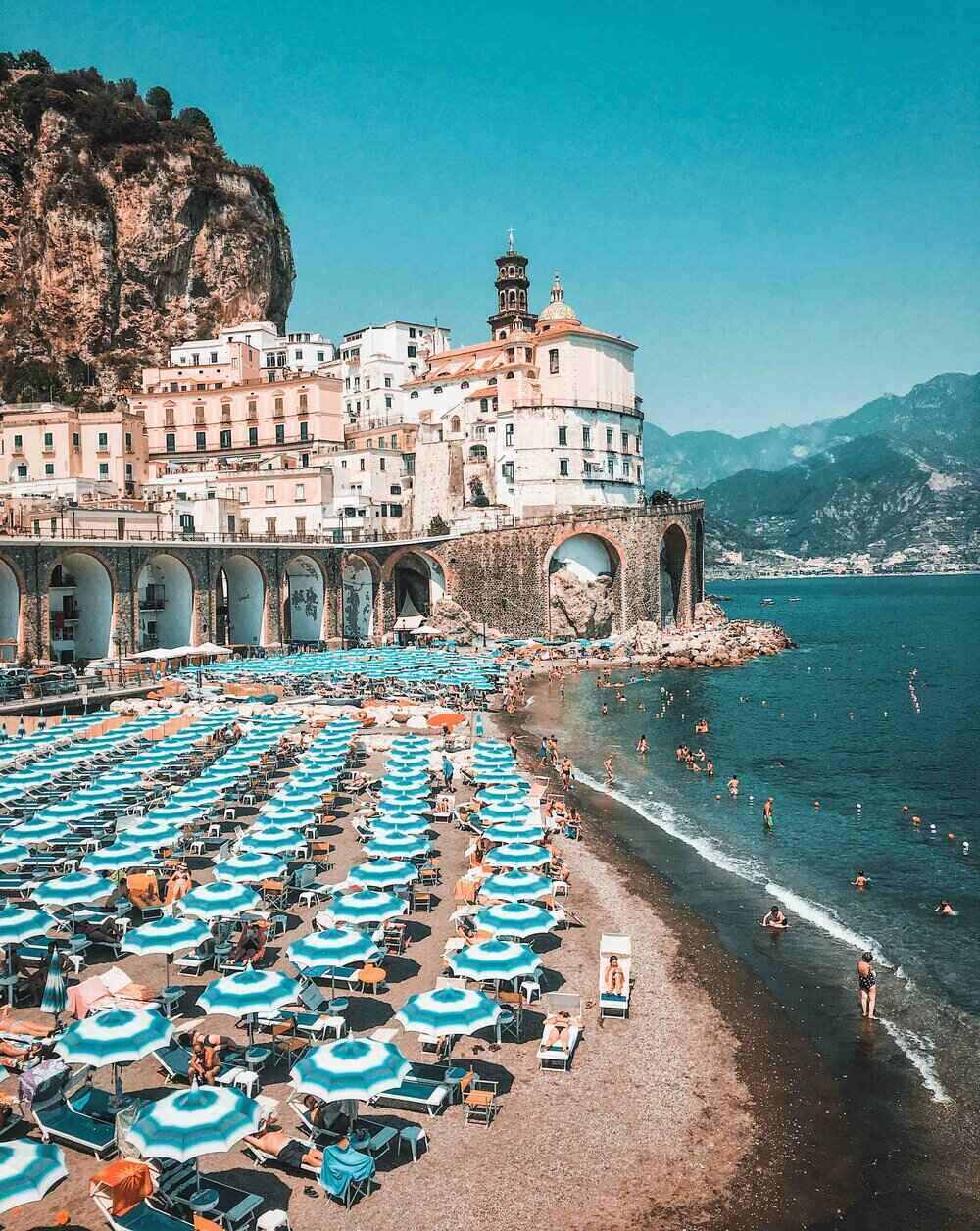
Appealingly compact in size, Amalfi is situated in a ravine at the base of Monte Cerreto. I love that it’s possible to walk across town in around 20 minutes. Although I’d definitely recommend allowing time for a coffee stop in a sunny square or to laze on one of the little beaches.
The 9th century Duomo di Amalfi is a superb example of a Roman Catholic structure, boasting a breathtaking ceiling and some colourful, intricate mosaics.
I’ve found that browsing Amalfi’s stores can also be rather diverting, as you try to choose between the cameo brooches that the town is famous for.
Limoncello is another of the Amalfi Coast’s most famous products – I love that you often get a free tipple of Limoncello with the bill when eating out.
3. Manarola
Best for: Wine tasting
Nearest airport: Pisa
Where to stay: La Torretta Lodge
Top activity to book: Manarola: Authentic Pesto Making Class in Cinque Terre

Manarola is one of five Ligurian villages that make up the Cinque Terre National Park.
This picturesque village is packed with vibrant, painted buildings, which is why it’s often referred to as the world’s most colourful town. And I can see why!
Manarola’s setting is also particularly stunning, with vineyards that were first established centuries ago dotted across the clifftops.
This makes wine tasting a popular pastime (it would be rude not to!), and the area’s white wines are of particularly high quality.
Another feature of Manarola that I love is the steep, slender lanes that lead down to the sea, known locally as carrugi.
I’d also recommend observing the sunset from this charming village, which makes for a most memorable experience.
Insider travel tip: San Lorenzo church is not to be missed, for the stunning views across the surrounding coastal landscape as well as its beautiful rose window.
4. Riomaggiore
Best for: Beautiful walking routes
Where to stay: The Sunset Line
Top activity to book: Riomaggiore: Cinque Terre Wine & Liqueur Tasting Experience
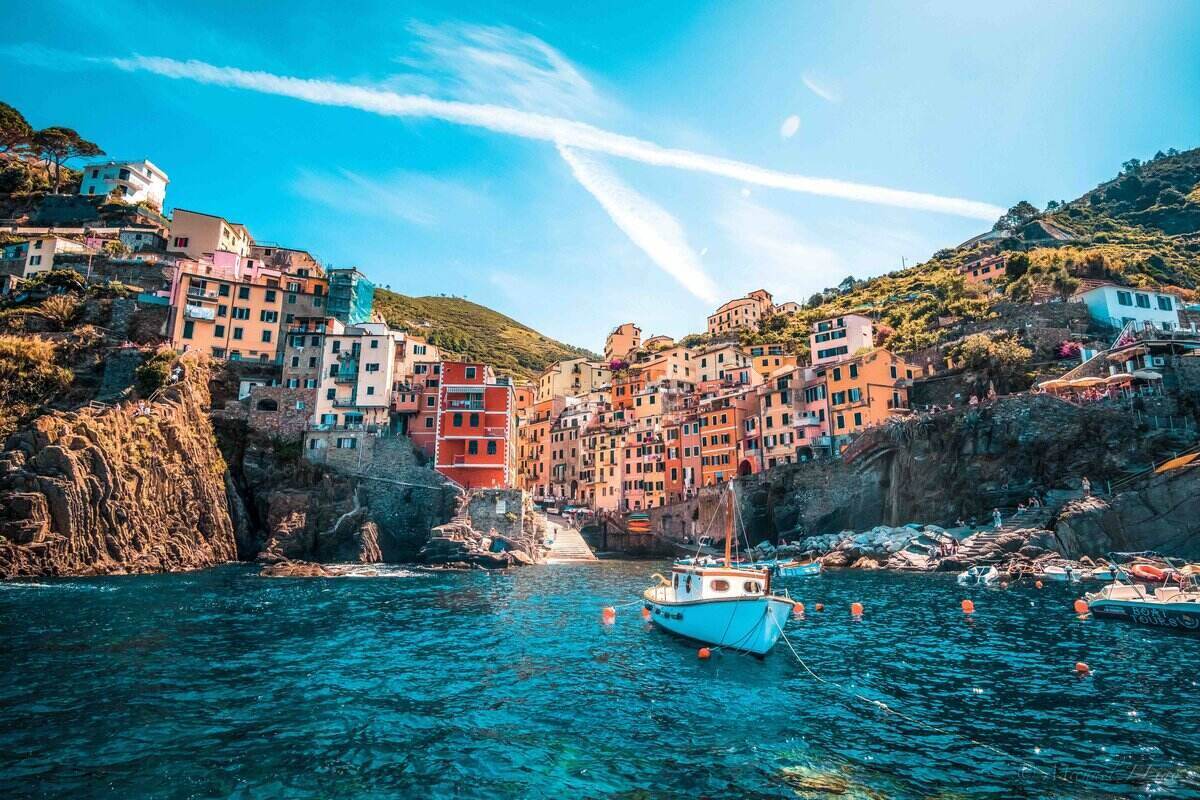
Riomaggiore is the furthest south of the five villages forming the Cinque Terre National Park. It is also the most easterly, and lies fairly close to the Tuscan border on the Gulf of Genoa.
Like nearby Manarola, Riomaggiore is famed for its cliffside cluster of colourful buildings. Trust me when I say that this place is a photographer’s dream!
Some of the homes lining the narrow, cobbled lanes are ‘tower houses’, and the village boasts 14th century churches and a medieval castle.
Vineyards also surround Riomaggiore, and this Cinque Terre village is famed for Sciacchetrà, a sweet white wine made from Vermentino, Bosco and Albarola grapes.
Popular walking routes begin in Riomaggiore: the first part of the Lovers’ Path ( Via Dell’Amore ) between Riomaggiore and Manarola is also known as the Blue Path ( Sentiero Azzurro ).
Insider travel tip: I’d recommend climbing the village’s steep, rocky staircase for magnificent views over the coastline.
5. Portofino
Best for: Luxury
Nearest airport: Genoa
Where to stay: Splendido, A Belmond Hotel
Top activity to book: 1-Hour Snorkeling Tour in Paraggi Bay, Portofino
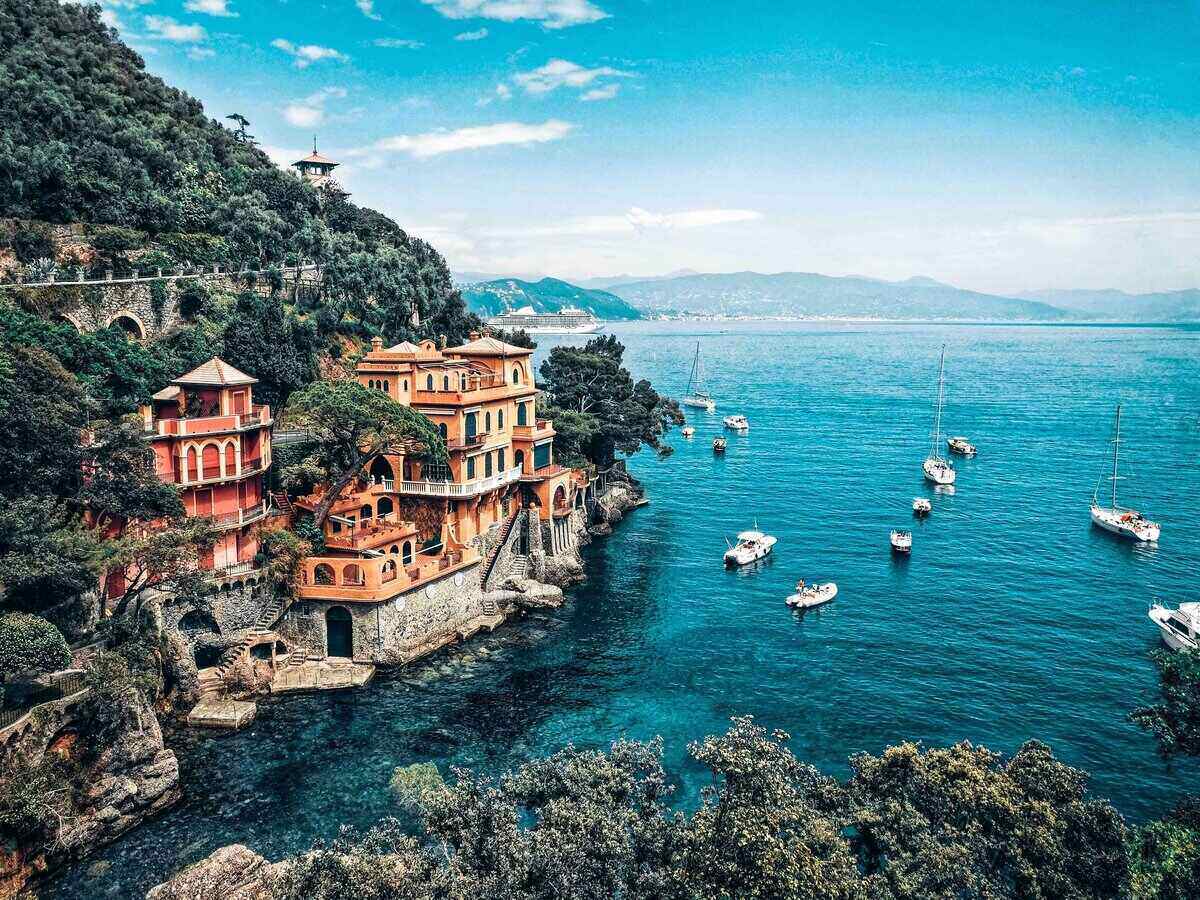
Well-heeled Portofino can be found within the Genoa province on the Ligurian coast. It’s known for its singular semi-circular harbour, as well as its popularity with the uber rich.
Portofino is famed as a hangout for the wealthy, who are drawn to this smart town by its undeniable beauty.
Awash with gleaming white yachts and stylish designer shops, I think this is the Italian Riviera’s most fashionable spot.
While the local museum, Castello Brown, has a rather ordinary moniker, this 15th century castle is an absorbing place to visit.
Not least for the spectacular views over Portofino’s famous harbour from the elevated site. I’d also recommend Museo del Parco – the sculpture park – for the artsy types among you.
If you enjoy luxury, romance, beauty and sheer indulgence, I really don’t think you can miss Portofino off your Italian itinerary.
6. Sorrento
Best for: Lively town
Where to stay: Grand Hotel Excelsior Vittoria
Top activity to book: Sorrento: Exclusive Capri Boat Tour and Optional Blue Grotto
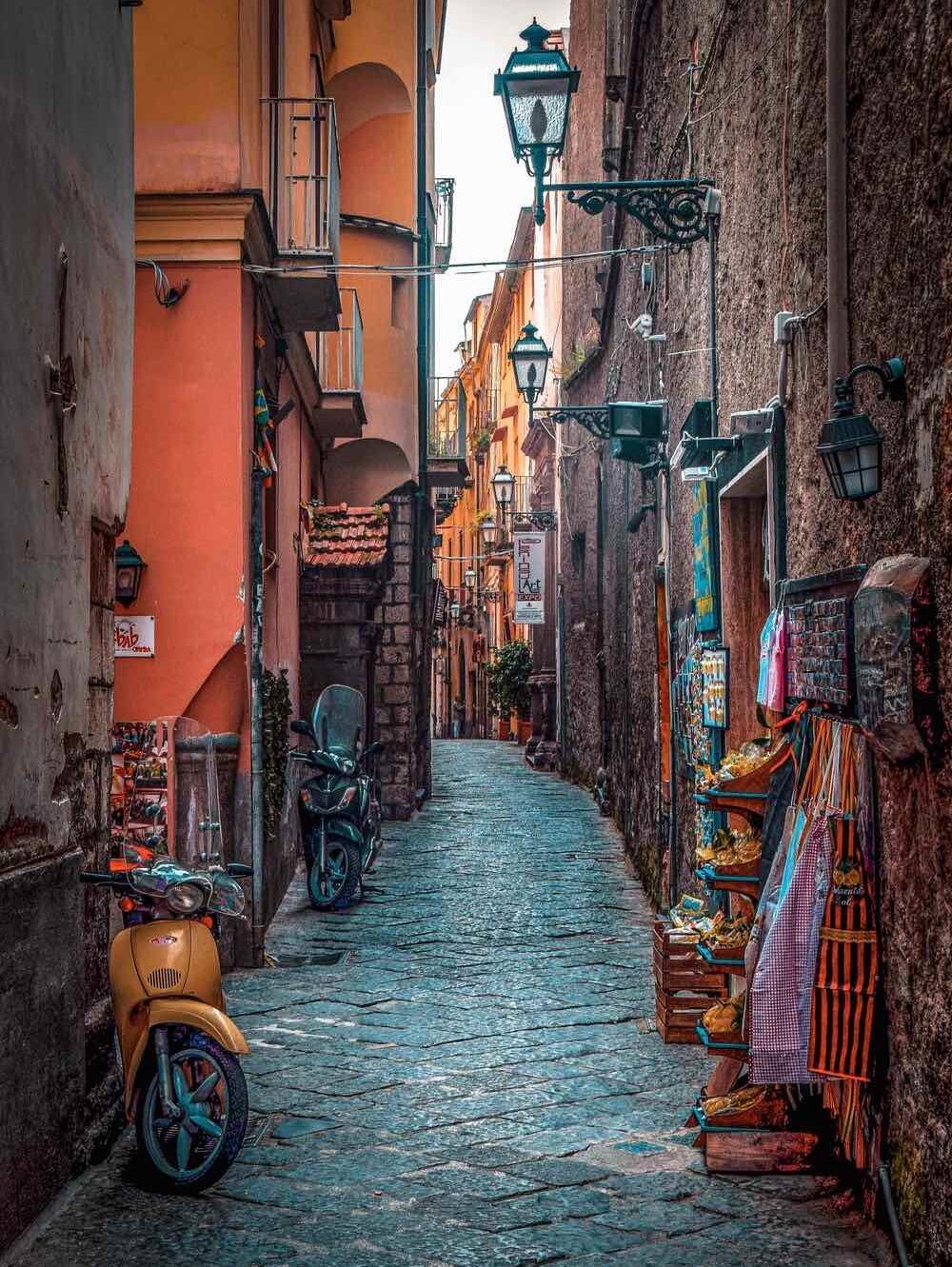
The province of Naples is home to Sorrento, another of Italy’s best located towns, set among a surrounding landscape rich in lush valleys and fragrant citrus groves.
The beautiful and locally produced ceramics and lace have also firmly placed Sorrento on the map. I think this Neapolitan town is a fabulous place to spend time, sipping coffee or a glass of wine in Piazza Tasso.
All while admiring the glamour and soaking up the atmosphere – as well as the sun!
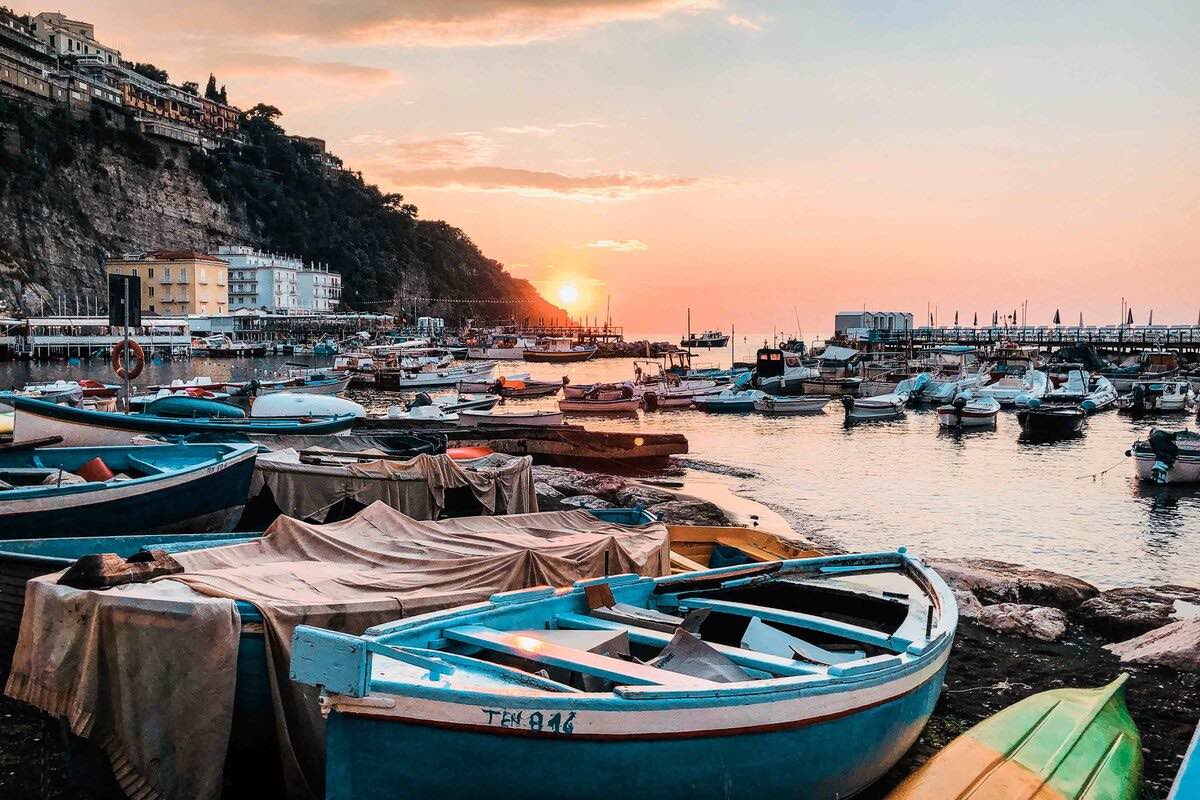
Positioned where the coastline meets the peaks, Sorrento’s location can barely be bettered. I don’t find the town itself to be as authentic as others on this list, but it’s such a wonderful base for exploring the area.
Insider travel tip: Those seeking beach life would be best off heading to the neighbouring island of Capri, or north towards the other towns of the Amalfi Coast.
7. Cagliari
Best for: Quintessential Italian charm
Nearest airport: Cagliari
Where to stay: Casa Clat
Top activity to book: Cagliari: Boat Tour with 4 Swim Stops at Devil’s Saddle
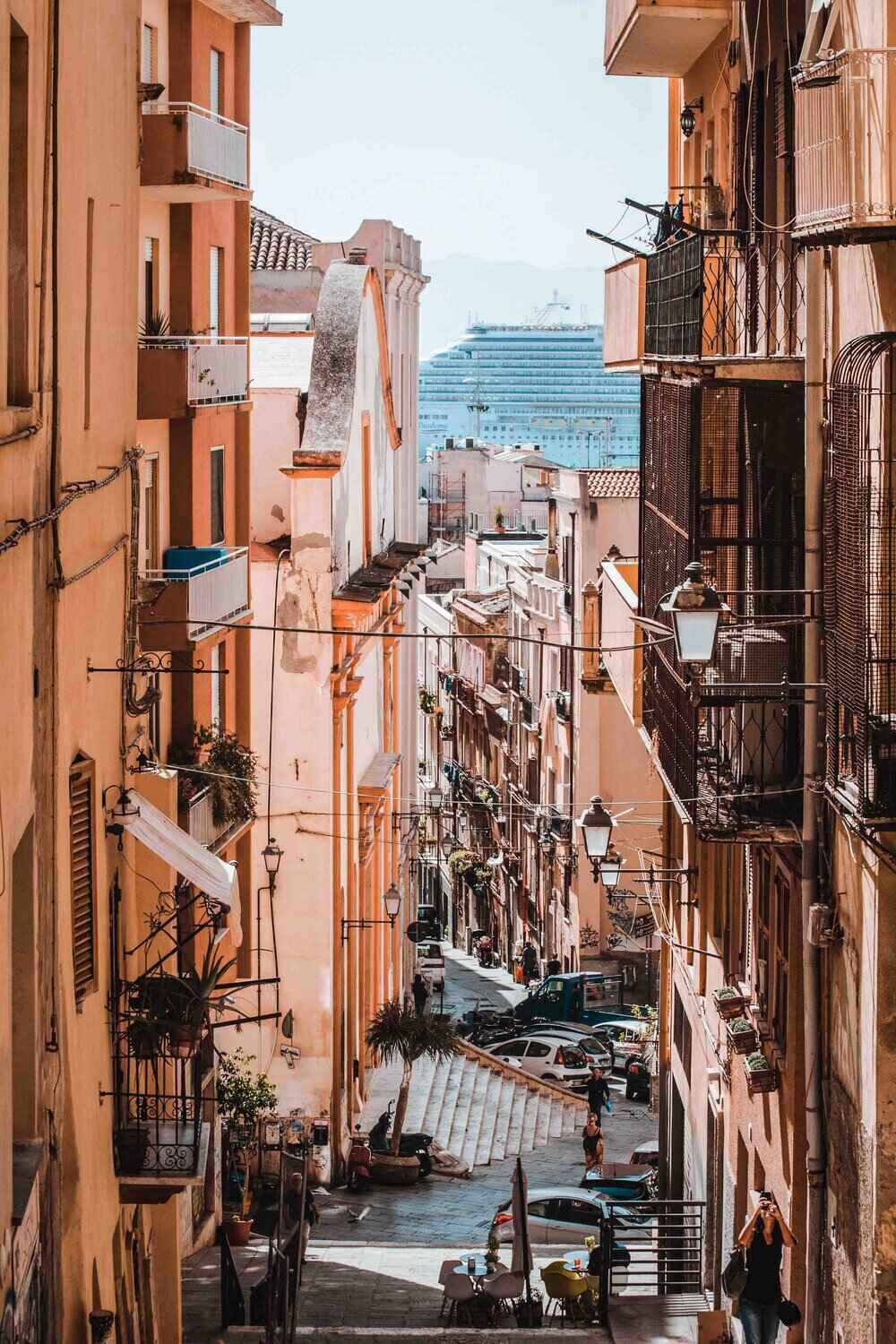
As the capital of the island of Sardinia, Cagliari has lots to offer visitors. I’d recommend approaching by boat if you can, so you see the best of the town’s beaches and golden domes before even setting foot on Sardinian soil – or sand.
Smart Poetto beach is a must, where young families enjoy al fresco meals while flamingoes wander round the surrounding marshland.
Roman remains are dotted around the town too, as are plenty of appealing cafes, stores and restaurants.
The best sights and views in Casteddu (as Cagliari is locally known), however, are accessed by trekking up to the old town.
Once you’ve reached the hilltop, you can wander cobbled alleys, take in the views from Piazza Indipendenza and discover Bastione San Remy , the local landmark with a limestone arch and Italiate pillars.
Trust me, it’s well worth the walk!
8. Sperlonga
Best for: A day trip from Rome or Naples
Nearest airport: Rome
Where to stay: Hotel Grotta Di Tiberio
Top activity to book: Sperlonga: Boat Tour to Gaeta with Pizza and Drinks
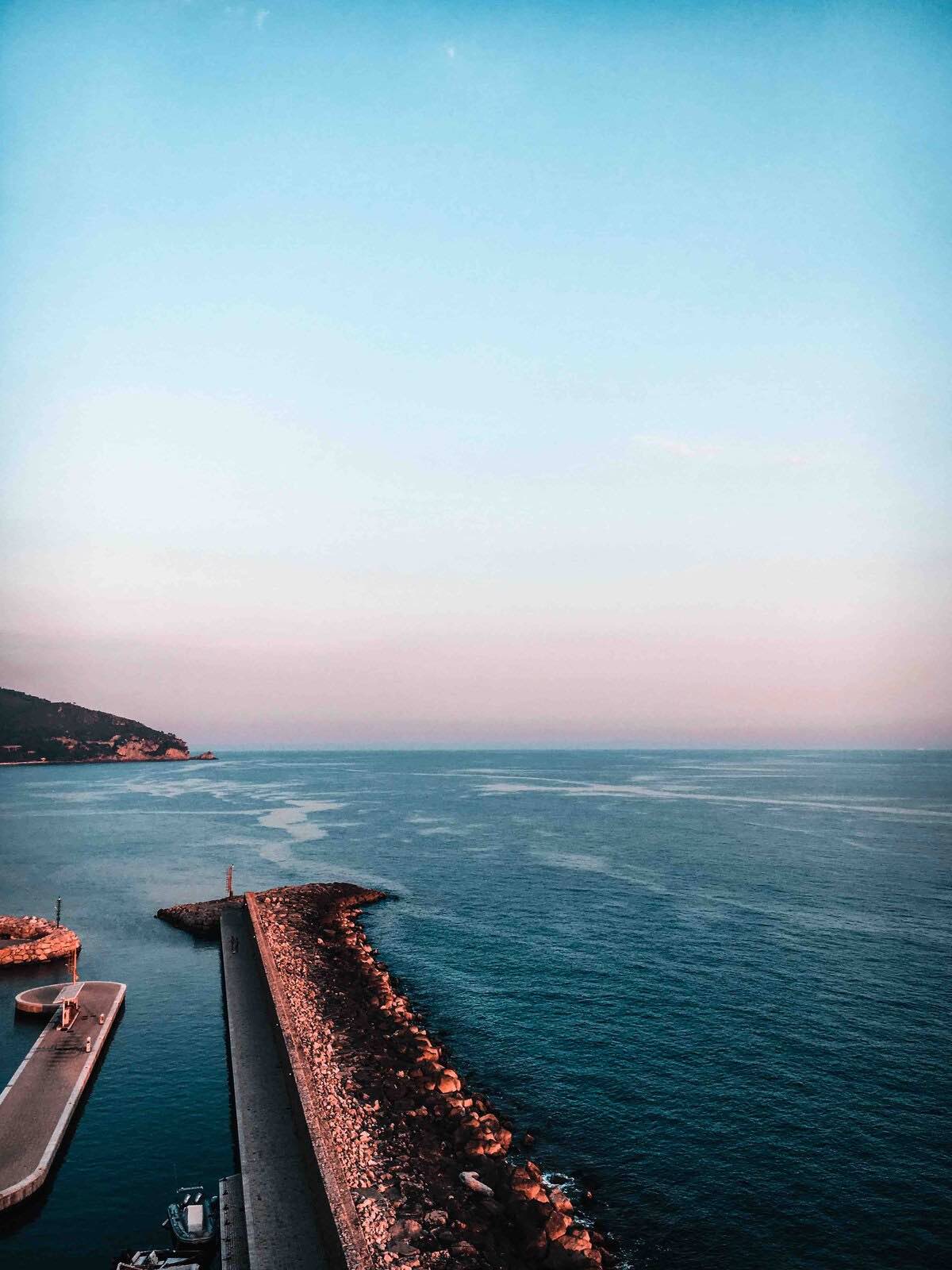
Sperlonga makes a great day trip from Rome or Naples, as it is positioned around midway between the two Italian cities .
It also has a pretty, pristine beach and a history centering on Emperor Tiberius, its most famous former resident.
Tiberus’s villa now houses a range of sculptures that were found in the grounds, detailing the accomplishments of Odysseus – aka Ulysses, the fabled Greek icon. Dating from Roman times, these were uncovered in the 1950s.
Discover more of the best beaches near Rome or my favourite day trips from Rome in my guides.
9. Portoferraio
Best for: Breathtaking views
Nearest airport: Elba Island
Where to stay: Hotel Hermitage
Top activity to book: Elba Island: Portoferraio Walking Tour

Located off the western coast of Italy is the island of Elba, and Portoferraio can be found at the centre of the harbour.
As it’s surrounded by the sea on three sides, I adore the sublime views from the hills of the town. From the Italian mainland, Elba can be reached by ferry, and the approach makes a memorable vista.
The name Portoferraio literally translates to ‘Iron Port’, and the old iron mills caused rapid growth here during the Napoleonic era.
At the Civic Archaeological Museum, visitors can also delve deeper into island history.
Want up to 25% off hotels?
Subscribe to my newsletter and get immediate access to my guide on how to save money on flights and hotels. Our weekly emails are filled with adventure inspiration, insider travel tips and exclusive discounts.
Best for: Historic charm
Nearest airport: Palermo
Where to stay: Le Calette N.5
Top activity to book: Cefalù: Agrigento Temples and Scala dei Turchi Day Tour
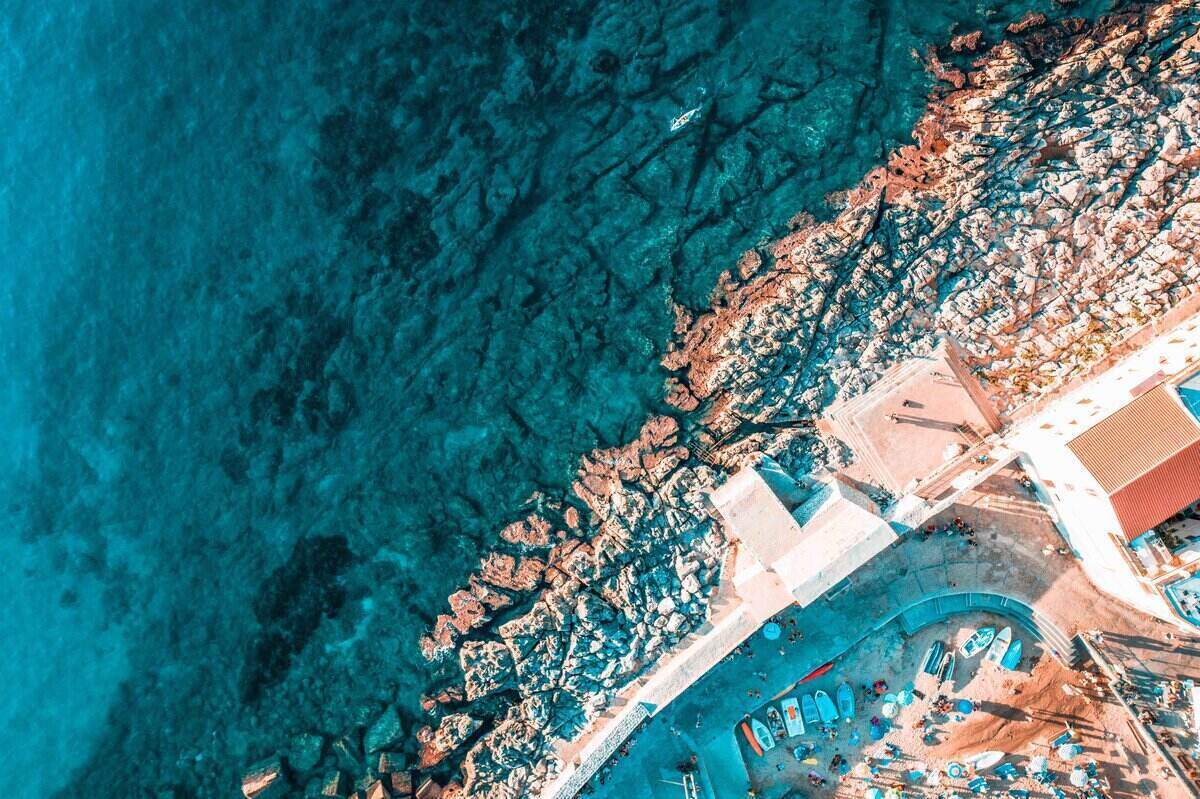
On Sicliy’s Tyrrhenian coast is Cefalù, a coastal spot known for its 12th century Norman cathedral. This pretty, historic town is one of the island’s most popular resorts and I can see why.
The fortress is a magnificent sight, with monolithic twin towers that loom over the town. Impressive Byzantine mosaics can be seen here too.
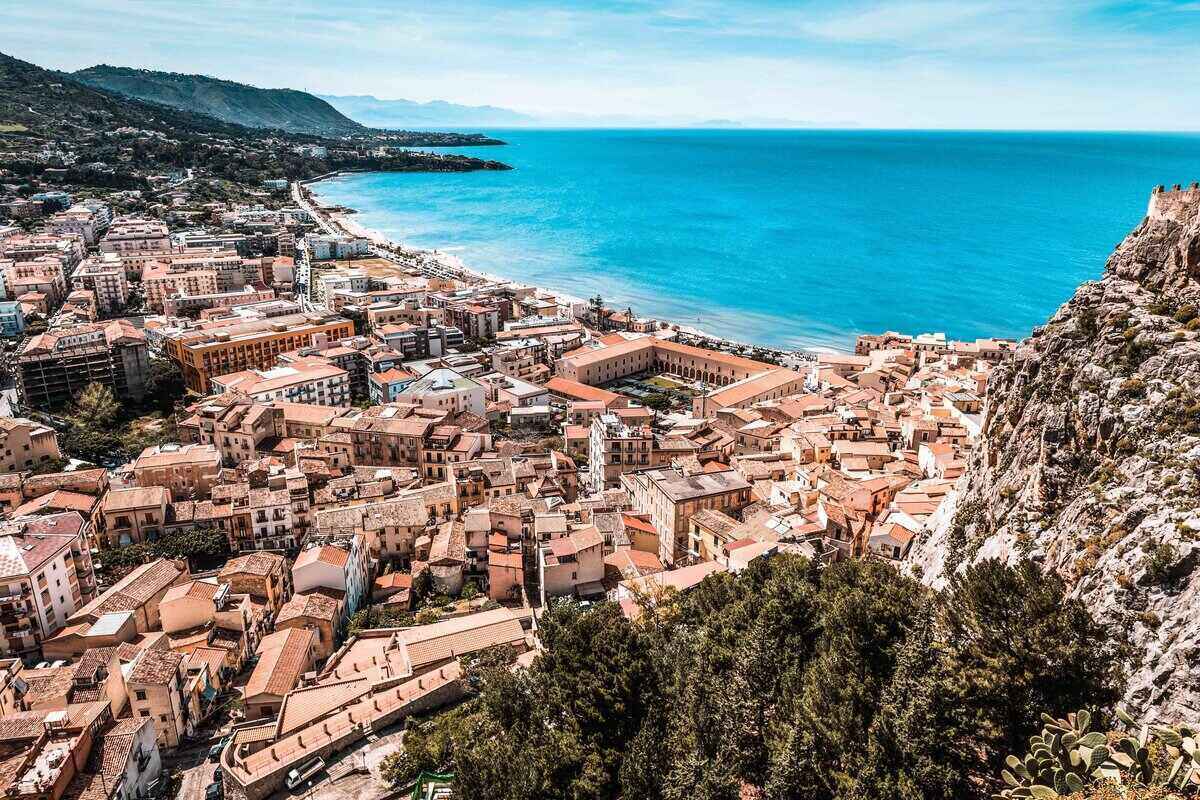
Perched on a huge crag known as Rocca , the Temple of Diana’s ruins dominate the area.
Cefalù’s Mandralisca Museum is also popular, containing an original Antonello da Messina portrait, plus a range of archaeological artefacts.
11. Polignano a Mare
Best for: Exceptional sea views
Nearest airport: Bari
Where to stay: Donnamaria – Dimora Vista Mare
Top activity to book: Polignano a Mare: Boat Cruise to Scenic Caves with Aperitif
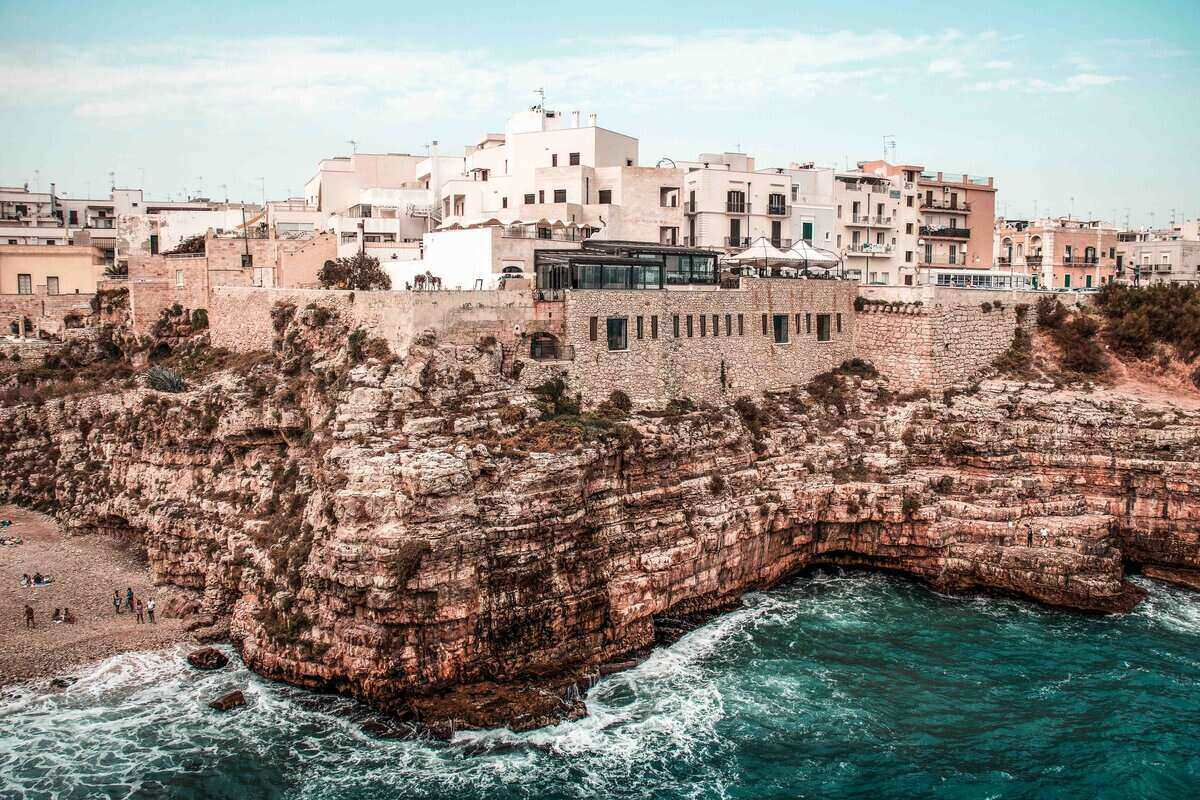
With a dramatic cliff top location, Polignano a Mare is in the Italian province of Bari.
As well as superlative sea views from the terraces, the town is known worldwide as a superb cliff diving spot, and has played host to competitions in the past. I’m not sure you’ll find me jumping from the cliffs, but it’s an option for the daredevils among you!
Polignano a Mare boasts a charming old town, packed with narrow streets lined with historic homes and buildings.
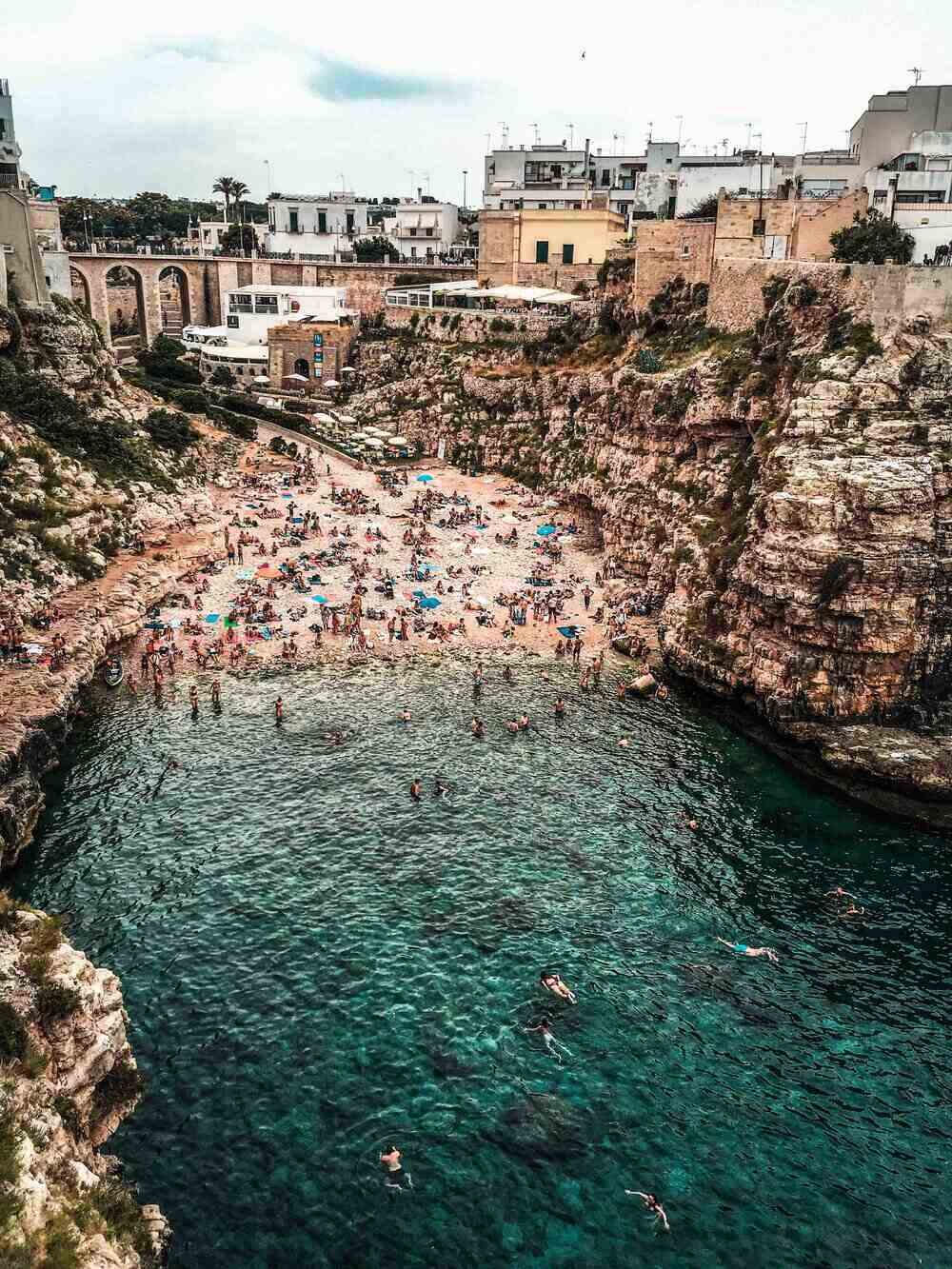
Here the facades tend to lean towards the honey-hued rather than the pastel-painted, allowing the turquoise waters to take centre stage.
At the heart of the town is a clean sweep of golden sand, where I’d recommend spending the day sunbathing and swimming.
Or simply take a rest break with a gelato between sightseeing and capturing the appealing scenes on camera.
Best for: A hidden gem
Where to stay: Hotel La Bussola
Top activity to book: Amalfi & Atrani: 2-Hour Private Walking Tour
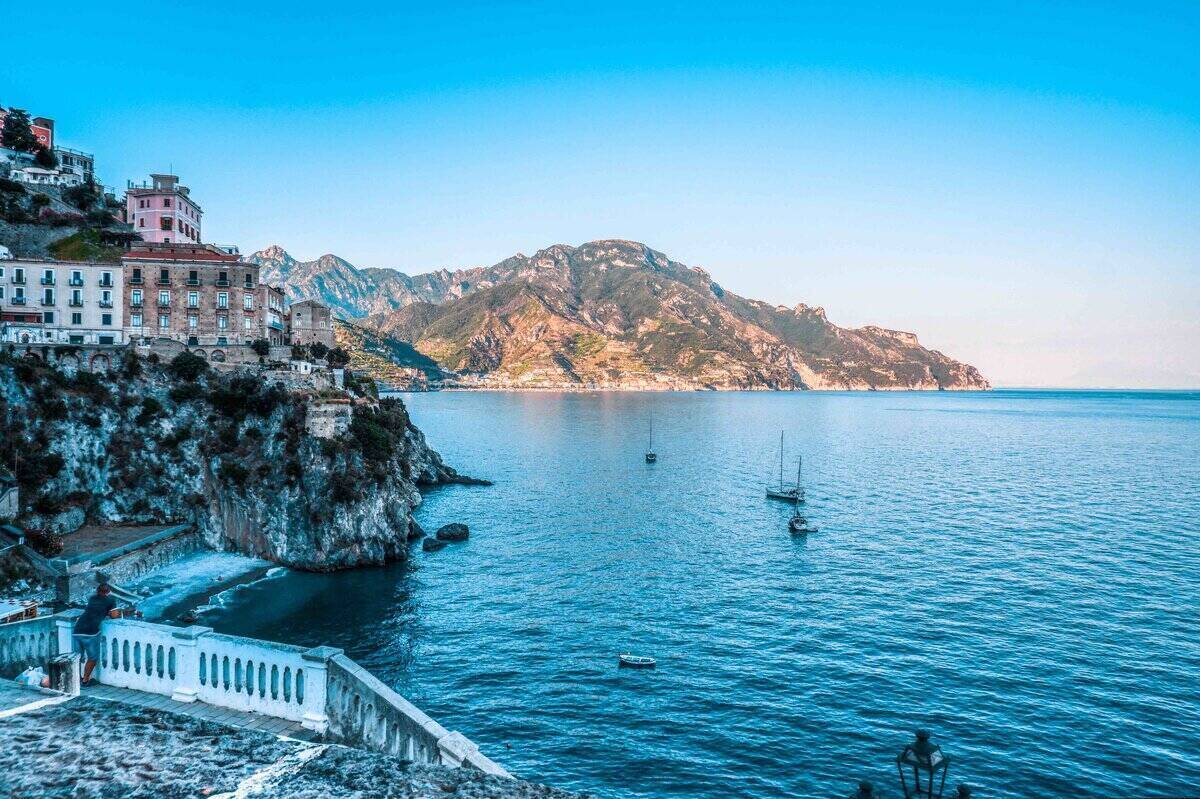
Immediately east of the larger settlement of Amalfi on Italy’s southern coast is Atrani, the smallest town in the region.
It was once the chosen residence of the region’s most influential families and I love to imagine all the stories of times gone by!
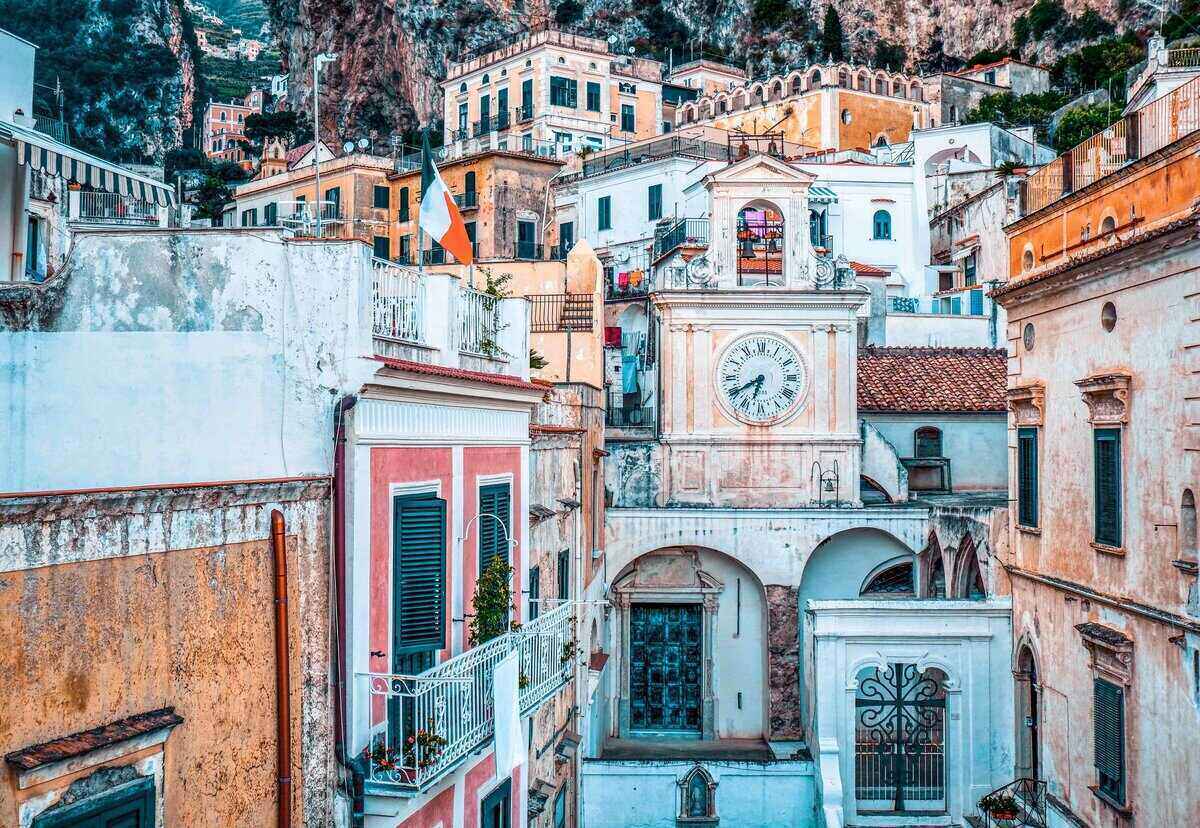
Atrani is characterised by the traditional homes, lemon groves, medieval buildings and pretty gardens that lead upwards from the sands.
All along the coastline there is a series of curving support arches, a marvellous sight that can be seen by those who pass along the coast by boat.
Discover more of the best hidden gems in Italy .
13. Levanzo
Best for: An authentic Italian town
Where to stay: Dolcevita Egadi Eco Resort by KlabHouse
Top activity to book: From Trapani: Mini Cruise to Favignana and Levanzo
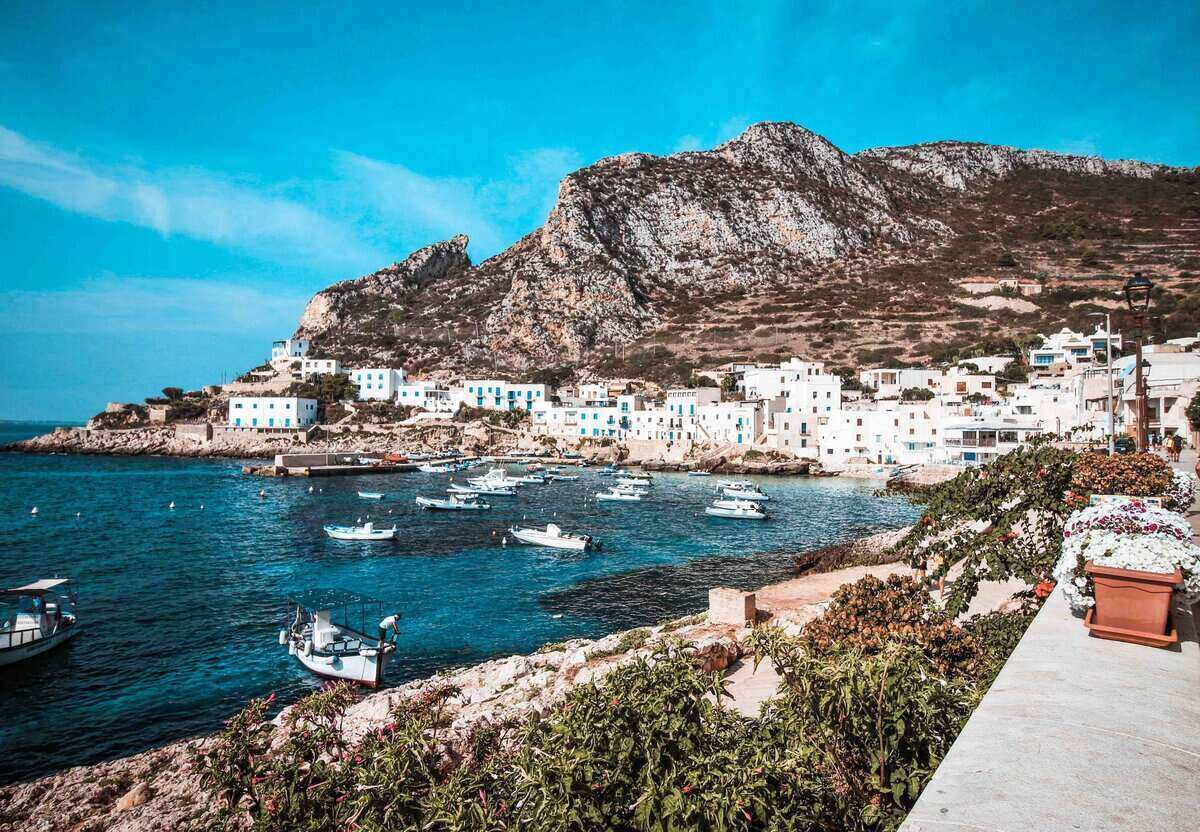
Off Sicily’s western coast are the three Egadi Islands, and Levanzo is the smallest of the trio. Of all the best beach towns in Italy, this one is the most basic but I also adore its authenticity.
The lightly toned stone of the buildings truly stands out against the brilliant blue of the sea here, making this one of the prettiest ports on earth.
It’s a fairly rustic sort of place, with simple dwellings, dry stone walls, and dusty tracks.
Levanzo’s sole attraction is the Grotta del Genovese containing well-preserved examples of prehistoric art. As it’s popular, booking in advance is essential.
Otherwise, the key attractions here are the warm waters and serene landscapes.
14. Ravello
Best for: Spectacular views
Where to stay: Caruso, A Belmond Hotel
Top activity to book: Ravello: 2-Hour Private Walking Tour
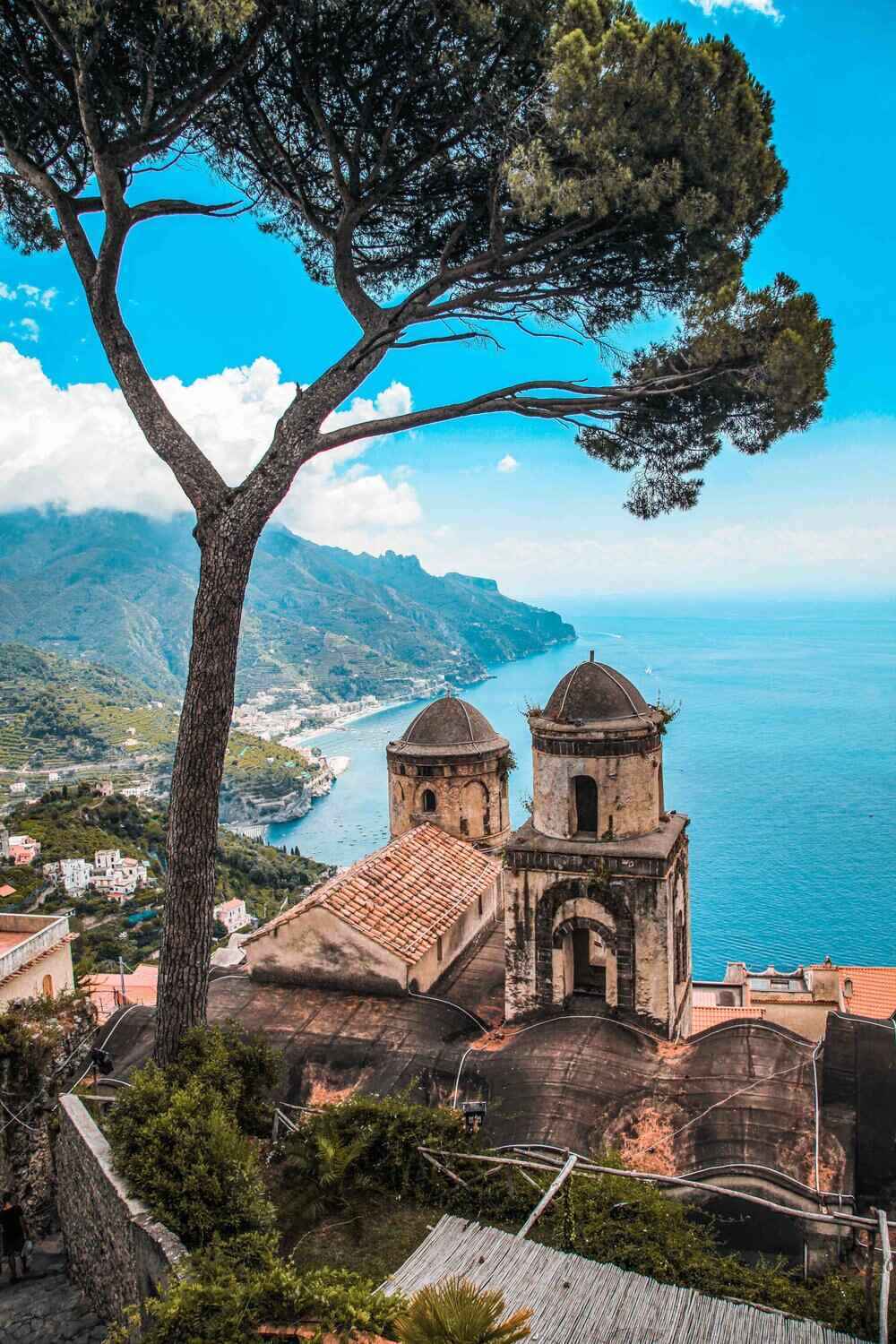
Perched above the Bay of Salerno, Ravello was once described as being nearer to the sky than the sea.
In addition to its stately position, the town is famous for the villas of Cimbrone and Rufolo and their lush, colourful gardens.
Trust me when I say that the views from these outdoor oases of beauty and calm are nothing short of spectacular. It’s why many artists are said to have been inspired by the setting and surroundings of Ravello.
As for the villas themselves, each is justifiably famous in its own right. Villa Rufolo dates from the 13th-century, and is a superb example of a Moorish style structure.
Regular concerts and events are held both indoors and out throughout the year. This includes the Ravello Festival that takes place in summer.
Medieval Villa Cimbrone is positioned on a rocky outcrop, and is renowned for its beautiful garden.
15. Castelsardo
Best for: An ancient castle
Nearest airport: Alghero
Where to stay: Bajaloglia Resort
Top activity to book: Castelsardo: Basket-Making Workshop and Museum Guided Tour
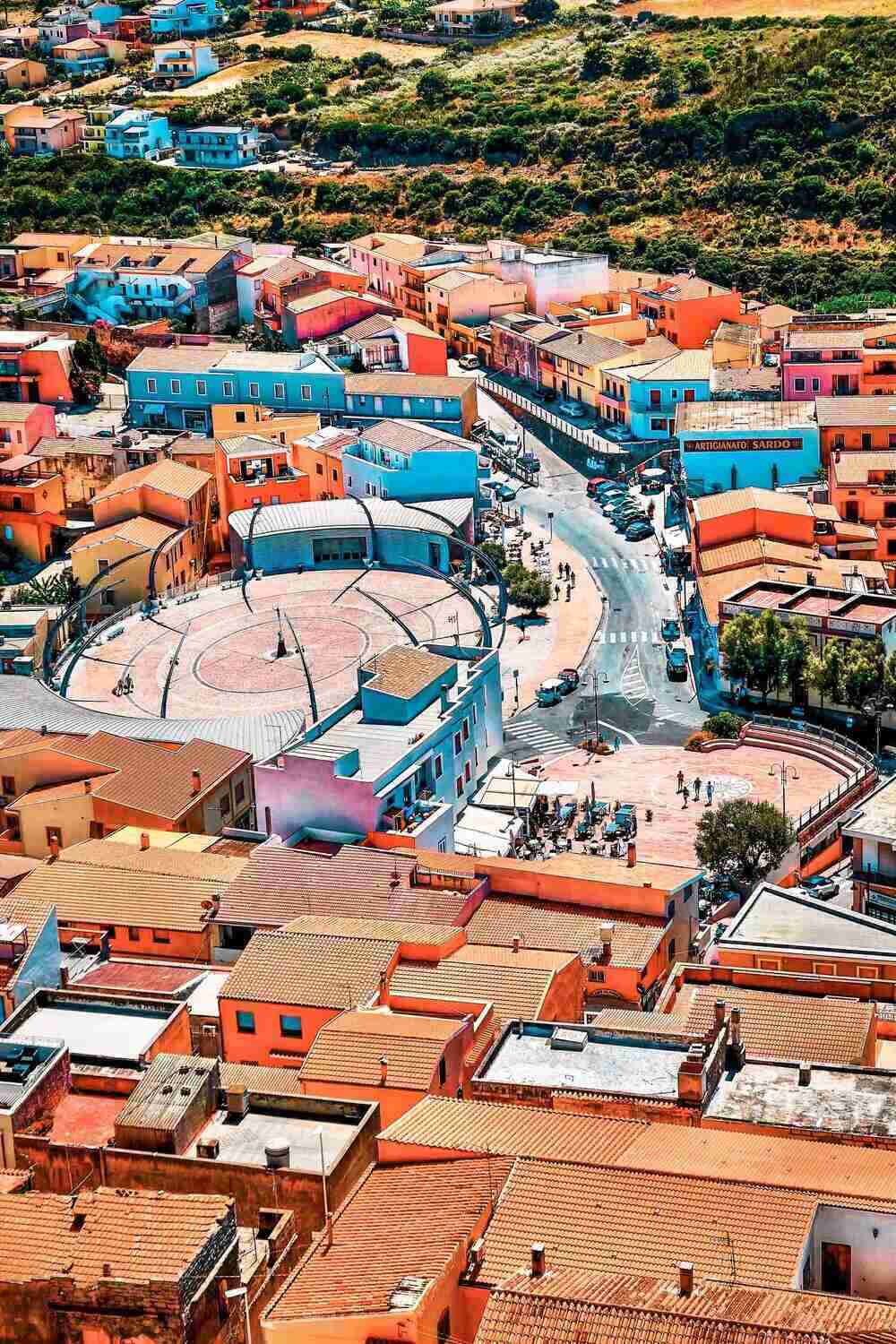
On Sardinia’s northern coast, Castelsardo is a pretty town with an ancient castle and an abundance of cafes and souvenir stores.
Castello dei Doria is Castlesardo’s main draw, and there is also a museum on site devoted to the handicraft of basket weaving, an important tradition in the area. Lots of woven items are displayed around the castle.
Insider travel tip: I’d really recommend exploring the maze of alleyways leading down from the medieval fortress, and you can also explore ancient churches and the rocky shoreline.
It’s been tough narrowing down the most beautiful coastal towns in Italy, but hopefully you’re suitably inspired for your next Italian getaway. Now, pass me the Limoncello!
Have you got any favourites or recommendations? Do let me know in the comments or get in touch on social media .
Looking for more European travel inspiration? Check out more of my Italy guides:
- 12 best cities in Italy to visit
- 12 best beaches in the South of France
- Rome travel guide
- 15 best European cities to travel solo
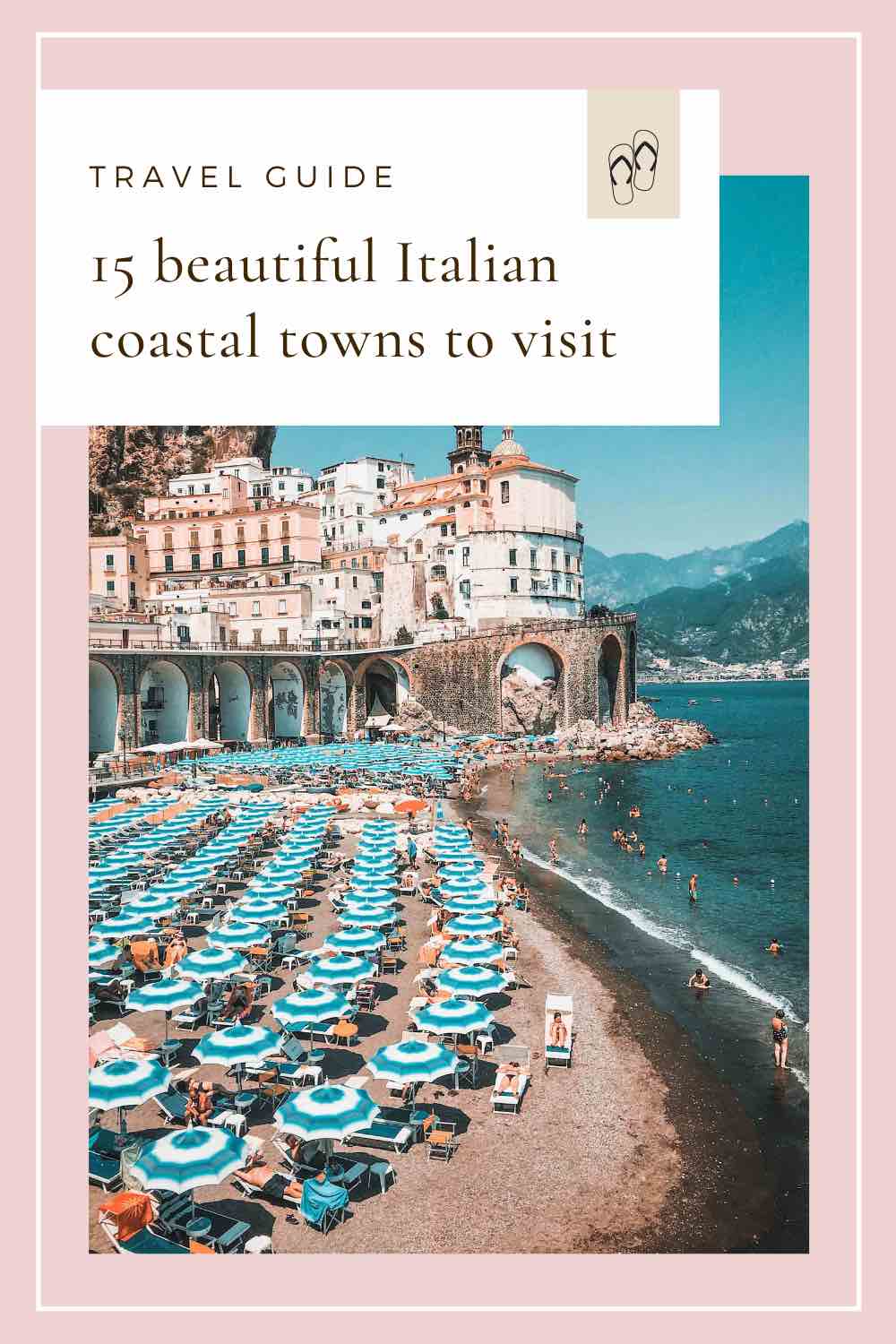
Jessie is a luxury travel expert with years of experience travelling the world to find the best destinations, hotels and adventures.
Find me on: Web | Instagram
Leave a Reply
Your email address will not be published. Required fields are marked *
This site uses Akismet to reduce spam. Learn how your comment data is processed .
Pocket Wanderings is a luxury travel and lifestyle brand run by London-based content creator, Jessie Moore. Here you’ll find a community of fellow wanderlusters and adventurers.
Quick Links
About Contact Privacy Policy

25 Most Beautiful Italian Towns
Anywhere you go in Italy, you find beauty, art, and uniqueness. Each region and all Italian towns have its own story, its own rare beauties that make them stand out and be different from each other. The towns in Italy change their architectural style from north to south. Towns in north Italy have an influence on western Europe, the Austro-Hungarian Empire, and France even. In the meantime, small towns in Italy in the south are different. The color of the stone used to build these towns changes from north to south, and therefore the color of cities changes too. Each of the Italian towns on this list is a real gem, and they are all worth our attention.
25 Beautiful Italian towns
In this article, we picked 25 Italian towns which are smaller. These towns in Italy were collected by looking through all the magical places from north to south, picking Italian hill towns, coastal towns, and those Italy towns that are near some of the most beautiful lakes in Italy . We picked places from different regions , close to the most beautiful cities in Italy . You can look for international airports nearby, or check for car rentals in Italy to reach these places, as they might be out off the way from trains, or take too much time with a bus.
1. Alberobello
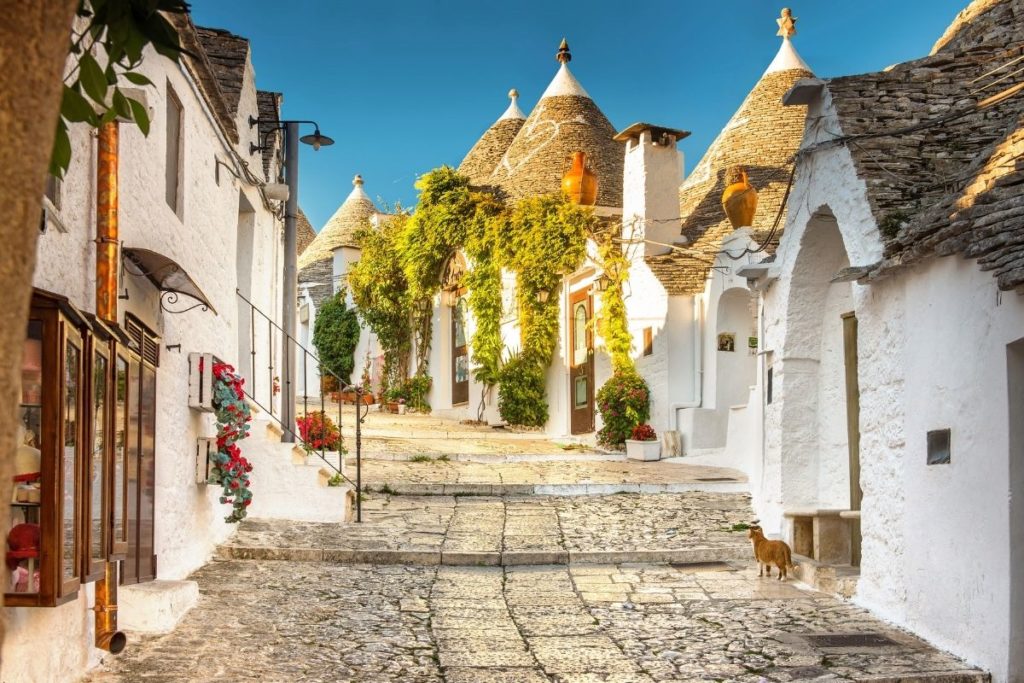
Alberobello is one of the most outstanding towns in Italy, and it’s definitely one of the best towns in southern Italy to visit. When it comes to small towns in Italy in the Puglia region, everyone must have Alberobello on their bucket list. The famous Trulli houses, which are popular in this region make Alberobello outstanding.
Usually, people don’t spend more than a few hours here, since there are only a few streets built with Trulli houses, but it’s a perfect stop-by for a Puglia road trip. This region needs anyway a car, otherwise, it’s impossible to discover all the beautiful towns and beaches in Puglia. By train or bus, visiting Alberobello from Bari or Polignano a Mare would take a lot of time.
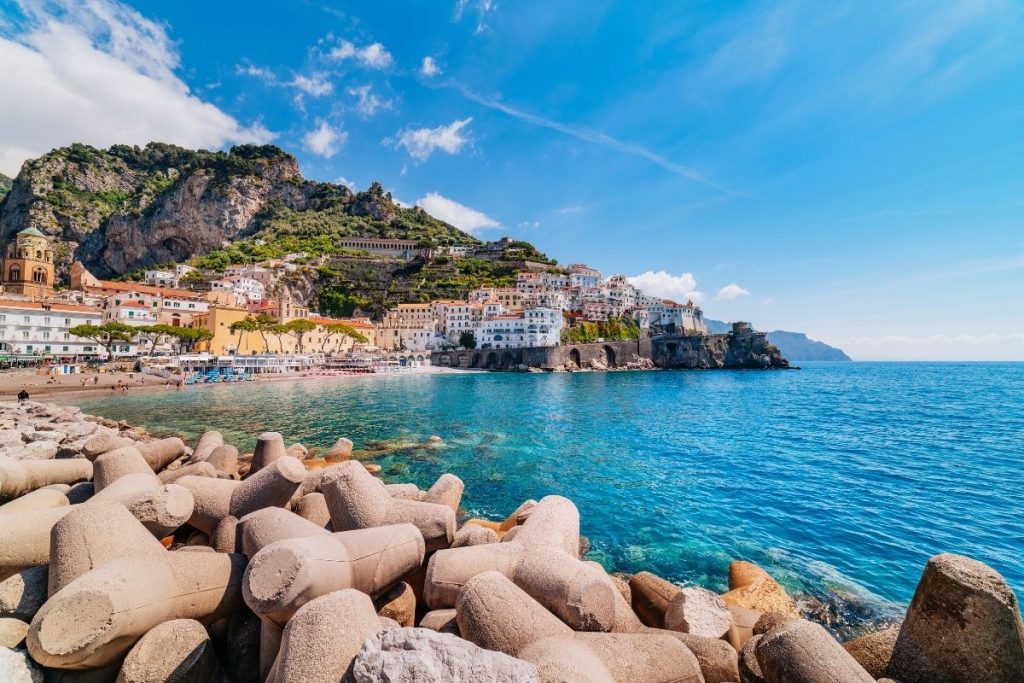
Amalfi is one of the gemstones of the Amalfi Coast . When it comes to beautiful coastal Italian towns though, Amalfi is unmissable. When people are looking for an Italian tourist town near Naples, they usually pick only Positano to visit. Amalfi isn’t far from Positano, and there’s a great bus connection to easily reach it.
There are beautiful hotels in Amalfi with stunning views, great restaurants, a lovely beach, and an enchanting town center to explore. While the neighbor, Positano might take over the fame, Amalfi is one of those Italian coastal towns , that are not so packed with tourists, and where you can enjoy the Italian summer to the fullest. A perfect summer destination that’s easily reachable from Naples by car, ferry, and bus.
3. Bellagio

When it comes to beautiful small towns in Italy, Bellaggio is a pearl of the Como Lake , that you shouldn’t miss! When it comes to Italy towns, most of you might want to visit places in Tuscany, Lazio, Puglia, or Campania, but the towns in north Italy are just as beautiful!
Como Lake is one of the most beautiful, and also exclusive locations in Italy, surrounded by beautiful towns, great restaurants, luxury hotels , and breathtaking views over the lake and the Italian Alps. You can reach Bellaggio from Milan within an hour by train, bus, or by car. It’s a pearl that’s worth seeing!
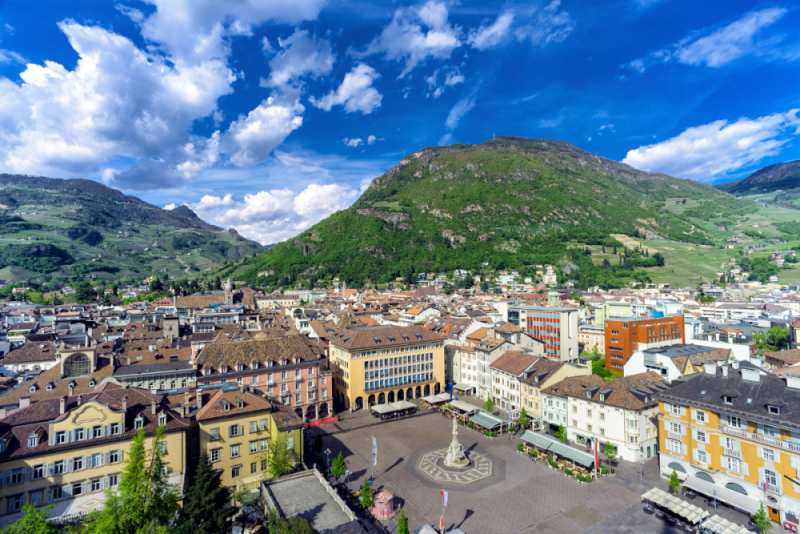
Bolzano is the capital of South Tyrol, a region that till 1918 (the end of the first world war) was part of Austria. It’s also one of the best small towns in Italy. German, Italian, and a local language called Ladin are all widely spoken. It’s this mix that makes the area so historically interesting and culturally refreshing. The blend of Austrian and Italian architecture is widely present.
You can get to Bolzano easily by road – the autostrada (motorway) connects Innsbruck in Austria with Bolzano and then down to Verona. You can reach Bolzano from Both Austria and Verona. By train from Verona, you’re in Bolzano in about an hour and a few minutes. A perfect destination for those who are also looking for the best ski resorts in Italy !
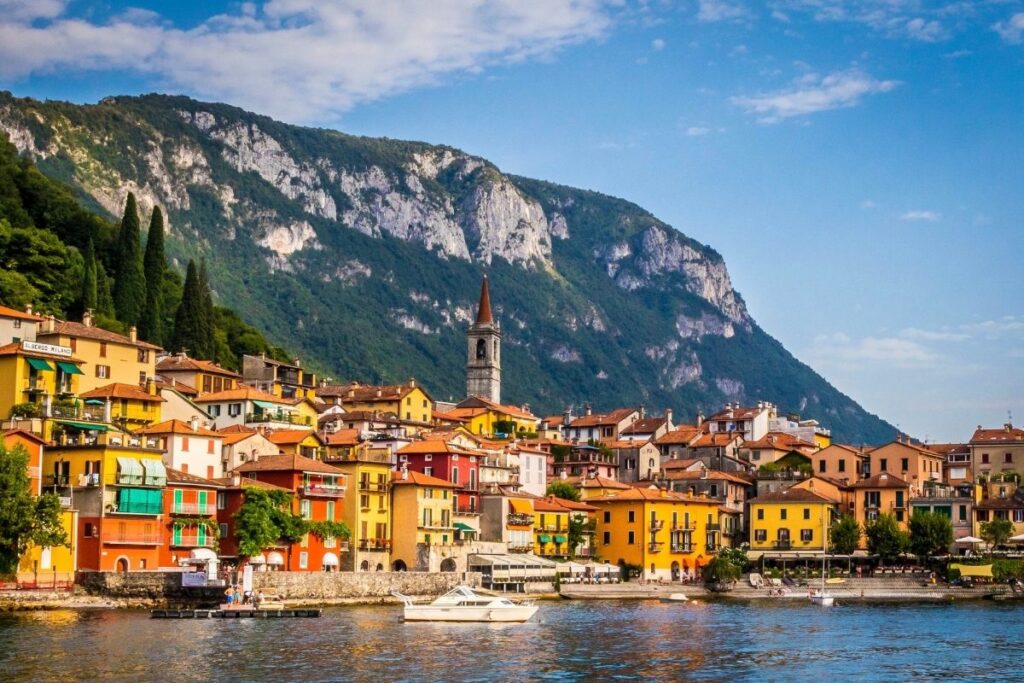
Another of the beautiful towns in north Italy is Como, located also on the side of Lake Como between the Italian Alps. Como is the easiest to reach for a day trip from Milan , and if you don’t have a car, you can easily reach it by train from Milano Centrale.
As one of the most charming small towns in Italy, Como has beautiful streets, cute buildings, great restaurants, and charming lakeside promenades. It’s a perfect place to start exploring everything that Lake Como offers. From Como, you can move over to other towns around the lake.
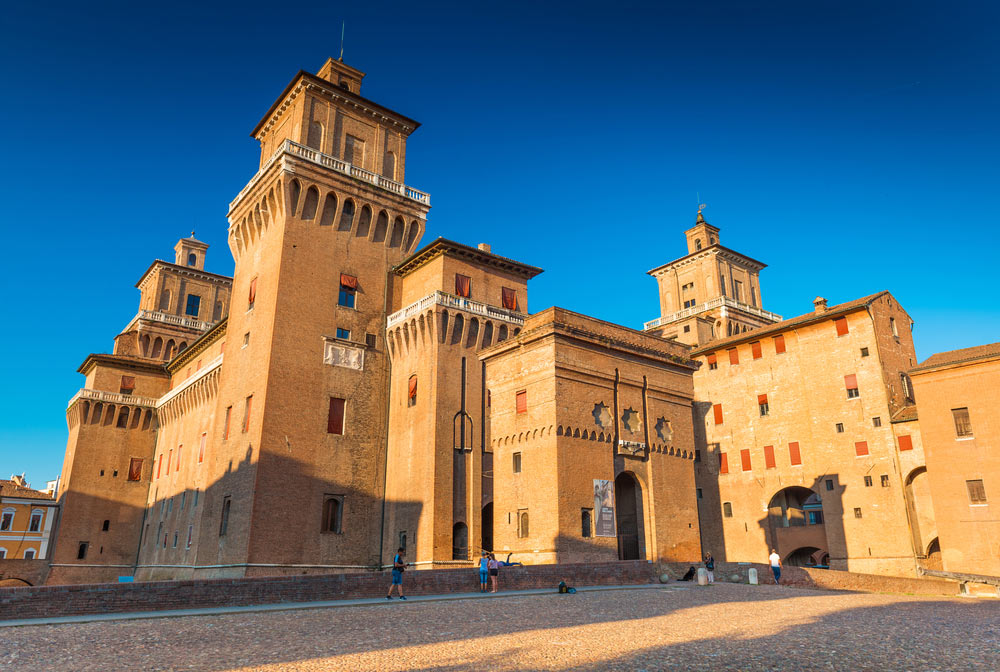
Ferrara is one of the most beautiful Italian towns in the region of Emilia Romagna. It’s a perfect pick for a day trip from Bologna for instance. The medieval town is indeed one of the most outstanding Italy towns. You can explore the medieval streets in the historic center, the cathedral, and the many beautiful squares, streets, unique buildings, and architectural perfections.
As a town in Emilia Romagna, of course, Ferrara is outstanding for its food too! You must try here the Tenerina, which is a famous Italian dessert , but also one of the most delicious local pasta dishes , the Cappellacci di Zucca con Ragu. Cappellacci are like giant tortellini filled with pumpkin cream and it’s served with Bolognese ragu on top. Something incredible, honestly!
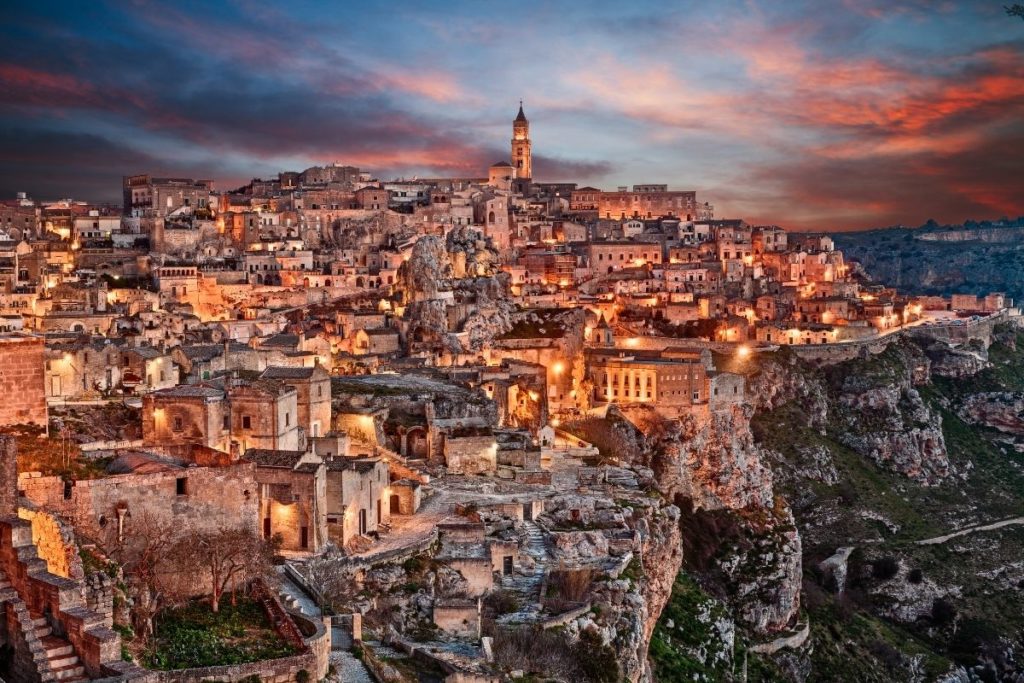
I call Matera the Italian Minas Tirith, and it is definitely one of the most beautiful small towns in Italy. Matera is located in the region of Basilicata, about an hour by bus from Bari International Airport. There’s a bus that’s taking visitors to Matera every hour. On side of discovering the caves, the old houses, and the beautiful town, make sure you stop to eat in Matera, as the food in Basilicata is just heavenly!
Matera is one of the oldest towns in the world, dating back to 8000 years ago. In the valley opposite the town, there are caves where they found proof of people living here over 8000 years ago. Matera is also a UNESCO heritage site, and it is definitely one of the most outstanding, beautiful Italian hill towns I’ve ever seen! And, I’ve seen all of these on the list, and more!
8. Manarola

Manarola is one of the most beautiful Italian towns in the Liguria region. When it comes to coastal towns, Cinque Terre is always a highlight, and Manarola is one of the 5 towns in Cinque Terre. You can explore in the area some of the best beaches in Liguria, as well as you can enjoy some beautiful views, cute streets, and lovely coastlines.
Make sure you check the best restaurants in Manarola, because of the delicious Ligurian food, such as the pesto, or the focaccia. If you want to stay in the area, make sure you check the best hotels in Cinque Terre , to maximize your stay. We also suggest taking the tracking trails that link the towns, especially the one from Manarola, as the view from the trail is just spectacular! Oh, and of course, don’t miss the Aperitivo time on the cliffs!
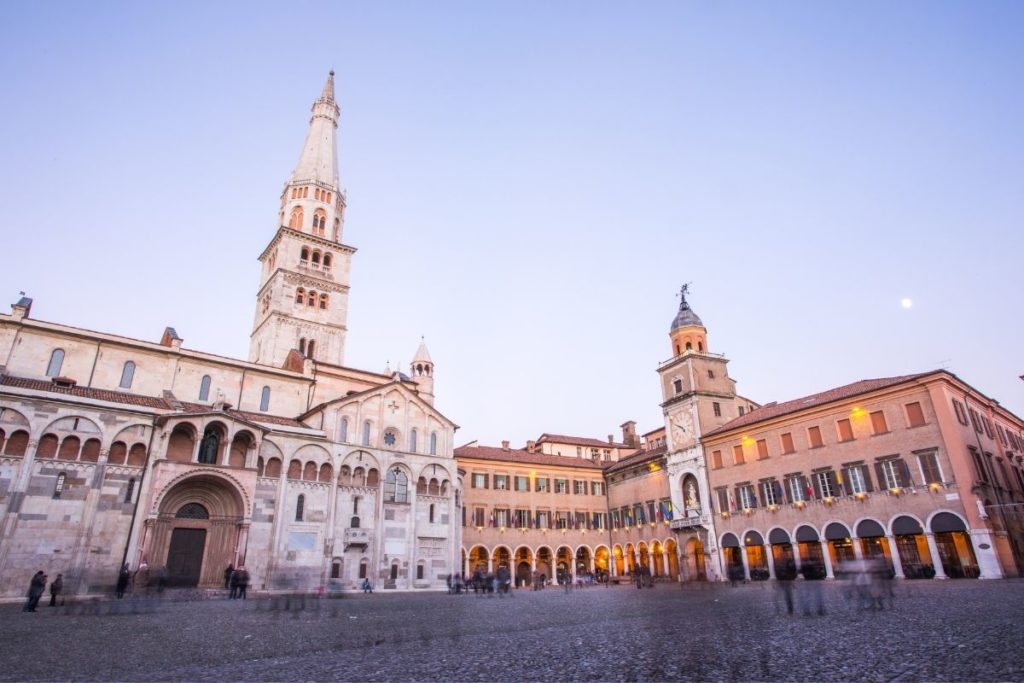
We are back to the Emilia Romagna region once again, bringing next Modena, one of the most charming Italy towns you must explore. Beyond the porticoes, the beautiful historic center, the architecture, churches, and the arts, Modena is also famous for its nightlife. You must check the best restaurants, and best hotels in Modena too!
And on top of all that, there’s the famous Balsamic Vinegar from Modena too! The food in this town is spectacular, just as everywhere in Emilia Romagna, but there’s more here! Modena is one of the best towns in Italy for other reasons too. It’s the hometown of the famous tenor, Luciano Pavarotti, as well as the home of the most famous Italian car brand , the Ferrari.
10. Orvieto
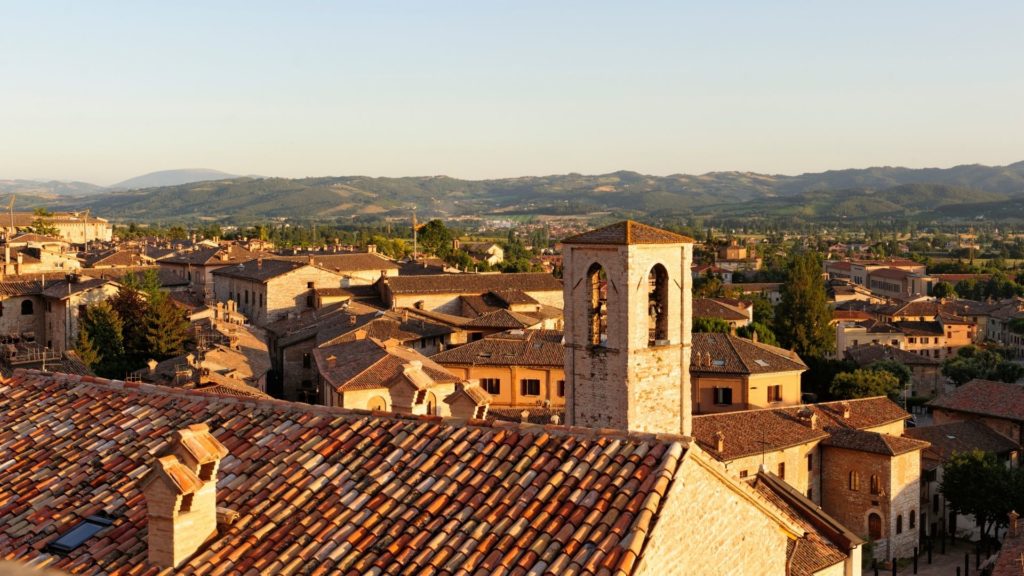
Orvieto is one of the most beautiful Italian hill towns in the Umbria region. If you’re looking for beautiful hilltop Italian towns that are close to Rome , Orvieto is about 1.5 hours away by car, or by train. Orvieto’s old town, the place to explore, is up the hill from the train station. All that cuteness makes it one of the best small Italian towns to visit.
A funicular railway near the station connects the lower town to the upper town, or a mini-bus runs through town. However, one of the best ways to see and savor the spectacular views is to walk up. One of the main reasons to visit Orvieto’s old town is to marvel at the Duomo di Orvieto, the spectacular 13-century cathedral located in the pretty Piazza del Duomo. When you are finished exploring the cathedral, you should then take a tour of the caves. There are over 1200 caves under Orvieto dating back to the Etruscans, each one of them man-made.
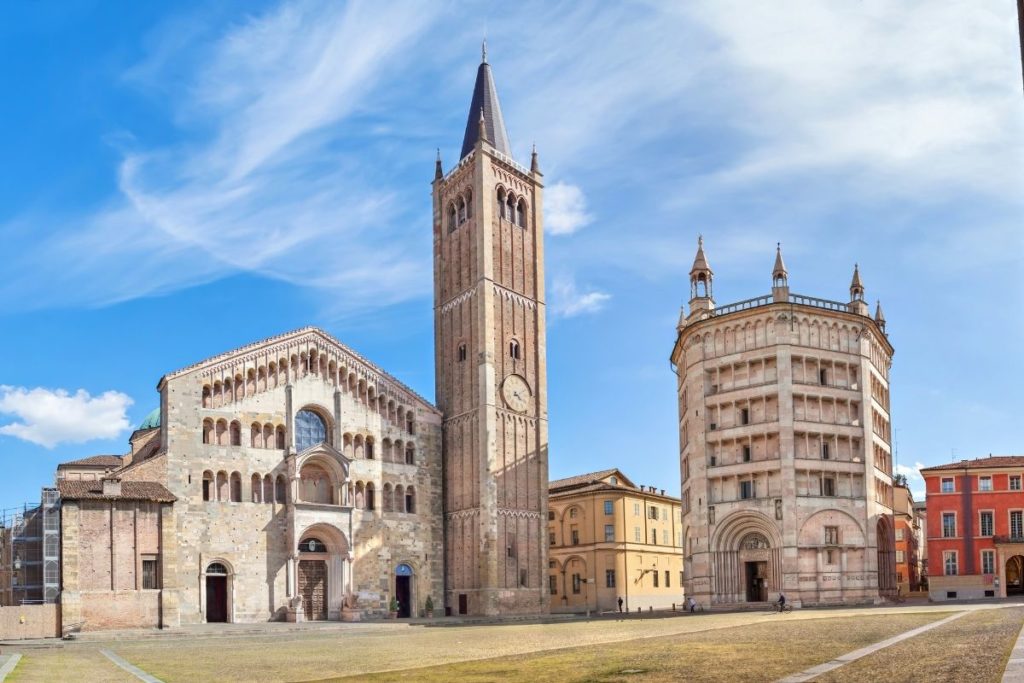
Once again, we are back in Emilia Romagna region, since this is my personal favorite region of Italy, as it was my first home after moving to the country. Parma is one of the most outstanding towns in Italy, and it was the cultural capital city of Europe in 2020, for many reasons.
If you’re looking for a town in north Italy, Parma is between the Northern regions and Tuscany. It’s easy to reach it from Bologna, Florence, or Milan as well. Parma has outstanding architecture, a really charming historic center, an even more beautiful theatre, museums, and a castle too. Beyond that, it’s important for the most famous ham, the Prosciutto di Parma, but also for the worldwide famous parmesan cheese , the Parmigiano Reggiano.
12. Piacenza
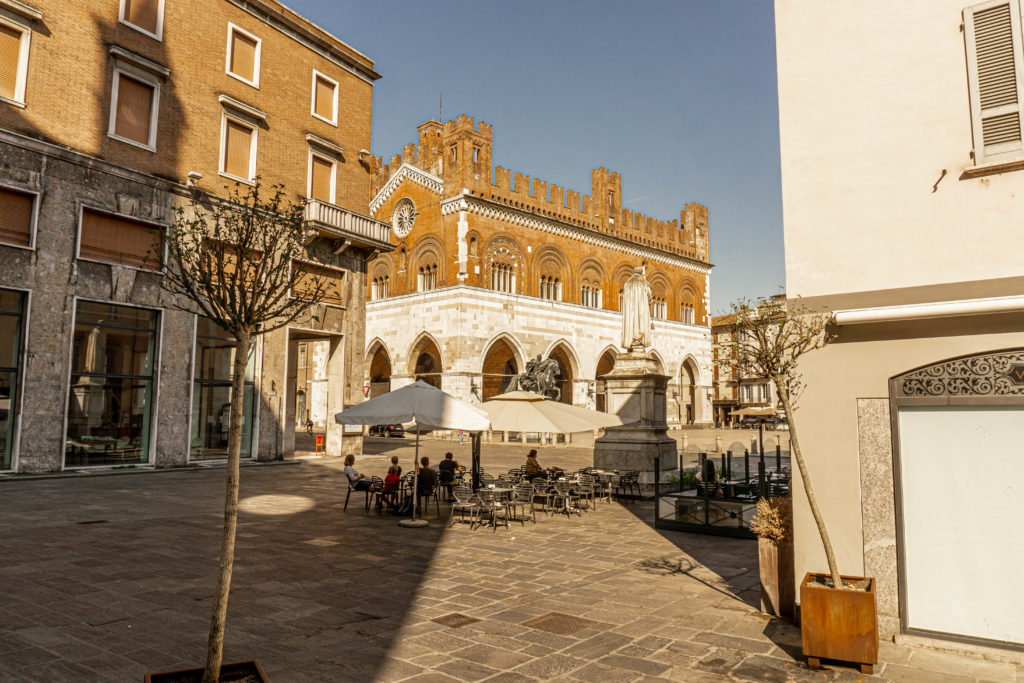
A hidden gem, one of the most beautiful Italy towns in Emilia Romagna is Piacenza itself. When it comes to small towns in Italy, Piacenza is one that’s not yet overtaken by tourists, and it’s really authentic still. You should discover the Piazza Cavalli with Palazzo Vecchio in the middle.
Then, the Palazzo Farnese, the Duomo di Piacenza, and the Basilica di Sant’Antonino too. In this last one, you’ll find beautiful frescoes. The historic center is charming and packed with loads of cafes, restaurants, and bars. Then, of course, the food! Three of the most famous Italian cold cuts are made in Piacenza. These are the Coppa, Pancetta and Salume from Piacenza.
Also, one of the most famous dishes here to try is the Anolini in Brodo. This is similar to the tortellini, it’s rounded instead and they look like the sun. Now, the Anolini is filled with stracotto, which is minced meat that’s cooked for 3 days, along with cheese. This pasta is served in meat broth, and you should put Parmigiano Reggiano on top!
13. Polignano a Mare
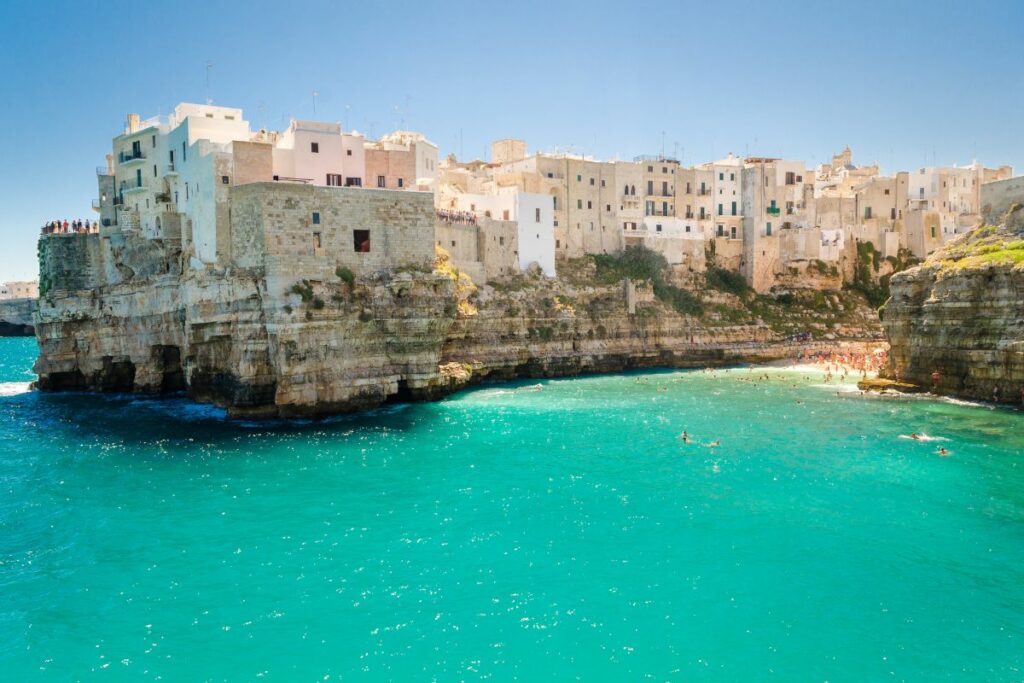
Polignano a Mare is one of the most beautiful Italian towns in the region of Puglia. When it comes to the most beautiful beaches in Puglia or the most fascinating summer destinations in Italian coastal towns, then Polignano a Mare is the place to go. The beautiful white historic center, charming streets, and beautiful views from the top of the cliffs.
Polignano a Mare is one of the best towns in southern Italy that’s also affordable, pretty, and offers one of the most picturesque town beaches you’ll ever see. The nightlife in Polignano a Mare is also outstanding, and the famous Pugliese food … Don’t miss trying local dishes in the osterias and trattorias of the town. You can reach Polignano a Mare easiest from Bari. It’s reachable by train or bus, but as always in Puglia, a car is recommended!
14. Portofino
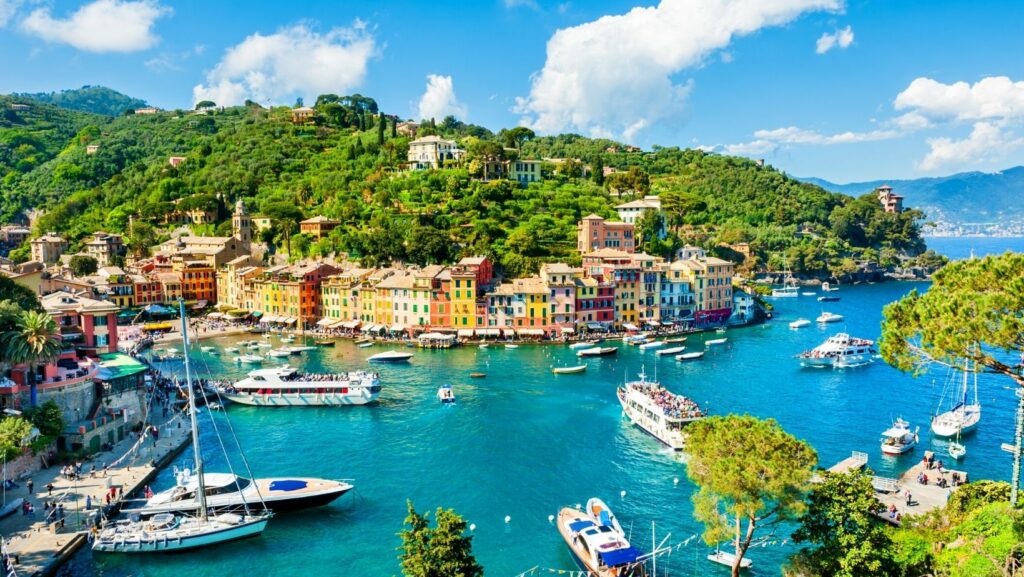
Portofino is one of the most refined, exclusive, and beautiful towns in Italy. When it comes to the most beautiful, and even fanciest Italian coastal towns, it’s also Portofino that’s on top of the list. Portofino is located in the region of Lugia, on the Italian riviera . If you’ve got Portofino on your list, you must check the best hotels and restaurants in Portofino too!
Yachts , exclusive places, and pricy food that comes with the most magical views, in a town that can easily compete with Positano even. Besides relaxing and boating, you can go hiking, diving, or do other watersports in the area. You must also visit Chiesa di Divo Martino here, while you’re exploring all the elegant, fashionable , and posh places in town. Portofino is reachable easily from Milan or Genoa.
15. Positano
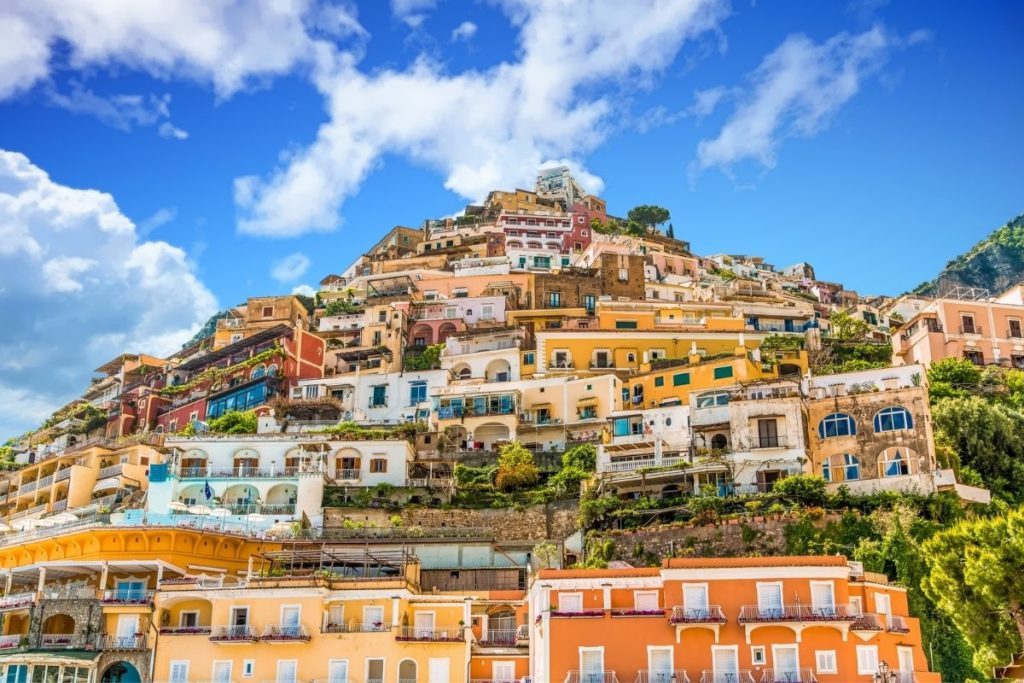
Positano is definitely one of the most famous Italian towns on this list. Everyone has seen or heard of the colorful cliffside town which is actually one of the popular Italian tourist town near Naples. Positano is located on the Amalfi Coast. A dreamy destination that offers beautiful views over the sea, and the town itself.
Positano is a place of amazing food, dreamy sunsets, great restaurants , and the dreamiest Amalfi Coast-style hotels . When it comes to dreamy Italy towns, ones that look like they’ve been taken out of a fairytale, Positano is always on the list. You can easily reach this place from Naples by ferry or bus. Enjoy a scooter ride on the serpentines, and eat some great seafood while sitting under fruit trees or on the town’s beach.
16. Porto Cervo
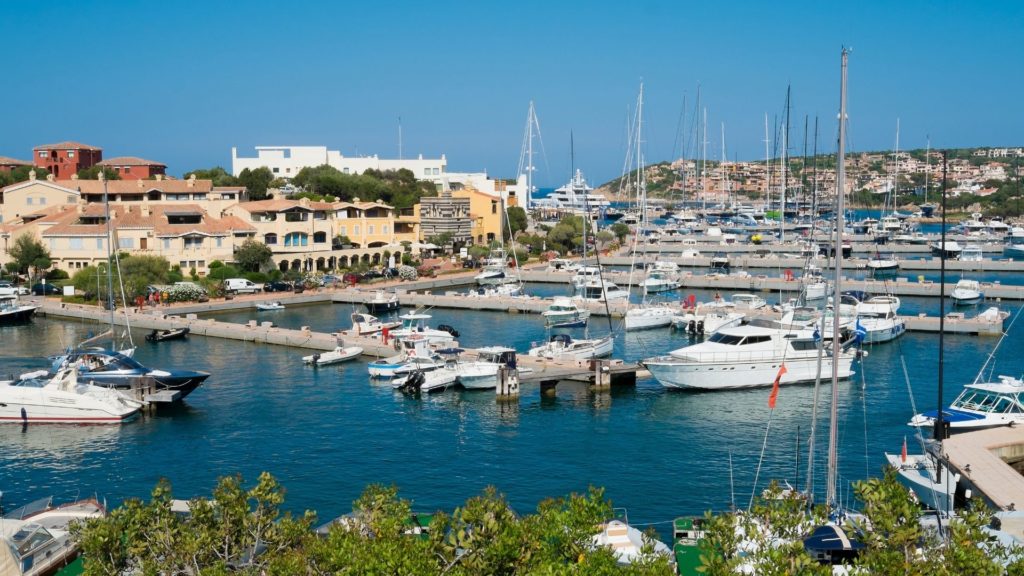
When it comes to beautiful towns in Italy, Porto Cervo is one of the highlights when it comes to the island of Sardinia . This is one of those small towns in Italy that just like Portofino, it’s visited mostly by the rich and famous. Elegant party places, fancy restaurants, and yachts all around.
You can find in this area plenty of luxury hotels , beach clubs , and the most beautiful beaches in north Sardinia . Visiting Costa Smeralda is one of the best picks you could have for an Italian vacation. The white sandy beaches and crystal clear light blue and emerald waters are just like nowhere else!
17. Ravenna
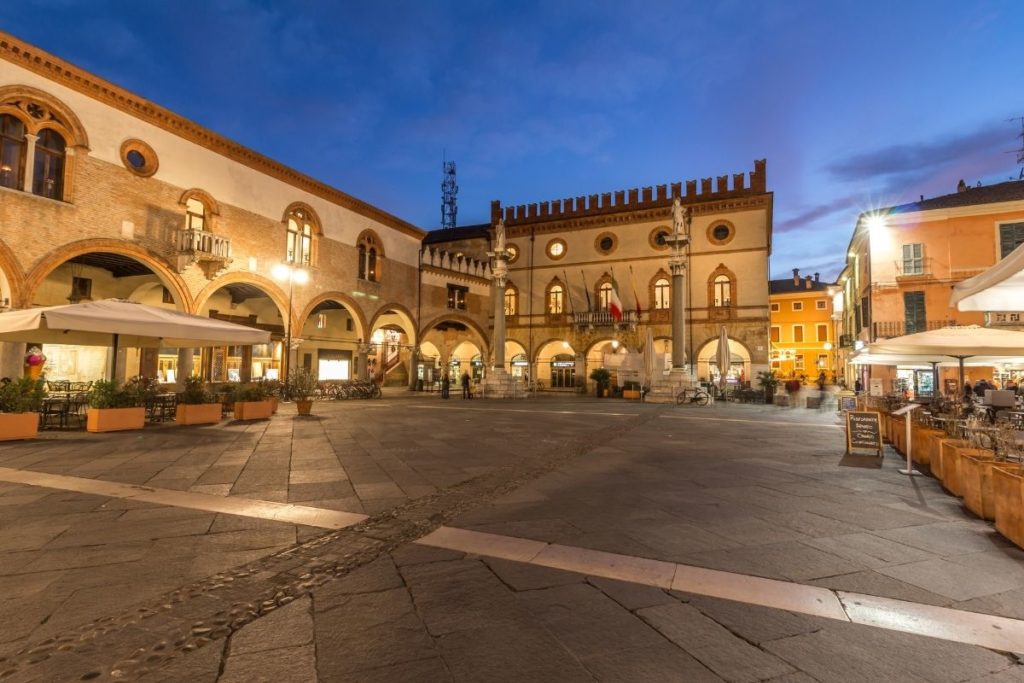
Another highlight of Italian coastal towns is Ravenna , in the region of Emilia Romagna. Ravenna offers lovely beaches, ancient history that takes us back to Roman times, and some of the most unique frescoes and mosaics dating back to Byzantine times.
On side of the great food, beaches, and beautiful historic center, in Ravenna, you’ll find several UNESCO World Heritage Sites. This is a great place to visit if you’re rather skipping the busy Rimini, as Ravenna is not far from it. You can also reach Ravenna from Bologna or Venice easily by train too. And also, make sure to check the best restaurants and hotels in Ravenna !
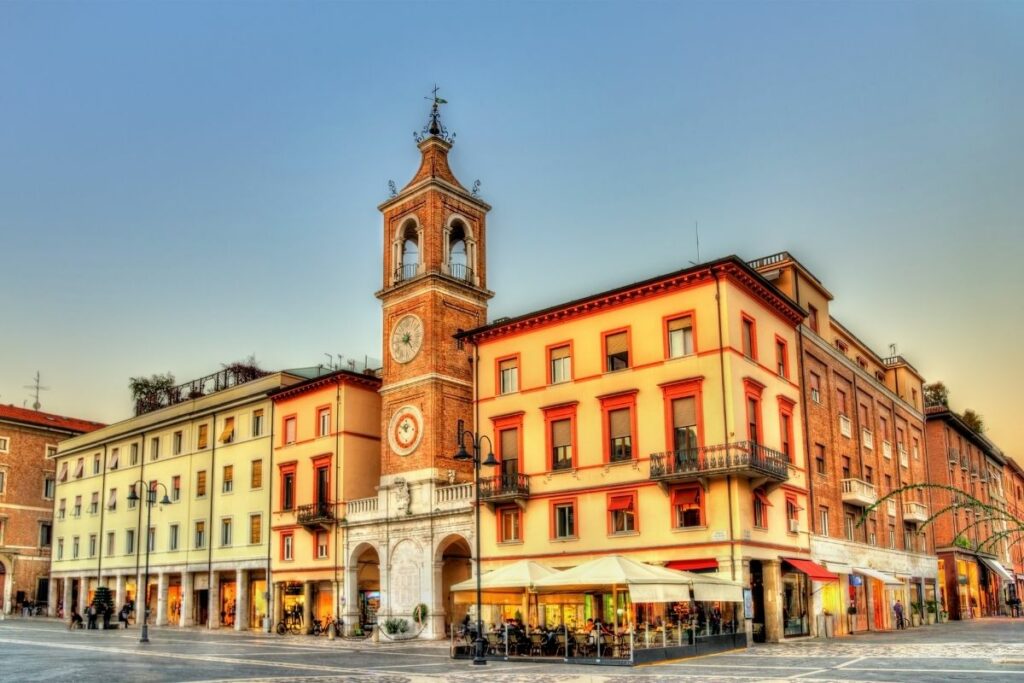
Rimini is one of the most popular Italian towns when it comes to summer holidays. This town is also located in the Emilia Romagna region, and it is home to some of the most famous beaches in Emilia Romagna . When it comes to budget travel to Italy , Rimini is one of the Italy towns that’s affordable, and it’s really packed each summer, all summer.
The town offers kilometers of sandy beaches, with a really developed beachside area packed with restaurants, bars, and cafes. Depending on where you stay in Rimini, many hotels have their own beach areas in the city. Nightlife in Rimini is also outstanding, as you can imagine, during the summer. You can easily reach this town from Bologna, Venice, or Milan by direct trains, but by car, it’s easier from anywhere else.
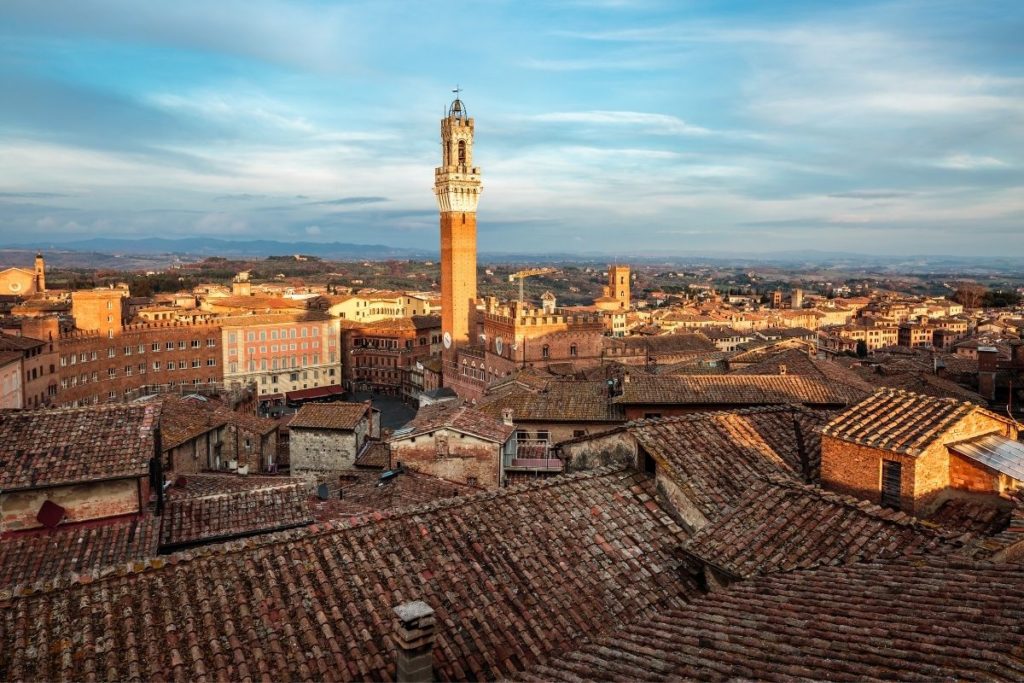
Siena is one of the most beautiful Tuscan towns in Italy. When you’re looking for Italian hill towns, you’ll find Sirmione always among the top-rated ones. The medieval town features lots of amazing buildings, historic sights, and the Piazza del Campo, which is one of the most famous medieval squares in all of Europe.
Don’t forget one of Italy’s most imposing churches, the Cathedral of Siena either. Then, there’s the great Tuscan food, and local specialties, like truffles, olive oil , cheese, cured meats, ceramics , and much more. Siena is the town for romantic getaways, honeymoons, and great Tuscan wine.
You can reach it from Rome or do a day trip from Florence easily. If you’re exploring Tuscany by car, Siena should be one of the Tuscan towns you won’t skip! Make sure you also check the best restaurants and the best hotels in Siena for a perfect trip!
20. Sirmione
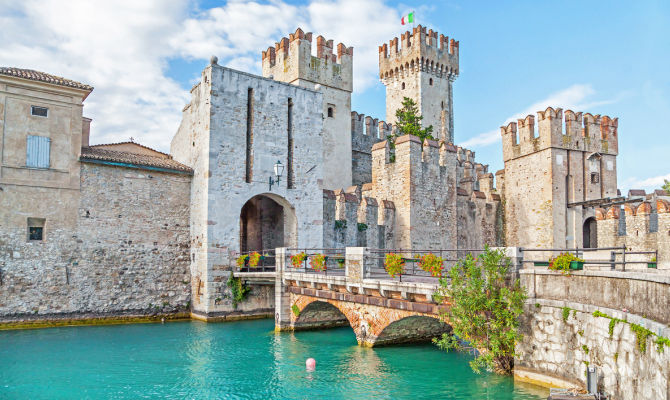
Sirmione is one of the most beautiful Italian towns around Lake Garda . It’s located on the south shore of the lake, and its historic center is built on a long peninsula stretching out on the lake. Sirmione is one of those small towns in Italy that has all the magic for a perfect holiday.
Towns in north Italy are usually very clean, and very well-maintained. Therefore, Sirmione too is beautiful, clean, and covered in oleanders, flowers, and palm trees. You can enjoy some amazing food here, along with great wine from the nearby Valpolicella, and have nice walks in the town. You can enjoy the summer on the lakeside, while you can also head to the mountains or the nearby Verona for day trips.
21. Sorrento
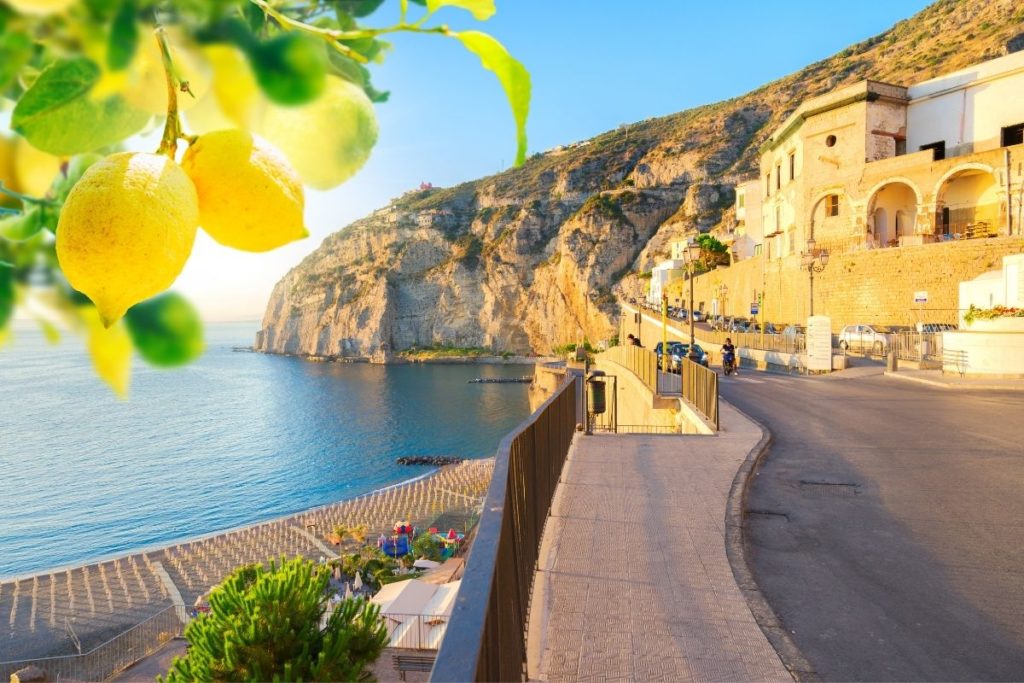
Sorrento is an Italian tourist town near Naples, on the Sorrentine peninsula. This is one of the most beautiful towns in Italy, built on top of the cliffs, offering an incredibly beautiful view over the bay of Sorrento and the Vesuvius volcano.
When it comes to beautiful Italy towns for summer destinations , Sorrento is one of the most preferred around the Amalfi Coast. The charming town whose streets is covered in orange and lemon trees. The food in Sorrento is incredible, and this is considered one of the cheapest destinations in the area. You should check the restaurants and hotels in Sorrento to plan your vacation.
22. Taormina
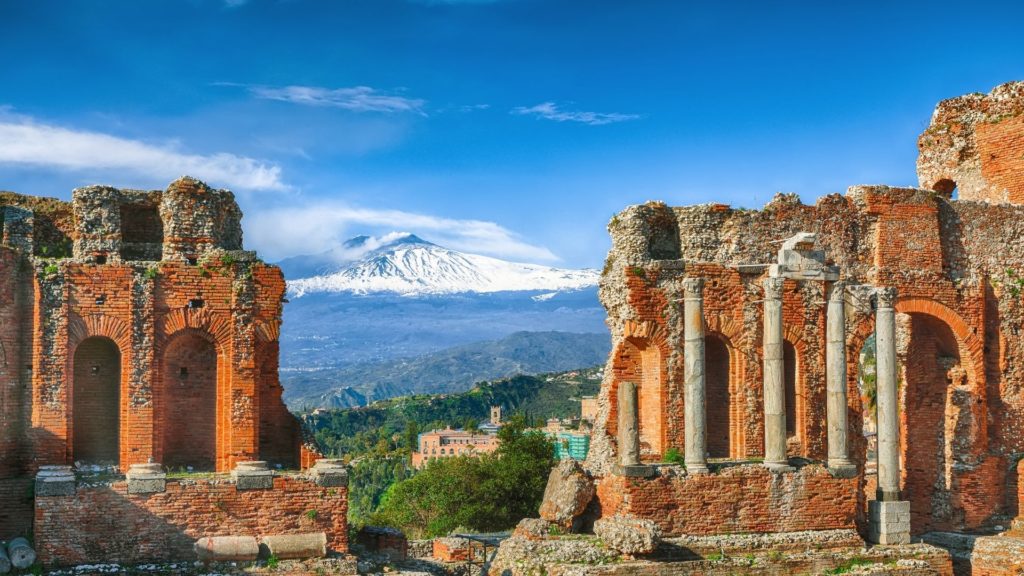
Finally, here’s one of the best towns in southern Italy, specifically in Sicily : Taormina. Taormina is one of the most beautiful Italian coastal towns in Sicily, offering not only beautiful beaches , but rich history dating back to Greek times, spectacular views over mount Etna, and amazing Sicilian food !
You can reach Taormina from Catania or Palermo. If you’re not into a road trip around Sicily, it’s recommended to fly into Catania, and take the bus or taxi from here to Taormina. Once you’re in the town, you should plan a hike on Mount Etna, one of the active volcanoes of Italy . You can do ATV tours, go diving, boating, or snorkeling too. On top of that, you must visit the Greek theatre too! There are plenty of great restaurants and hotels in Taormina to stay at!
Trento is one of the most charming alpine Italian towns in the region of Trentino Alto-Adige. The town is located north of Lake Garda, about 1 hour away from Verona. It’s really easy to reach it both from Verona, and from Bolzano or Innsbruck. This is one of the most beautiful towns in north Italy.
Trento offers a lot. Great food, charming streets, colorful architecture, the Buonconsiglio castle, and all this with spectacular views over the Italian Alps. This is a great town to visit for those who are looking for mountain destinations! You can do hiking around the town, as well as you’ve got quite a few ski resorts in the area. Culturally, the town has a great number of museums, churches, and expositions to explore.

When it comes to the best towns in southern Italy, Tropea is one of the most popular gems that is currently becoming more and more popular among visitors. If you’re looking for beautiful Italian towns for summer vacations, Tropea is one of the best picks in the region of Calabria. While it’s hard to fly into this area, you can reach Tropea from other big southern cities.
Legend says that Tropea, one of the most charming Italy towns was founded by Hercules himself. The historic center is really pretty, while you’ve got the beautiful beach right under the cliffs. You can find here the sanctuary of Saint Mary’del Isola on an island connected to the mainland, and turquoise water too. For those looking for budget destinations with sandy beaches, cliffs, and the vibes of Southern Italy, Tropea is the right pick. Make sure to check the best hotels in Tropea too!
25. Vernazza
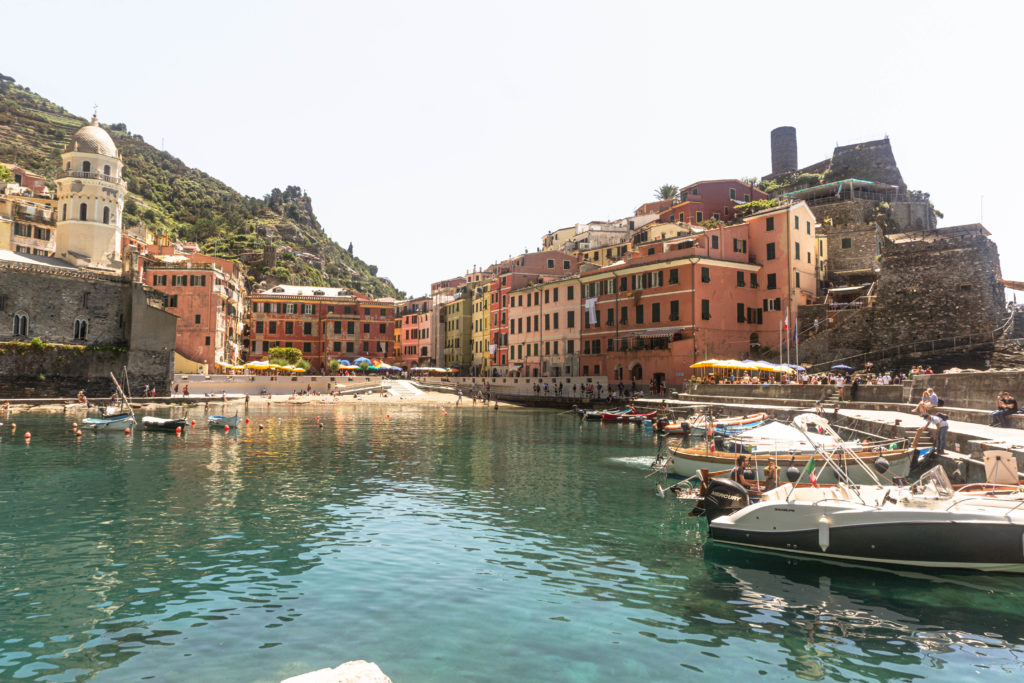
Vernazza is one of the most charming towns in Italy. One of the 5 towns of Cinque Terre, a coastal town that’s all about breathtaking views, cute streets, local products of food, and handmade products. Vernazza also has a beautiful little beach and beachside restaurants to enjoy the views from.
You can reach Vernazza along with the other towns of Cinque Terre from La Spezia by train, or from Genoa and Milan. It’s not recommended to visit Cinque Terre by car, as parking is impossible, and it’s a waste of time. The train makes 5 minutes between the towns of Cinque Terre. The tracking trail from Vernazza to Monterosso is also one of the most beautiful pieces of the Cinque Terre trail.
Wrapping up the 25 most beautiful Italian towns
Now that we’ve been through the best Italy towns, we hope you’re ready to plan your Italian trip. Make sure you check all the linked articles under each of the towns in Italy, so you can get all the information needed to plan a holiday. We tried to cover some of the top small towns in Italy, and some of the most famous Italian hill towns, but of course, there are much more that are beautiful and worth visiting than these 25. We cover all of Italy, so make sure you read through our online publications and find more amazing places!
Hungarian article: Olasz kisvárosok
Pin it: Italian towns
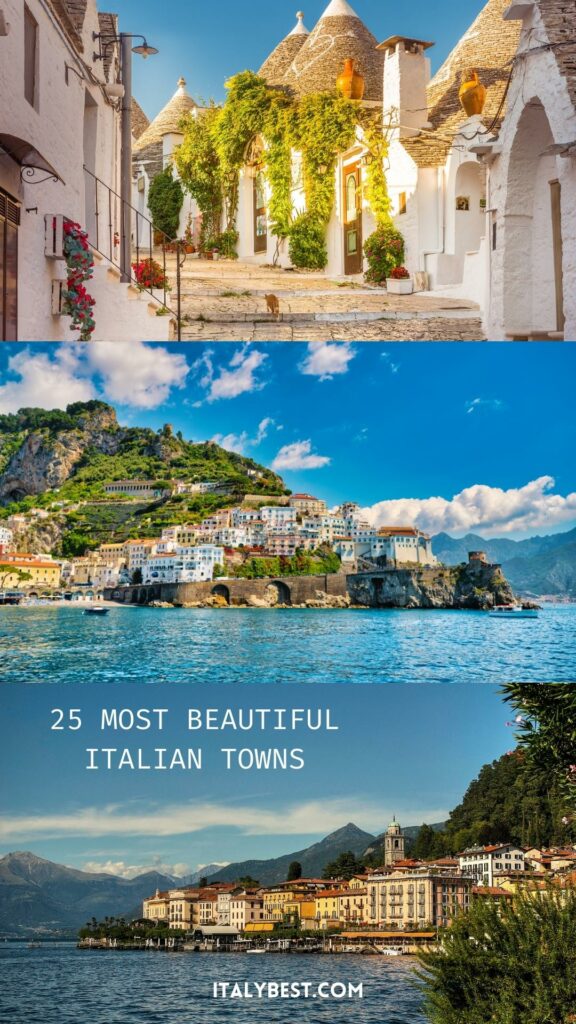
Copyright Italy Best© 2022. All rights reserved
Cooking Classes in Rome
You cannot copy content of this page

- Business travel
- Italian food
- Train world
- Travel ideas
- Buy your tickes
- Destinations & Timetable
- Italo Go Services
- Travel with Italo
- Loyalty Programme
Italoblog » Travel ideas » What to see around Naples, towns and attractions
What to see around Naples, towns and attractions
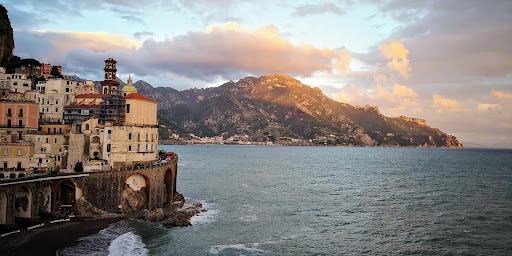
Wonderful villages overlooking the sea, archaeological parks, UNESCO sites and much more: discover the villages near Naples you absolutely must visit.
Naples is the city of sun and sea and definitely deserves a complete tour at least once in your life. Before planning everything, however, it would be better to think about a longer holiday so that you can have a chance to visit wonderful places nearby. So, here is what to see in the surrounding area and what towns near Naples you absolutely must visit .
Campi Flegrei Archaeological Park
Suffice it to say that in Roman times, the area was devoted to otium and was a favorite vacation spot. So reserve some time to visit the Castle of Baia and the Campi Flegrei Archaeological Museum , the Archaeological Park of Cuma and the Antro della Sibilla suggestive place where the Cumana Sibyl would proclaim her oracles. Also worth a stop are the Roman Baths of Baia, the Flavian Amphitheater and the historic center of Pozzuoli .
Reggia di Caserta (the Caserta Royal Palace)
Talking about places to see near Naples, we must include the Royal Palace of Caserta . A UNESCO World Heritage Site, the Royal Palace of Caserta is the largest royal residence in the world in terms of volume. From the royal apartments, to the Court Theater amd the adjoining gardens (as many as 25 hectares), the Palace deserves a day to itself. The Royal Palace is open every day, except Tuesdays, from 8.30 am to 7.30 pm, with last entry at 6.30 pm. The cost of the ticket varies depending on the areas you wish to visit:
- Admission to the Royal Park and the English Garden costs €9.
- Admission to the Apartments costs €10 (accessible only when the Royal Park is closed)
- The combined ticket for Park and Apartments costs €14.
Pompeii Archaeological Park
When it comes to sites near Naples, a stop at one of the world’s most famous archaeological centers is a must: Pompeii and Herculaneum are definitely on the must-see list. From the Forum to the Amphitheater via the Temple of Apollo to the House of the Faun or the Villa of the Mysteries with its frescoes of the Dionysian mysteries, you will be enthralled by one of the world’s most beautiful UNESCO World Heritage Sites. Tickets for the Pompeii and Herculaneum Archaeological Park can be purchased online. The Pompeii site is open every day in winter from 9 am to 5 pm and in the summer from 9 am to 7 pm; closed days are 25 December, 1 January and 1 May. From March to October, the Herculaneum Archaeological Park is open daily except Wednesdays, 25 December and 1 January with hours from 9.30 am to 7.30 pm and during the October to March period from 8.30 am to 5 pm.
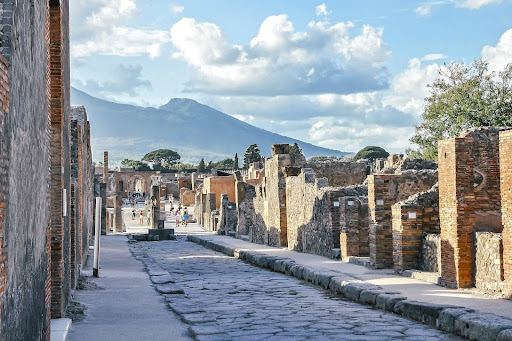
The Vesuvius National Park
If you’re into trekking, you can’t miss the Vesuvius National Park , with its wonderful scenery and a spectacular view of Naples and the Gulf. The park features 11 trails over a total of 54 km with the possibility of seeing an incredible variety of animal, plant and mineral species.
The Paestum and Velia Archaeological Park
The Paestum and Velia Archaeological Park is one of the oldest Greek settlements: a UNESCO World Heritage Site, the site in fact dates back to the 6th century BC. Visit the remains of the ancient Agora , the temples of Hera , Neptune and Athena , the Amphitheater , the Forum and the National Archaeological Museum of Paestum with the famous Tomb of the Diver , the world’s only example of figurative Greek painting. The site is open daily from 8.30 am to 7.30 pm and is closed on Mondays, 25 December, and 1 January. Tickets cost €6 and there are family discounts.
The Amalfi Coast
Speaking of towns near Naples , all those on the Amalfi Coast, a destination of tourists worldwide, are most certainly worth visiting. Positano , Amalfi , Vietri sul Mare , Maiori , Minori , Ravello and Cetara – they are all enchanting towns overlooking the sea, which is precisely why the Amalfi Coast deserves a tour by itself of at least two days.
The Sorrento Peninsula
Just 25 km from Naples, easily reachable also with the Circumvesuviana railway system, lie the Sorrento Coast and the city of Sorrento, an international tourist destination. Definitely worth visiting are the historic downtown, the Villa Comunale, the Cathedral and the Cloister of San Francesco.
To Naples and the surrounding area with Italo + Itabus
Reaching Naples by high-speed rail today is convenient and economical thanks to Italo Treno. Check the schedule and fares for trains to Naples Centrale and buy your discount ticket: getting to the city of sun and sea has never been easier! Reach the locations of the surrounding area by buying the new Italo High-Speed Train + Itabus coach travel solutions directly in one ticket on italotreno.it
You may also be interested in

Italo Newsletter
Discount codes and promotions, other posts.

Discover our guides
- Where to eat in Rome
- Where to eat in Milan
- Where to eat in Naples
- Where to eat in Venice
- Where to eat in Bologna
- Best brunches in Italy
- Traveling with pets
- Best itineraries in Italy
- By train to the sea
- By train to the mountains
- Nature Trails
- Train stations in Italy
Our stations

- Things to do in Naples
The Best Experieces All Around Naples
Typical products, Fashion, Souvenir...
Pizzerias, Restaurants, Street Food, Bakeries...
Museums, Castles, Archaeological Sites...
Visit the places of Naples for free
Discover the wonders of Naples
Wellness, Where to drink, Fun...
- Choose your accommodation
Best Bed & Breakfasts in Naples
Best hotels in Naples
Best vacation rentals in Naples
Best Hostels in Naples
Discounts at the best facilities in Naples
- Naples Pass

Discounts, museums and public transport in Naples
- Tips for visiting Naples
Info, luggage storage, maps, useful numbers...
Visit Naples in autonomy
Travel for free throughout Campania
Where to park your car in Naples
- Visit Naples

Traveller guide for the city of Naples
- Attractions
- Napoletanity
Accedi gratis alle principali attrazioni di Napoli ed ottieni sconti nelle migliori attività

- Ingresso gratuito alle principali attrazioni di Napoli
- Trasporti pubblici gratis per tutta la Campania
- Sconti nei migliori Hotel, Ristoranti e Attività commerciali
Trip around the cities near Naples: from Caserta to Avella

The city of Naples is certainly the most prestigious and best known of all the cities of Campania. Its monuments and history raise the glory of its name not only in the rest of Italy but also in the rest of Europe and the world. But in its surroundings, and more extensively in the Campania region, there are also other interesting cities.
Big or small, these towns can boast a great history behind them that has contributed to making these areas rich in testimonies. Today we will take you on an itinerary that we have prepared especially for you, to introduce you to these towns near Naples, which are a bit like Naples' “little sisters”. Enjoy your trip!
Discover all the advantages of Naples Pass ❯
5. Caserta: the city loved by the Bourbons
-min.png)
Our tour around Naples starts from the beautiful city of Caserta , known worldwide for its famous palace, the "Italian Versailles". The construction of the Royal Palace of Caserta was commissioned by the king Charles of Bourbon, in the mid-18th century, to the great architect Luigi Vanvitelli.
The historical flats, the large park, the English gardens: these are just some of the wonders that await you at the Reggia di Caserta . Another important point of interest is the magniloquent Carolingian aqueduct, another great work by the happy union of Charles III of Bourbon and Luigi Vanvitelli, a work that does not fear comparison with its Roman ancestors.
To stay on the Bourbon theme, the Complesso Monumentale del Belvedere di San Leucio , an important silk factory, is also a must-see. Before leaving Caserta for the next stop, it is worth making a detour to Casertavecchia, an ancient medieval village, where you can enjoy a magnificent view over the Plain of Caserta and where the cathedral dedicated to San Michele Arcangelo is not to be missed.
Discover how to jump the queue for the Royal Palace of Caserta ❯
4. Salerno: the handmaid of the Tyrrhenian Sea
.png)
And now let's move further south, to admire another of the bell sisters of Partenope, Salerno, also majestically lying on the Tyrrhenian Sea. Leaving aside the marvelous Amalfi Coast , which deserves a separate discussion, Salerno City has had a significant increase in tourism in recent years, thanks also to the now infamous Luci d'Artista Christmas festival.
Among the many attractions, the beautiful cathedral dedicated to St Matthew, whose remains rest in the Baroque-style crypt, is certainly not to be missed. Also of great interest is the remaining historic centre where a conspicuous series of shops, bars and boutiques accompany tourists on a pleasant stroll.
Two steps that absolutely must be taken towards the Lungomare Trieste to admire, in a single glance, the aforementioned Amalfi Coast on one side and the Cilentana Coast on the other. And, by the power of imagination, our next stop. Not before, however, taking a look at two other monuments of medieval origins: the Castello di Arechi and the Complesso di San Pietro a Corte, two testimonies to the city's long and complex history.
3. Sant'Agata de'Goti: the queen of Sannio
-min (1).png)
And now let's move to the province of Benevento , in the ancient territory of Sannio, to visit one of the most characteristic villages of the Campania region: Sant'Agata de'Goti . Perched on a tufaceous terrace, Sant'Agata stands overwhelmingly in front of our gaze, with its simple beauty and its rich and fascinating history, which has its roots in the Samnite era, when the village was called Saticula, also if its true face acquired it in the Lombard era.
The first step of the visit is the Vittorio Emanuele bridge , where you can immediately admire the remains of the Longobard castle, which has been remodelled several times. Also of great interest is the church of San Menna: a splendid example of Romanesque style, the church was consecrated around 1100 by Pope Paschal II.
The tour through the monuments and landmarks of Sant'Agata dei Goti is not yet over, there is still one last stop to discover. We are talking about the Church of the Annunziata , founded in the 12th century. This site is an extraordinary example of Gothic art with an extraordinary cycle of frescoes that have recently been rediscovered and restored.
2. Aversa: city of Art and History

We return to the parts of Caserta and stop in Aversa , a town rich in art and history, but also a vibrant city and vital for its intense nightlife. Founded in the Norman era in 1030, the city dominates the so-called Terra di Lavoro, also known by the name of Campania Felix. Home to some great musicians such as Cimarosa and Jommelli, the city offers its visitors delicious delicacies such as buffalo mozzarella and sour wine and numerous monuments.
These include St Paul's Cathedral , founded back in 1053 and remodelled several times over the centuries. The church and convent of San Francesco delle Monache, founded in the 13th century, enriched with works by some of the great masters of the Baroque era, such as Pietro da Cortona, Francesco De Mura and Jusepe de Ribera.
Aversa is also rich in important and prestigious examples of civil architecture. Not to be missed are Palazzo Golia , which belonged to the Barons de Conciliis and was famous for having hosted Garibaldi on the eve of the Battle of Volturno in 1860, and Palazzo Gaudioso , a solemn and austere 15th-century building of Tuscan memory.
Visit Naples enjoying the Naples Pass benefits ❯
1. Avella: between Romans, Samnites and Lombards
.png)
Our tour around Naples ends with a town not very well known in the province of Avellino, but full of attractions for the tourist. It is Avella , a city that has its roots in the Samnite and Roman eras, but which can also boast some evidence of prehistoric times.
Avella's older history is well told by the important Antiquarium located in Via Francesco De Sanctis and the Monumental Necropolis Archaeological Area in Via Tombe Romane. Of particular interest and witness to a certainly more recent history is the Castle of Lombard origin dedicated to the Archangel Michael, whose massive bulk dominates the town of Avella from a hill, an imperishable symbol of the town.
It is precisely from the castle that it is possible to admire all the beauty of the area around Avellino and beyond. In fact, from here the visitor can, with his or her imagination, embrace the infinite charm of the Campania region and reconnect with his or her thoughts and heart to all the cities he or she has met on this small but fascinating journey.

Ti consigliamo
Lascia un commento.

Scopri subito come risparmiare!

17 Top-Rated Tourist Attractions in Naples & Easy Day Trips
Written by Barbara Radcliffe Rogers Updated Aug 8, 2024 We may earn a commission from affiliate links ( )
Even if you've been to many Italian cities, nothing prepares you for the exuberant, colorful, and sometimes chaotic hubbub of Naples. The entire population seems to be in the streets that spill down into its harbor, and they're all talking at once.
Colors here seem brighter, and aromas of pizza–Neapolitans claim to have invented it–waft through the air, along with operatic areas (everyone here is a tenor waiting to be discovered), laughter, and maybe an argument or two. It's a city that will keep all your senses busy.
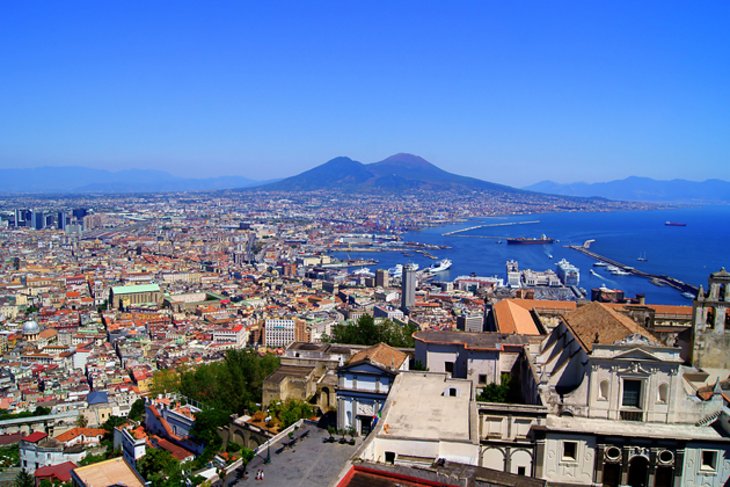
That's not to say it doesn't have a bounty of things to do and attractions for tourists. One of the world's finest archaeological museums holds the treasures of nearby Pompeii , and much more. For centuries, Neapolitans have lavished attention and riches on their magnificent churches, while royalty of several great houses of Europe have decorated its palaces.
The city's long history, dating back to the Greeks in the eighth century BC, included Byzantine, French, Spanish, and Austrian rule, each of which left its mark. And beyond the churches, palaces, and museums , the narrow neighborhood streets, broad promenades, and parks you'll find while exploring Naples are sights in their own right. Find more great places to visit here and nearby with our list of the top tourist attractions in Naples.
See also: Where to Stay in Naples
1. Castel Ovo and the Lungomare
2. national archeological museum, 3. cappella sansevero, 4. capodimonte royal palace and museum, 5. castel nuovo, 6. catacombs of san gennaro, 7. shopping for presepi on via san gregorio armeno, 8. palazzo reale (royal palace), 9. teatro di san carlo, 10. shopping at galleria umberto i, 11. san martino monastery and museum, 12. cathedral, 13. galleria borbonica (bourbon tunnel), 14. san domenico maggiore, 15. santa chiara, 16. catacombs of san gaudioso, 17. exploring santa lucia, where to stay in naples for sightseeing, day trips from naples, herculaneum, amalfi coast, caserta palazzo reale, benevento and the arch of trajan, castellammare di stabia, map of tourist attractions in naples & easy day trips, naples, italy - climate chart.
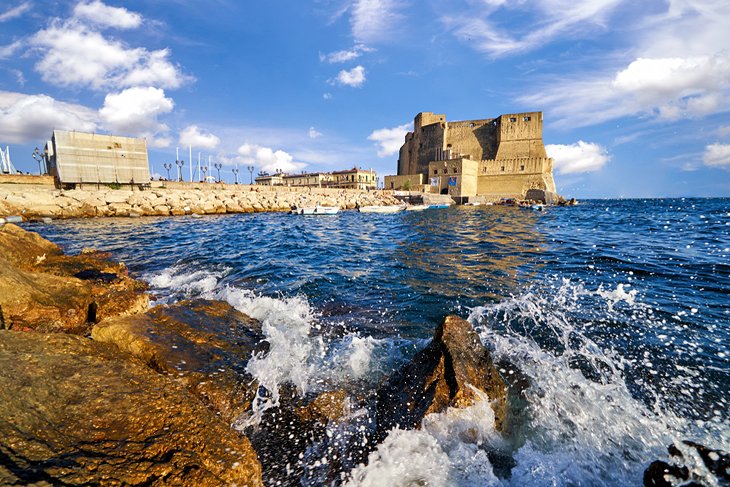
Along the waterfront, at the historic gateway to the Mediterranean and the world, you can get a feel for this vibrant city. Naples harbor is divided into separate docks and basins by a series of piers and breakwaters, and is always bustling with activity.
The Lungomare is a beach promenade that follows the shore for about 2.4 kilometers along Via Partenope and Via Francesco Caracciolo in the Chiaia neighborhood, with beautiful views across the bay to Vesuvius and plenty of cafés and ice-cream shops. Stroll here, enjoy the views and lively atmosphere, and sample Naples' contribution to food history–margherita pizza.
Sitting on a promontory at the end of Via Francesco Caracciolo is the 12 th -century Castel Ovo, the oldest castle in Naples. The views of the harbor, ferries, bay, and Mt. Vesuvius are even better from its ramparts, and inside is an Ethno-Prehistory Museum with ceramics and other artifacts from ancient Naples. There is no charge for admission to the castle and museum, which, like the Lungomare, are among several free things to do in Naples.
Beyond the castle lies the busiest part of the Port of Naples, with the cruise port and departure point for ferries to Sicily, Sardinia, and elsewhere. Farther south, from the quay on the Calata di Beverello, boats sail to Ponza, Capri, and Ischia. Naples is the principal port for southern Italy, and the harbor is its heart.
Official site: http://www.castel-dell-ovo.com
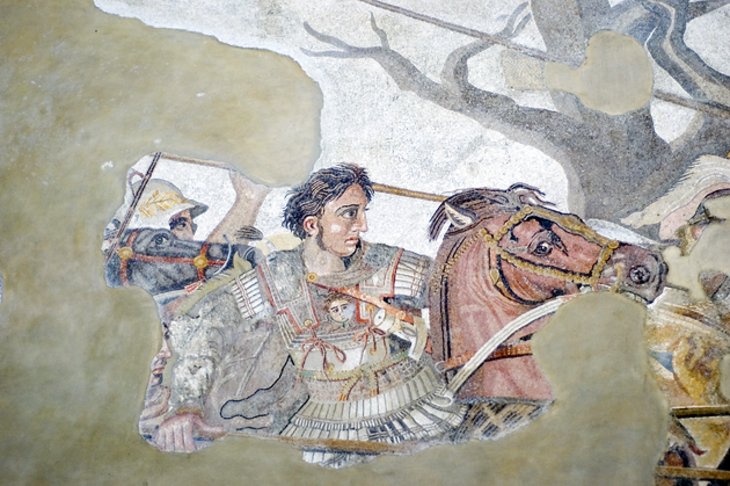
The Museo Archeologico Nazionale holds one of the world's finest collections of antiquities, many of which were brought here from early excavations of Pompeii. In fact, more of the city's artistic highlights are here than at the site itself. In addition, it has the art treasures of the kings of Naples, the Farnese collections from Rome and Parma, the collections from the palaces of Portici and Capodimonte, and material from Herculaneum and Cumae.
The ground floor is devoted mainly to marble sculptures, including the Farnese Hercules, a colossal 3.17-meter statue found in the Baths of Caracalla in Rome, and the Farnese Bull, the largest marble group that has come down from antiquity. On the mezzanine is the collection of ancient mosaics from Pompeii , including the famous 6.20-meter Alexander's Battle .
On the first floor (second floor to Americans), in the central Salone dell'Atlante, is the Farnese Atlas. Here, too, is the collection of bronze sculpture from Pompeii (recognizable by the green oxidation) and Herculaneum (with a dark patina). Look especially for Apollo Playing a Lyre , a 5th-century original from the Peloponnese, found in the Casa del Citarista in Pompeii.
Also on this floor is the remarkable collection of ancient wall paintings, mainly from Pompeii but also from Herculaneum and Stabiae. The bronze household utensils and other bronzes, terra-cotta vessels, and a large model of Pompeii are worth seeing, too.
Address: Piazza Museo 19, Naples

The Cappella Sansevero was built in 1590 as the private chapel of the Sansevero family and later became its burial chapel. In the 18th century, it was elaborately embellished in Baroque style by the eccentric mystic Raimondo di Sangro, Prince of Sansevero.
Of the sculptures that he commissioned, the most outstanding artistic features are in the ethereal Veiled Christ by Sammartino (1753) and two others that show the figures draped in what appears to be a translucent tissue of marble. Another, also carved from a single block of marble, shows a male figure partially wrapped in a net, free-falling in places and so intricately carved that it seems impossible that it's really made of stone.
The chapel's most unusual exhibits are the pair of Anatomical Machines, demonstrating the human circulatory system and muscles, built on actual skeletons using wire, silk, and beeswax. Needless to say, the Prince's strange collection, added to all the Masonic symbols he incorporated into the chapel, gave rise to dark rumors about him and the scientific experiments he carried out in his adjoining palace.
Address: Via De Sanotic 17/21, Naples
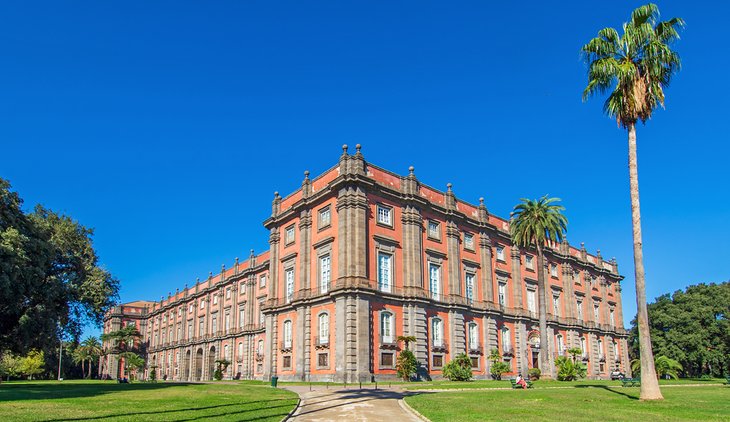
Intended originally as a hunting lodge for King Charles III, the Palazzo Reale di Capodimonte grew to become the royal residence and a place for the king to house the Farnese collection, which he had inherited. The collection includes portraits of members of ruling families by Titian and formed the basis for the National Gallery (Galleria Nazionale), one of the finest art collections in Italy, now housed here.
Its more than 500 pictures include, in addition to the Titians, works by Mantegna, Caravaggio, Raphael, Botticelli, El Greco, Bellini, and Neapolitan artists of the 17th and 18th centuries.
In the royal apartments, you'll find furniture, tapestries, and porcelain used in the palace during the Bourbon and Savoy dynasties. The small room, Salottino di Porcellana , is completely lined with porcelain.
In the park that surrounds the palace, which was the royal hunting grounds, King Charles III founded the Capodimonte workshops to produce ceramics. This highly decorative work became quite famous, and you'll see products of the workshop at the convent Santa Chiara. Wander in the beautiful park, along avenues shaded by huge trees, past battered statues and a pond.
Address: Via Milano 2, Naples
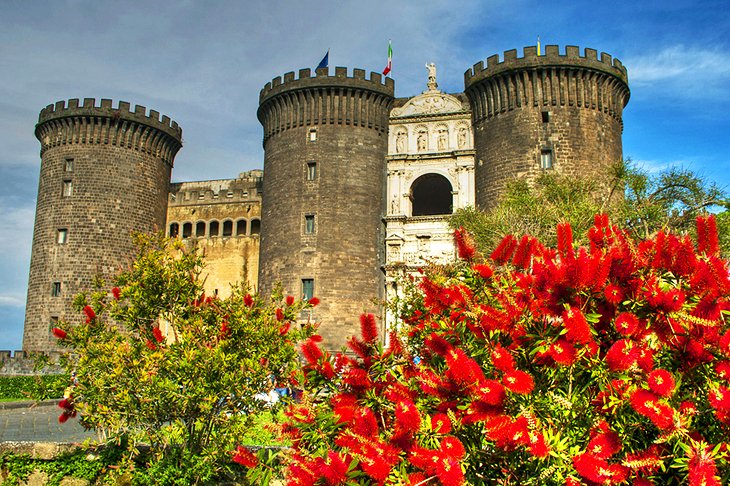
On the south side of the Piazza del Municipio, the five-towered Castel Nuovo, also known as the Maschio Angioino, was the residence of kings and viceroys of Naples. Its history reflects the various rulers–French, Aragonese, Spanish, and Austrian-–each adding and renovating to suit the times.
It was originally built by Charles I of Anjou in 1279-82, and was enlarged by Alfonso I of Aragon, who had the grand Early Renaissance Triumphal Arch between the towers added between 1453 and 1467 to celebrate his victorious entry into the city. Parts of it are used for events and expositions, but the Armoury Hall, the southern courtyard, the Charles V Hall, and the Sala della Loggia are usually open. In the courtyard is the Gothic church of Santa Barbara (or Cappella Palatina).
Address: Piazza Castello, Naples
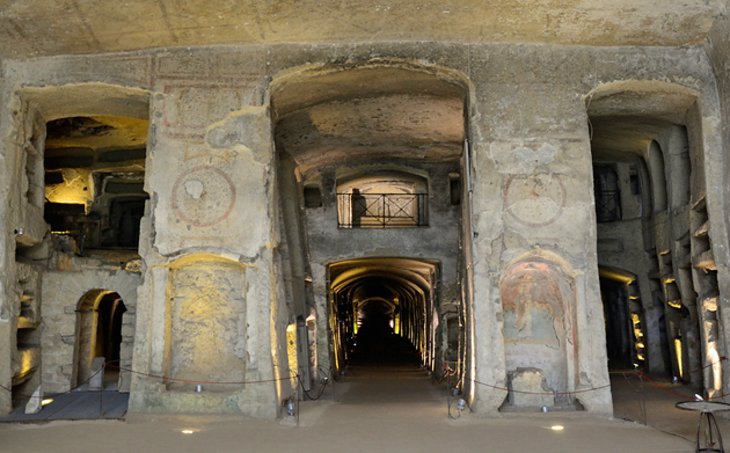
The second-century Catacombs of San Gennaro , like the Roman catacombs, are a maze of passages and tomb chambers but are more ambitious architecturally and have finer paintings than their Roman counterparts.
There are two levels of these, and in the upper catacomb's vaulting are frescoes from late in the second century. Here, too, is the small Crypt of the Bishops and the large underground basilica, with three naves cut into the stone and decorated with frescoes from the fourth through sixth centuries.
The basilica was built near the catacombs in the fifth century, and although it has undergone several changes, it is a rare example of early Christian architecture. Even after major renovations during the Aragonese era in the 14th and 15th centuries, its basic structure of three naves and a semi-circular apse remains.
Address: Via Capodimonte 13, Naples
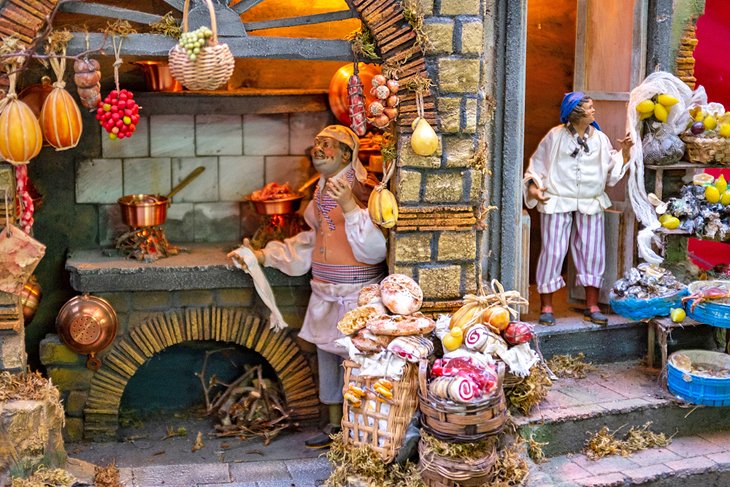
If you are looking for souvenirs that are unique to the city, terra-cotta Nativity figures are the best things to buy in Naples. But a stroll along Via San Gregorio Armeno is more than a chance to do some shopping in Naples, it is an experience in local life and culture.
During December, you'll find Nativity scenes, called presepi, in churches and public places all over Italy, but nowhere are they so elaborate as in Naples. The best-known craftsmen are here as well, and you will be astonished at the variety and finesse of some of these figures they create.
In Italy, these presepi contain far more than the figures central to the night in Bethlehem. You'll find animals, buildings, shops, children, and entire villages of everyday activity surrounding the scenes, made of wood, ceramic, terra-cotta, plaster, and other materials, some dressed elaborately in sumptuous fabrics.
Miniature collectors will find tiny furniture, foods, animals, even entire shops and rooms. The most typical of Naples are the figures made of terra-cotta, and you'll find some of the most artistic at the studio of Giuseppe and Marco Ferrigno.
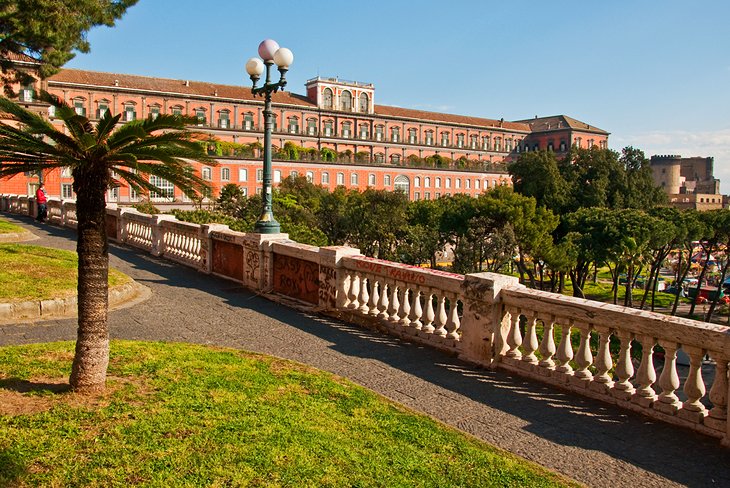
Along the east side of Piazza del Plebiscito is the former Royal Palace, begun in 1600 by Domenico Fontana and restored from 1837-41. It is one of four palaces in the area that were used as residences by the Bourbon kings. On the long facade are eight marble statues of the various kings who ruled Naples.
Inside, you can see the grand staircase of white marble, built in 1651, a theater, the royal chapel, and more than two dozen rooms in its state apartment, with furniture, tapestries, porcelains, and sculptures. It's rarely crowded, inexpensive, and you get a free audio tour. Many tourists consider this one of Naples' most interesting and unsung attractions.
Address: Piazza Plebiscito, Naples
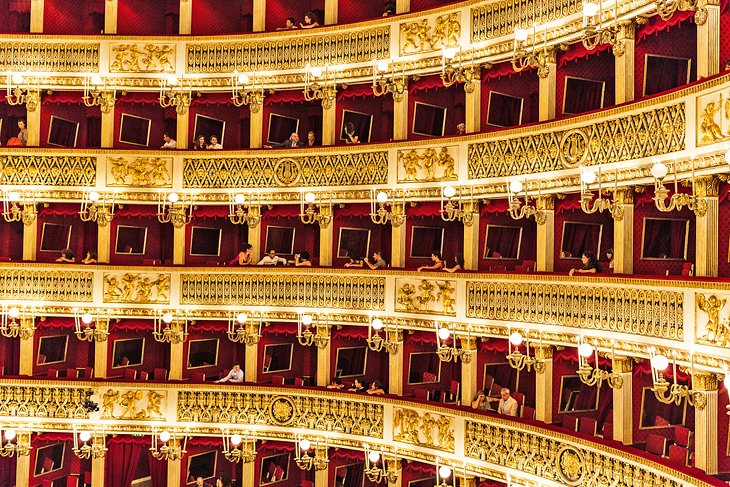
One of the largest theaters in Europe and one of Italy's premier opera houses, the Real Teatro di San Carlo was built by King Charles of Bourbon, adjoining his Royal Palace. It was completed in 1737, and along with being the oldest continuously active opera house in Europe, it was the model for opera houses everywhere. Six levels of ornately decorated boxes surround the interior, highlighted by the even more lavishly ornate royal box.
In addition to operas, performances include concerts and ballet. Along with its outstanding acoustics, San Carlo has the reputation of attracting the noisiest and worst-behaved audiences in Italy. Woe betides the tenor who misses his high C here.
Address: Via San Carlo 98, Naples
Official site: http://www.teatrosancarlo.it/en
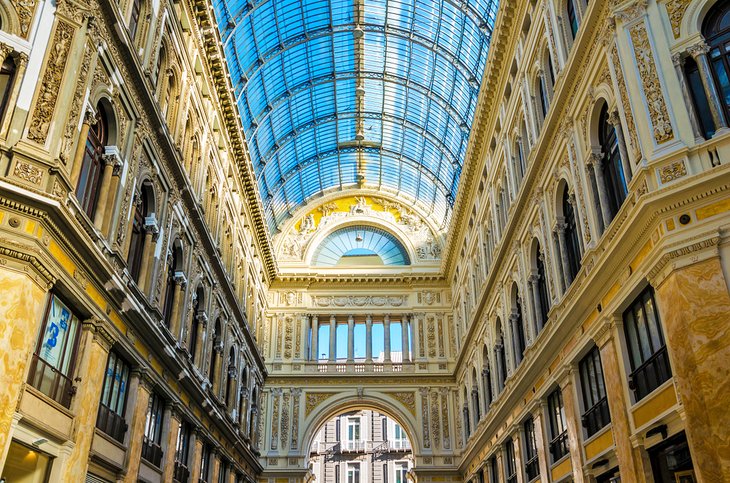
Whether or not you are a dedicated shopper, you'll want to see this popular attraction for its architecture and grandeur. Built between 1887 and 1891, Galleria Umberto I was named for Umberto I, then King of Italy. Designed as a public place for shopping, businesses, cafés, and social space, the tall building has four wings with iron and glass vaulting. These converge at the center under a glass dome, for spectacular effect.
One of the wings opens onto the San Carlo Opera House. Although the Galleria is no longer the center of Naples' café society, it is still a lively place to visit, with shops, restaurants, and cafés. The interior is decorated with sculptures and paintings.
Address: Via San Carlo 15, Naples, Italy
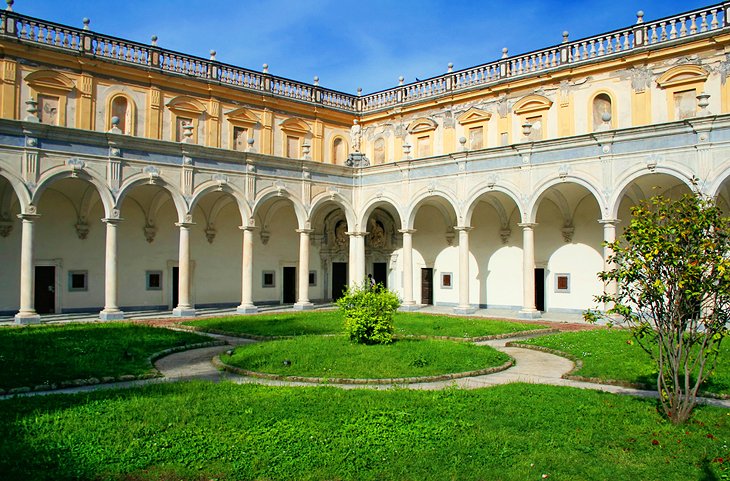
The former Carthusian monastery of San Martino, built in 1325 and rebuilt in the 17th century, also houses the Museo Nazionale di San Martino. The church, where you should also be sure to see the sacristy and treasury, is richly decorated with marble, ceiling frescoes, and paintings from the 17th and 18th centuries.
There are two cloisters, the Chiostro dei Procuratori and the main cloister, which is surrounded by 60 white marble columns. The monastery makes a good setting for the museum, which contains porcelain, an 18th-century state coach of Charles III's reign, and various historical relics from Naples and southern Italy in the 18th and 19th centuries.
If you're not in Naples during the Christmas season, when most churches are displaying the magnificent Nativity scenes (presepi) for which Neapolitan craftsmen are famous, you'll have a chance to see a collection of them here. It includes the Presepe di Cuciniello , an astonishingly detailed depiction of the Nativity with finely-carved animals, buildings, and figures dressed in intricately ornamented fabric costumes. From the Belvedere, superb views of Naples and its bay extend to Vesuvius and the island of Capri.
Address: Largo di San Martino 5, Naples
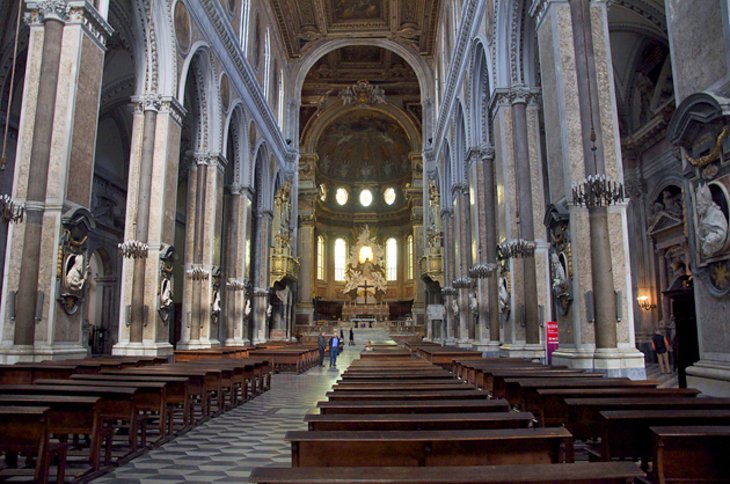
Although dating back to the late 13th century, the cathedral has been altered considerably due to earthquakes and restoration, especially after the one of 1456, but the 1407 doorway in the center of the front has survived. In the south aisle is the sumptuous 17th-century chapel of San Gennaro, patron saint of Naples. On its main altar, a silver bust contains the skull of the saint, who was martyred in 305, in the time of Diocletian.
You can see the saint's tomb in the richly decorated Confessio (1497-1506) under the high altar, and in the underground archeological area, you can see the 4th-century Basilica Santa Restituta , the oldest church in Naples, with excellent ceiling frescoes and columns from a Roman temple.
The Archbishop's Palace and several other churches surround the cathedral, among them the Gothic Santa Maria Donnaregina, with fine 14th-century frescoes by Giotto's contemporary Pietro Cavallini in the elevated nuns' choir, and the Baroque churches of San Filippo Neri and San Paolo Maggiore. Underneath the restored Gothic church of San Lorenzo Maggiore (1266-1324), an archaeological site allows visitors to see layer upon layer of civilization: Greek, Roman, Byzantine, and medieval.
Address: Via del Duomo, Naples
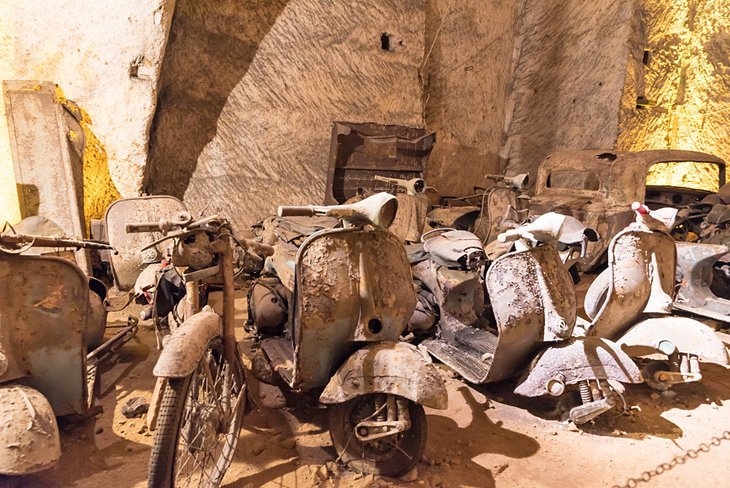
Definitely one of the most unusual things to do in Naples is exploring the unfinished underground passage known as the Galleria Borbonica –the Bourbon Tunnel. It was begun in the 19 th century, on the instructions of King Ferdinand II, as a way for him to escape from the Royal palace to the safety of the military barracks on what is now Via Morelli.
It was never finished, but the carved tunnels were later used as an air raid shelter and emergency hospital during World War II.
Access to its huge galleries and spooky tunnels is by tour, during which you can see the cisterns and a variety of relics and debris from its various uses, including old cars, Vespas, motorcycles, and fragments of statuary and architectural detail.
Address: Vico del Grottone No. 4, Naples
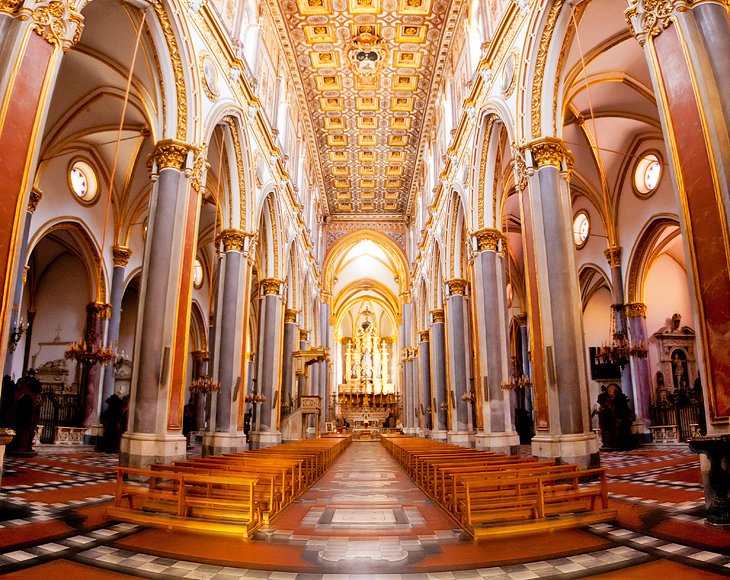
San Domenico Maggiore, built about 1300, is among the most beautiful and interesting churches in Naples, filled with Early Renaissance work. The ornate paneled ceiling leads your eyes directly to the high altar by Cosimo Fanzago.
Each of its 24-sided chapels contains something of interest, especially the Chapel of San Michele Arcangelo a Morfisa at the end of the right nave, which incorporates a 10th-century church. In the Cappellone Crocifisso are a 13th-century Crucification and the 15th-century Burial of Christ.
Beyond the chapel dedicated to Saint Thomas Aquinas (who studied here) is the sacristy, with a frescoed ceiling, Triumph of Faith over Heresy by the Dominicans , and a gallery of 45 sarcophagi belonging to members of the house of Anjou.
Address: Piazza San Domenico Maggiore, Naples
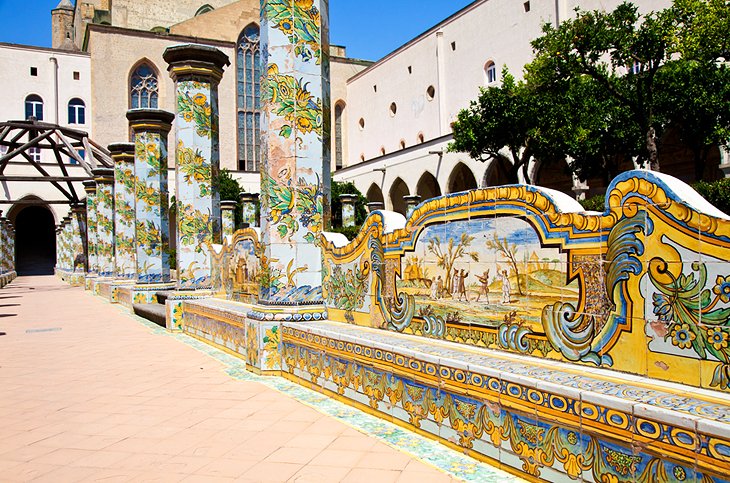
The cloister of the Monastery of Santa Chiara , founded in 1310, looks more like a park in a seaside resort town than a solemn retreat for nuns. Majolica tiles made at the Capodimonte workshops, in vivid colors and lively designs, cover the 66 octagonal columns surrounding its cloister, and between the columns are long benches also covered in tiles.
These seem to bring the secular world inside the monastery walls, with scenes from everyday life of their period–the mid-1700s. Under the porticos, the walls on all four sides of the cloister are covered with 17th-century frescoes of Old Testament scenes.
There are more reasons to visit Santa Chiara besides its surprising and beautiful cloister. Inside on the right is a presepio (Nativity scene) set in a Roman ruin, incorporating mundane daily Neapolitan life along with the sacred creche scene. The figures are dressed in typical local 18th- and 19th-century clothing. The setting in a Roman ruin is thought perhaps to reflect the intense interest in the discovery of Herculaneum in the early 18th century.
While repairing damage after World War II, the intact remains of a first-century Roman thermal spa were discovered, probably part of a villa. This and other finds from the first through fourth centuries make up a small archaeological area and museum.
Hidden beneath the Basilica of Santa Maria della Sanità, is one of the two most important early Christian cemeteries in Naples . Although it is now a densely populated neighborhood, the hillside was outside the city walls, and used as a burial place by early Christians, especially after the burial here of Septimius Celius Gaudiosus, bishop of Abitina, in Tunisia.
The bishop had arrived in Naples, having been exiled after refusing to renounce his faith, and after his death in the 450s AD, his burial place became a place of devotion. More Christians wished to be buried here, and the catacombs were extended.
Later, in the 17 th Century, the necropolis became popular again, after the discovery of a 5 th -century fresco of the Madonna previously covered in mud. Once again, nobles and important clergy wished to be buried near the saint, so the catacombs represent two distinct eras.
The earlier section features 5 th - and 6 th -century frescoes and mosaics showing early Christian symbols including lambs and fishes. On the other side, the graves of 17 th -century nobles are marked by skulls and frescoed depictions of their skeletons, often with clothing or signs indicating their profession or social position.
The entrance to the catacombs is beneath the altar of the Basilica Santa Maria della Sanita , itself worth visiting as one of the most daring works of Dominican architect Fra Nuvolo, and one of the finest examples of Neapolitan Baroque .
Address: Piazza Sanità 14, Naples
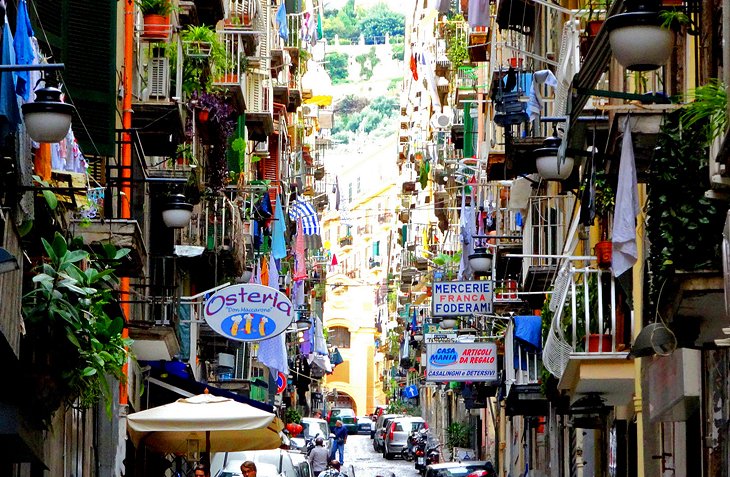
To the west of the Piazza del Plebiscito, on the slopes of Pizzofalcone and extending down to the sea, lies the district of Santa Lucia. South of the wide Via Santa Lucia, this is an area of modern streets laid out on a regular plan, but to the north, it is a picturesque huddle of narrow, stepped lanes where you can see–and be part of–traditional Neapolitan life.
It would be a shame to miss this very real neighborhood of shops and bakeries, artisans' workshops, little cafés where locals down their espresso, and streets where children play. Laundry usually hangs overhead, and conversations are carried on between balconies and windows across the narrow streets. It's a colorful place any time of day, but especially lively in the evening, making it one of the favorite things to do at night in Naples.
Popular tourist attractions in Naples are widely scattered, but two areas are convenient to several of them. These areas are not far apart, so your choice may depend on whether or not you enjoy being in a typical–and colorful–Neapolitan neighborhood throbbing with city life.
If you like feeling the pulse of a passionate city, crowded Decumani is for you, close to the Duomo, Archeological Museum, and several churches. The quieter option is the waterfront Chiaia neighborhood, the part of the more colorful Santa Lucia district, near the Palazzo Reale and the San Carlo opera house. Here are some highly rated hotels in and around these areas:
Luxury Hotels
- A Naples landmark for its elegant style and seafront setting in Chiaia, Grand Hotel Vesuvio caters to film stars and royalty. Its top-floor restaurant is the place for celebratory occasions, with its romantic views of the twinkling harbor lights.
- In the same upscale area and close to chic shops and dining is the Hotel Palazzo Alabardieri , a good choice for anyone planning on shopping in Naples.
- With the same waterfront location and views from the guest rooms, but lower rates, the 4-star Grand Hotel Santa Lucia has upscale amenities such as room service and a concierge. Many of the rooms and suites have balconies.
Mid-Range Hotels
- Although close to the Archeological Museum and Cappella Sansevero, many rooms at Hotel Piazza Bellini overlook a quiet courtyard, and from its uppermost rooms, you can see Vesuvius and the Bay of Naples.
- The elegantly decorated Eurostars Hotel Excelsior is close to the bay and Castel Ovo, and has water views from many of its guest rooms.
- Between Chiaia and Decumani and within walking distance of both, in the atmospheric streets of the old Spanish quarter, the boutique Hotel Il Convento is in a former convent.
Budget Hotels
- In a quiet harbor area, near the landing point for ferries to Capri, Ischia, and Procida, Hotel Rex is steps away from the waterside promenade.
- The convenient and hospitable Hotel Europeo & Flowers is a no-frills option on a quiet back street, around the corner from Piazza San Domenico Maggiore, in the heart of Decumani.
- Farther from other attractions but handy to the main station and trains to Pompeii is the reliable ibis Styles Napoli Garibaldi , which is also near shopping and restaurants.
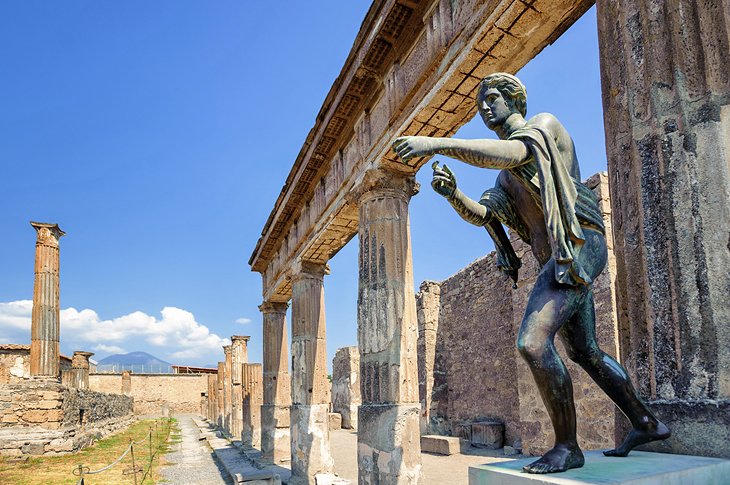
A visit to the National Archeological Museum in Naples will surely whet your appetite for seeing the city's almost more famous neighbor, Pompeii . Several centuries of excavations have uncovered homes, shops, temples, and public buildings of a prosperous city of 20,000 engulfed and frozen in time by the cataclysmic eruption of Vesuvius in AD 79.
Two direct train lines depart the Napoli Centrale station for Pompei, the Circumvesuviana or the Metropolitano, either taking about 35 minutes . The Circumvesuviana train stops close to the entrance to the ruins, but gets very crowded and has no air-conditioning – a serious consideration in the summer. From the Metropolitano stop you'll have about a 10-minute walk to the entrance, but the train is air conditioned.
An easy way to see this UNESCO World Heritage Site with an expert guide, and also hike to the summit of Mt. Vesuvius, is to take the Mt. Vesuvius and Pompeii Day Trip from Naples . The seven-hour tour includes a delicious Italian pizza lunch.
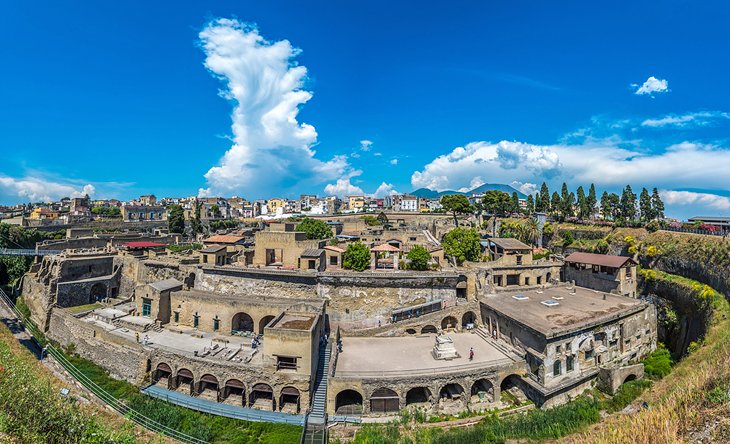
Unlike neighboring Pompeii, the Roman resort town of Herculaneum was engulfed by molten lava instead of ash in the AD 79 eruption of Mt. Vesuvius, and its buildings were supported by the lava as it rose in depth.
The difference had two results: organic materials were preserved in a dry airtight environment, and the cooled stone was so deep and hard that the site was protected from early plunder until modern techniques and sensibilities could preserve its treasures. What you see today gives an even more intimate view of Roman life than Pompeii.
The Circumvesuviana trains between Naples and Sorrento make two stops in Herculaneum. The Ercolano Scavi stop is a 10-minute walk from the entrance to the excavated area; you can walk or wait for a shuttle bus, which may take longer.
Or you can visit both of these world-class attractions from Naples, on a Private Tour Day Trip Excursion to Herculaneum, Mt. Vesuvius, and Pompeii . Your expert guide will make sure you see the highlights of each archaeological site, and as an added bonus, you'll get to walk to the rim of the crater on Vesuvius.
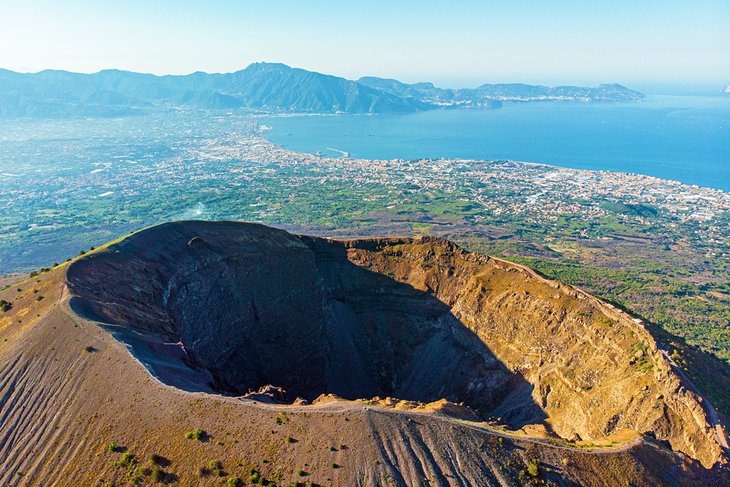
Rearing abruptly out of the plain, 15 kilometers southeast of Naples on the shores of the bay of Naples, Vesuvius is the only volcano on the European mainland that is still intermittently active. It is best known, of course, for the disastrous eruption in AD 79 that destroyed both Pompeii and Herculaneum. Its last major eruption was in 1944, and there have been signs of only mild activity since.
Drive or take a bus from Pompeii or Herculaneum to the Vesuvius National Park lot at about 1,000 meters altitude. Trails lead up the final 200 meters to the rim , which can be followed along its entire perimeter. As you would expect, the views are spectacular.
Vesuvio Express operates a bus from Piazza San Pasquale station in Naples to Vesuvio National Park, about a 40-minute ride , or you can explore the volcano with a guide on the Vesuvius: Half Day Trip from Naples , a four-hour trip that includes hiking to the cone and learning about its history and geology.
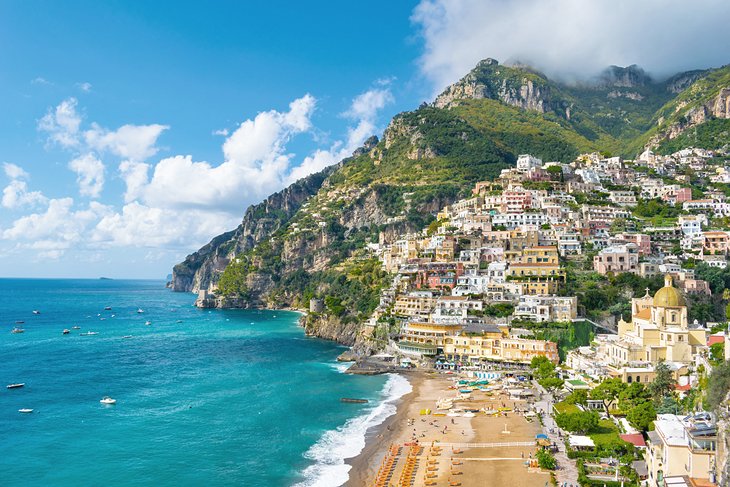
The southern coast of the Amalfi Peninsula, south of Naples, is among the most beautiful in all Europe, with colorful villages clinging to steep mountainsides that drop almost straight into the blue waters of the Mediterranean.
There are several ways to see this coast: by car, bus, boat, or organized tour. While of these a car gives you more freedom to stop and explore on your own (bus schedules make it difficult to spend any time in the towns), the road is narrow and demands 100 percent attention from the driver at all times.
The most flexible solution is the Private Tour: Sorrento, Positano, Amalfi, and Ravello Day Trip from Naples , where you can craft your own itinerary along this spectacular stretch of coast, with the help of your knowledgeable guide. You'll have plenty of time to explore some of the region's most charming towns in the comfort of a private chauffeur-driven car. Hotel pickup and drop-off are included.
- Read More: Exploring the Top Attractions of the Amalfi Coast: A Visitor's Guide
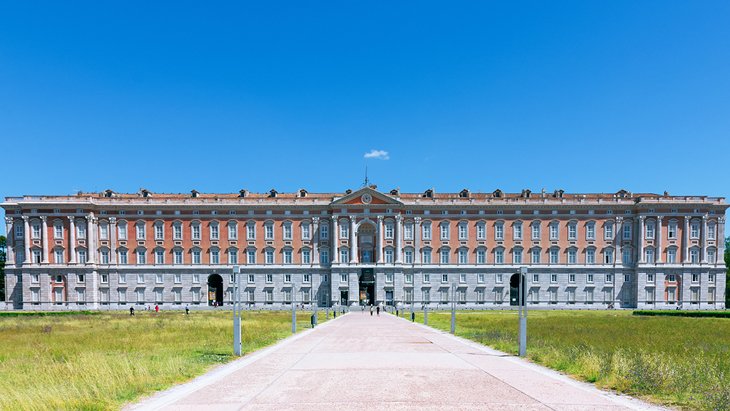
Opposite the station in Caserta is the former Royal Palace, a magnificent 1,200-room residence often compared to Versailles. It was built by Luigi Vanvitelli for King Charles III of Naples and Sicily, beginning in 1752, and today, its interior, well-preserved decoration, and furnishings form a museum of the Bourbon dynasty that ruled here from 1734 to 1860. Particularly fine are the Grand Staircase of 116 steps, the Cappella Reale, the Royal Apartments, and the theater.
In the Second World War, the Palace served as the headquarters of the Allied Middle East Command, and on April 29, 1945, the German armies in Italy signed the surrender document here. Behind it stretches a park with impressive fountains and the Grand Cascade. From the terrace beyond the English Garden, about a 45-minute walk north of the palace, are sweeping views.
Caserta Reale is on the main train line between Naples and Rome, 40 minutes from Napoli Centrale . A bus from Corso Meridionale to Caserta takes 30-50 minutes or 40 minutes to an hour from Napoli Centrale, depending on the time of day.
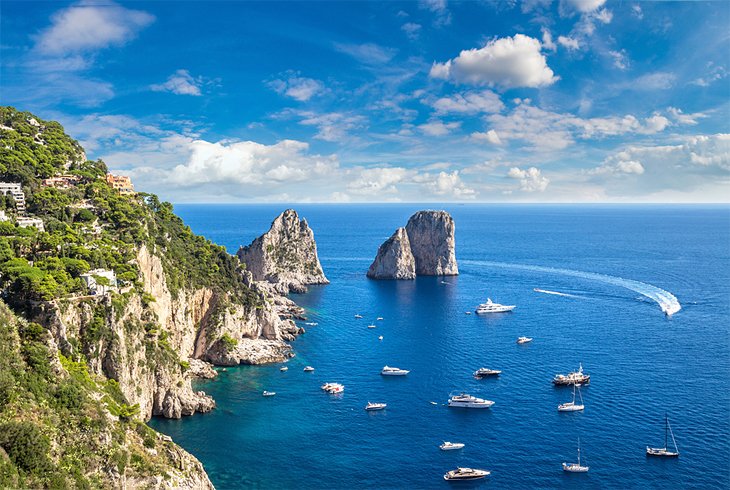
Regular ferries carry passengers from the Naples harbor across the bay to the island of Capri . It's a favorite day trip for locals, and the ferry from Naples is a good way for tourists who don't plan on visiting Sorrento to see this fabled island and its prime attraction, the Blue Grotto .
The full-day Capri and Blue Grotto Day Tour from Naples or Sorrento whisks you to this glamorous island via jetfoil. You'll see the striking azure water in the Blue Grotto, visit the beautiful towns of Anacapri and Capri, admire some of the island's fascinating rock formations, and explore the coastline by minibus.
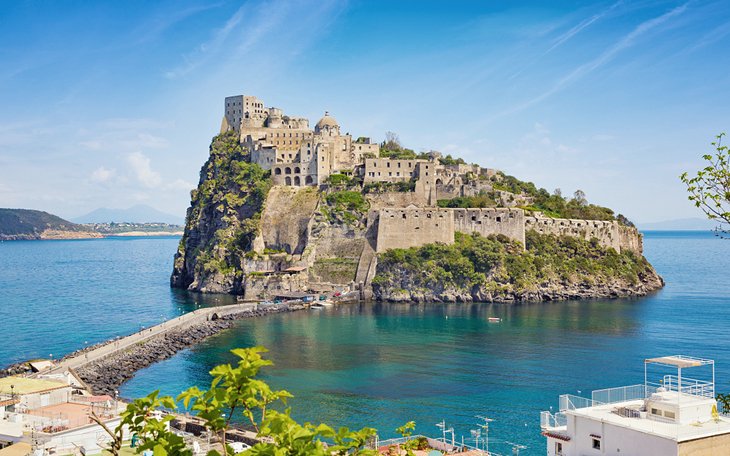
At the entrance to the Bay of Naples, the volcanic island of Ischia was known to the ancient Greeks and Romans, who were attracted by its hot springs and the luxuriant flora. Today, it's less crowded with day trippers than nearby smaller Capri, and has much nicer beaches.
The town of Ischia, on the northeast coast, is made up of Ischia Ponte, where the imposing Castello stands on a 91-meter rocky crag accessible by a stone causeway, and the busier spa and seaside resort of Ischia Porto. The island's oldest harbor here is a former crater lake.
From Forio, on the west coast, a beautiful road leads to the southern part of the island, past La Mortella , beautiful gardens created by Susana Walton and British composer Sir William Walton and well worth a stop. The southern shore is the quietest, where the village of Sant'Angelo sits picturesquely on the slopes of a promontory.
Frequent boats connect Ischia to Naples harbor and to the smaller island of Procida , almost too cute to be real, with its taffy-colored houses. Or you can go directly to Procida from Naples by hydrofoil on the Day Trip to Procida Island with Lunch tour, enjoying a full day on the island at your own pace, with lunch at a local restaurant.
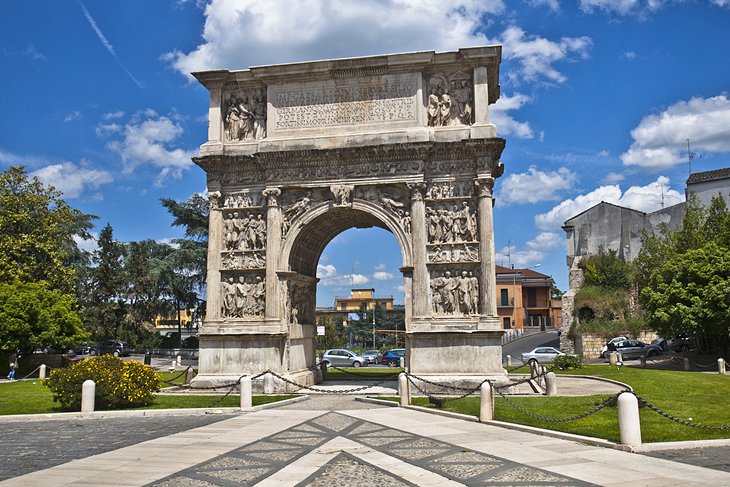
About 50 kilometers northeast of Naples, Benevento commands a beautiful setting on a flat-topped hill between two rivers, at the junction of the Via Appia with four other Roman roads. This position made it one of the most important towns in southern Italy, and for five centuries, it was the seat of powerful Lombard dukes.
It has a 14th-century castle and the remains of a Roman theater now used for opera performances, but its major tourist attraction is the magnificent Arco di Traiano (Arch of Trajan), also known as Porta Aurea, dedicated by the senate and people of Beneventum to the "best of princes" in AD 114, in anticipation of his return from the Parthian wars.
The arch, built of Greek marble, stands 15.5 meters high and is one of the finest of its kind. The entire arch, including the marble reliefs glorifying the emperor, is very well preserved.
Benevento is about two hours from Napoli Centrale by train , either changing in Casserta or direct. The bus from Naples Metropark Bus Terminal takes about the same time and service is irregular. By car it's one hour and 10 minutes to 1.5 hours , depending on traffic.
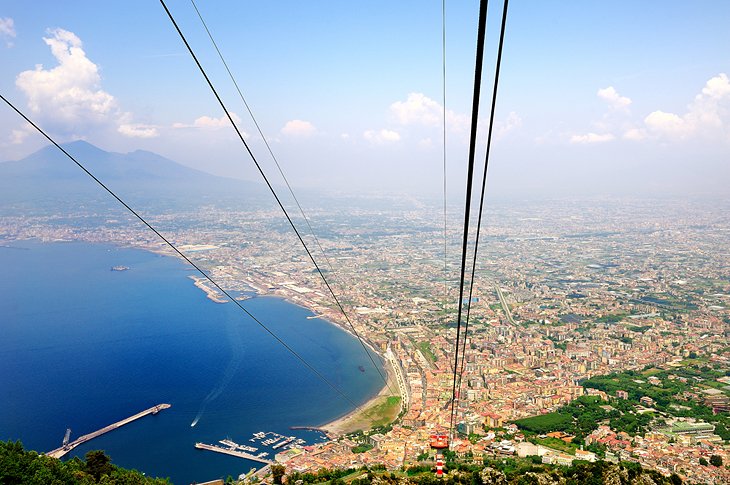
About 30 kilometers south of the city, on the Bay of Naples, Castellammare di Stabia is adjacent to the ancient city of Stabiae, destroyed by the AD 79 eruption of Vesuvius. You can visit the excavated Roman villas, which were very well preserved by the "rain" of volcanic ash that buried them. Frescoes and mosaics are intact, as is the swimming pool in its colonnaded atrium.
A cable car from the Castellammare Circumvesuviana station climbs Monte Faito, from whose summit there are walking trails and magnificent views of the Bay of Naples and Vesuvius. Frequent trains from Napoli Porta Garibaldi take 45-55 minutes; it's about 25 minutes by car .
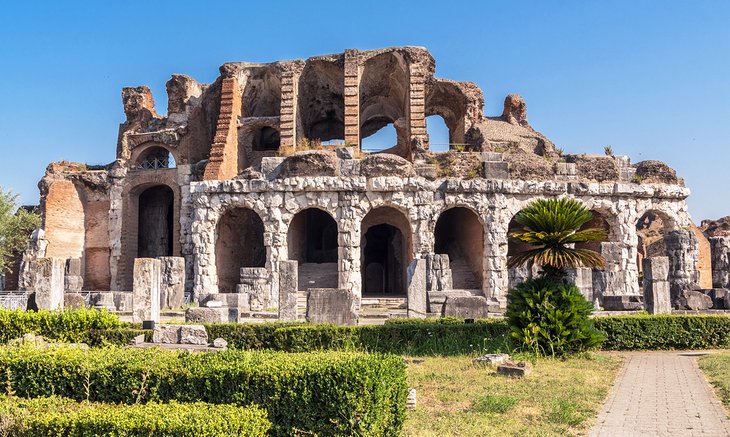
Modern Capua is built adjacent to the ancient city of Capua Vetere, destroyed in the ninth century. In the center of town, near the Volturno River, the cathedral's campanile and 11th-century forecourt with third-century columns survived after the building itself was destroyed in World War II. Nearby, the Campanian Provincial Museum is the region's most important archeological museum after the National Museum in Naples.
Outside of town is a Roman amphitheater, built under Augustus and restored by Hadrian, one of the largest remaining, with many of its subterranean passages intact. On the Via Appia , which connected the town to Rome, are two well-preserved Roman tombs.
North of Naples near Casserta, Capua can be reached by bus from either Corso Meridionale or Piazza Garibaldistation . Either takes about 1.25 hours, or you can be there by direct train in about 50 minutes from Naploli Centrale.
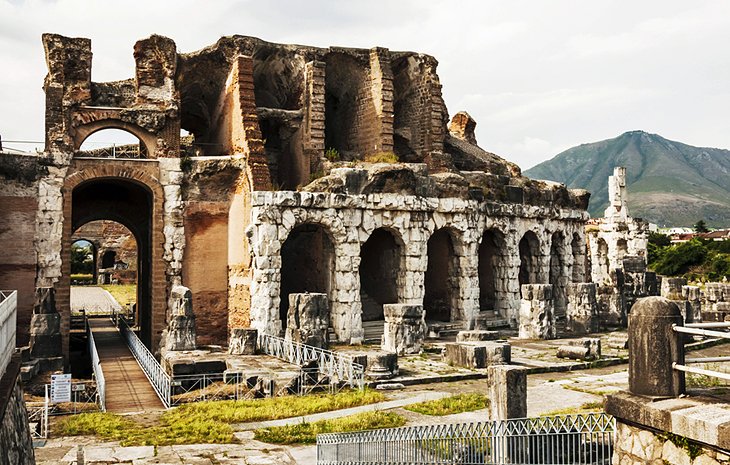
More Related Articles on PlanetWare.com
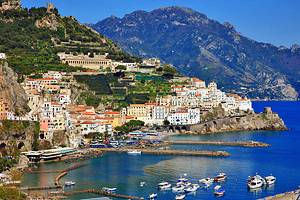
Where to Go near Naples: Surrounded by some of Italy's most popular places to visit, Naples makes a good starting point for seeing the tourist attractions in Sorrento and exploring the Amalfi Coast , as well as visiting Herculaneum and the dramatic ruins of Pompeii .
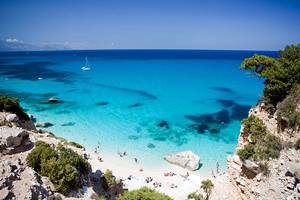
Exploring beyond Naples: South of the Amalfi Coast are the magnificent ruins of Paestum , the finest remains of Greek architecture on the Italian mainland. Or from Naples harbor, you can take a ferry to the fascinating island of Sardinia and its capital city of Cagliari .
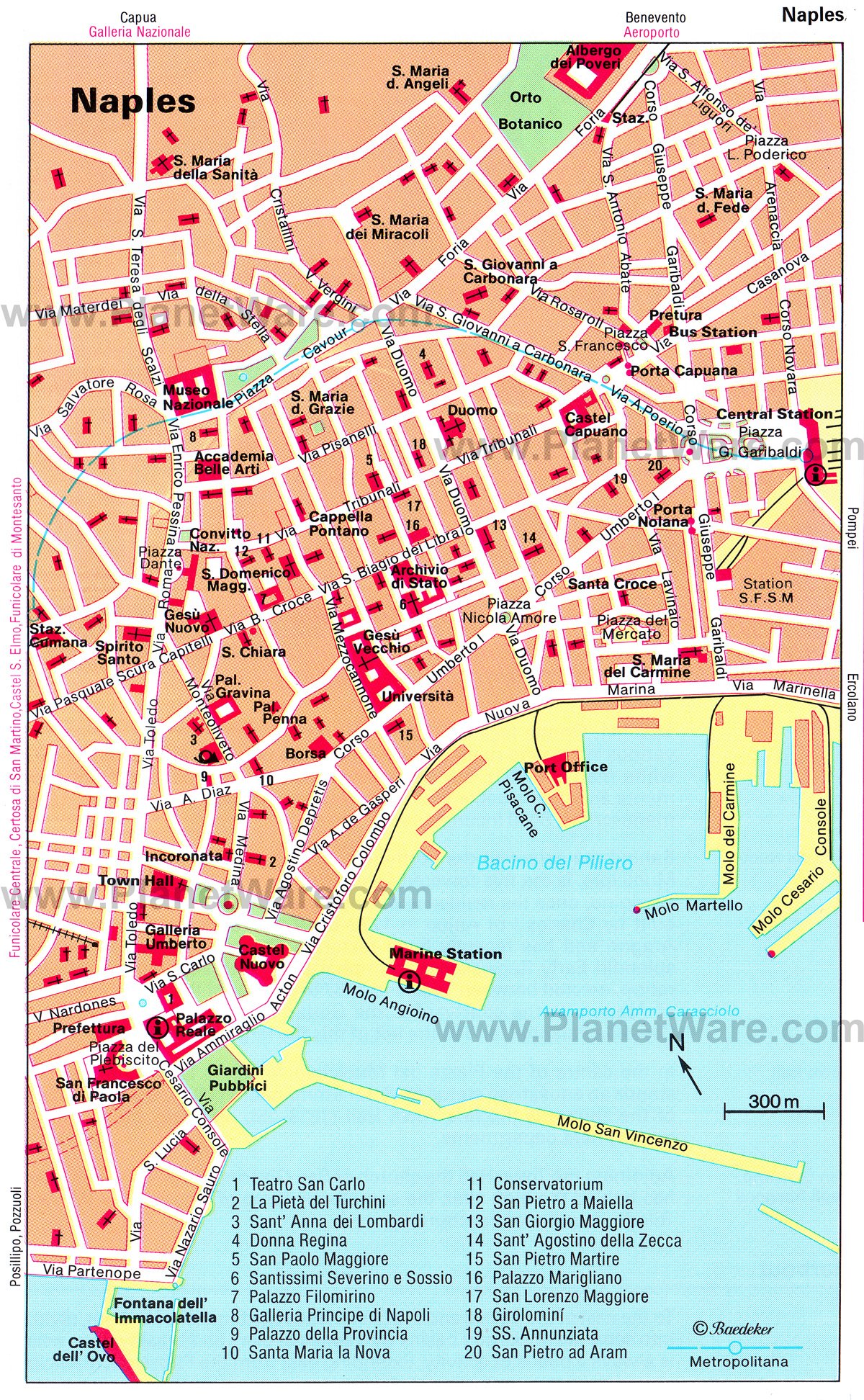
More on Italy


23 Best Things to Do in Naples, Italy (Top Sights, Map & Tips)
By Author Jurga
Posted on Last updated: October 22, 2023
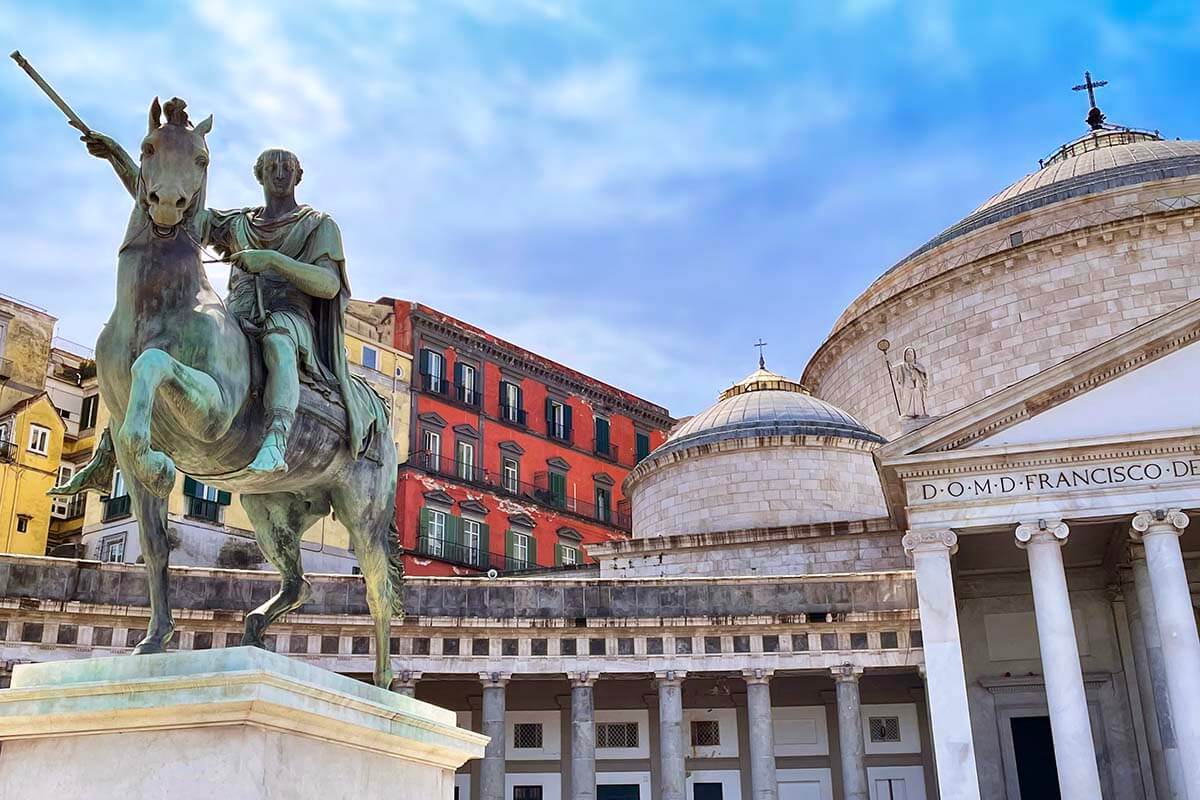
Are you thinking of visiting Naples in Italy and wondering what to expect, what there’s to see and do in the city, whether it’s actually worth a visit, or how much time you need? In this guide, we cover the main landmarks and highlights of Naples, coupled with our experience-based tips and info for your visit. Find out!
You may already have heard that Napoli is quite unlike any other Italian city . It’s a chaotic blend of centuries-old history, incredible architecture, crowded streets, narrow (and often dirty) alleyways, and charming balconies strewn with laundry. Vespas speed through the never-ending crowds, and there are new sights, smells, colors, and sounds in every direction…
The gastronomic scene is a delightful mix of fried street food, fine restaurants serving fresh, local fare, and – of course – pizza! Invented in Naples, pizza was originally a popular food among the city’s poor. Nowadays, Neapolitan pizza is made according to strict rules and is truly the best you can get in the world!
There is definitely something very real about Naples and its many contrasts guarantee a very authentic experience. To say that Naples is overwhelming, dazzling, and a one-of-a-kind city is an understatement. You really have to experience this unique city first-hand in order to understand what makes it so special.
Below is our selection of the very best things to do in Naples . It’s a mix of must-see places and the best experiences that will give you a good overview of what to expect and what to see in Naples. Find out!
Top Experiences in Naples:
- Naples Underground .
- Naples Catacombs .
- Pompeii & Mt Vesuvius Tour .
- Sorrento & Amalfi Coast Tour .
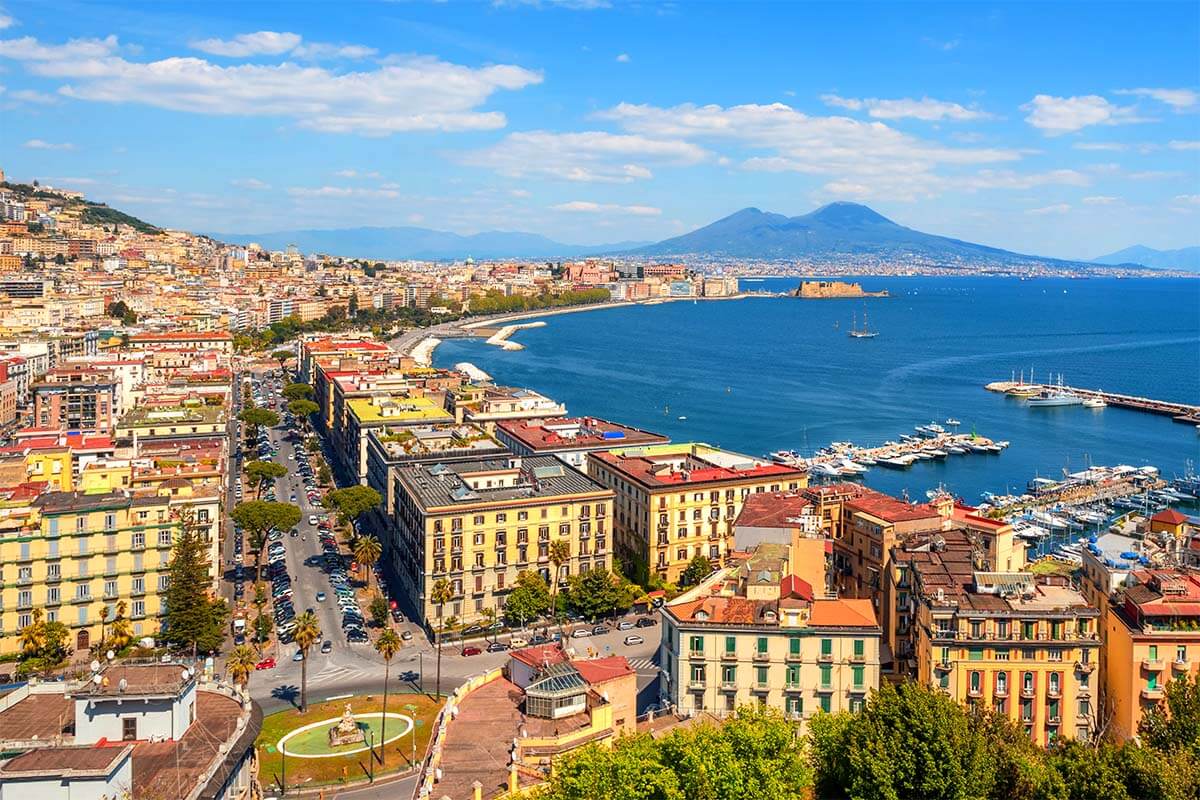
Good to know: To give you a better idea of where everything is located, we also created a map indicating the main sights and tourist attractions in Naples mentioned in this article.
Also, for each place, we include some practical information and useful tips based on our first-hand experience during a recent visit to Naples.
This info should help you plan your trip and avoid disappointment like showing up at the must-see landmark when it’s closed or not being able to see something because you didn’t book a ticket in advance…
How to use this map: Use your computer mouse (or fingers) to zoom in or out. Click on the icons to get more information about each place. Click the arrow on the top left corner for the index. Click the star next to the map’s title to add it to your Google Maps account. To view the saved map on your smartphone or PC, open Google Maps, click the menu and go to ‘Your Places’/’Maps’. If you want to print the map or see it in a bigger window, click on ‘View larger map’ in the top right corner.
Best things to do in Naples:
1. Historic Center of Naples & Spaccanapoli
Designated as a UNESCO World Heritage site, the Historic Center of Naples is a must-see in Napoli. And there’s no better place to start your visit than Spaccanapoli, the most famous street in Naples. Except… you won’t find it on the map under this name.
Spaccanapoli is actually composed of several connecting streets: Via Pasquale Scura, Via Maddaloni, Via Domenico Capitelli, Piazza Gesu Nuovo, Via Benedetto Croce, Piazzetta Nilo, and Via San Biagio Dei Librai.
The name ‘Spaccanapoli’ translates to ‘Naples Splitter’ because it ‘divides’ the city in half. It extends well outside the old city center, but the must-see part is right in the historic old town.
Everything there is to know about Naples is encapsulated in this area! The atmosphere is filled with the noise of neighbors calling to each other from their balconies, artisans hammering in their tiny workshops and the ubiquitous Italian scooters whizzing past you with inches to spare.
Rough, noisy, and exceptionally crowded, Naples’s historic center may not be to everyone’s taste, but Spaccanapoli and its wide surroundings remain a must-see in Naples!
The best way to experience the real Naples and its unique atmosphere is by taking a walk here. Just be prepared to have to constantly navigate between the crowds, motorbikes, and countless street vendors. It’s part of the fun!
Good to know: There are lots of great places to eat and drink here – often at very reasonable prices. You’ll find some of Naples’ most famous landmarks in this area too.
TIP: If you want to understand how special Spaccanapoli really is, you have to see the Naples splitter from above! The best place to do this is from the ramparts of Castel Sant’Elmo – you’ll find more information about it further below.
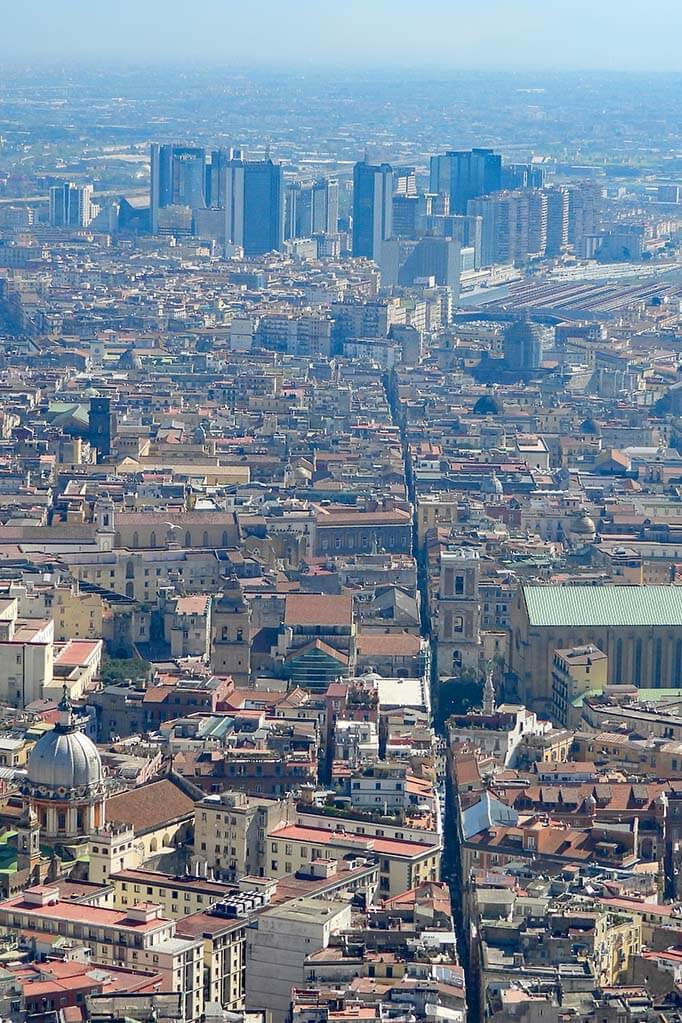
Interesting to know: All over Naples, you’ll see red twisted horns that sometimes look a bit like red chili peppers… These are Neapolitan cornicello , or corno – a special talisman that is supposed to protect you from any evil and bring you luck.
Another character that you’ll see all over the city is Pulcinella , a sort of clown wearing a traditional Neapolitan half-mask. You’ll find these masks for sale at souvenir stores, street artists dancing dressed as Pulcinella, and you can also rub Pulcinella’s nose in Naples city center (we indicated the location of this statue on our map).
You’ll find these talismans for sale everywhere in Naples and you will also see ‘corno’ hanging at the entrance of the shops, standing on restaurant counters, and pretty much everywhere. Neapolitans are quite superstitious, indeed. You can even find ‘corno’ horns with Pulcinella mask on them – just in case one talisman doesn’t do the trick.
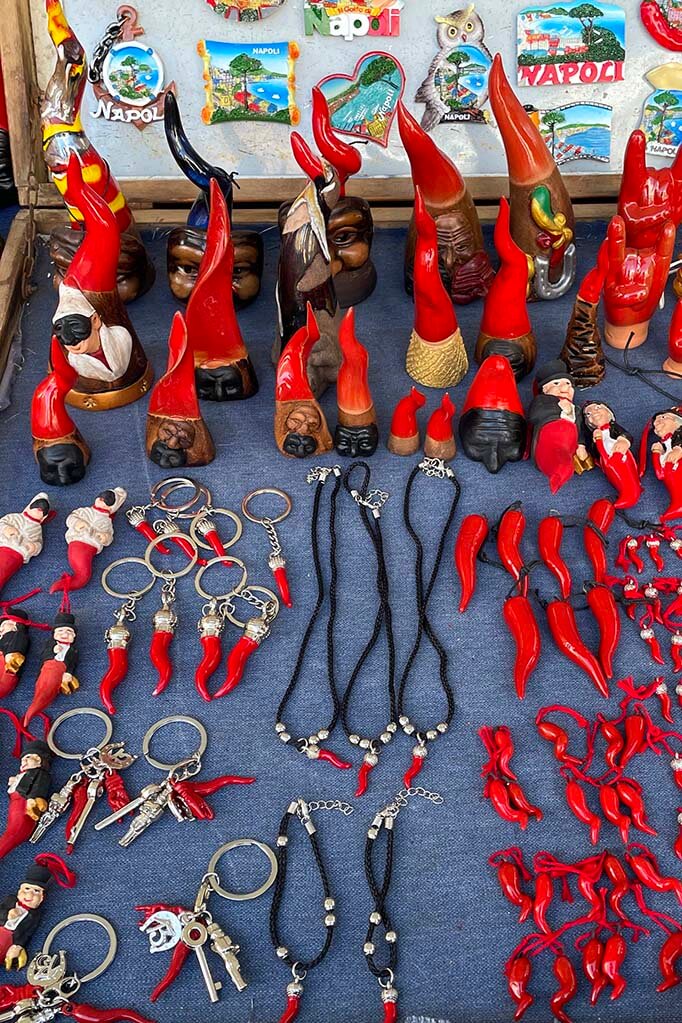
2. Naples National Archaeological Museum
Naples National Archaeological Museum is probably one of the best museums in the whole of Italy. So if you are looking for the very best places to see in Naples, this museum is absolutely not to be missed!
The beautiful 16th-century building housing the Museum was originally a military and cavalry barracks.
Founded as a museum in 1816 by Ferdinand I, King of the Two Sicilies, Naples National Archaeological Museum is now home to an extensive collection of Roman remains . These include artifacts and mosaics excavated from Pompeii and Herculaneum , both of which were devastated by the 79AD eruption of Mount Vesuvius. You can even find a small room displaying a unique collection of erotic Pompeiian art!
The museum also contains a beautiful selection of marble statues portraying mythological scenes. Be sure not to miss the Farnese collections ! There are also amazing mosaics and many ancient Egyptian exhibits , too, including death masks and mummified remains.
Good to know: The museum is huge and a visit here can be somewhat overwhelming. We visited on our own, but if you are interested in art and have a few hours to spare, this is one place where it could be really interesting to visit with a guide . The museum also offers an audio guide, but they don’t give you any map and so I’m not sure how useful or easy to use it is.
Practical info: Naples National Archaeological Museum is open daily except on Tuesdays. So plan your visit accordingly! You can just get the tickets on the spot and – unless you book a guided tour – there’s no need to reserve. For more practical info, see their website .

3. Gesù Nuovo Church & Square
Piazza del Gesù Nuovo (‘New Jesus’) is a large and lively town square along Spacannapoli in the old town. It has the Chiesa del Gesù Nuovo on one side and the Basilica di Santa Chiara (more about it below) on the other side. Once the main western entrance to the city, the area was modified twice in the 16th century and the city walls were moved.
You can see an ornate statue of the Virgin Mary – Guglia dell Immacolata – in the center of the square, and behind it is the rather quirky stone façade of the Gesù Nuovo church. However, don’t let the exterior mislead you – this is one of the most beautiful, most impressive, and must-see churches in Naples!
In complete contrast to its exterior, the inside of the Chiesa del Gesù Nuovo is decorated in amazingly opulent Neapolitan Baroque style, with lots of frescoes and colored marble. Our local guide compared it to St. Peter’s Basilica in Rome, and while not nearly as big, it’s indeed just as ornate.
In one of the chapels, you can also see the bronze statue of Naples’ newest saint – Saint Giuseppe Moscati. Beatified in 1987, he was an early 19th-century doctor who devoted himself to helping the poor.

4. Santa Chiara Church & Cloisters
Complesso Monumentale di Santa Chiara is a fascinating network of cloisters, located behind the restored Gothic basilica of the same name. You can visit the cloister, Chiostro di Santa Chiara (which requires a ticket), and the church, Basílica de Santa Clara (entrance is free of charge).
Basílica de Santa Clara is a huge church located just across from the above-mentioned Church of Gesù Nuovo. But the two churches couldn’t be more different! While every inch of the interior of the New Jesus Church is decorated, the interior of Santa Clara church is very simple. But it’s this simplicity in combination with the gigantic proportions that make it really impressive to see!
But the main highlight here is the exceptionally beautiful Chiostro di Santa Chiara . Despite its central location in the heart of Naples’ busiest district, the cloisters are really tranquil and offer a much-needed break from the hustle and bustle of the rest of the city.
Inside, you can see a beautiful garden with blossoming lemon trees and colorful Rococò style tiling on the columns and benches (just don’t try to sit on them!). The walkways of the cloisters – lined with frescoes and colorful tiles – are equally impressive too. There’s also a small museum and an archeological site where you can see excavations from ancient Roman times.
There’s also a short film playing in one of the rooms close to the entrance. It explains the history of the convent and the church – quite interesting.
Good to know: The cloister is open daily and you can get a ticket on the spot. The church (just as most other churches in Naples) closes for a few hours at around lunchtime, so it’s best to visit in the morning or in the afternoon.

5. Via dei Tribunali
Via dei Tribunali is another of the must-see places in Naples. Dating back to the Ancient Roman times, this street in the old town is also known as Decumanus Maggiore – one of the main east-west roads ( Decumani ) of the ancient Greek then Roman city of Neapolis.
Via Dei Tribunali runs parallel with the above-mentioned Spaccanapoli. The atmosphere here is very similar – crazy, overwhelming, and so typically Naples. But there’s one more reason to come here and that’s pizza!
If you are a pizza-lover, a visit to Via dei Tribunali is a must!
Commonly referred to as ‘pizza street’ , Via dei Tribunali is believed to be the best place for pizza in Naples. The highlight is the world-famous Sorbillo pizza restaurant and you’ll recognize it from far because of the crowds waiting outside in order to get a table here. Just be sure you have the right one – Gino e Toto Sorbillo – because just nearby, there’s another smaller restaurant with ‘Sorbillo’ in its name that has nothing to do with the original one.
While there are countless other amazing pizza restaurants in this area (and all over Naples), many consider a pizza at Sorbillo an absolute must-do in Naples. So, of course, we had to try it too, and I have to agree – it’s absolutely delicious!
TIP: If you don’t want to spend hours waiting in line at this restaurant, try to come at least 15-20 minutes before the opening time. We arrived at 11.45 am (at lunch, the restaurant opens at 12) and there were already lots of people waiting at the door. Luckily, the restaurant is quite big and it wasn’t a problem to get a table, but people who arrived at 12, ended up waiting for over an hour. Alternatively, simply choose one of the many other pizza restaurants in Naples.
There are lots of souvenir stalls, shops, and bars here too, plus a fun atmosphere that makes the street well worth visiting – even if you aren’t here for the pizza!
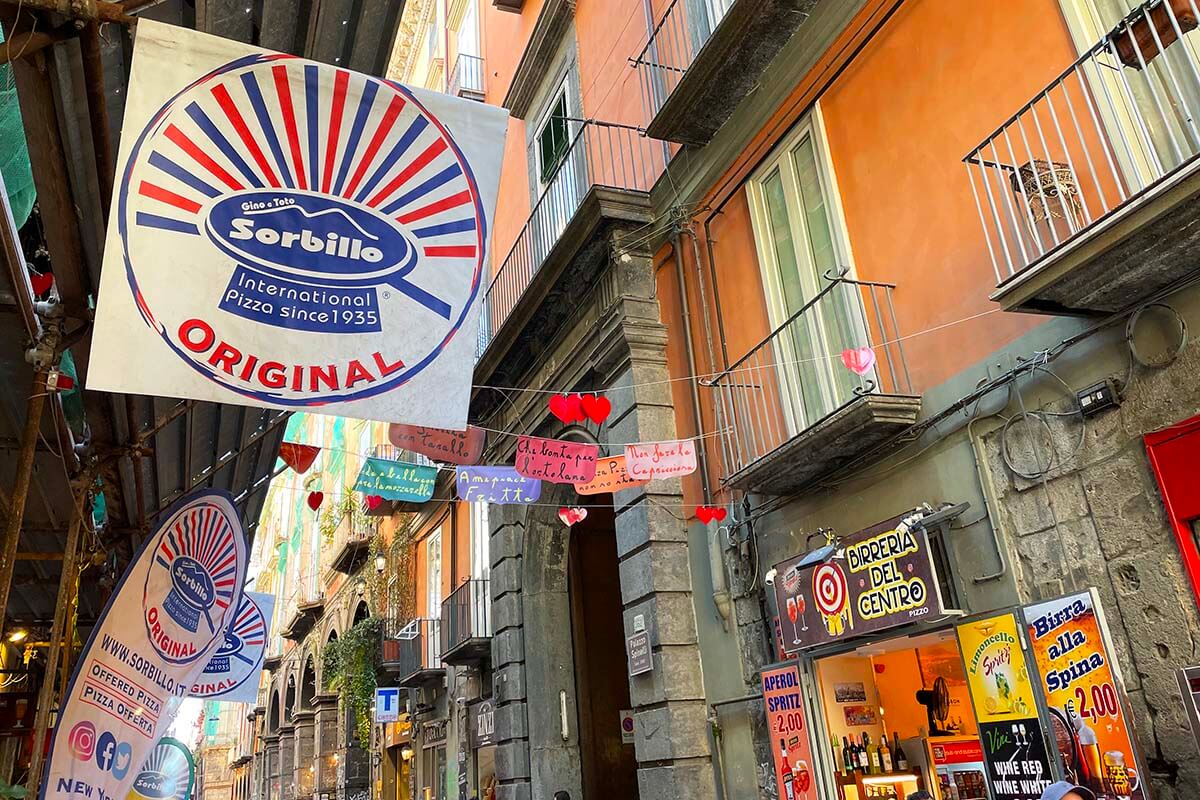
6. Sansevero Chapel
Museo Cappella Sansevero is one of the must-sees in Naples, attracting big crowds.
Located in the heart of the city, this chapel museum was designed by alchemist and inventor John Francesco di Sangro. Although tiny, it is filled with wonderfully symbolic artworks and sculptures, and the ceiling is decorated with a magnificent fresco. It’s absolutely breathtaking!
The most famous exhibit here is the marble sculpture ‘Veiled Christ’ ( Il Cristo velato ) by Giuseppe Sanmartino made in 1753. It portrays Jesus lying with a veil over his face as he takes his last living breaths. This sculpture is world-famous for the incredible tissue-like quality of the marble and no words can describe how special it is – you really have to see it in person!
Other incredible sculptures not to miss here are the ‘Veiled Truth’ ( Pudicizia ) by Antonio Corradini and ‘Release from Deception’ ( Il Disinganno ) by Francesco Queirolo. Also, in the basement under the chapel, you’ll find two “anatomical machines” – skeletons with “blood vessels” that show how advanced human knowledge was in terms of anatomy back in the 18th century already.
Practical information: Museo Cappella Sansevero is open daily except on Tuesdays. You only need 10-15 minutes for a visit inside. However, this is one of the most popular places to see in Naples and it’s advisable to get your tickets in advance , especially if you are traveling in the high season (April – October).
If you didn’t book in advance, you may still be able to get tickets on the day itself, but you can’t count on that. Also, in the high season, it’s best to go as early in the morning as possible in order to get a hold of the last tickets for that day. The entry is timed, so – depending on what’s available – you might have to come back a few hours later.
TIP: This popular old town walking tour includes many of the main sights in Naples, a few lesser-visited hidden gems, as well as the entrance to Sansevero Chapel. Going with a tour might also be your chance to visit this chapel if the regular tickets are sold out.
Good to know: Any kind of photography is not allowed inside the chapel. The picture below is of one of the info signs located outside of the building. The other two images are courtesy of Museo Cappella Sansevero.

7. Catacombs of Naples
The Catacombs of Naples is one of our personal favorite things to do in Napoli. It’s something that could be listed among the must-dos in the city, but also as a hidden gem. If you are looking to get a bit off the beaten path and do something truly unique in Naples, definitely check these out!
The Catacombe di San Gennaro and Catacombe di San Gaudioso are both underground cemeteries, dating to the times of the Roman Empire. While the Catacombs of San Gennaro are considered to be the most important of the two, I highly recommend visiting both of them since they are totally different.
If you have ever visited Rome’s underground sites and catacombs , then you may be quite surprised how much more spacious the ones in Naples are! This is because they were excavated from tuff, a rock formed from volcanic ash which is known for its workability and longevity. Also, the Catacombs of Naples are way more impressive than the ones in Rome, the people who run the place and the guides are amazing, and you’re also allowed to take pictures inside.
San Gennaro Catacombs are the biggest in southern Italy. A 2nd-century network of tunnels is lined with crypts and graves, some of which are decorated with the most impressive frescoes. The tombs here are spread over two levels and you can visit both of them.
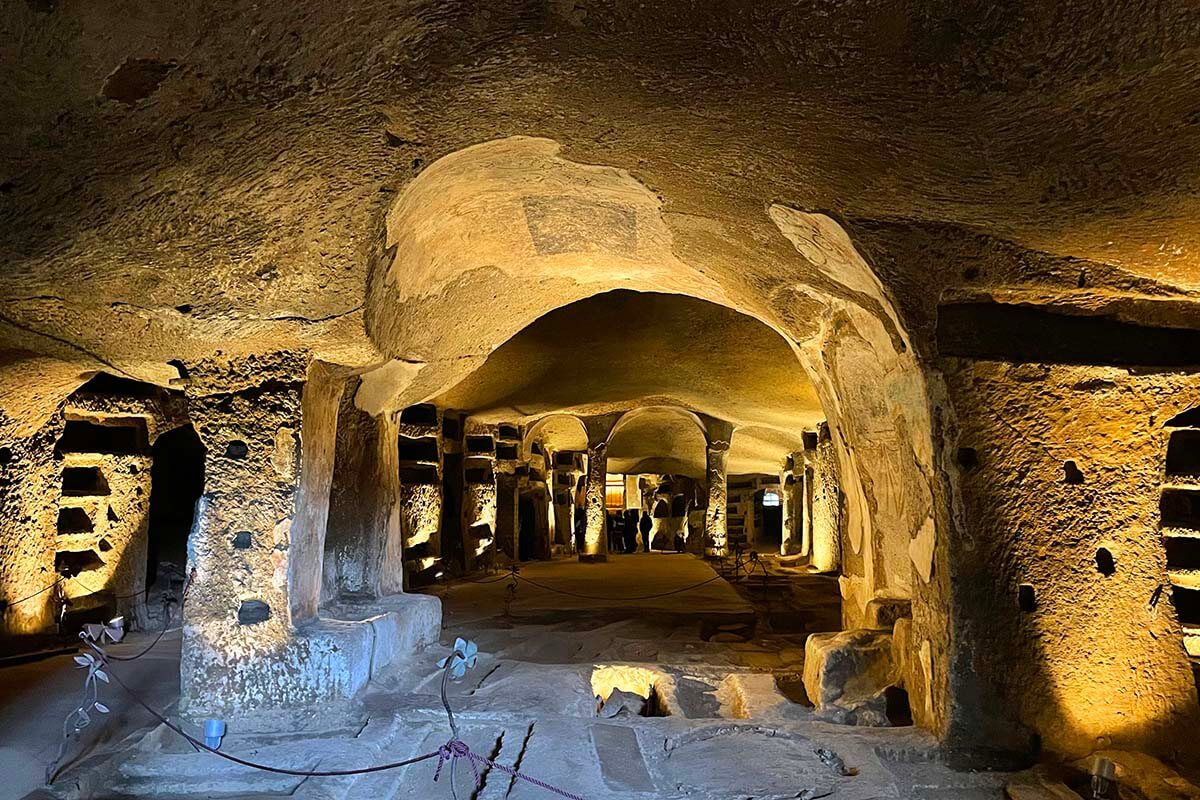
The San Gaudioso Catacombs were built below the Abbey (Badia) of the Basilica di Santa Maria della Sanità. Here, you can see mosaics and frescoes from the 5th century all the way to the 17th century.
Probably the most fascinating here are the rooms of the ‘draining ritual’ and the ‘Gallery of the Nobles’, where you can see the quirky skeleton paintings of some prominent citizens of 17th-century Naples. The stories behind these catacombs are fascinating!
Everyone in our family unanimously agreed that the catacombs should be on top of any Naples bucket list! Even our teens were fascinated and impressed (and if you have teenagers you know they’re the toughest public when it comes to visiting churches and historical sites).
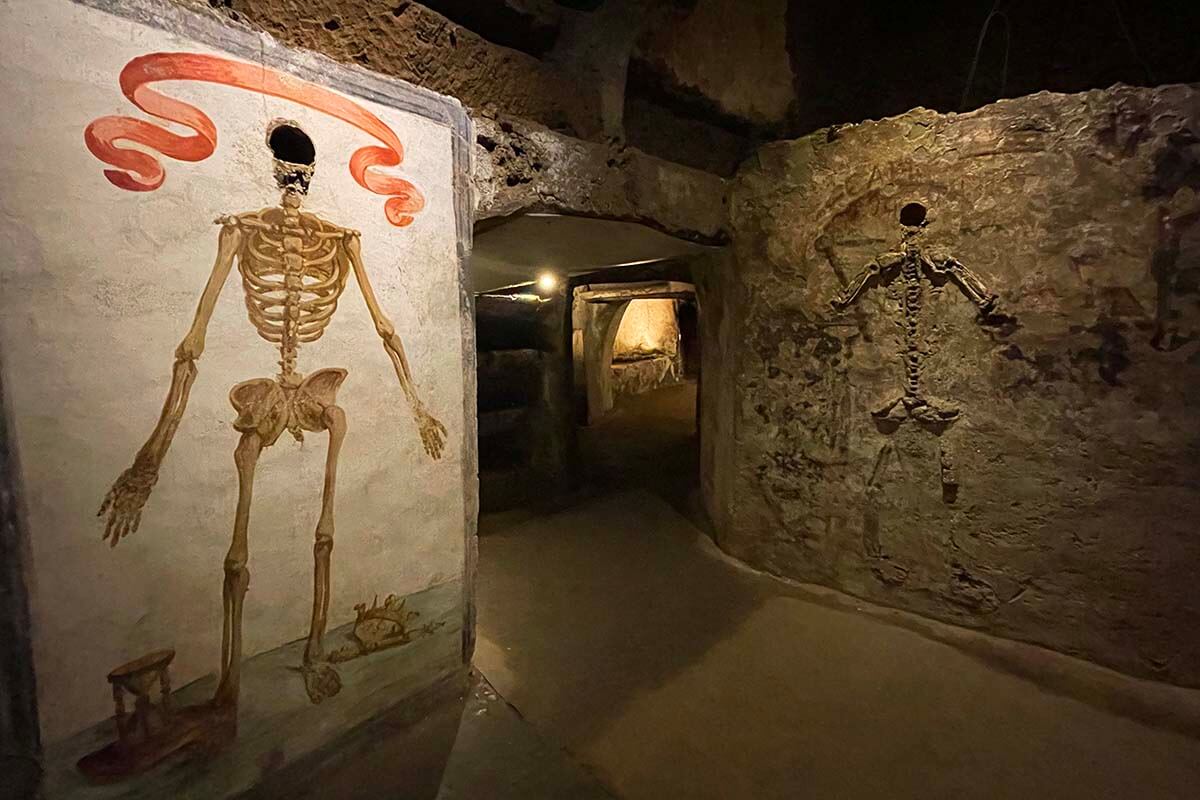
Good to know: Since it was forbidden to bury people inside the city gates, the catacombs are located somewhat outside of the old town, in the northern part of Naples. Still, it’s really not that far and you can easily get here by taxi or by public bus. Or you can even walk here from the old town – the Catacombs of San Gaudioso are just a 10-15 min walk from the Naples National Archaeological Museum.
Practical information: The Catacombs are open daily – see their website for more information and visiting times. The ticket includes both catacombs (and also gives a discount on the earlier-mentioned Cloister of Santa Chiara). You don’t have to visit both catacombs on the same day as the ticket remains valid for a year. You’ll visit the catacombs with a small group accompanied by an official guide.
Tickets: To save you time and confusion about all the ticket options, this ticket is what you need for an English-speaking tour that includes both catacombs. You choose the timed entry to Genaro Catacombs and then visit the Catacombs of San Gaudioso with the same ticket afterward.
TIP: If you have a bit more time, we highly recommend a guided ‘Holy Mile’ tour . It’s by far the best way to see both catacombs, and also some other amazing places in the Rione Sanità district (such as Palazzo San Felice or Palazzo dello Spagnolo). However, at the moment, this tour is only available in Italian. For a tour in English, you have to book a private tour directly via their website .
Or you can simply visit the catacombs and then explore the Sanita neighborhood on your own.
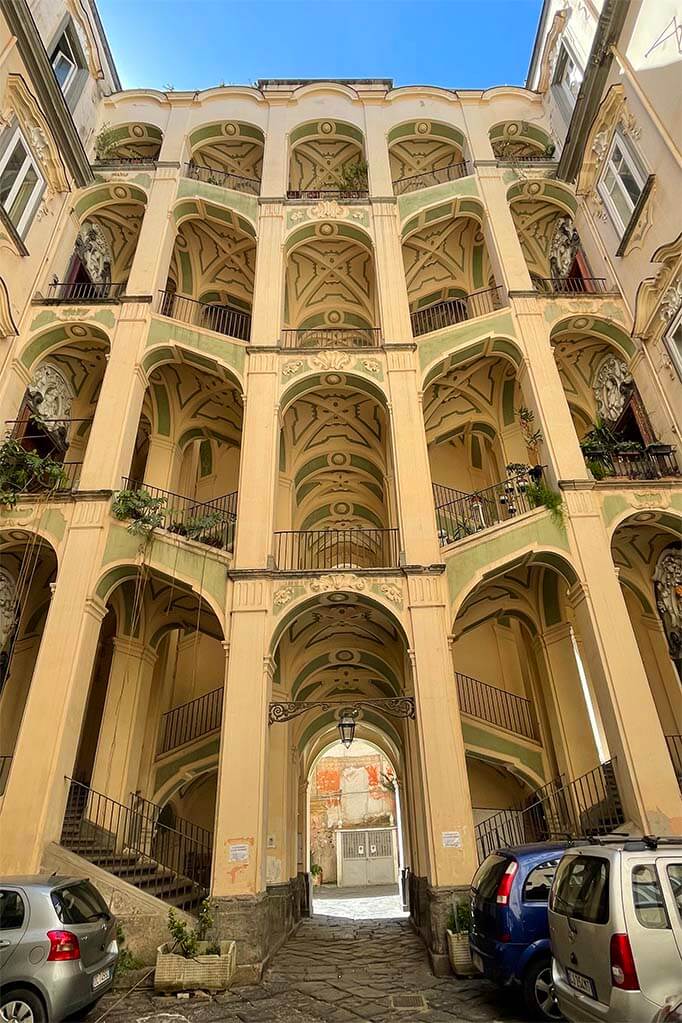
8. Naples Cathedral – Duomo
The main church of southern Italy, Naples Duomo dates back to the 13th century. Although its official name is Cattedrale di Santa Maria Assunta , it is more commonly known as the Cattedrale di San Gennaro (one of the patron saints of the city).
The Cathedral has been restored and added to multiple times throughout its history and the result is a curious mixture of Baroque, Renaissance, and Gothic styles that you see today. Nevertheless, it is very beautiful, particularly the decoration surrounding the main nave.
Of particular importance is the immaculately decorated chapel of San Gennaro, the patron saint of Naples. It is here that the residents of Naples attend three times a year to see if the two vessels of his dried blood liquify. If they don’t, it is believed that a terrible event will befall the city, such as the devastating earthquake of 1980.
The building also contains two of the oldest places of worship in Naples – The Capella di Santa Restituta and the Capella di San Giovanni in Fonte. When visiting the latter, you can just about make out some beautiful frescoes in the dome, one of which shows Christ multiplying the fishes.
Good to know: The Cathedral is open daily, but – just as most other churches in Naples – closes for a few hours early in the afternoon (usually from 1 to 3.30 PM). The entrance to the Cathedral is free of charge, but there’s a small extra fee if you want to see the most interesting chapels.
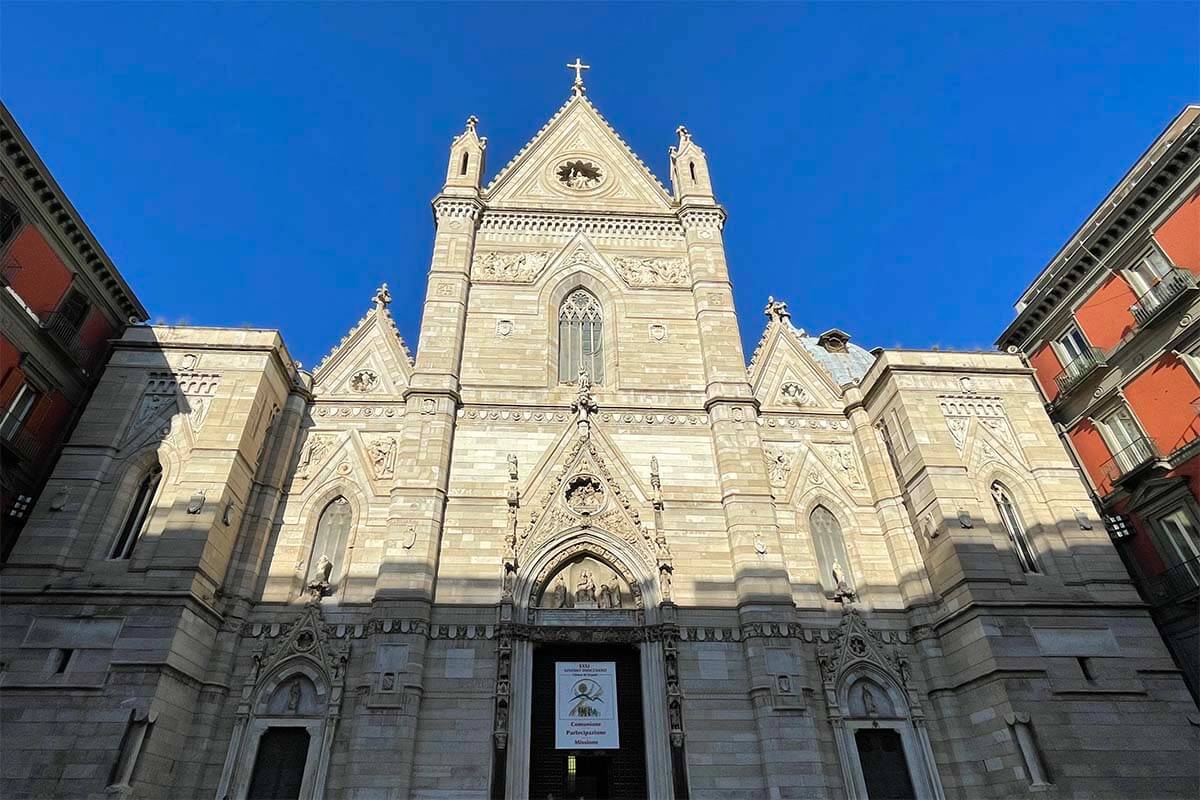
9. Napoli Sotterranea
Napoli Sotterranea is Naples Underground – the intriguing maze of ancient cavities and tunnels that lie 40 meters (120 ft) beneath the modern city. This is one of the most fascinating places to see in Naples, a trip that takes you back in time to the earliest days when the city was first founded.
Originally dating from Greek times (some 2,400 years ago), over a thousand caves were excavated in order to extract stone for the construction of Nea Polis (the ‘new town’). During Roman times, the caves were connected with a series of tunnels and used as Naples’ cisterns and water supply for over 23 centuries.
More recently, the Naples underground also served as a shelter during WWII. Over 2500 people (mostly women and children) were hiding here for over 1.5 years. It’s hard to imagine…
A visit also includes a Roman theater… hidden inside a traditional Neapolitan house.
Good to know: You’ll have to negotiate over 100 stairs (down and up again) and some very narrow passages too. The narrowest sections can be skipped if you feel claustrophobic, but those are actually the most special parts and guarantee the most unique experience that you won’t quickly forget.
Practical information: Napoli Sotterranea is located on Piazza San Gaetano 68 – do not confuse it with the nearby underground site La Neapolis Sotterrata at San Lorenzo Maggiore (which is not nearly as interesting). It’s open daily and a visit takes about 1.5 hours. You can only visit here with a guided tour, and it’s best to prebook well in advance . This is one of the most popular tourist attractions in Naples and in the high season, tours in English often sell out a few weeks upfront.
TIP: The easiest way to book a tour is via the Tiqets website , which is much more user-friendly than the official site . Plus, when we visited, it was cheaper to book tickets indirectly (go figure).
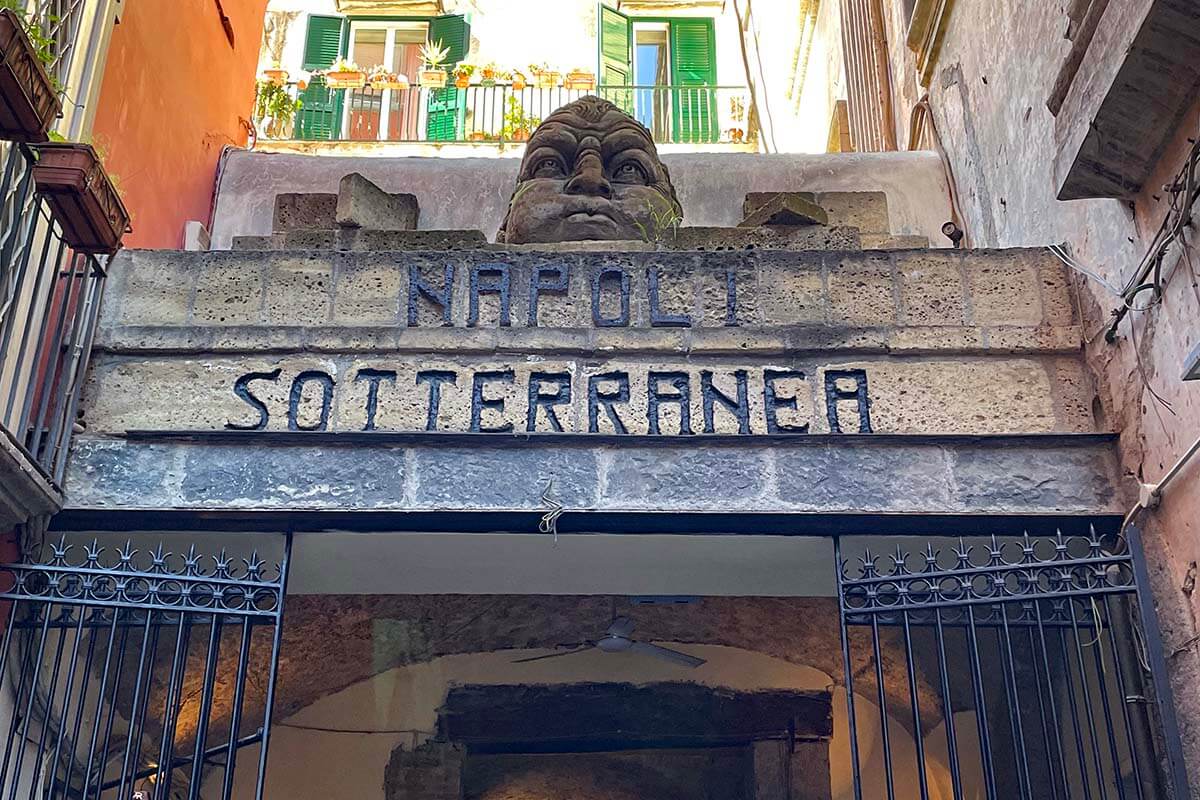
10. Views from Sant’Elmo Castle
Castel Sant’Elmo is a medieval fortress sitting high on the hill in the Vomero district in central Naples. This is where you’ll find the very best panoramic views of Naples city and its wide surroundings, with the most amazing backdrop of the Mediterranean on one side and Mount Vesuvius on the other.
Originally a church dedicated to St Erasmus, Castel Sant’Elmo was turned into a castle 400 years later in 1349. It was further fortified in the early 16th century and was also used as a prison.
The site is now also home to the Museo del Novecento. Located in the former prison of the castle, this museum is dedicated to 20th-century Neapolitan art. But the best thing to do here is simply walking around the entire perimeter of the ramparts (the castle is huge!) and enjoy the stunning 360° panorama. The views from here are unparalleled!
TIP: Castel Sant’Elmo is the best place in Naples from where you can see an aerial view of Spaccanapoli – the iconic street that ‘splits’ Naples in two (mentioned as #1 on our list of top places to see in Naples).
Good to know: Castel Sant’Elmo can be reached by various staircases from the old town, but the easiest way to get here is by taking a funicular. We took the funicular from Montesanto funicular station, and you can also get here from Augusteo funicular station.
Practical information: Castel Sant’Elmo is open daily and you can get the ticket on the spot. For more practical information, see the official website (in Italian).
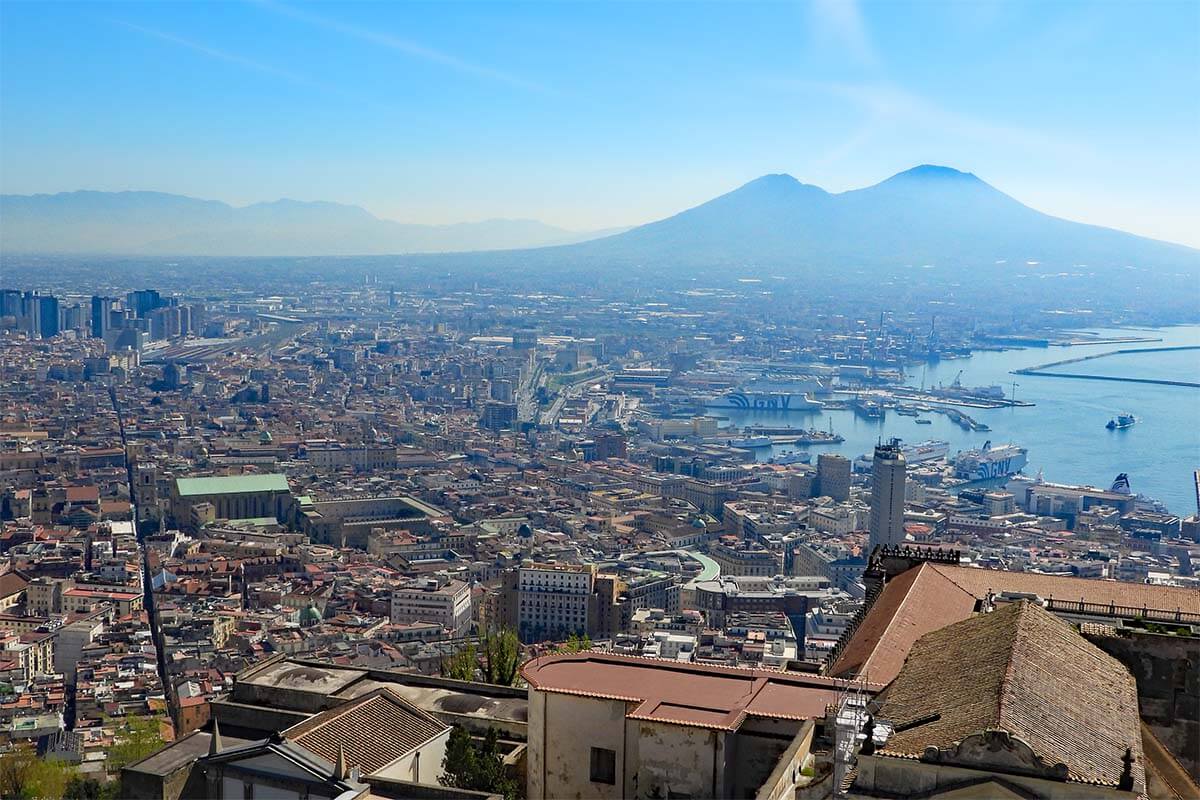
TIP: Combine Sant’Elmo Castle with a visit to San Martino Monastery, just nearby (more info below). Afterwards, take one of the steep staircases back down to the city center – it’s a great way to explore a more local side of Naples!
There are stairs – Pedamentina a San Martino – right at the Belvedere San Martino in front of the Monastery, which seem to be quite popular with tourists.
Alternatively, you can walk around the castle to the Salita del Petraio staircase which – we were told – is more impressive and gives better views and a more local experience. We took the latter and indeed, it was a great choice – highly recommended instead of taking the funicular back down.
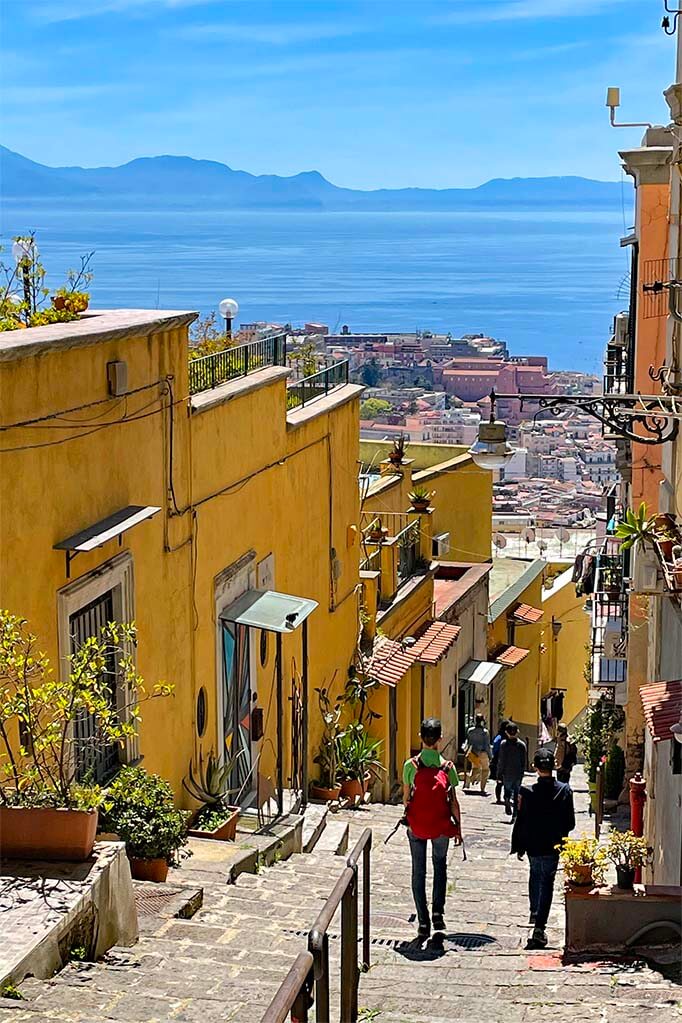
11. San Martino Monastery & Museum
Located right at the foot of Sant’Elmo Castel, high on top of the Vomero hill overlooking Naples bay, you’ll find another landmark of Naples – Certosa e Museo di San Martino .
The Charterhouse of St. Martin was built in 1325 and was originally a Carthusian monastery. It has been renovated and altered many times throughout its history by some of Italy’s most important sculptors and architects.
Nowadays it is a museum dedicated to Neapolitan and Italian art, with beautifully designed cloisters and elaborate frescoes. You can see works by 17th-century artists such as Battista Caracciolo and Jusepe de Ribera here, and some beautiful inlaid marble work in the nave. You’ll also find Lanfranco’s ceiling painting of the ‘Ascension’ and the ‘Triumph of Judith’ ceiling fresco by Luca Giordano.
The Monastery is huge and there’s so much to see that you could easily wander here for several hours. Plus, there are big gardens to explore, offering nice views of Naples and the coast below. But even if you only have an hour to spare, it’s well worth a visit – both, for the building itself, the stunning art inside, as well as the views. However, if you are only interested in the views, then go to Sant’Elmo Castle instead.
Good to know: Just as with Sant’Elmo Castle, the best way to get here is by funicular.
Practical information: Certosa e Museo di San Martino is open daily except on Wednesdays. See the o fficial website for more info (in Italian). There’s no need to reserve tickets – you can just get them on the spot.
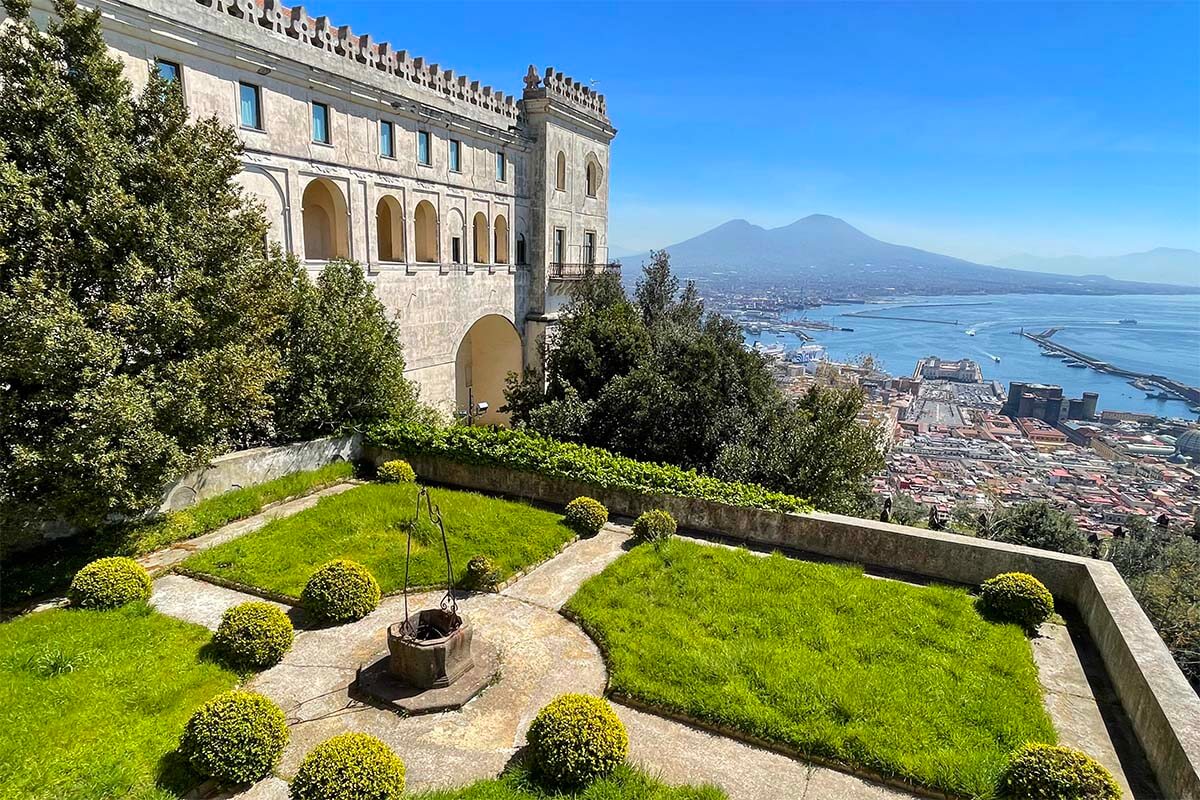
12. Piazza del Plebiscito
With 25,000 square meters, Piazza del Plebiscito is Napoli’s main square and one of the largest in Italy. An amazing place to visit in Napoli, the square is framed by the semi-circular colonnades of the San Francesco di Paola Basilica . A minor basilica, it is considered one of the most important examples of Italian Neoclassical architecture.
There are lots of other important buildings to see here too, including the Royal Palace (more info below), the Prefecture Palace (which houses the institutional body that rules the province), and the Palazzo Salerno. You can’t miss the two statues in the center either – one of them is dedicated to Spain’s Charles III, and the other one – to Ferdinando I.
Totally pedestrianized (giving you a welcome break from the noisy Vespas), this vast open space was once known as Largo di Palazzo and used for bullfights. These days, Piazza del Plebiscito is a popular spot for outdoor concerts and other cultural events.
Fun to do: Whilst there, why not try the popular local game of crossing the square blindfolded or with closed eyes… The game started with the legend of Queen Margherita, who was said to grant salvation to only the prisoners who had accomplished the task.
The idea is to start at the entrance of the Royal Palace (between the two equestrian statues). You then walk for around 170 meters in a straight line, passing through the middle of the square. Apparently, no one ever manages it because of the square’s slight (but unnoticeable) slope.

13. Royal Palace of Naples
Located in the Piazza del Plebiscito opposite the Basilica Reale, Palazzo Reale di Napoli is a huge stunning building that was constructed from 1600 onwards. Originally used by the Bourbon Kings as one of their four royal residences in the city, the palace and its grounds are now dedicated to the Teatrino di Corte, the Teatro di San Carlo, and the National Library.
It is worth visiting just to see the building from the outside as it is really impressive, with statues honoring various rulers of Naples from the 12th to 19th centuries.
But the real attraction is the palace’s opulent interior – now a museum. The exquisitely preserved rooms filled with elaborate decoration showcase the history of Naples from the 17th to 19th centuries.
The majestic hallway and sweeping staircase are quite breathtaking, and if you stand in the magnificent throne room it is easy to imagine all the kings and queens that must have stood there before you. The lavish theater – Teatrino di Corte – was built for the wedding of Marie-Antoinette to Ferdinand.
Practical information: The Royal Palace of Naples is open daily except on Wednesdays. There’s no need to reserve a ticket – you can get it at the entrance. For more practical info, see here .
TIP: If you have more time in Naples, visit the Royal Palace of Caserta which is located outside the city (more info in the ‘day trips’ section further below). It’s even more impressive than the Royal Palace of Naples. But if you don’t have the time to travel to Caserta, definitely take a look inside the Royal Palace in Naples city center.
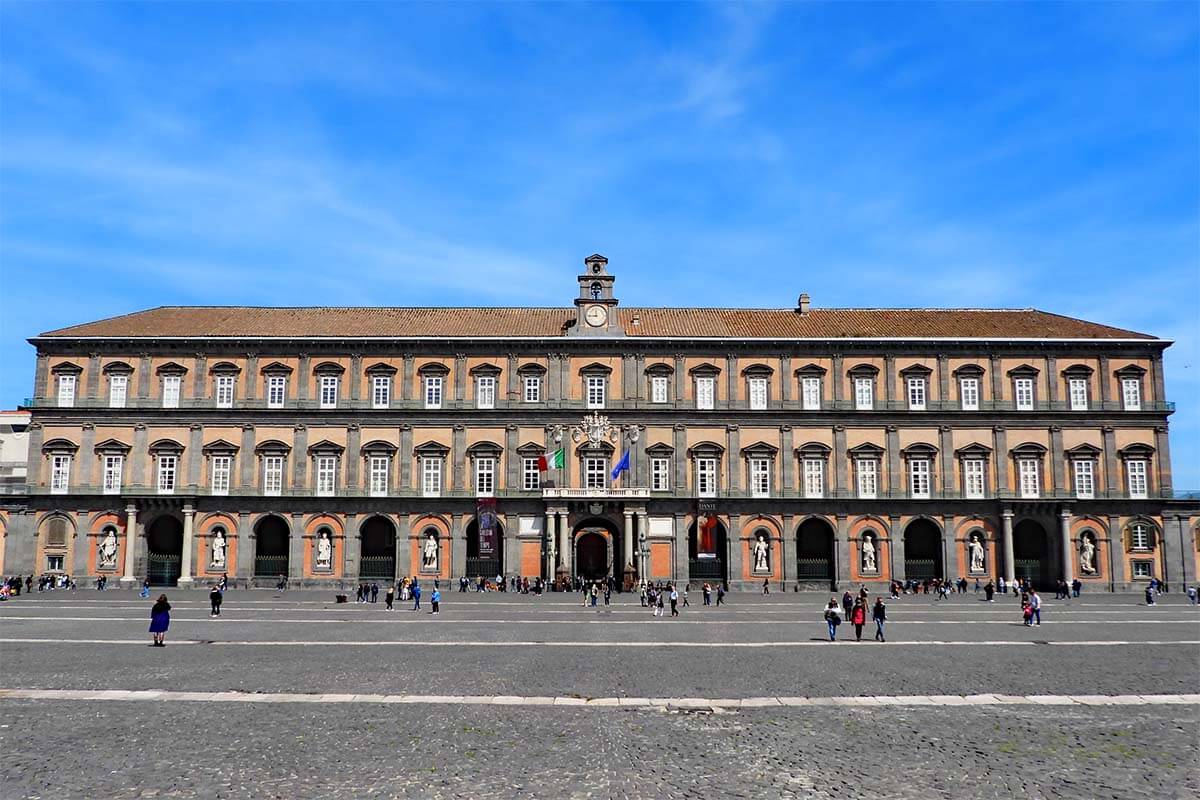
14. Galleria Umberto I
Galleria Umberto I is a public shopping gallery located just a few steps from the Piazza del Plebiscito and the Royal Palace. While not an absolute must, in our opinion, it’s one of the most beautiful landmarks in Naples. Furthermore, it only takes a few minutes of your time, so we highly recommend you check it out!
Beautifully designed, its domed steel and glass roof fills the gallery with light. Builts towards the end of the 19th century, it features various sculptures and murals, with shops and eateries on the ground floor and offices upstairs. If you’ve ever been to Milan , you may just notice how much it resembles the Galleria Emmanuelle II, on which it was modeled. It has a similar, cross-shaped design.
It’s hard to imagine that this was once an area that had a bad reputation for fighting, crime, and prostitution! Indeed, the very purpose of this gallery was to make Naples attractive again, providing a safe place for people to walk and shop.
The shops at Galleria Umberto I are a mix of boutiques, high street names, and discount stores. There are also several cafes where you can indulge in a little people-watching and regular visits from street performers.
TIP: The gallery is also home to a 4* luxury hotel – the Hotel Art Resort Galleria Umberto , a nice place to stay for sightseeing in Naples!
READ ALSO: Best Places to Stay in Naples
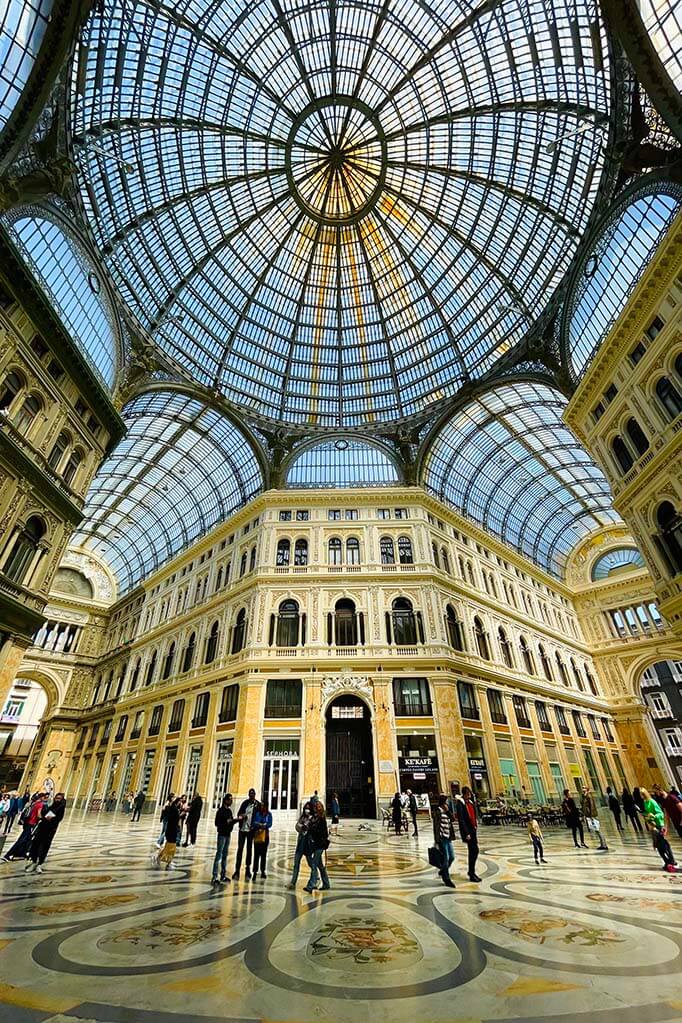
15. San Carlo Theater
Housed in a magnificent Neoclassical building just near the Royal Palace and across the street from Galleria Umberto I, Naples’ Teatro di San Carlo is the oldest continuously running public opera venue in the world.
San Carlo Theater was first opened in 1737, commissioned by the Bourbon King Charles III of Naples. Restored following a devastating fire in 1816, the interior is now quite dazzling, with a traditional horseshoe-shaped auditorium and beautiful red and gold furnishings. It’s decorated with vibrant frescoes as well.
TIP: If you are lucky to visit when there are performances (and can get tickets), you could attend an opera or a ballet here. The opera season runs from January to May and there are ballet performances from April to June. However, we visited in mid-April and there was nothing on the program during our travel dates… You can check the events calendar on their website .
Alternatively, you can take a guided tour of the auditorium, the royal box, and the foyers. However, the schedule of the guided tours depends on the performances, etc. and it’s not straightforward to book it. You can check the general tour schedule online , but the best way to get a tour is by calling the theater a few days in advance. There’s usually one tour (in English) in the morning and one in the afternoon.

16. Via San Gregorio Armeno
Via San Gregorio Armeno may just be the most famous alleyway in Naples and its purpose is somewhat unique!
Otherwise known as ‘Christmas Street’ , this is where you will find the city’s presepe artisans. A presepe (plural presepi ) is a Nativity scene and the tradition of creating them goes back for 1000 years. At any point in the year you can visit Via San Gregorio in order to buy the figurines you’ll need to create a display of your own!
But even if you don’t plan to buy anything, a walk through this street is a must when visiting Naples.
TIP: For the best atmosphere and displays, come here in the morning – early afternoon because some shops close quite early.
Another attraction to visit here is the hidden cloister of the San Gregorio Armeno Church . It has an enclosed 17th-century garden filled with citrus trees and a Baroque marble fountain. Be sure to go in the morning, though – admission is only permitted for a few hours, usually until noon.
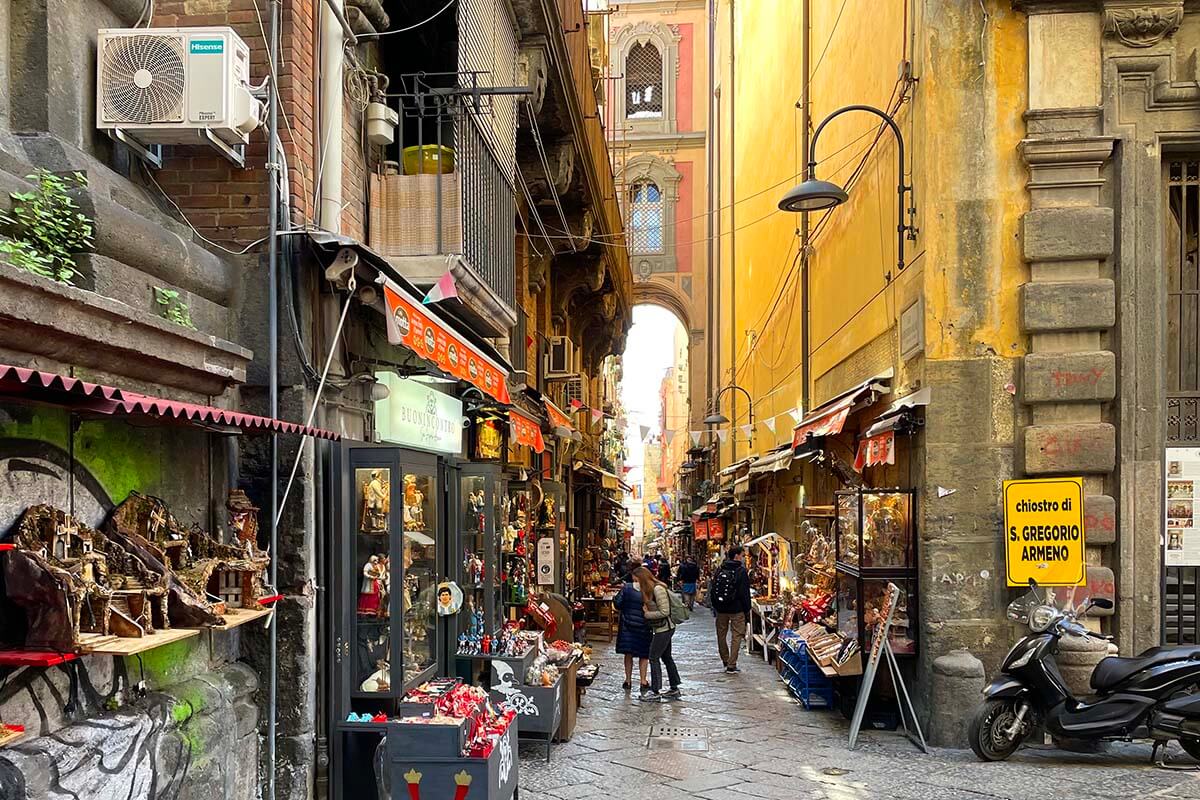
17. Naples Waterfront
A popular thing to do in Naples is to take a stroll along the 2.5 km pedestrianized seafront promenade, aka Naples Waterfront (also called Lungomare di Napoli or Lungomare Santa Lucia ).
The views here are lovely, taking in Capri and Mount Vesuvius along with Naples itself. On the other side is the greenery of Naples Villa Comunale Park, making this a real oasis of calm in this crazy busy city.
You’ll find a few free beaches along the way, plus boat rentals and numerous kiosks selling lemon granita and snacks. There are also a few places to rent bikes – in fact, some of the restaurants even offer free bike rentals to their diners.
Alternatively, visit towards the end of the day when the sun goes down. Not only will you be able to take some amazing photos, but you’ll also find many locals enjoying their traditional evening stroll – the passeggiata .
TIP: Some of the most popular ‘grand’ hotels in Naples ( Eurostars Hotel Excelsior , Hotel Royal Continental , etc.) are located on Via Partenope, a wide boulevard facing the sea.
If you are visiting Naples in summer, this would be one of the nicest areas to stay in – not just for the sea views or waterfront activities, but also – literally – in order to have some air. You can enjoy a nice breeze here whereas the city center with its narrow alleyways can get really hot.
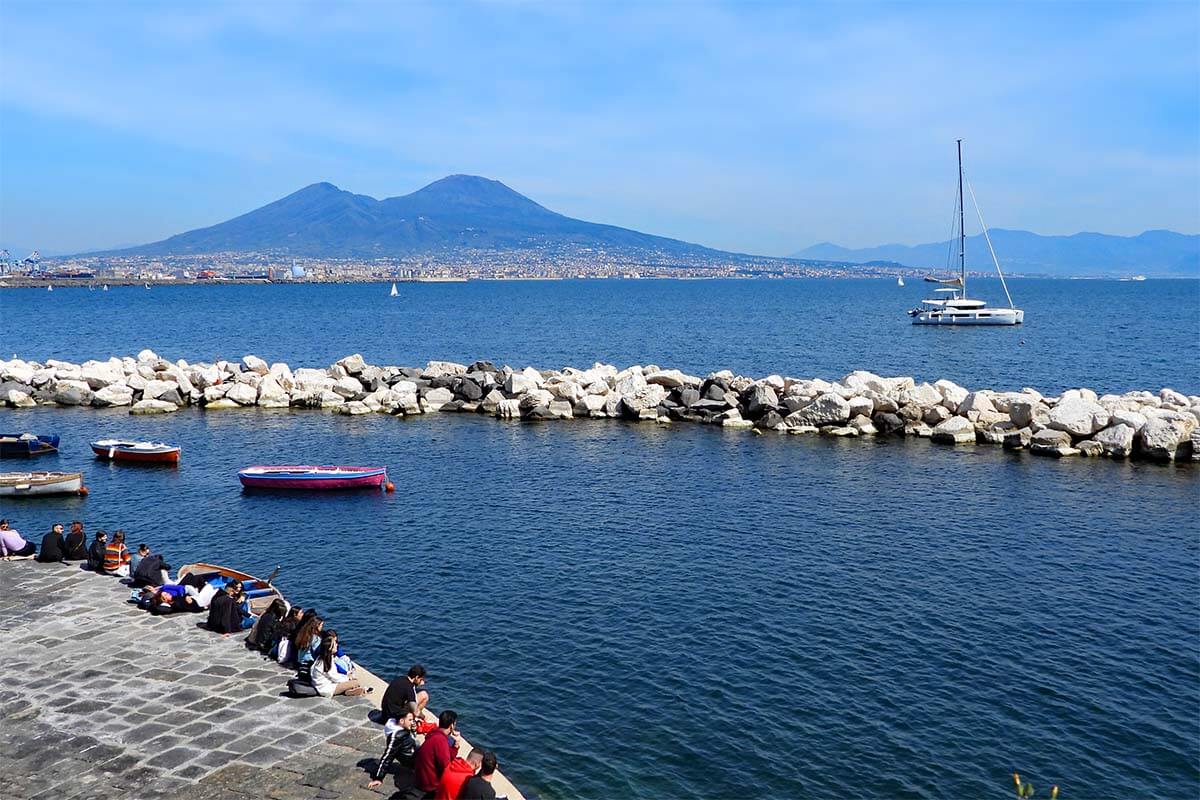
18. Ovo Castle
Visible as soon as you enter the port of Naples, the imposing Castel dell’Ovo (the Egg Castle) is the city’s oldest remaining fortification, dating back to the early 6th century BC. Legend has it that the Roman poet Virgil placed a magical egg into its foundation – hence its name. A less compelling version is that the castle was named for its unusual shape.
The castle stands on an island overlooking a small marina, although it is actually connected to the mainland via a footbridge and road. There is not a great deal to see inside except for a few displays explaining its past and – sometimes – temporary exhibitions.
However, walking around its stone walls gives you a real feel for its history and the nice views across the Mediterranean sea make it worth a quick visit. You can also take a stroll around the tiny island on which the castle stands – the Borgo Marinaro . Here, you’ll also find some nice (seafood) restaurants.
Good to know: Castel dell’Ovo is open daily and the entrance is free of charge. Many people say this is an amazing place to see a sunset in Naples, but unfortunately, the castle closes too early for that… I guess you could always stay for sunset at the waterfront area – see below.

19. Castel Nuovo
A prominent part of the city skyline, the Castel Nuovo is one of the most remarkable buildings in Naples. It was first constructed in 1279 and the name ‘New Castle’ was given to distinguish it from the other fortresses in the city at the time. It’s also known locally as Maschio Angioino (Angevin Keep).
Castel Nuovo is located close to the Piazza del Plebiscito and the harbor. It features 5 circular crenulated towers, plus a later addition of a majestic triumphal arch carved from white marble.
While this castle is more impressive from the outside than it is on the inside, if you have a few hours to spare, you can take a tour to view the interior. Here, you’ll see frescoes by Giotto and a collection of 17th to 20th-century artworks by Neapolitan painters. Some of the highlights include the beautifully painted ceiling of the Barons’ Hall and the panoramic views across the city and bay from the ramparts.
Practical information: Castel Nuovo is open daily, with some exceptions. You can try to understand a very unclear official website or simply go there and see if it’s open. I have to admit that we decided not to visit this castle inside since we heard there’s not that much to see compared to the other landmarks in Naples. So I cannot really comment on this one based on personal experience.
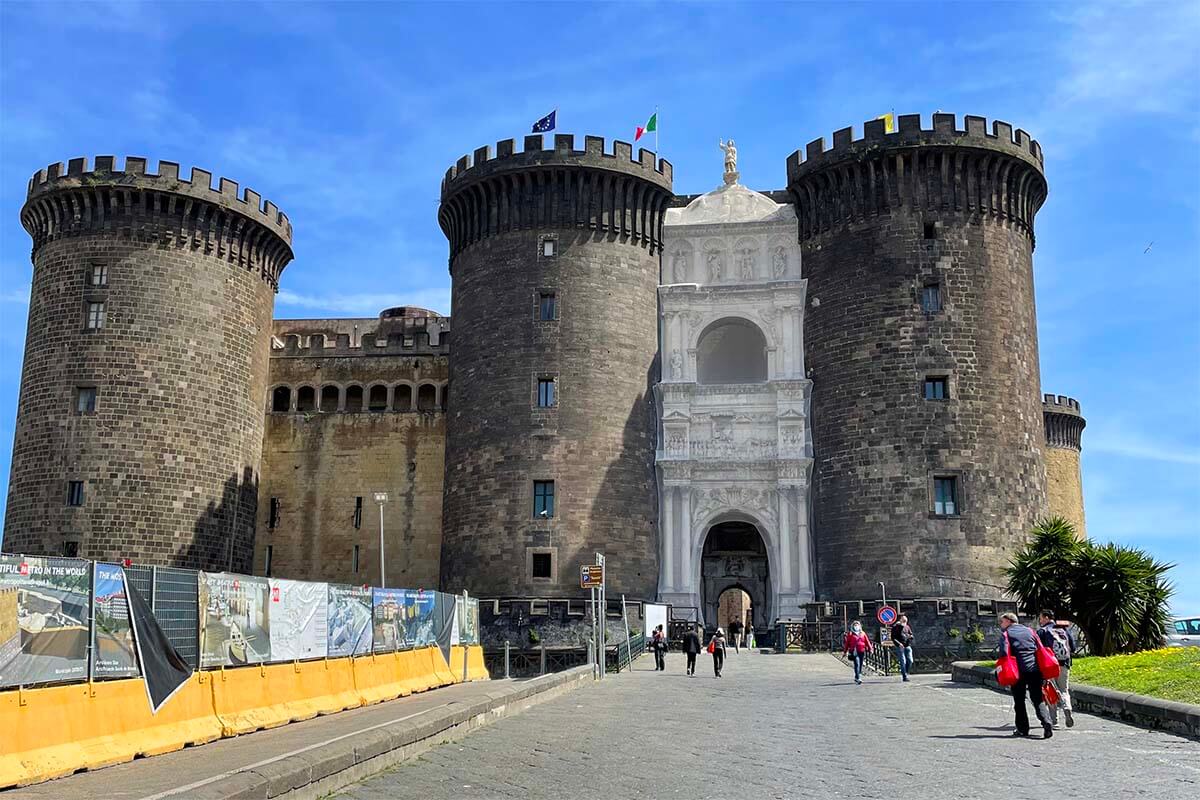
20. Spanish Quarter & Largo Maradona
One more place that’s probably worth mentioning among the best places to see in Naples is the Quartieri Spagnoli . This is a small neighborhood in central Naples, west of Via Toledo, one of the main shopping streets in the city.
The Spanish Quarter is crisscrossed by narrow alleyways lined with tall residential buildings. On the ground floor, you’ll usually find tiny shops, small cafes, and lots of restaurants – this is one of the nicest areas for lunch or dinner in Naples. This area has a few pizza places too, but it’s more a place for seafood, pasta, risotto, and other local dishes.
If you have 15-20 minutes to spare, simply walk around the Spanish Quarter. It’s a lively area where you can get a taste of the real day-to-day life of regular residents of Naples. Neighbors chatting to each other, kids playing football, Vespas zooming past you… Colorful street art and cloth lines with laundry spanning the streets just add to the atmosphere.
One of the quirkiest places to see here is the area Largo Maradona with several big murals dedicated to Diego Maradona. This Argentinian football player achieved the peak of his career during the 7-year period between 1984 and 1991 when he played in Napoli.
You could say that Maradona is the adopted son of Naples. Many locals – not jokingly – call him their patron saint. Some Neapolitans regard their ‘San Diego’ the same way as ‘San Gennaro’…
You’ll see Maradona and all kinds of memorabilia dedicated to him all over Naples. But if you have a few minutes to spare, check out this ‘shrine’ to Maradona in the Spanish Quarter. On Via Emanuele de Deo, you’ll find a small cafe La Bodega De D10S , several big Maradona murals, and all kinds of Maradona memorablia…
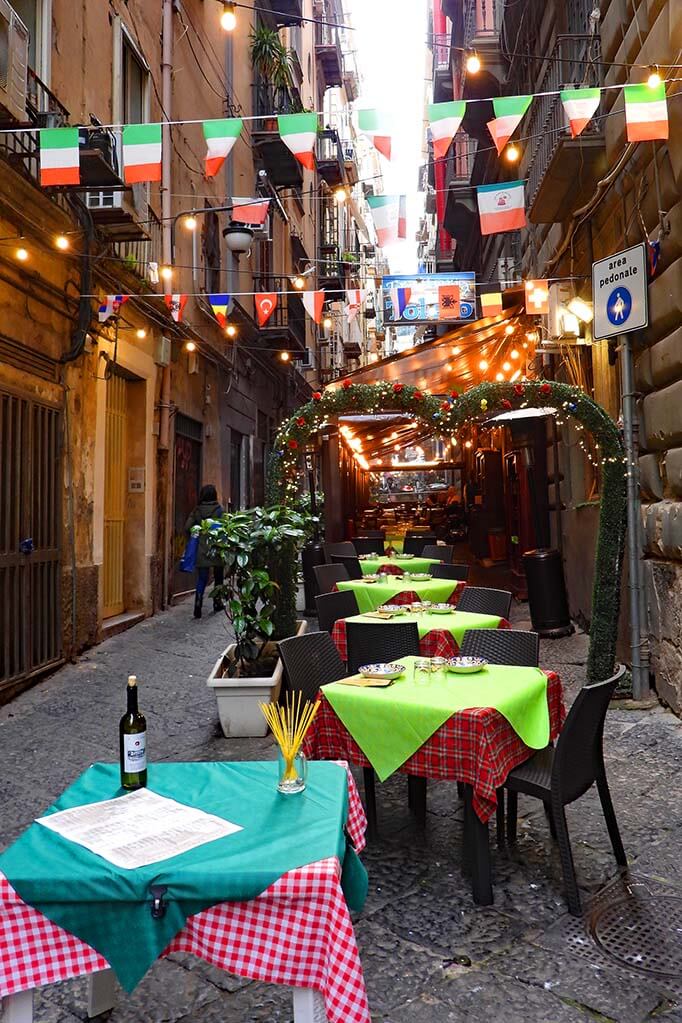
21. Royal Palace of Capodimonte
Museo e Real Bosco di Capodimonte is another interesting place to see in Naples – if you have more time after visiting all the ‘musts’ in the city center.
This art museum is located inside the 18th-century Bourbonian Royal Palace of Capodimonte . This palace – museum houses an incredible collection of 47,000 artworks. This makes it one of the world’s largest collections of medieval, modern, and contemporary art.
In its 126 galleries, you can view works by illustrious artists such as Raphael, Michelangelo, Botticelli, and many, many more. To see these pieces in such a beautiful setting is a fantastic experience.
There is natural beauty to be found here too in the 300 acres of the Royal Park of Capodimonte , which contains more than 400 species of plants. This tranquil green space was once named the most beautiful park in Italy and it feels completely disconnected from the bustling city below.
Good to know: The Royal Palace of Capodimonte is located just 2 km outside of the city center. However, since it’s set on a hill, it’s easier to take a bus or a taxi rather than walk. Normally, the Naples hop-on hop-off bus stops here too, but the route seems to have been discontinued when we visited. Maybe they’ll include it in the itinerary again in the future – be sure to double-check if you plan to visit here…
Practical information: The Museum is open daily except on Wednesdays. You can find more practical information on their website (in Italian). A nice way to visit here is with a private guided tour – especially if you are interested in art and want to learn more about the most important pieces.
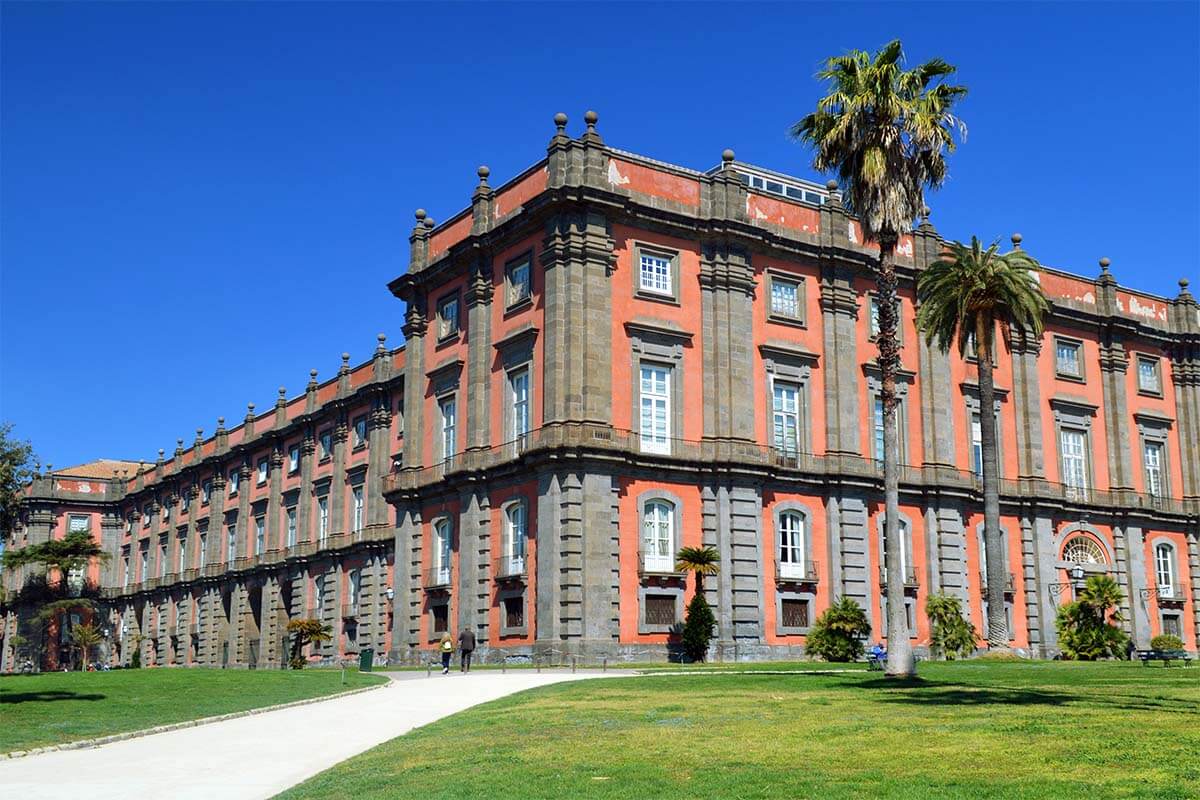
22. Pizza & Food Tours
Of course, one of the VERY BEST things to do in Naples is trying the world-famous Neapolitan pizza , right where it was first created.
As already mentioned before, Via dei Tribunali in the heart of the old town is a great area for pizza, but there are countless amazing pizza restaurants scattered all over the city!
Some of the most popular and best-rated pizza restaurants in Naples center include Sorbillo , L’Antica Pizzeria da Michele , Pizzeria Starita a Materdei , Pizzeria Da Attilio , Antica Trattoria e Pizzeria da Donato , and many – many others. I indicated these and a few other restaurants on our map of Naples sights and attractions – be sure to try the pizza at least at one of them.
In addition to the traditional Neapolitan pizza, Naples is also famous for its folded pizza ‘a Portafoglio’, and also fried pizza . You’ll find many restaurants serving folded and fried pizza in Naples. For some of the best fried pizza in Naples, head to the Isabella De Cham Pizza Fritta restaurant in the Rione Sanità district where the Catacombs are located.
And, of course, there are so many other amazing typical dishes, drinks, and desserts to try in Naples, beyond pizza!
TIP: One of the best ways to get a taste of traditional food in Naples is by joining a food tour . In just a few hours, you get a nice introduction to the regional cuisine and try some local specialties, plus you tour the city center with a local guide so you learn a lot more about the city than just by having a meal at a restaurant.
There are many food tours and pizza-making classes in Naples and I don’t think you can go wrong with any of them. We opted for this highly-rated street food tour and had a great evening eating our way through the old town. Our tour included different types of cheeses and small snacks, two types of pizza, traditional pastries, limoncello, gelato, and more. It’s something fun to do in Naples for the whole family!
READ ALSO: Traditional Italian Food per Region

23. Take a day trip outside the city!
No trip to Naples would be complete without visiting at least a few of the most famous places near the city. Pompeii, Herculaneum, the Royal Palace of Caserta, Amalfi Coast, and Capri Island are just some of the most popular options (and each is worth a trip on its own!). So when planning your Naples sightseeing itinerary, be sure to foresee some extra time to spend outside the city as well!
There are many ways to plan a trip to the Naples area and the Amalfi Coast and you can make a longer trip to the area. However, it is possible to see all the best places by taking day trips/ tours from Naples as well.
Here are some of the most popular places nearby that we recommend to see when you visit Naples:
- Pompeii. The remains of an incredibly well preserved ancient Roman city that has been destroyed by an eruption of Mount Vesuvius in 79 AD. You can take a train to Pompeii, but without a guide, it’s all just ruins and the huge site is overwhelming, so we recommend you book a guided tour ! There are many day tours that can bring you there from Naples too, often, in combination with a few other places nearby.
- Herculaneum. This ancient city was also destroyed by Mt Vesuvius in 79 AD. It’s similar to Pompeii but is smaller and better preserved, however not as famous and therefore less visited by international tourists. If you have the time to see both, it’s well worth it. But if you can only visit one – most people opt for Pompeii instead. You can easily get to Ercolano from Naples by train, but it’s best to book your entrance ticket so that you don’t waste too much time in line. Day tours from Naples are also available, often in combination with Pompeii and or MtVesuvius.
- Mount Vesuvius. A visit to the crater of this impressive volcano is one of the most impressive things to do in Naples! If you want to visit on your own, take a train to Ercolano or Pompeii, and from there a bus to Mt Vesuvius (the bus company can usually help you get the entrance tickets too, or you can book them yourself – see some of the best ticket options here and this is the bus from Ercolano ). But the easiest way to get to Mt Vesuvius (and make the most of your time) is by taking a tour that visits Pompeii and Mt Vesuvius on the same day . Tours that include Herculaneum are also available.
READ ALSO: How to Visit Mount Vesuvius
- Capri . This beautiful island can be reached by ferry from Naples and is a wonderful day trip to consider! You can visit Capri on your own , just be sure to pre-book the ferry tickets, especially in high season. Also, plan well in advance what you want to see when you get there since one day is really just enough for the highlights. Alternatively, you can opt for an organized tour and let them take care of the planning and transportation to and on the island.
- Amalfi Coast. One of the most beautiful places in Italy , the Amalfi Coast deserves a separate visit. But yes, you can also see the main highlights on a day trip from Naples. With just a day, I wouldn’t recommend going on your own – take a tour or book a private driver and enjoy this beautiful area without having to stress about getting around. Here you can find more information on how to get to the Amalfi Coast from Naples .
- Royal Palace of Caserta . This is one of the largest royal residences in the world and one of the most interesting places to see when visiting Naples! In addition to the impressive interior, the Palace also has stunning Versailles-like gardens. Located in Caserta, you can easily get here by train from Naples and there are also organized half-day tours available. A visit here is a wonderful addition to any Naples sightseeing itinerary!
LEARN MORE: Best Excursions & Day Trips from Naples
Below are some frequently asked questions that might help you plan your visit to Naples – take a look!
Yes, Naples is well worth a visit! It’s one of the most fascinating cities in Italy, with centuries-old history, impressive architecture, and some of the most remarkable ancient art in the world. Furthermore, Naples has a stunning coastal location, an incredible bustling atmosphere, and the best pizza in the world. In addition, the surroundings with sites like Pompeii, Mt Vesuvius, or the Amalfi Coast make Naples more than worth a trip.
We recommend 2-3 days for Naples city, not including the time for any of the day trips nearby. While you can see some of the main landmarks in Naples city in 1 day , you really need at least 2 days to do this city justice. In addition, plan 3-4 extra days for the nearby places such as Pompeii, the Amalfi Coast, Mt. Vesuvius, and Capri.
You may have heard that Naples is dirty and unsafe, and there’s definitely some truth in it. However, it’s mostly petty crime and Naples isn’t any more dangerous than most other major cities in the world. Just be careful with your belongings and cautious of pickpockets in busy areas and when using public transport. We spent several days exploring many different areas in Naples city and never felt unsafe.
Naples is a large city, but most tourist attractions are concentrated rather close to each other and you can explore the majority of the main sights in Naples on foot. For the areas located on the hill, take a funicular, and if you prefer not to walk bigger distances, you can use the metro, public buses, or taxis which are rather cheap. Hop-on hop-off bus is also available and covers most of the tourist attractions in Naples.
Depending on what you plan to see and do (in and near Naples), you may want to stay in different parts of the city center. If you plan multiple day trips by train, stay west of the central railway station (e.g. UNAHOTELS Napoli or Hotel San Pietro ). For sightseeing and shopping – stay between Via Toledo and the harbor area (e.g. Palazzo Turchini or NapoliMia Hotel ). For a more relaxing vacation, stay at the Lungomare waterfront (e.g. Hotel Royal Continental ).
So, this is our guide to some of the very best things to do in Naples for first-time visitors. I hope that it helps you plan an unforgettable visit to this fascinating city that I can only describe as a rough diamond. Naples is definitely one of a kind, a captivating city, which has a life very much of its own.
If you have limited time and are wondering how to plan your time in Naples, check out our suggested 1-day Naples itinerary .
TIP: If you are wondering how to plan your visit to the Naples area and don’t know where to start, you may want to check out our guide with the Amalfi Coast itinerary suggestions . It gives you an idea of how to visit the ‘must-see’ places in as little as 5 days (although I recommend much longer if you have the time). If you have more than a day or two for that area, be sure to also check our detailed guide to the best places to stay on the Amalfi Coast , and also our guide to hiking the Path of the Gods .
READ ALSO: Naples – Capri – Amalfi Coast Itinerary (+-10 Days)
More guides to some of the nicest Italian cities:
- Best things to do in Rome
- Best things to do in Venice
- Best things to do in Florence
- Best things to do in Milan
- Best things to do in Verona
- Best things to do in Ravenna
- Best things to do in Siena
- Best things to do in Como
- 1 day in Milan
- 1 day in Rome
- 1 day in Florence
- 1 day in Venice
- 3 days in Venice
- 2 days in Rome
- 4 days in Rome
READ ALSO: Italy itinerary for 2 weeks & How to Plan a Trip to Europe
If you found this post helpful, don’t forget to bookmark it and share it with your friends. Are you on Pinterest? Pin these images!
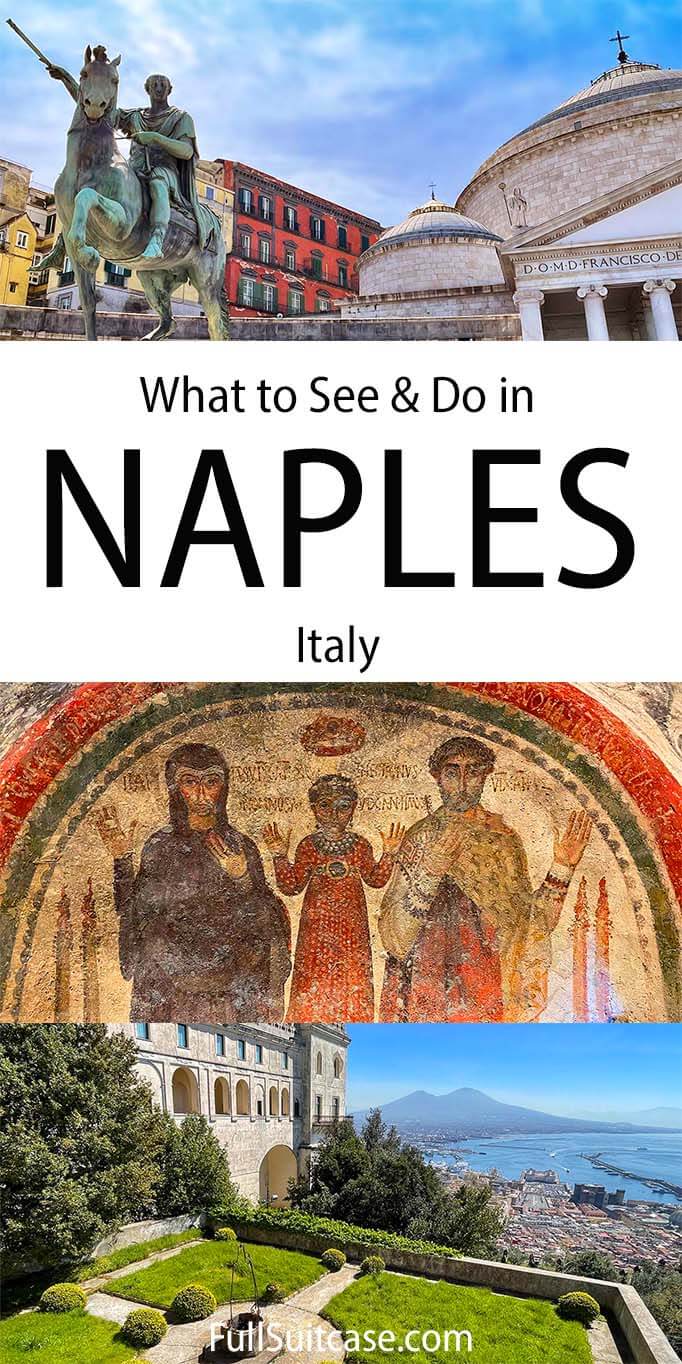
This site uses Akismet to reduce spam. Learn how your comment data is processed .
Monday 22nd of July 2024
Thanks so much for the wonderful blog, pointing out the great sites. I will be there in September and was wondering if you mapped these locations. I only have a day there but want to get as much photographed as possible.
Thanks so much
Tuesday 23rd of July 2024
@Jurga, Tried on another computer and was able to see sorry. Web browser protection sometimes hides parts of the page.
Hi Richard, the map we included at the top of this article already indicates all the top places to see in Naples that are mentioned in our guide. So I'm not sure I understand the question. Maybe you have some kind of an ad blocker that prevents you from seeing the map (and supporting the blogs you read!). If you only have a day in Naples and want to see the best that the city has to offer, take a look at our guide to the best of Naples in one day.
Sunday 17th of September 2023
Hi there - I'm so grateful for your blogs on Italy since we'll be doing our 1st trip the 1st two weeks of April 2024 and I'm torn between where to stay in Naples. We will be arriving via train from Rome by Noon & will stay 3 nights. Two days will be day trips w/tour companies to Pompeii and the Amalfi coast. That means we will only have half a day (Easter Sunday) in Naples and plan on doing the food tour you took. My question is should we stay in the historic center OR the Naples waterfront? When we return from the day trips we'll be tired so most likely will hit the hotel to rest. I appreciate your advice.
Hi Patricia, if you are taking day trips, they will most likely depart from the railway station. In that case, it's probably best to stay there. For example, Hotel San Pietro or UNAHOTELS Napoli are both located in that area. The main areas in the old town are just 15-20 minutes walk from there. If I were you, I'd first check the departure locations of the tours that you plan to take and then book a hotel as close as possible. That will save you a lot of stress. Have a great trip!
Michael Cicchi
Sunday 24th of April 2022
I spent a week in Napoli and thought I saw plenty of it but this article just showed me that I missed a whole lot of it. 😔 So, I will definitely dedicate another week there after going to Venice.
Tuesday 26th of April 2022
It's impossible to see 'everything' in the Naples area in a week, Michael. You already spent much more time here than most tourists do. But yes, it's well worth a repeat trip I think - just like pretty much any place in Italy. :)

Home » Travel Guides » Italy » 15 Best Things to Do in Naples (Italy)
15 Best Things to Do in Naples (Italy)
Naples is a vast city located on the western coast of Italy facing the Tyrrhenian Sea. This colossal metropolis is the third largest city in Italy behind Rome and Milan with a population of 975,000 and a greater metropolitan population of over 3.1 million. Naples and the surrounding region has been inhabited since the Neolithic period and it has seen some form of continuous human activity through ancient Greek times to the Roman Empire and further.
Throughout history Naples has been the sight of fierce battles and many civilisations have vied to gain power here. Naples port is one of the most important in the Mediterranean and the city has one of the largest economies in Italy. Due to the extensive history of this region, Naples is full of historical buildings, squares and churches plus a host of modern amenities and fantastic nightlife opportunities. Looming in the shadow of the legendary Mt. Vesuvius, this is a truly epic tourist destination.
Lets explore the best things to do in Naples :
1. Climb Mount Vesuvius

Classified as a Stratovolcano, Mount Vesuvius dominates the skyline and landscape surrounding Naples and is a legendary volcano that famously erupted in 79 AD and caused the destruction and burial of Pompeii and Herculaneum.
Vesuvius stands as the only volcano in mainland Europe that has erupted in the last 100 years – It is considered extremely dangerous due to the amount of human settlements that are situated in its danger zone.
Today you can take a bus tour from Naples to visit this magnificent natural phenomenon and climb up its slopes to peer into the crater.
A hike will take between 20-30 minutes and is considered not too challenging – The views from the top on a clear day are simply fantastic and the caldera and crater are hugely interesting too.
Suggested tour : Vesuvius 4-Hour Wine Tasting Tour and Lunch from Naples
2. Visit the ruins of Pompeii

Pompeii was an ancient city that sat in the shadow of the iconic Mount Vesuvius.
This settlement was highly advanced and extensive and was destroyed at its peak during the devastating eruption of the volcano in 79 AD. Despite the devastation cause and the amount of lava that poured over the city, Pompeii stands today in a fantastic condition – This is due to the huge layer of ash that was deposited over the partial ruins and thus acted as a preserver.
Today you can visit Pompeii and walk through the extensive ruins – Particularly interesting sights include the Amphitheatre, the case del Fauno, the Temple of Apollo and the Temple of Jupiter.
Furthermore you can find plaster casts of many of the unfortunate victims who were buried under the ash and remain locked in their death pose for an eternity.
Recommended tour : Pompeii Ruins & Mount Vesuvius Day Tour
3. Naples National Archaeological Museum

Housed in a fine ornate building that was created in the 1750’s, the museum used to operate as a military and cavalry barracks and was turned into a museum in later years.
The museum is located to the north of the Harbor but there is a Metro station right next to the building.
Inside you can find an extensive collection that includes a wide array of Roman and Greek artefacts plus a selection of works from both Pompeii and Herculaneum.
This collection includes a selection of marble statues depicting scenes from ancient mythology, beautiful mosaics from the ruins of Pompeii, and a huge collection of objects from ancient Egypt such as mummified remains and death masks.
Anyone interested in ancient history and archaeology will find this museum an infinitely interesting place to visit.
4. San Gennaro Catacombs

Have you ever wanted to explore a secret underground world that holds a huge amount of detail and passageways? This is exactly what the San Gennaro Catacombs provide and you can find the entrance to this otherworldly place near the Basilica dell’Incoronata in northern part of Naples.
Once underground, you will find a network of tunnels and passageways that are lined with graves and crypts dating back to ancient history.
Spread over two levels, the lower floor contains a staggering 3000+ burials and is dimly lit to retain the spooky underground feeling.
The top level is more spacious but just as interesting and contains many detailed frescos and artwork.
A guided tour of the catacombs will provide a memorable experience and a true insight into the history of Naples.
5. Visit the ruins of Herculaneum

Another city that was devastated after the 79 AD eruption of Vesuvius was Herculaneum – This city is the lesser known counterpart to Pompeii but is just as interesting and a fantastic sight to visit.
Although the city was located further away from Vesuvius than Pompeii, it was still completely destroyed.
Herculaneum is actually considered to be a better preserved example than Pompeii and still has some of its wooden structures, frames and roofing intact.
Interesting sights within the complex include the Villa of the Papyri and the House of Argus which both contain beautiful frescos and wall paintings.
Furthermore there is also a series of skeletal remains that show the demise of this unfortunate group of people.
If you visit Pompeii, ensure that you visit Herculaneum too for a detailed insight into an ancient period of time.
6. Castel Nuovo

The Castel Nuovo stands out as a main feature in the skyline of Naples and is one of the first sights that people entering via cruise ships will see.
Located in close proximity to the famous Piazza del Plebiscito the castle is easily accessible and is one of the main historical sites in Naples.
Created in 1282, the castle features 5 circular crenulated towers and a fantastic triumphal arch that was added at a later date.
Take a tour of the castle and admire the beautiful towers, stand inside the central courtyard, admire the painted ceiling of the Baron’s Hall and climb the castle ramparts for stunning views of Naples and the harbour.
7. Cappella Sansevero

There is many chapels and churches in the heart of Naples, and the Sansevero Chapel is a truly fine example.
Created in 1590, the chapel was once a private building for the Duke of Torremaggoire and then served as a family burial chapel from 1613. Located in the centre of Naples, the chapel is not far from the Harbor and the Castel Nuovo.
Although this chapel is quite plain and unassuming from the outside, it is the interior that is quite spectacular and is the true highlight.
The chapel contains a huge amount of artwork and several famous sculptures.
A detailed and magnificent fresco adorns the ceiling and many marble statues stand guard at each of the pillars.
Central to this fantastic display is the beautiful statue of the Veiled Christ created by Giuseppe Sanmartino.
8. Castel dell’Ovo

As you enter the port at Naples you will undoubtedly see this stunning sea bound castle.
Once an island, the land that the castle stands on is now connected to the mainland and is accessible by a footpath and road.
As the oldest remaining fortification in Naples, the Castel dell’Ovo was constructed in the early 6th century BC and some form of defensive structure has stood ever since.
The castle is open to the public and it is a fantastic structure to explore – Walk through the passageways and arches and look out into the Mediterranean sea.
You can also find several exhibits of art and displays about the history of the castle.
9. Naples Harbour

Naples is a hugely busy port and sea trade is the city’s main source of economy.
The network of ports is divided into separate docks and is a true hive of activity at any time of the day.
Stretching from the Castel Nuovo to the Piazza San Giovanni Battista you could easily spend hours walking through the docks and ports and watching the intriguing business that occurs here.
Furthermore, if you continue to the west you will find the Porto di Mergellina which is full of trendy restaurants and cafes and has a great vibrant atmosphere.
Come here to sample some local life and admire the different yachts that dock at the harbour.
10. Piazza del Plebiscito

Undoubtedly the main square in Naples, the Piazza del Plebiscito features the Royal Palace and the Basilica Royal and is a truly fantastic place to visit.
This vast open space is filled with important buildings and statues and aside from the aforementioned structures, it also contains the Palazzo Salerno, the Prefecture Palace and a statue dedicated to Charles III of Spain.
The semi-circular colonnades of the Basilica Royal stretch out and frame the square beautifully.
Use this place as a starting point for your tour of Naples and be sure to visit the fine historical buildings that sit here.
11. San Domenico Maggiore

Another of the beautifully decorated churches in Naples, the Sam Domenico Maggiore was founded by Dominican Friars and was constructed in 1324. The church is located in the centre of the old town of Naples near the university and the Dante Metro stop.
Whilst the exterior of the structure is not particularly impressive, the interior is the real treat.
Full of renaissance artwork, sculptures and decoration, the church is hugely opulent – The panelled ceiling is gilded with gold and the high altar is also a stunning masterpiece.
Furthermore, there is also a “treasure chamber” that contains a plethora of religious artefacts, clothing, accessories and other trinkets.
12. Naples Cathedral

Dating as far back as the 13th century, the Cathedral of Duomo is a magnificent structure and stands as the main church in Naples and indeed in southern Italy.
Located on the Via Duomo, the cathedral is accessible via the Museo metro stop but also has a regular bus service that passes the front façade.
This religious building combines a myriad of styles including Gothic, Renaissance and Baroque – This is due to the restorations and changes that have been made since its creation.
Outside, the front façade features a large central tower and many ornate sculptures and stone work.
Inside, the main knave is framed by a series of huge columns and the decoration is simply beautiful.
Don’t forget to visit the immaculately decorated chapel of San Gennaro that features a finely decorated altar and two vessels containing the saints blood.
13. Explore the district of Santa Lucia

To truly experience Naples from a local perspective and soak up some culture, head to the district of Santa Lucia.
Located to the west of the Piazza del Plebiscito, this district has a myriad of narrow cobbled streets that wind down to the sea and offer an array of craft shops, restaurants, cafes and shops.
Here you can experience Neapolitan life at its best – Locals will walk through the streets going about their daily business, clothes hang out on washing lines and children play without a care in the world.
14. Palazzo Reale

This stunning Royal Palace holds the centre of attention in the Piazza del Plebiscito and sits opposite the Basilica Reale.
The front facade of this building features a symmetrical series of black framing, brown render and many windows to create an official and imposing look.
Furthermore at the base of the palace stands 12 detailed statues of past Kings of Naples from Roger of Sicily to Frederick II the Holy Roman Emperor.
Inside this lavish building is a stunning array of preserved rooms that are full of ornate decorations – The initial hallway and staircase is unbelievably opulent and the throne room and the state theatre are just as fantastic.
A tour of the interior and rooms is a must and will complete your visit of this wonderful historic building.
15. Take a boat to explore the island of Capri

Capri is a small inhabited island that is known for its dramatic scenery, rugged coastline dotted with beautiful caves and its quaint and charming Italian villages.
A boat trip from Naples harbour takes just under two hours and there are regular ferries that travel between the island and mainland, and neighbouring Sorrento.
Walk through the wonderful Marina Grande, admire the boats in the harbour and then set off to explore the island.
Don’t forget to take a trip to see the famous Blue Grotto Sea Cave or the view from the top of Monte Solaro.
Available tour : Island of Capri: Full-Day Tour from Naples
15 Best Things to Do in Naples (Italy):
- Climb Mount Vesuvius
- Visit the ruins of Pompeii
- Naples National Archaeological Museum
- San Gennaro Catacombs
- Visit the ruins of Herculaneum
- Castel Nuovo
- Cappella Sansevero
- Castel dell'Ovo
- Naples Harbour
- Piazza del Plebiscito
- San Domenico Maggiore
- Naples Cathedral
- Explore the district of Santa Lucia
- Palazzo Reale
- Take a boat to explore the island of Capri
- Amalfi Coast
- Pompeii - Mt. Vesuvius
Top 10 Things to See in Naples - The Ultimate Guide
Cover the top sights in Naples from art to catacombs

Is Naples worth a visit? Absolutely! This city in southern Italy has a history that stretches back more than 2,000 years and is rich in ancient ruins, baroque palaces, and world-class artwork, plus has one of the most captivating historic centers in Italy.
It’s not easy to cover all of the city’s gems during a short visit, but this guide will help you focus on the top sights to explore the best of Napes in just two or three days before or after you check out the Amalfi Coast . From the imposing Castel Nuovo (Maschio Angioino) and Cappella Sansevero with its stunning statue of the Cristo Velato , to the bustling warren of streets in the old town and sweeping confines of Piazza del Plebiscito , here are the top 10 sights to check out in Naples (plus a bonus suggestion just outside the city).
Get ready to explore La Bella Napoli, but make sure you wear comfortable shoes because you’ll be doing a lot of walking!

1. The Historic Center of Naples
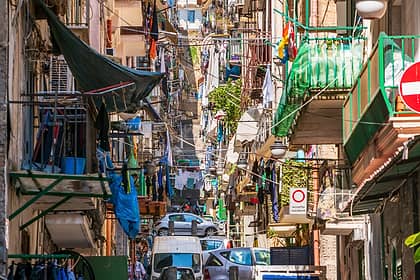
The historic center of Naples is a UNESCO World Heritage Site and one of the largest and most densely populated old towns in Europe. You can walk its entire length along the lively Spaccanapoli thoroughfare that cuts through its heart, dividing the old town in two, and Via San Gregorio Armeno , famously lined with artisan workshops that produce the city’s traditional “presepe” (nativity scenes). Stop in Piazza San Domenico Maggiore or Piazza del Gesù Nuovo for a bracing espresso, a sweet sfogliatella, or one of the city’s many street-food delicacies ! Just outside the district known as the Decumani, step onto Via Toledo , the busiest shopping street in Naples that leads to Piazza Plebiscito, Galleria Umberto I, and the San Carlo opera house; the narrow side streets that climb the hillside above Via Toledo lead to the gritty yet atmospheric Quartieri Spagnoli (Spanish Quarters).
While exploring the historic center, make sure you find time to explore its top three attractions: Naples Underground; the “Veiled Christ” in the Sansevero Chapel, and the Cloister of Saint Claire.
Authentic Neapolitan Pizza Naples is the birthplace of pizza, so there’s no better place to feast on the best pizza in the world than in one of the many landmark pizzerias in the historic center. The most famous are Sorbillo and da Michele, but there are endless options for sampling unforgettable “pizza napolitana”!
2. Naples Underground

Hidden beneath the modern streets of Naples hides another historic city: Naples Underground (Naples Underground), a network of ancient tunnels, chambers, and passageways that run under the historic center. One of the largest and most complete underground urban areas in the world, Napoli Sotteranea includes more than 40 miles of tunnels. The network was created by the ancient Greeks to extract stone to use as building materials as the city grew, but was expanded by the Romans and later by the Bourbons to be used as an aqueduct to bring water to the city’s residents. The area was later expanded to include storage rooms, escape routes, and even a bomb shelter. Join a guided tour of Underground Naples to explore the tunnels by candlelight. The entrance is located along Via dei Tribunali in Piazza San Gaetano. Visit Naples Underground
3. The Veiled Christ (Sansevero Chapel)

While exploring the historic center of Naples, be sure to schedule in time to stop at the Chapel of Sansevero to marvel at the Veiled Christ . This marble statue by the Italian artist Giuseppe Sanmartino is considered one of the great masterpieces of 18th-century neoclassical sculpture and depicts Christ wrapped in a shroud, with his face hidden from view. The work was commissioned by the Duke of San Severo, an alchemist from the 1700s, and will stop you in your tracks with its otherworldly detail and realism. The chapel holds a second famous Sanmartino sculpture, the Anatomical Mannequin, a model of the inside of a human body believed to represent the Duke's murdered brother. The Sansevero Chapel: Opening Hours and Information
4. Santa Chiara Monastery
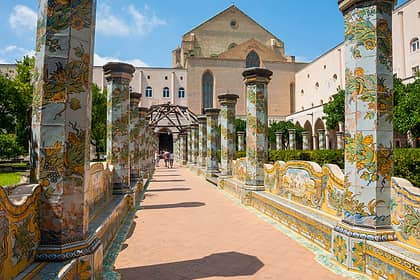
The Monastery of Santa Chiara (Complesso Monumentale di Santa Chiara) is a peaceful retreat from the bustling city of Naples. This gothic monastery was founded in 1313 and quickly became an important center of culture and learning; today its museum houses an impressive collection of 14th-century art and artifacts. Explore the museum, library with over 30,000 volumes, and the picturesque cloister gardens, completely decorated in ornate hand-painted majolica tiles and benches.
5. The Royal Palace of Naples and Piazza Plebiscito
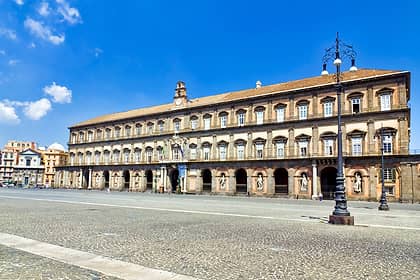
The Royal Palace (Palazzo Reale) and adjacent Piazza del Plebiscito are two of the most recognized landmarks in Naples. The Palazzo Reale was the largest building in Europe when it was built in the 17th century and remains the largest palace in Italy , home to numerous important works of art. Piazza Plebiscito is one of Naples’ main squares of Naples; it was here that a vote was taken in 1860 that led to the country’s unification, a historic event for which the square is named. This symbol of Naples often plays backdrop to concerts and major events. Visit the Royal Palace in Naples
From Piazza del Plebiscito, stroll along Via Chiaia to Piazza dei Martiri, one of the city’s most beloved public spaces, lined with cafés. Continue on along the seafront promenade, another symbol of Naples and a popular spot for an evening stroll.
6. Castel dell’Ovo
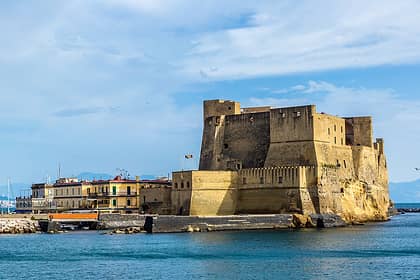
The postcard-perfect Castle dell’Ovo is perhaps one of the most photographed sights in Naples. Perched on an islet just off the city’s coast (and connected by a bridge), this castle is the subject of a colorful legend: it is said that the poet Virgil ordered that an egg should be placed beneath the castle foundations to symbolize its strength. True or not, Castel dell'Ovo has withstood centuries of wars and earthquakes and is open to the public for guided tours and temporary exhibitions.
After taking in Castel dell’Ovo, stop for a heaping plate of spaghetti con le vongole at one of the traditional seafood trattorias in Borgo Marinari (the hamlet set just below the castle). Afterwards, burn off your carbs with a walk along the charming Via Caracciolo to admire the sweeping views over the Gulf of Naples.
7. Capodimonte Museum

One of the top museums in all of Italy, Capodimonte occupies an immense 18th-century palace built by Charles III, Duke of Bourbon and houses a vast collection of Renaissance paintings, porcelains, and sculptures. Admire works by Caravaggio, Rubens, Titian, Rembrandt, and Raphael before heading outside to stroll through the garden with spectacular views of Naples from above. Visit the Capodimonte Museum
8. Catacombs

Among the city’s most fascinating sights, the catacombs of Naples are a network of ancient underground tunnels and chambers that were once used as burial sites. There are three main catacombs open to visitors in Naples: San Gennaro; San Gaudioso; and the Fontanelle Cemetery.
- The Catacombs of San Gennaro are the largest and most popular catacombs, named for San Gennaro, the patron saint of Naples who was initially buried here (today the remains of the saint are housed in the city’s 13th-century Duomo ). These catacombs date back to the third century AD.
- The catacombs of San Gaudioso were dug in the 5th century AD and are named after San Gaudioso, the first bishop of Naples. The catacombs contain the remains of over 20,000 people, as well as many interesting works of art and architectural features.
- The Fontanelle Cemetery is a much more recent burial site, built in 1656 to house the remains of the victims of plagues and wars. Today it contains the remains of about 40,000 Neapolitans.
9. The Naples National Archaeological Museum (MANN)
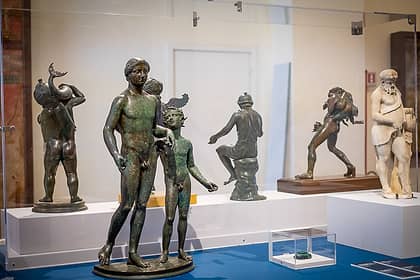
The National Archaeological Museum of Naples (also known as MANN) contains one of the world’s most important collections of ancient Greek and Roman artifacts, including thousands of pieces unearthed during excavations of the ancient city of Pompeii and other nearby ancient sites, plus a number of important Egyptian artifacts. With over 20,000 pieces displayed, a visit here is a must-see for history buffs. Visit the Archaeological Museum of Naples
10. Mount Vesuvius
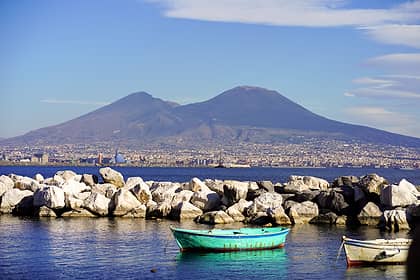
The rumbling form of Mt. Vesuvius looms over Naples, a symbol of the city’s past and present and the only active volcano on the European mainland (Vesuvius last erupted in 1944). Venture to its volcanic peak for endless views over the Bay of Naples and a peak inside its massive steaming crater; you can visit on your own or join a group tour from Naples. Visit the top of Mt. Vesuvius
Bonus: Pompeii

Almost everyone who visits Naples takes a day trip to explore the ancient city of Pompeii. Set at the foot of Mt. Vesuvius, this lively Roman city was buried by a massive volcanic eruption in 79 AD, freezing it in time and offering visitors today a unique glimpse of daily life during the Roman Empire. There are a number of perfectly preserved villas, shops, theaters, temples, baths, and other structures, many of which still sport their original frescoes, mosaics, and other decorations. Be sure to check out the Forum, the city's main square, and the House of the Faun, one of Pompeii’s largest and most luxurious villas. Visit the excavations-of-Pompeii from Naples
Visiting the Ruins of Herculaneum If you love ancient history, you can also visit the ruins of the Roman city of Herculaneum. This site is also an excellent option if you have limited time as it is much smaller than Pompeii (though equally fascinating) and takes just a couple of hours to visit rather than a full day. Visit Herculaneum
How to Get Around Naples
Though Naples is a large city that is quite spread out, the first attractions listed here are all within walking distance if you are staying in the center of Naples. To visit Pompeii, take the Circumvesuviana train ; for Mt. Vesuvius you’ll need to drive or take the Circumvesuviana plus a bus. To move between different neighborhoods in Naples, the subway is the best option; a number of major stations (most notably Piazza Dante and Toledo) are also showcases of contemporary art. To reach neighborhoods and attractions in the hills above the city like Vomero and Castel Sant’Elmo, hop on the scenic funicular. Ferries for the island of Capri , Ischia , Procida , and Sorrento regularly depart from the Naples port How to get around Naples
Now that you have an idea of what you may want to see while visiting Naples, take a look at our step-by-step itineraries. These cover a sightseeing day trip (from Rome, Positano, or other Italian cities in Campania) or a longer stay:
- Naples in One Day
- Naples in Three Days
FAQ - Frequently asked questions
Is naples dangerous.
Naples is no more or less dangerous than other major Italian and European cities. Use the normal amount of caution when visiting (like avoid wearing expensive jewelry and watches and keep a close eye on bags and wallets) to guard against petty crime; violent crime against tourists is very rare. There aren't any particular neighborhoods to avoid in Naples, though you should take care around the train station and Piazza Garibaldi at night. Even the Quartieri Spagnoli, once known as Naples's grittiest district, is now full of tourists and safe to visit.
Which is the best area to stay in Naples?
The entire historic center and area around Via Toledo are ideal as a base for exploring Naples on foot. For more information, read our post here: Where to Stay in Naples
What should I buy in Naples?
The city has fabulous artisan crafts and delicious gourmet delicacies. Read more here: Top 10 Souvenirs from Naples .
When is the best time of year to visit Naples?
The best months to visit Naples are April and May or September and October. The Christmas season is also a fantastic time to experience the holiday atmosphere: The Best Time of Year to Visit Naples

From its charming waterfront under the shadow of Vesuvius, to its beautiful and bustling historic centre: Naples is a stunning city
Its position as a meeting place for various peoples since ancient times has had a profound impact on Naples, making it a cultural hub. This is evident when walking through its streets, full of artistic and architectural treasures. It is a city with a unique magic, blossoming with natural attractions. From amazing food to all kinds of entertainment, you will never be bored.
What to see in Naples
- Must-see places
- Surroundings
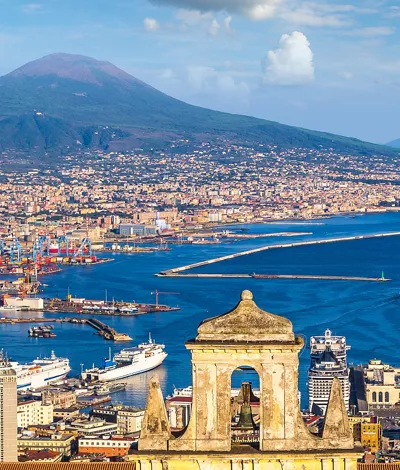
2 days in Naples: the itinerary
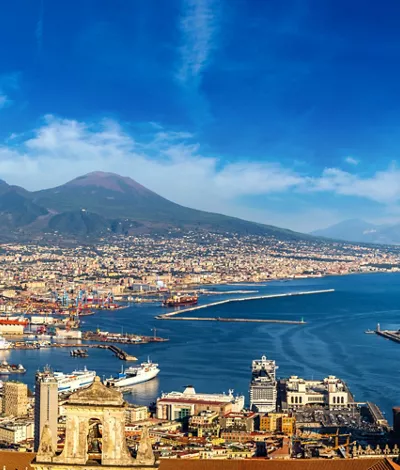
A 10.000-step itinerary around the centre of Naples
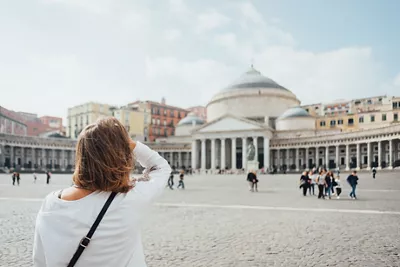
The enchanting historic centre of Naples UNESCO World Heritage Site
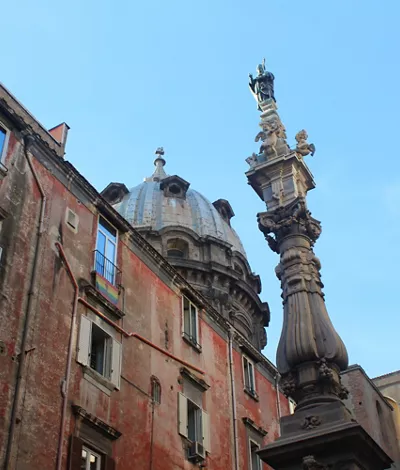
In Naples for the Feast of San Gennaro: between tradition and spirituality

Street food in Naples is the quintessence of wonders for the palate
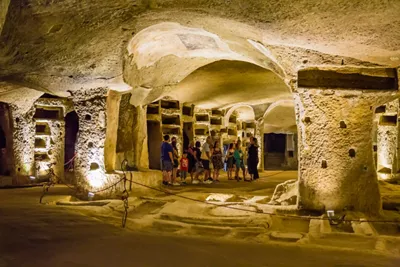
The Catacombs of Naples
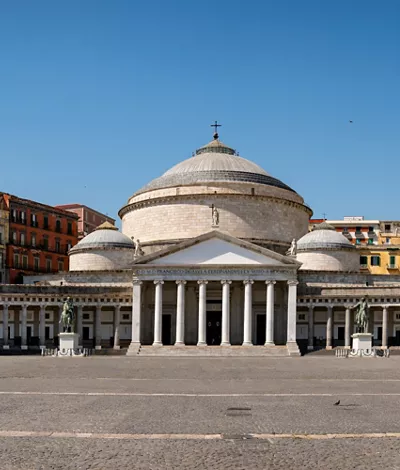
Piazza del Plebiscito
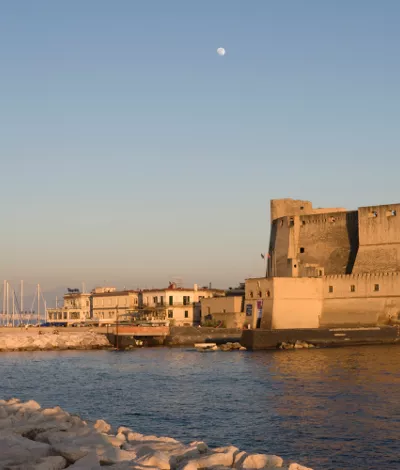
Castel dell'Ovo
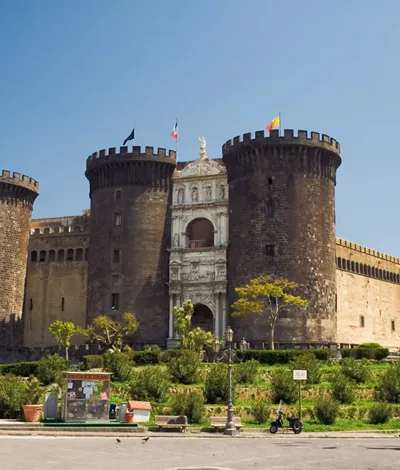
Castel Nuovo or Maschio Angioino

San Gregorio Armeno
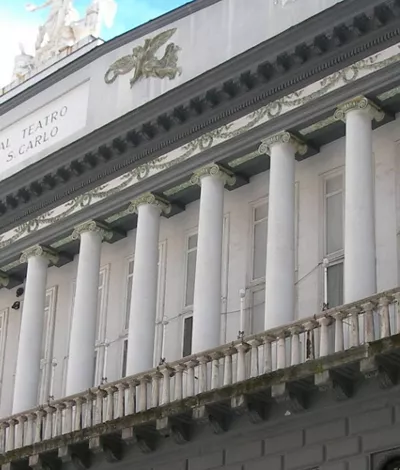
San Carlo Theatre
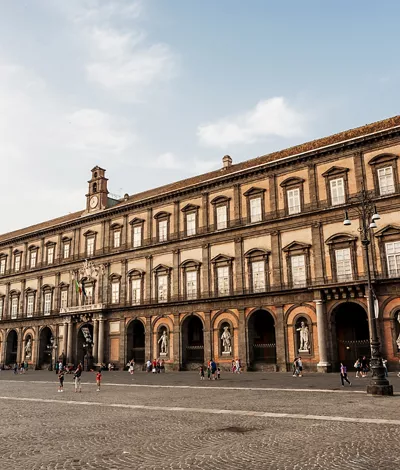
Royal Palace of Naples
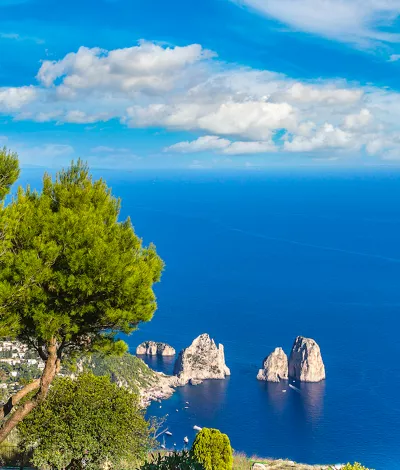
Ischia, Capri and Procida

Reggia di Caserta
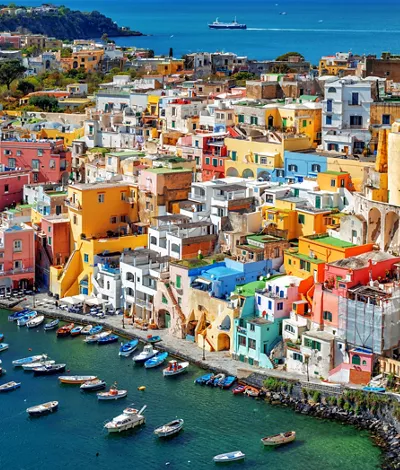
Procida: the enchanted island of watercolour houses and turquoise sea

The Sorrento peninsula: emerald green waters and the scent of lemons
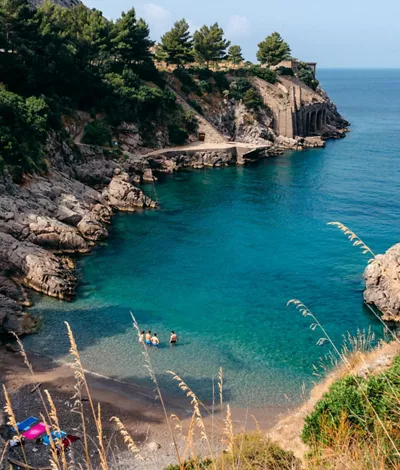
10 pristine beaches not to be missed while visiting the Sorrento Peninsula
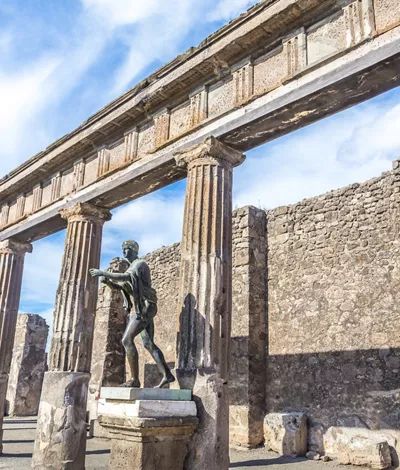
Discovering the archaeological area of Pompeii, Herculaneum and Torre Annunziata
An enchanting city of sea and culture.
Naples not only welcomes, but literally embraces all who visit: it is well-known for its warmth, not only in terms of the weather. Overlooking the sea and with Vesuvius in the background, Campania's capital city has a colourful centuries-old history, with countless monuments to admire. There is even plenty to explore underground, with organised tours of the labyrinth of tunnels that lie below the city. The gastronomic tourism here is unrivalled: ready to try the best pizza in the world?
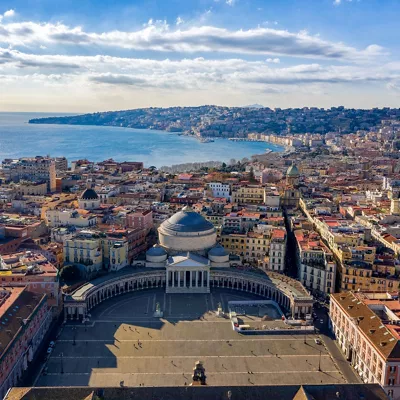
From its charming waterfront under the shadow of Vesuvius, to its beautiful and bustling historic centre: Naples is a stunning city. Its position as a meeting place for various peoples since ancient times has had a profound impact on Naples, making it a cultural hub. This is evident when walking through its streets, full of artistic and architectural treasures. It is a city with a unique magic, blossoming with natural attractions. From amazing food to all kinds of entertainment, you will never be bored.
The story of this city in Campania, for many centuries comparable to numerous other medieval towns perched on Apennine elevations, took an important turn in 1752. A huge level area at the foot of the village of Casertavecchia was acquired that year by the king of Naples, Charles of Bourbon. The king intended to make this splendid rural location the seat of his main residence, building a large royal palace and huge, luxuriant gardens. These are the origins of the impressive cultural site that we know today as theRoyal Palace of Caserta. Present-day Caserta, now an important provincial capital, then developed around this architectural masterpiece, which is protected by UNESCO. Between the 18th and 19th centuries in particular, Caserta was enriched by lavish bourgeois buildings, pleasant avenues, monumental squares and a majestic cathedral . Just to the north of the historic centre, high above the city, are two other locations worthy of a leisurely visit. On one side is the complex of San Leucio, the unfinished industrial dream of Ferdinand IV of Bourbon. Just a little further east can still be seen the original core of Caserta, Casertavecchia, which may have lost its historical importance over the centuries but still surprises visitors who climb its narrow streets in search of artistic and cultural treasures.
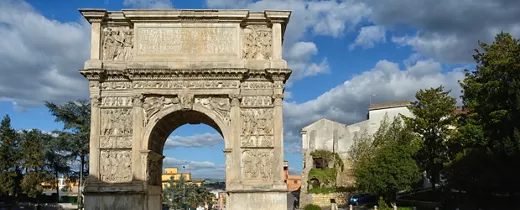
Benevento is a beautiful but complex city, founded thousands of years ago in the hinterland of what is now the region of Campania, more than 60 km from Naples. Nowadays, all things considered, from most parts of Italy it is easier to get to the reserve by high-speed train than by plane or motorway. If you're looking for answers about the complex configuration of the city, with all its narrow alleys, irregularly-shaped squares, Roman stones and Baroque palaces built over the centuries - then the best place to start is the Sannio Museum, which traces an outline of the region's history. But if that sounds a bit full-on, why not enjoy a stroll around the streets first, before entering the museum. One of the most popular places for a peaceful stroll is Corso Garibaldi, a large and much-loved main street which certainly has its fair share of shops, the church of St Sophia in the centre, the Rocca dei Rectori at the end of the street and the Arch of Trajan at the end of a short side street. But perhaps the town's pride and joy is Caffè Strega. Inside, the walls are adorned with posters of ladies in flowing garments (perhaps witches?), there are tables for chatting or even studying (Benevento is also an important university town), as well as rows of the town's famous liqueur. There is more, of course: the Duomo itself, or the modern art installation by Mimmo Paladino, near the Sannio Museum. Another point to note is that according to legend, Benevento was founded by a Greek, Diomedes, a wandering veteran of the Trojan War. But let's not go over the top. Sleeping dogs (and Greek heroes) are best left to lie!
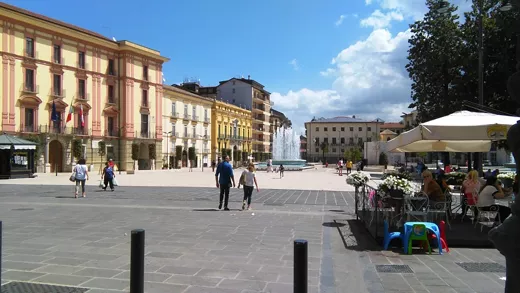
Nature, art and faith in green Irpinia In the pristine nature of Irpinia, tranquillity, beauty and itineraries intertwine, between art, faith and nature. The Avellino basin is framed by the Monti Picentini mountains and dotted with castles, abbeys and villages to explore, including the beautiful village of Monteverde. The Serino forests are the perfect backdrop for a picnic. Nature lovers can immerse themselves in the Lake Conza Oasis, explore Caliendo Cave or be enchanted by the Calabritto Waterfalls. In Avellino, you can admire Piazza della Libertà, with the Bishop’s Palace, and discover the 36-metre-high Clock Tower and the majestic cathedral dedicated to St Mary of the Assumption and St Modestinus. Foodwise, you can enjoy gnocchi, bean and chestnut soup, caciocavallo cheese, stuffed peppers and local wines: Taurasi, Greco di Tufo and Fiano di Avellino. The heart of religious tourism in the area is the Montevergine Sanctuary, a monastic complex built in 1126 at an altitude of 1,270 metres. It is accessible on foot from Ospedaletto d’Alpinolo or by cable car from Mercogliano. Another splendid monastic complex is the Abbey of San Guglielmo al Goleto in Sant’Angelo dei Lombardi. Towering over the valleys, the Lombard-built castle of Avella and the Norman Castle of Ariano Irpino offer an insight into the past. The medieval castle of Rocca San Felice is associated with the legend of Margaret of Austria’s ghost, which roams there under a full moon.
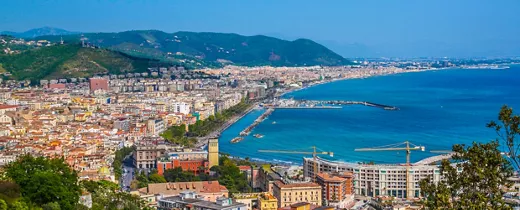
Nature and history nestled between the sea and the mountains Overlooking the Tyrrhenian Sea, the province of Salerno boasts some of the most popular and visited tourist destinations in Italy. The historical centre of the capital, restored after the damage caused by the 1980 earthquake, preserves its original medieval structure intact, the best example of which is the Cathedral, built by the Norman prince Robert Guiscard. Stop, too, at the Church of the Annunziata with its beautiful Baroque bell tower, the Arechi Castle, the Church of S. Pietro a Corte and Piazza Flavio Gioia, known as the Rotonda because of its characteristic shape on which Porta Nova opens,monumental gateway rebuilt in the 18th century. There is no shortage of green spaces in the city, such as the Mercatello park, the Pinocchio park for children and the Minerva Gardens. The Salerno coast is dotted with unmissable villages. Amalfi, Positano, Maiori and Minori, Vietri sul Mare are just some of the towns where you can enjoy clear sea, breathtaking views and culinary delights. A compulsory stop at the archaeological area of Paestum to discover the majestic Greek temples, perfectly preserved. Trekking and nature lovers cannot fail to be enchanted by the Path of the Gods a scenic route from Agerola to Positano, and the natural beauty of the Cilento National Park, Vallo di Diano e Alburni.

Continue living like an Italian
Subscribe to the Newsletter so as not to miss places, events and experiences for experiencing the best side of Italy: the authentic one.
Keep up to date
Would you like to learn about the most authentic experiences to be had in Italy, stay up to date on the most interesting events, discover our special offers and receive lots of insider hints and tips?
Save your favorite places
Create an account or log in to save your wishlist
Do you already have an account? Sign in

Ultimate Travel Guide for Naples, Italy
Are you planning a trip to naples – italy’s city of pizza, volcanoes, and nativity scenes.
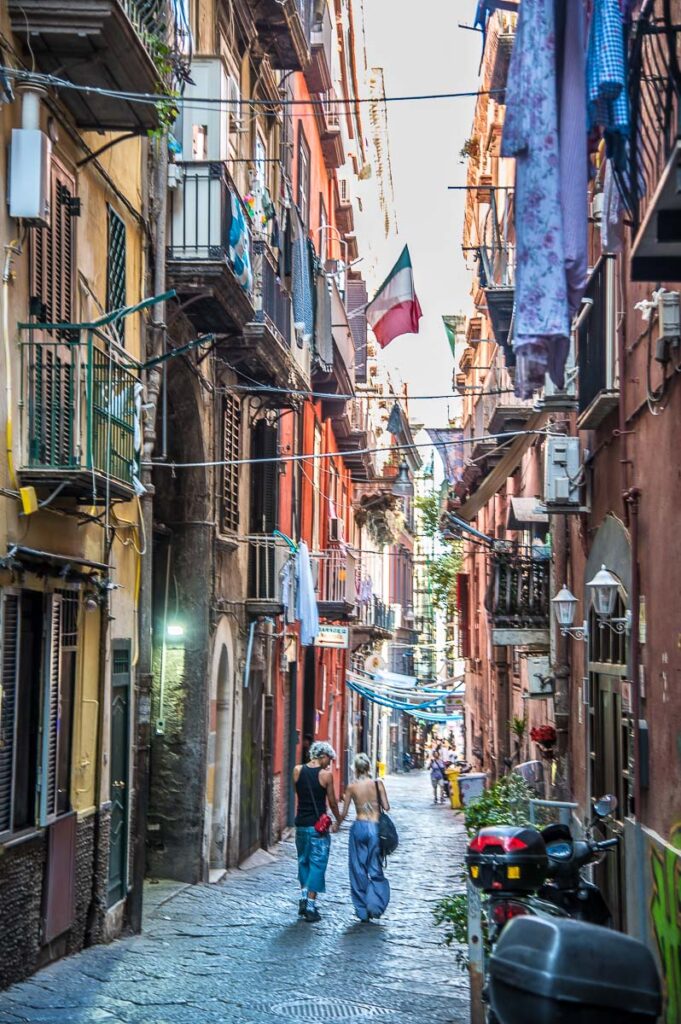
This is my ultimate travel guide for Naples or Napoli , as the city is called in Italian. It’s designed to make your travel planning easy, logical, and enjoyable. It will also help you experience the largest city in Southern Italy in the most authentic way.
Built on a caldera and with a heart as passionate as a volcano, Naples is a vibrant, stimulating place where you can rediscover the joy of life. Good food, strong coffee , excellent art, and quaint experiences are easy to come across here and even a simple thing like the abundance of vibrant colours and the buzzing hubbub of Neapolitan daily life can make you feel alive inside.
Yet, Naples is also one of the most polarising cities in the world. Travellers either sing its praises or don’t spare negative words. Densely built, Naples is a maze of streets many of which can trace their outlines to the city’s ancient Greek urban plan.
Exhilarating and overwhelming in equal measures and often at the same time, the city has been growing with an unstoppable verve for almost three millennia. The result is an immense metropolis that spans the picturesque Gulf of Naples, shoulders the iconic Mount Vesuvius and buzzes with the voices of the million people who call it home.
This is a place that over the centuries has accumulated a staggering collection of architecture and art. They reflect both ancient local traditions and a wide array of outside influences on account of the many foreign rulers that Naples has had. This makes it both Italy’s most international city and the Italian city with the strongest identity.
Naples’ churches, palaces, artisan workshops, and streets tell many captivating stories. You just need to have the ear to listen and the eye to perceive them beyond the graffiti-covered facades, the economic difficulties, and the rubbish bags that pile up on street corners every night.
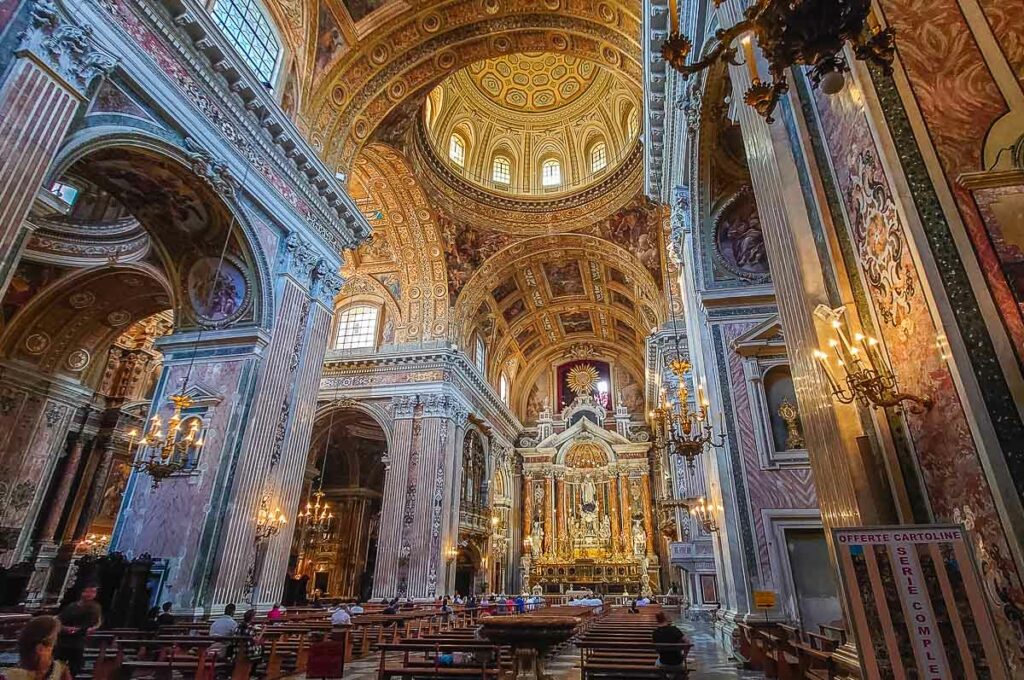
The financial distress that the city experiences obviously puts some travellers off Naples for life. That’s a real shame! For this is a raw and real place, far from the polished images that social media deals with, and yet full of energy and with hidden depths.
Take Naples at face value and you will see that while it’s not picture-perfect, it influences us on many levels. Over the last three millennia, the city has originated fables, movements, and trends time and time again. Its heritage speaks volumes. To see and experience everything that Naples has to offer – from ancient ruins and modern art to food and coffee rituals – would take a lifetime.
In other words, more than a city, more than a destination to visit as a tourist, Naples is a state of mind. As such, come here with an open heart and ready to discover things about history, art, beliefs, gastronomy, and yourself that may push your limitations beyond your comfort zone.
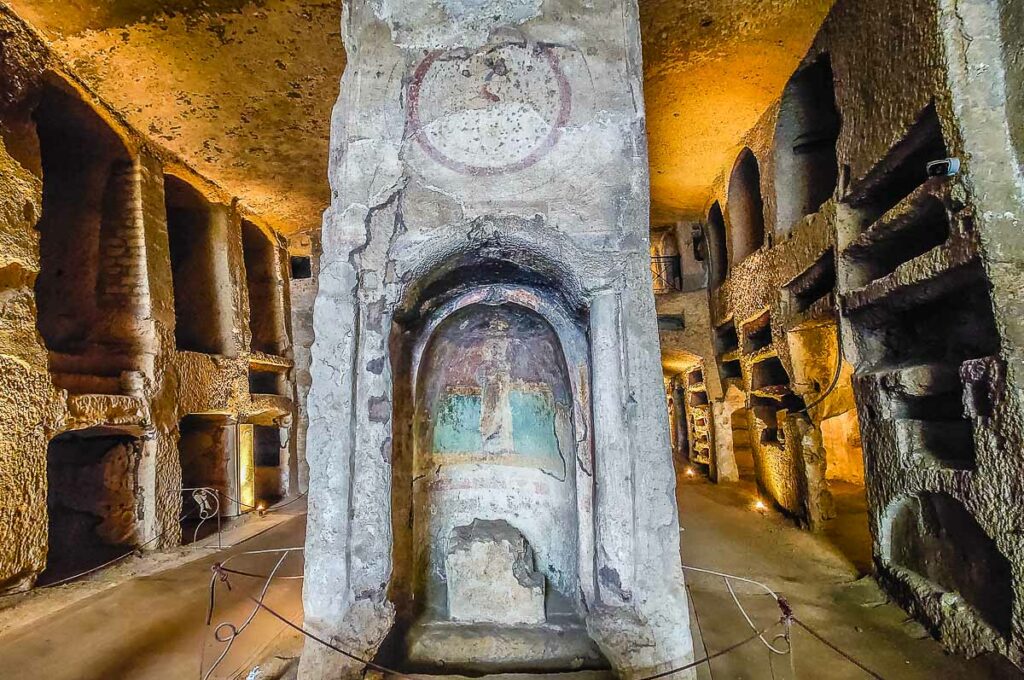
So, to help you plan your trip to Naples, I have researched, photographed, and written this ultimate travel guide. Scroll down and browse through its sections. All the usual topics like how to get to Naples, where to stay in Naples, what to eat in Naples, and what are the best things to do in Naples are covered.
In addition, you will find my answers to many more pertinent and curious questions. For example:
- Is Naples safe?
- Where to see the best presepi in Naples?
- How to explore Naples with kids?
- What are some hidden gems to discover in Naples and what day trips to take nearby?
I have included maps, lots of practical details, and numerous real-life photos to give you an idea of what to expect. You will also find the best times to visit Naples, tips for navigating this traffic-heavy city, and practical packing suggestions. These are followed by the best guidebooks and books for Naples, the best tours you can take here, as well as a list of the artisan Neapolitan products to shop for.
Scroll down to the end of this guide to see my top five tips for visiting this stimulating on so many levels city in Southern Italy. Finally, read the five things you should never do in Naples. They are always good to keep in mind!
Have a look and enjoy your Naples trip!
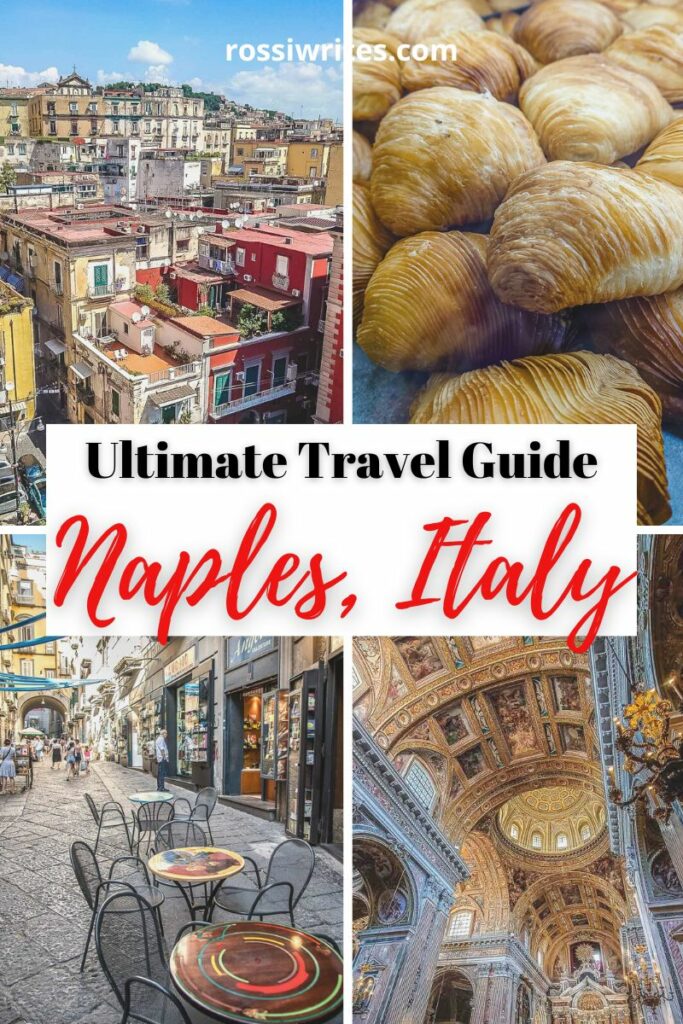
The information in this travel guide reflects my first-hand experience. It may contain affiliate links and if you click and make a purchase through them, I may receive a small commission at no cost to you. The ads on this page help me keep this blog free and produce new travel content for you to enjoy. Full details in my Disclosure .
WHERE IS NAPLES?
Naples is the largest city in Southern Italy and the capital of the Italian region of Campania. With just under a million people living here, it is the country’s third-largest city after Rome and Milan .
It lies along the Gulf of Naples – a 15-km wide bay along the southwestern coast of Italy. The densely built-up city sprawls from the supervolcanic area of the Phlegraean Fields ( Campi Flegrei ) to the iconic Mount Vesuvius.
The adjacent map shows you the city’s exact location in Southern Italy. You can click on it to zoom in and out in order to see further details.
Naples ranks among the ten most visited cities in Italy. It attracts just over a third of the number of tourists that head to the country’s most popular destination – Venice .
The city has an incredibly rich offering in terms of historic and artistic heritage. Its gastronomic traditions are at the basis of several worldwide famous and beloved dishes topped by pizza.
Naples is a must-see place in itself. It also offers quick and easy access by road, sea, and railway to several other popular destinations in Italy. From the historic ruins of Herculaneum, Pompei, Pozzuoli, Capua, and Paestum to the picturesque coastal towns of Amalfi, Positano, and Ravello, Naples is the starting point for many exciting and enriching trips in Italy. A ferry ride from Naples away, you can also visit the beautiful islands of Capri, Ischia, and Procida.
IS NAPLES WORTH A VISIT?
The short answer is yes, Naples is very much worth a visit. Almost three millennia old, the largest city in Southern Italy is a vibrant stimulating place dotted with iconic must-see sights and offering the best cuisine this side of Europe.
Hugging the curve of the Gulf of Naples and sprawling in the shadow of the infamous Mount Vesuvius, this city has a passionate character marked by sharp contrasts.
Built on several layers – from ancient catacombs to multi-storey Baroque palaces and modern-day skyscrapers, in Naples, the past, the present, and the future blend into an exciting synthesis.
This is a city where you can walk along streets which follow the outline of ancient Greek and Roman roads, where deeply entrenched superstitions and folk traditions mingle with the most heartfelt Catholic faith, and where dishes made of simple seasonal foodstuffs have been elevated to nourishment for the soul.
Naples is also a place where poverty exists right next to the most splendid pinnacles of European architecture and art; where people ride pillion with no helmets on (and sometimes have their dog on the scooter, too); where the crowds, the smells, the colours, the graffiti, and the constant play of shadows and light in large courtyards and narrow streets make you suddenly feel reenergised, full of purpose, and ready to live your most exciting life.
Yes, Naples is worth a visit as here you never know what to expect next. Around every corner, there is a new surprise. It could be the Immacolata Obelisk which, they say, at sunset reveals Death holding a sickle. Or it could be the Sanfelice Palace that seems plucked out of an Escher’s print.
In fact, Naples is worth numerous visits as there is always something new to see and experience here, a new wave of excitement to wash all over you. It is one of those precious places that make travelling an adventure that you’ll remember and recall with love and passion when the humdrum of daily life gets too much.
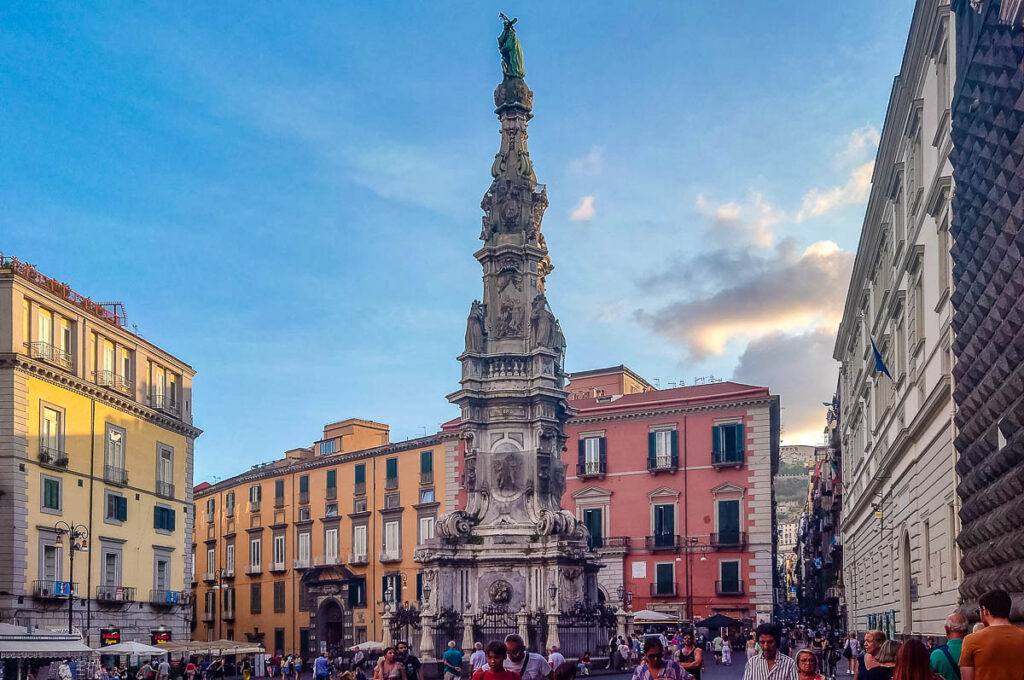
WHAT IS NAPLES CALLED IN ITALIAN?
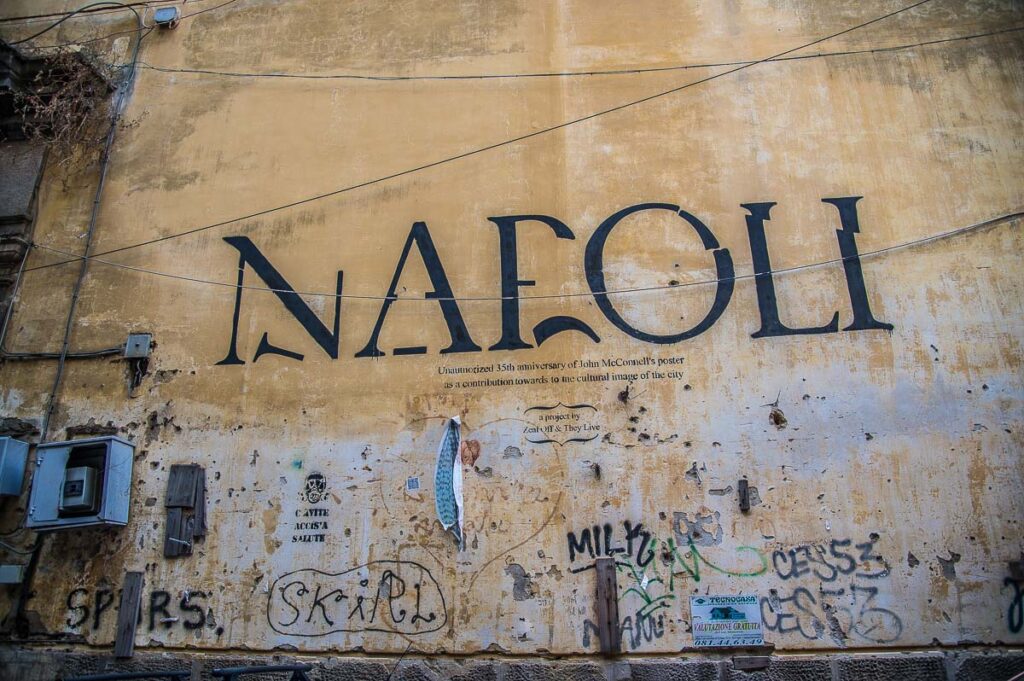
In Italian, Naples is known as Napoli . In the Neapolitan language , the city is called Napule . In both cases, the accent falls on the first syllable. Both Napoli and Napule have evolved from the Ancient Greek name of the city – Neapolis, meaning ‘New City’.
Naples is also sometimes referred to as the città dalle 500 cupole , or the City of 500 domes in English, on account of the large number of churches dotted along its streets. Another of Naples’ monikers – città dei sette castelli – is also linked to its architectural heritage. The locals claim that theirs is the only city with seven castles in the world.
La città obliqua is a poetic reference to Naples, too. It comes from a famous song by the singer-songwriter Edoardo Bennato who was inspired by the unique Neapolitan landscape – neither entirely horizontal nor fully hillside. And so he sings:
It’s not flat, it’s not vertical it is a line that goes up the hill it is a road that starts from the sea The path of the oblique city.
More often than not, however, you will hear napoletani refer to themselves as partenopei and to their city as the città partenopea or the Parthenopean City. This is based on the foundation myth of Naples which is linked to the siren Parthenope – a mythical creature with a bird’s body and woman’s head.
Parthenope had a beautiful voice. Sailors were so bewitched by her singing that they would forget to steer their ships which would then crash against the rocky shore of what nowadays is known as the Sorrento Peninsula.
To avoid a similar fate, the Greek hero Ulysses made his men plug their ears with wax and bind him to the mast of his ship. This way, he could enjoy the siren’s song without sacrificing his ship and his crew.
Unable to make Ulysses fall in love with her and thus lure him to his death, Parthenope threw herself off the rocks. Her body washed on the island of Megaride where the local people found it and buried it. A settlement carrying the siren’s name quickly grew around her burial site. It was also known as Palaepolis (Old City) as around 470 BC, Neapolis (New City) was founded right next to it by Greek settlers.
Nowadays, Naples has expanded significantly beyond the limits of the original Palaepolis and Neapolis. The island of Megaride, today is a peninsula in the Gulf of Naples and houses the city’s oldest fortress – Castel dell’Ovo .
Finally, as you saw at the start of this Naples travel guide, I called it the City of Pizza, Volcanoes, and Nativity Scenes. The first is self-explanatory as the pizza napoletana is famous all over the world (especially the Naples-born pizza Margherita prepared with tomato sauce, mozzarella cheese, and basil leaves). With the volcanoes of the Phlegraean Fields and Mount Vesuvius playing a major role in the geology and the history of the area, the second part of the moniker is also clear.
As for Nativity scenes, Naples is famous for its tradition of artisan presepi . These are intricate Christmas cribs representing the Holy Family in the stables in Bethlehem. Beloved all over Italy, the best ones are handmade in Naples. I mention them in more detail below under the headings Best Presepi in Naples and What to Buy in Naples .
NAPLES AND ITS QUARTERS
Naples is a large sprawling city divided into 30 quarters. Here are the main urban areas to visit in order to see the best that it has to offer:
Centro Storico – a UNESCO World Heritage Site , Naples’ historic centre is a vast area in the heart of the city where you will find the most famous landmarks – from the Veiled Christ in the Sansevero Chapel and the tiled cloister of the Monastery of Santa Chiara to Piazza del Plebescito and the Royal Palace. Follow Spaccanapoli – the long artery of straight streets that flow one into another and in the process splits the city in two. Look out for the large obelisks dotted along its route. Stuff yourself with pizza in all its Neapolitan varieties along Via dei Tribunali . Dodge the constant traffic of scooters and evade the persistent greeters trying to get you to enter their eateries. Find temporary peace and quiet in Naples’ former water cisterns .
Rione Sanità – a former no-go area, this authentic corner of Naples is where you can visit the striking Catacombs of San Gennaro – my absolutely favourite landmark in Naples. A short walk away don’t miss the macabre Catacombs of San Gaudioso underneath the resplendent Basilica of Santa Maria della Sanità. The Palazzo dello Spagnuolo and the Palazzo Sanfelice are a must for lovers of architecture.
Quartieri Spagnoli – with a name that is a throwback to when Naples was ruled by the Spanish Bourbons, this Neapolitan quarter epitomises the city. Expect narrow streets, laundry flapping above your head, and lots of graffiti. Don’t miss the Pignasecca market – a hub of activity that is quintessential Naples.
Vomero – hop on a funicular for an exhilarating ride to the top of the Vomero hill and enjoy the unparalleled panoramas of Naples flanked by Mount Vesuvius. Then visit the proud Castel Sant’Elmo and the former monastery of Certosa di San Martino .
Chiaia – this upmarket quarter of Naples is a great place to stay in if you want to be close to the sea, the luxury boutiques, and the Villa Comunale expansive lush park.
Santa Lucia – standing right where the original settlement of Parthenope (or Palaepolis) first grew, Santa Lucia is a historic quarter of Naples where you can visit the mysterious Castel dell’Ovo , marvel at the imposing Fontana dei Giganti , and indulge in fresh seafood in the fishermen’s Borgo Marinari .
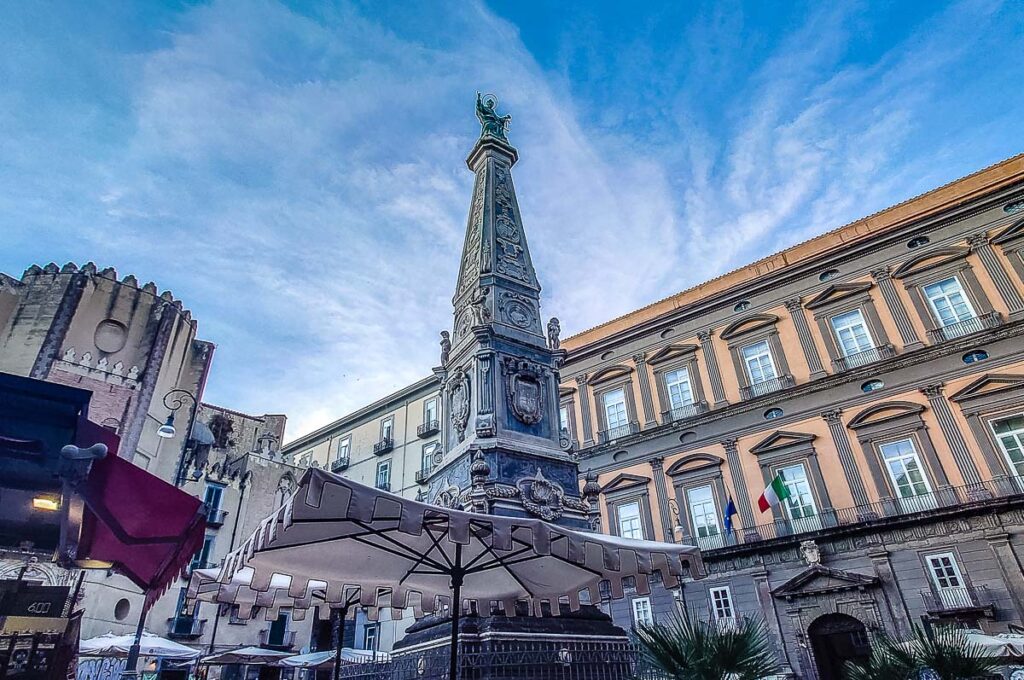
BEST AIRPORT FOR NAPLES
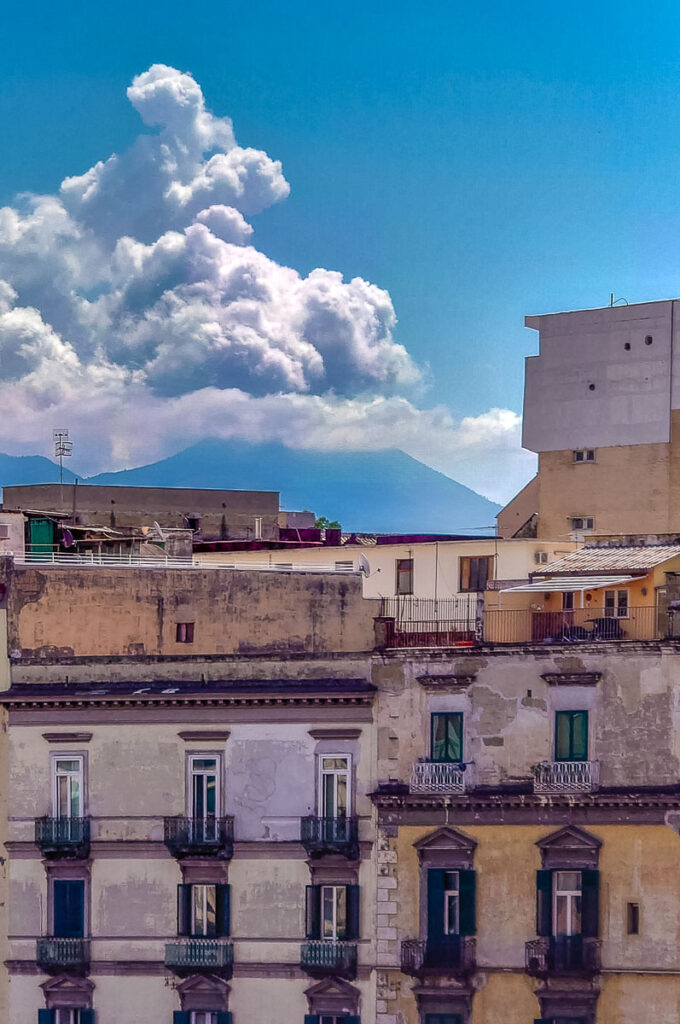
Naples has its own airport – Aeroporto Internazionale di Napoli Capodichino (IATA airport code: NAP). It is one of the busiest airports in Italy and it’s only four km away from the city centre.
It is served both by low-cost and full-service carriers, making Naples easy to reach from all corners of Europe and the world. The flight from London Gatwick, for example, is just over two and a half hours, so Naples is a great destination for a long weekend.
The official website of Naples Airport has a lot of useful information – from how to reach the airport to what shops and restaurants you will find here.
Shopping is excellent with many international chains and high fashion brands having stores here. There are also numerous eateries which is handy especially when you know that you are about to leave Naples and you want to have one last delicious pizza or sfogliatella pastry for the journey ahead.
AliBus is the coach line linking Naples Airport to the city centre. You can take it either to:
- Piazza Garibaldi – in front of the city’s main train station, Napoli Centrale ; or
- Port of Naples – a short walk away from the centrally located Piazza Municipio .
We were lucky as we were met by a friend of a friend upon our arrival in Naples. He drove us to the flat we had rented in the historic centre giving us our first taste of the famous Neapolitan driving style.
On the way back, we found getting a taxi to reach the airport from the historic centre very handy as we were lugging a heavy suitcase. The journey door to door took less than half an hour and cost us around 30 euros.
HOW TO REACH NAPLES?
Naples is very easy to reach by railway, road, and ferry from anywhere in Italy and abroad.
High-speed and regular trains connect Naples all throughout the day to many towns in the region of Campania and major cities all over Italy. You can check timetables and book your tickets on:
- Omio – which pulls up results for both state-run and private railway companies in Italy;
- TrenItalia – which covers the state-run train network of Italy.
Here are some sample travel times by high-speed train from the Italian capital and other large Italian cities to Naples’ main train station, Napoli Centrale :
- Rome to Naples – from 1 h 13 mins;
- Florence to Naples – from 3 h;
- Bologna to Naples – from 3 h 31 mins;
- Milan to Naples – from 4 h 45 mins;
- Venice to Naples – from 5 h 22 mins;
- Turin to Naples – from 6 h 3 mins.
The following ferry companies connect Naples to the nearby islands of Capri, Ischia, and Procida, the Aeolian Islands, as well as to the towns on the Amalfi Coast and further away destinations like Sicily: SNAV , Caremar , and Medmar .
You can drive to Naples from anywhere in Italy, too. Toll roads (called autostrada , sing. and autostrade , pl. in Italian) connect the city to other large Italian cities and smaller towns. Here are the autostrade you can use here:
- A1 Autostrada del Sole – Milan to Naples
- A3 – Salerno to Naples
- A16 – Canosa to Naples
- A56 Tangenziale di Napoli – this is Naples’ ring road from Arco Felice to Capodichino
This useful website will give you up-to-date information about navigating Italy’s autostrade , the current traffic conditions, as well as how to calculate and pay the toll fees (called pedaggio in Italian).
If you are planning to visit Naples by car, you need to prepare yourself mentally for the busy traffic and the assertive driving style of the city. Make sure that your car insurance covers all eventualities. Ideally, arrange for a parking space in advance. Some travellers report that in some corners of the city, you may be asked to pay an additional fee to have your car ‘looked after’.
It is also advisable to familiarise yourself with Naples’ ZTL or zones with restricted traffic which can be traversed by car only if you have a special dispensation. This website may come in useful when you look into ZTL and the respective restrictions.
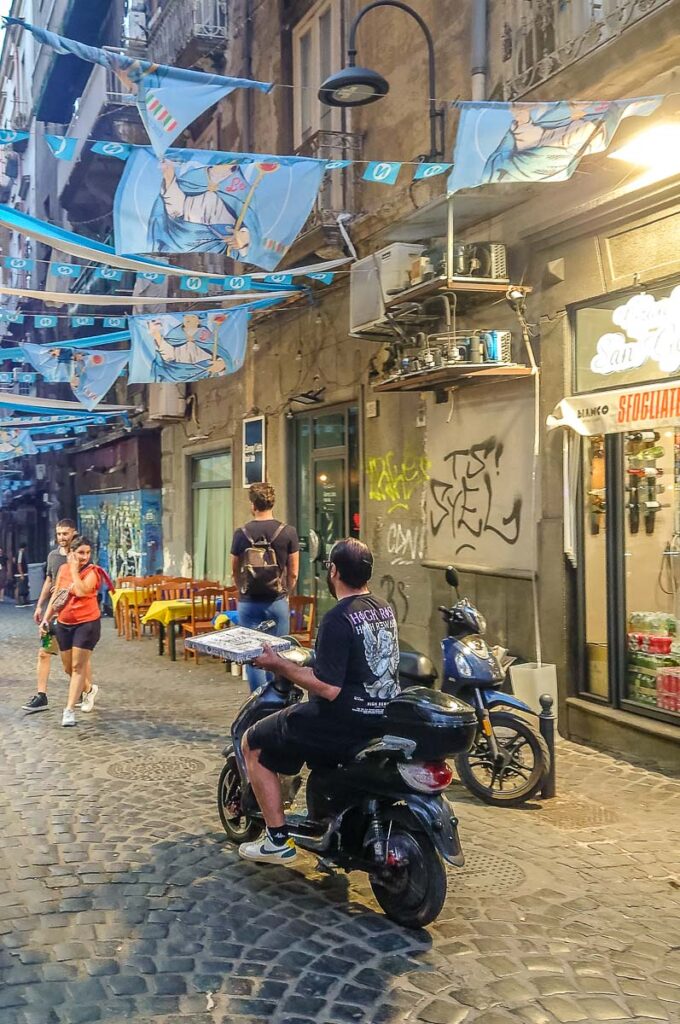
HOW TO NAVIGATE NAPLES?
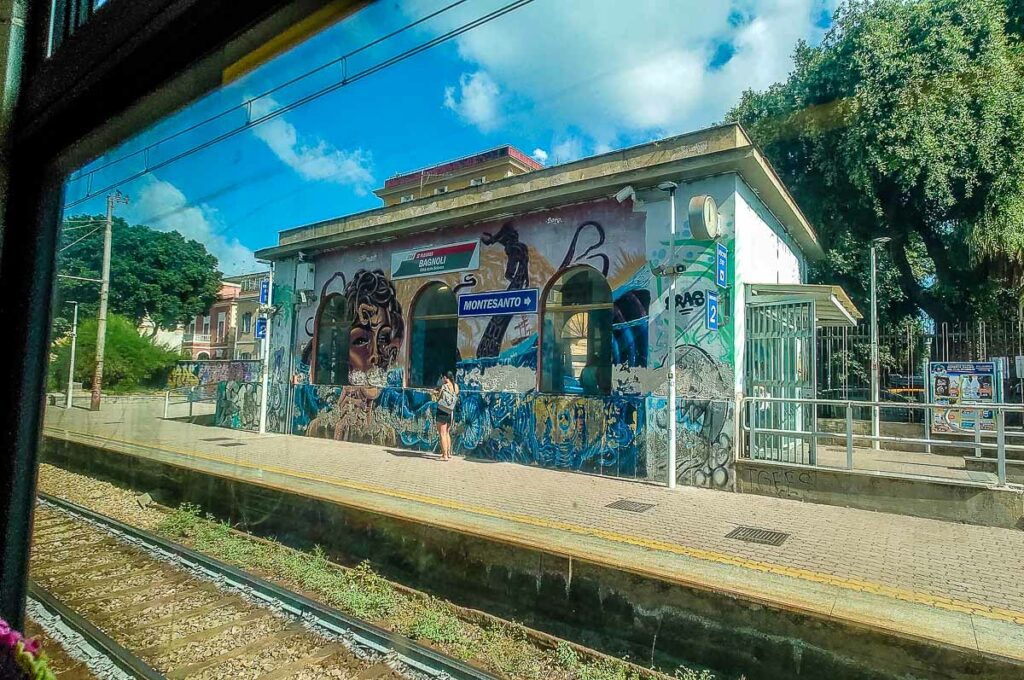
You can navigate Naples on foot as well as by bus, metro, funicular, and taxi. In some parts of the city you can get a tram and/or a trolleybus. There are also regional trains which connect Naples to several adjacent suburbs, towns, and landmarks nearby.
Naples’ historic centre and quarters are best explored on foot so that you can fully immerse yourself in their atmosphere. The narrow streets here often lack pavements and at all hours of the day experience a hectic flow of scooters, delivery vans, and cars. It pays to be vigilant at all times, especially next to turns and corners. Drivers are skilled but very impatient and expect you to move away asap. Otherwise, they keep pushing forward and whizz right past you.
Buses (as well as metro lines, trams, and trolleybuses) are very convenient if you want to save time walking from one quarter to the next. For example, we took a bus from the edge of the historic centre to the top end of Rione Sanità – a journey which took us about 15 minutes (inclusive of walking to the bus stop and time waiting for the bus) instead of the 30 minutes which walking there would have taken us.
Four funiculars connect Naples’ lower grounds to its hilly parts. They are very handy, especially on a hot day when you can’t bear to walk uphill for miles.
For up-to-date information about public transport in Naples, have a look at the official websites of Comune di Napoli and ANM – Agenzia Napoletana Mobilita . You will find exhaustive information about the different ways to travel here either by bus , funicular , metro , tram , or trolleybus , as well as about the different types of tickets and where to purchase them. At present, the websites seem to be only in Italian, so you may want to use Google Translate to get the gist of the information.
Taxis circulate through the historic quarters and can quickly take you anywhere in Naples, as well as to the nearby archaeological excavations, picturesque towns, and even Mount Vesuvius. You can download an up-to-date rate table from the official website of Comune di Napoli .
To reach the excavations of Herculaneum and Pompei by public transport, you will need to get the Circumvesuviana regional train. Use the EAV – Ente Autonomo Volturno’s website to check prices and timetables. There is a useful section in English.
To reach the towns and the archaeological parks in the Phlegraean Fields ( Campi Flegrei ), use the EAV website, too and check the timetables for the Cumana and the Circumflegrea train lines.
WHAT TO PACK FOR NAPLES?
The most important thing to pack for a visit to Naples in any season is a pair of comfortable shoes. You will be walking long distances over all types of historic surfaces many of which are uneven. You will also spend time standing up and moving at a variable pace over long periods of sightseeing.
Make sure that your feet are as comfortable as possible. Choose shoes with a good grip that cushion your heels and support your ankles at all times. Even on the hottest of days, it’s advisable to wear closed shoes or shoes that at least cover your toes, especially if you are planning to explore the historic centre, Rione Sanità , or the Quartieri Spagnoli as they are very busy and spillages next to markets and small businesses may occur.
In winter, bring warm layers to stave off the chills produced by the high levels of humidity and yet can be quickly peeled off when the sun makes an appearance. In summer, bring a hat, sunglasses, and suncream to counteract the bright sunlight that bounces off the large facades and floods the wide piazzas. Invest in fabrics that dry quickly, are crinkle-free, and let your skin breathe through them. A rainproof jacket will come in handy in autumn when rainy days are plenty.
Even when it’s very hot, make sure that your outfits are appropriate for city living and respectful sightseeing. Shoulders and knees should be covered in churches and landmarks. Swimsuits are not acceptable attire on the street.
In any case, don’t overpack as navigating Naples with heavy luggage can be difficult, especially if you are planning to use the busy public transport. Instead, select pieces that can be matched with one another, producing outfits that look different every day but rely on the same small number of core pieces.
Leave expensive and ostentatious jewellery, watches, and accessories at home. Invest in a cross-body bag with a sturdy strap. Put a bottle of hand gel in it as well as your favourite mosquito and bug repellents, albeit a spray, a roll-on or a bracelet .
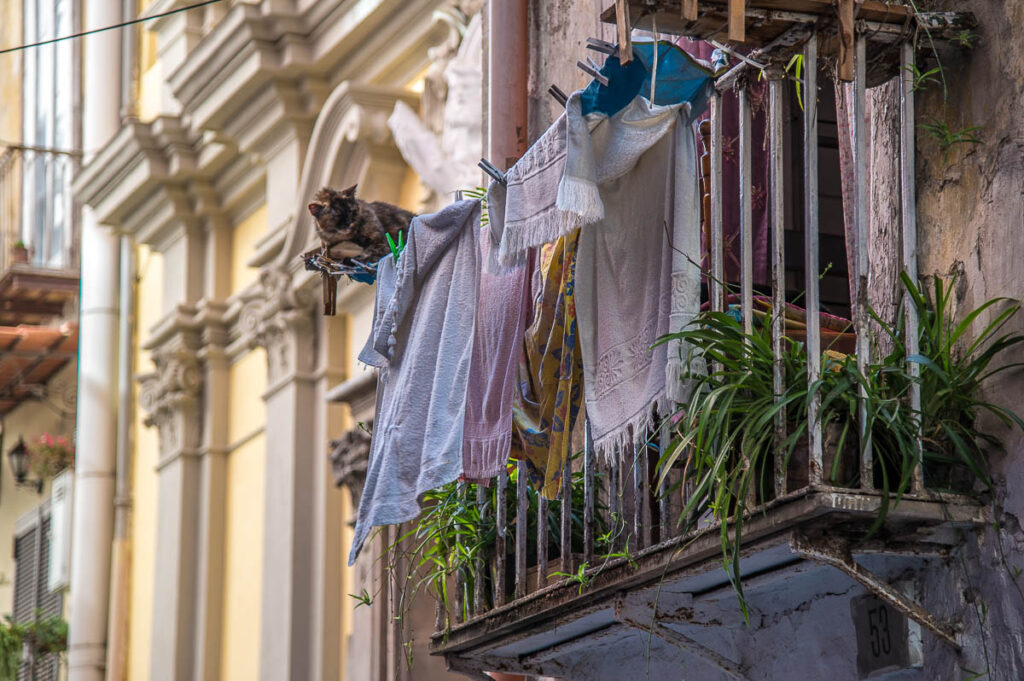
BEST TIME TO VISIT NAPLES
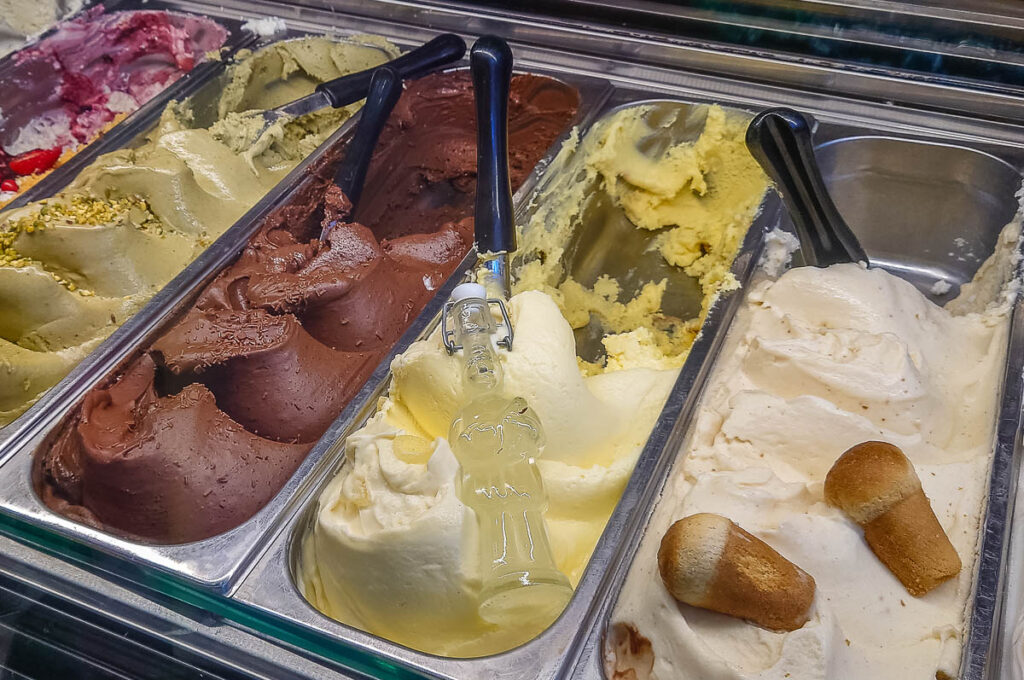
Naples is exhilarating in any season and there are lots of things to do here no matter the weather. So, visiting Naples is always a good idea – from a weekend break to a long holiday, the City of Pizza, Volcanoes, and Nativity Scenes offers an exciting immersion into the art, food, and heritage of this corner of Italy and Europe.
The shoulder season – from the end of March to May and then from the end of September to the start of November – is easily the best time of the year to visit Naples. Expect temperatures between 17 and 27 degrees Celsius and some rainy days but mainly clear skies.
Summers are hot and humid. With temperatures between 30 and 40 degrees Celsius, you will need to pace your sightseeing as being out and about in the throng of tourists and locals can quickly become tiring and overwhelming.
At the same time, summer is when Naples is full of vibrancy and life, so take long gelato breaks, linger over lunch, and commit to no more than two major sights a day (and a couple of smaller ones) to make the most of the sunny days and people-watching. If possible, return to your accommodation in the afternoon for a sweet little nap which will give you strength for a leisurely stroll (called passeggiata in Italian) in the early evening followed by a proper Neapolitan supper.
Winters in Naples are mild in comparison with most of Europe. The thermometer can go as high as 16 degrees Celsius. While this is not sunbathing weather it’s still a welcome escape from the minus temperatures in the northern European destinations. The Christmas season is especially lively. Expect lots of local events culminating in beautiful exhibitions of Nativity scenes and heartfelt celebrations.
You may also want to visit Naples for one of the city’s main festivals. Have a look at the heading Events in Naples further below to see what’s on and when. Then make your travel plans to experience quirky centuries-old traditions.
HOW LONG TO STAY IN NAPLES AND A 4-DAY ITINERARY
There is so much to see and do in Naples, that a plan to visit the city can quickly become an overwhelming jumble of ideas, intentions, and half-baked itineraries.
The best way to approach Naples is to be clear with yourself from the start that the city cannot be seen and done in a day or two and that no matter how long you spend here, there will always be sights and monuments to see on your next visit.
So, don’t overstretch yourself and don’t rush around like mad trying to squeeze in as much sightseeing as you can. Especially, if it is hot! Instead, either:
- focus on a particular period , for example, ancient ruins or Baroque art and architecture;
- pick a couple of Naples’s historic quarters to explore in detail; or
- pencil two major sights a day to see at leisure and then fill the rest of the time with culinary experiences and spontaneous visits to any church, quirky shop, and hidden gem of a landmark you walk past.
In other words, instead of treating Naples as one endless list of sights that you have to tick off, tailor your visit according to your interests, willingness to walk long distances, and your curiosity. Be open to spontaneous experiences and let the city surprise you.
For a first visit to Naples, ideally, I would suggest four full days. These can be as packed up or as relaxed as you wish. Take your pick from this busy four-day Naples itinerary below:
Day 1: Traverse Naples’ historic centre. Pop in and out of churches (Duomo, Monastery of Santa Chiara, and the Church of Gesù Nuovo are a must but there are many more), explore the city’s charming piazzas, walk along Spaccanapoli , take an underground tour , shop for Christmas decorations on Via San Gregorio Armeno , visit some of the major sights here like the Sansevero Chapel and Pio Monte della Misericordia . Later in the afternoon, head to Piazza del Plebescito with Naples’ Royal Palace , as well as Teatro di San Carlo and the elegant shopping arcade Galleria Umberto I nearby.
Day 2: Begin the day with an early morning visit to the Museum and Royal Wood of Capodimonte . Then explore Rione Sanità with the Catacombs of San Gennaro and San Gaudioso , Palazzo dello Spagnuolo , Palazzo Sanfelice, and the Fontanelle Cemetery (when it re-opens). Spend the afternoon in MANN – Naples’ outstanding archaeological museum where you can see Pompeiian frescoes and mosaics, ancient statues, and so much more. If you still have some energy left, end the day in Museo Madre – Naples’ outstanding museum of contemporary art.
Day 3: Spend the day visiting either Herculaneum or Pompeii followed by a hike up Mount Vesuvius . There are many different ways to do it either independently or with an organised tour. To reach the excavations of the two ancient Roman towns, you need to get the Circumvesuviana train. The respective stops are Ercolano Scavi and Pompeii Scavi – Villa dei Misteri . You can buy your tickets for the archaeological sites either in advance to skip the queues or in situ. Once there, if you want, you can pay an additional fee for a private guide or a guided tour or just explore the ruins independently. To reach Mount Vesuvius from the train station Ercolano Scavi , you can get the Vesuvio Express which includes roundtrip transport and a ticket for Vesuvius National Park. There is also a similar option to visit Vesuvius from Pompeii. Otherwise, you can buy tickets for the roundtrip bus and for the Vesuvius National Park separately. Alternatively, you can book a guided tour which takes all three – Herculaneum, Pompeii, and Vesuvius – in a day.
Day 4: Spend your last day in Naples by exploring some of its other quarters. Chiaia, Santa Lucia , Vomero , and the Quartieri Spagnoli offer a vibrant mosaic of sights, smells, and views. Once again, don’t expect to cover all four in a day, so pick a major sight in a couple of them or simply amble through one of them.
This four-day itinerary for Naples will give you a good introduction to everything that this exciting Southern Italian city has to offer. Any return visits to Naples then can be of any length to catch up on anything you have missed and to discover yet more sights, museums, and corners of the city.
In any case, if you don’t have four days to spare and still you really want to see Naples, just come. Even if it’s just on a day trip from Rome. Enjoy your time (however short!) in the city and before you know it you will be making plans to return again and again.
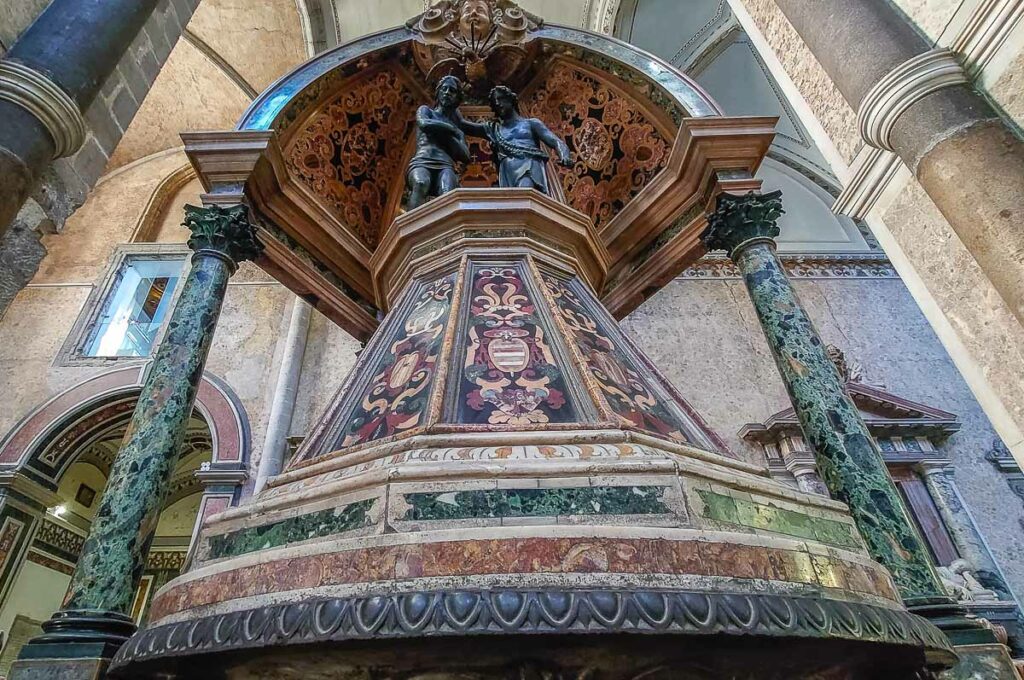
WHERE TO STAY IN NAPLES?
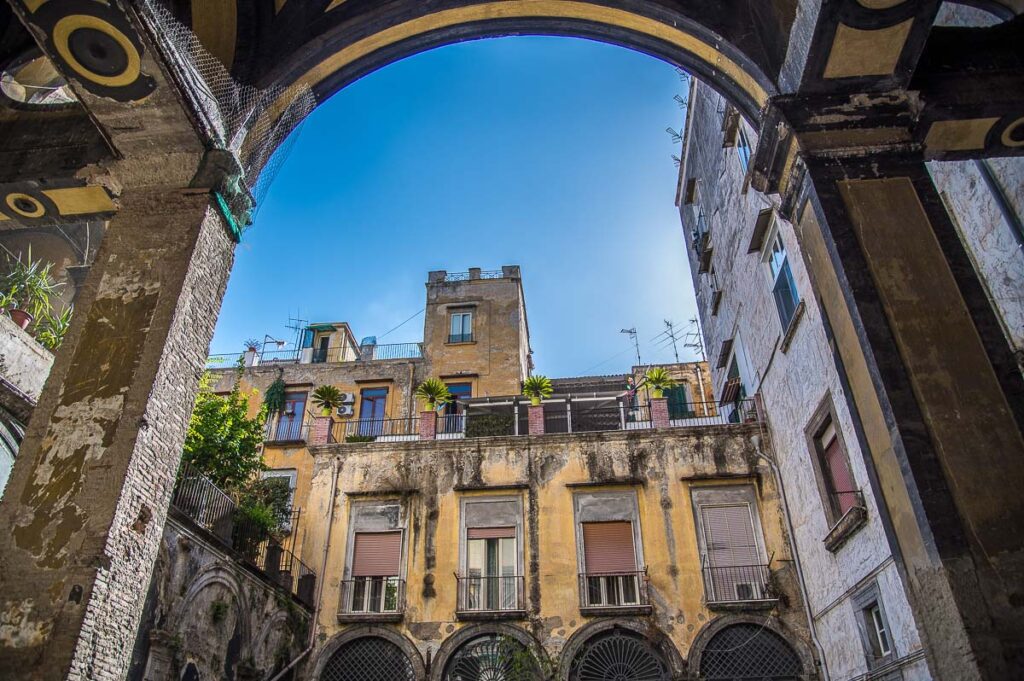
There is a huge selection of places to stay in Naples in any season and for any budget.
You can choose a historic building that nowadays functions as a luxury hotel. You can opt for a comfortable B&B . Or you may prefer an accommodation with its own kitchen to enjoy a home-from-home experience.
When picking accommodation in Naples consider carefully its location. Depending on what you want to do and see here, you may prefer to stay closer to the major landmarks, a bus or metro stop, or in a hidden corner of the city that offers peace and quiet.
If your focus is sightseeing in Naples, then it pays to stay in the historic centre. For more of an upmarket experience, look into the quarter of Chiaia . The area around Piazza Garibaldi and the main train station, Napoli Centrale , is convenient in terms of public transport but it made me feel on the edge every time we needed to walk through it.
Here are some suggestions for places to stay in Naples. All come highly recommended:
Luxury: Grand Hotel Vesuvio , Palazzo Doria Napoli , The Britannique Hotel Naples, Curio Collection by Hilton
Mid-Range: Relais della Porta , Artemisia Domus – Centro Storico , La Lepre Bovio
Budget: Ostello Bello Napoli , Leone Suites Toledo , EMME Napoli
Alternatively, use the map included here to get a quick visual idea of the available accommodation options in Naples, Italy. You can zoom in and out, type in your specific travel dates, and then click on the different price points for detailed information about the hotel you want to know more about.
In addition, have a look at this blog post which explains the different types of accommodation you can book in Italy. It will give you plenty of ideas to look into for the best and quirkiest places to spend the night at here:
- Where to Stay in Italy – 19 Types of Accommodation to Suit Any Budget
WHAT TO EAT IN NAPLES?
Neapolitan food is excellent. Eating here is a great experience that nourishes not just the body but the soul, too. Every meal in Naples has the potential to be absolutely unforgettable. So don’t waste any chances to tuck into yet another delicious local dish.
From inexpensive street food to the freshest seafood and local variations of pasta, Naples has a lot to offer even to the pickiest of eaters.
Pizza is always a good choice in Naples. Deep-fried foods taste so good after a long day of sightseeing. If you have a sweet tooth, you will be delighted with the rich displays of cakes and pastries. And you can finish it all off with a proper Neapolitan coffee prepared with a traditional flip pot called cucumella . Alternatively opt for a local liquor – from the world-famous limoncello to the herbal Strega , a distinctive digestif drink the name of which means ‘witch’ in English.
Here are some of the best Neapolitan foods and dishes to sample during your Italian holiday:
Taralli – this typical for Naples snack is circular in shape and traditionally made of lard, toasted almonds, and black pepper. Nowadays, it comes in many different flavours. Take your pick from the wide selection at Taralleria Neapolitana .
Pizza – you have to have a pizza or two when in Naples! Try as many of the traditional varieties as you can. Take your pick from pizza Margherita (tomato sauce, mozzarella, and fresh basil), pizza Marinara (tomato sauce, extra virgin olive oil, oregano and garlic), pizza fritta (a Calzone-shaped pizza stuffed with different fillings and deep-fried), pizza Montanara (open fried pizza topped with tomato sauce, mozzarella, and basil), and pizza portafoglio (a smaller pizza Margherita or pizza Marinara folded in four and eaten on the go. Or choose any other pizza with classical and innovative toppings offered in Naples’ best pizzerias. Many of them are clustered along Via dei Tribunali in the historic centre. It’s the city’s veritable pizza paradise!
Ziti alla Genovese – this is an iconic Neapolitan dish and it doesn’t have anything to do with the city of Genoa, although there are many theories as to how it got its name. Ziti is a type of extruded pasta typical for the Southern Italian region of Campania of which Naples is the capital. The genovese sauce is made of ground beef, cherry tomatoes, celery, carrots, and lots and lots of onions. It has a slightly sweet taste and it is very more-ish. Order it at La Locanda del Monacone .
Ragù – this Neapolitan meat sauce is absolutely delicious. Tomato-based, it’s made with beef and densely stuffed sausages left to simmer for hours. Try the ragù dishes of Tandem – a famous Neapolitan chain of ragù-centric restaurants. My favourite dish consists of thick slices of provola cheese served with an extra-generous helping of ragù on top.
Cuoppo Napoletano – this paper cone filled up with fried finger foods is proper Neapolitan street fodder. There are two main varieties – cuoppo di terra and cuoppo di mare . The first is a mix of battered and deep-fried chopped veggies, rice balls (known as arancini ), potato croquettes, and my favourite – zeppoline (delicious dough balls). The latter is a mix of battered and deep-fried seafood – from calamari to sardines. Try the cuoppo at Passione di Sofi .
Babà (also babà al rum ) – you will see these mushroom-shaped and rum-infused sponges all over town. Treat yourself to one when you are in the mood for something sweet and boozy. For added delight, have your babà with lots of whipped cream and strawberries, too.
Sfogliattella – this pastry is typical for Naples and comes in two varieties – riccia (made of overlapped sheets of filo pastry crisped to perfection) and frolla (made of thick shortcrust pastry). Both the sfogliatella riccia and the sfogliatell frolla are stuffed with a delicious filling of ricotta and candied citrus peel. Try the ones sold at Sfogliate e Sfogliatelle .
For an expert introduction to Neapolitan food and Naples’ best food joints, treat yourself to a specialised guided tour. This street food experience will take you around the city’s historic centre to sample traditional dishes in secret eateries frequented by the locals.
Alternatively, taste the best that Naples has to offer with this private tour . Expect ten drink and food tastings and the expert commentary of a foodie guide. If you would rather learn to cook the Neapolitan way, then get busy making your own pizza Margherita or pasta dish followed by tiramisu .
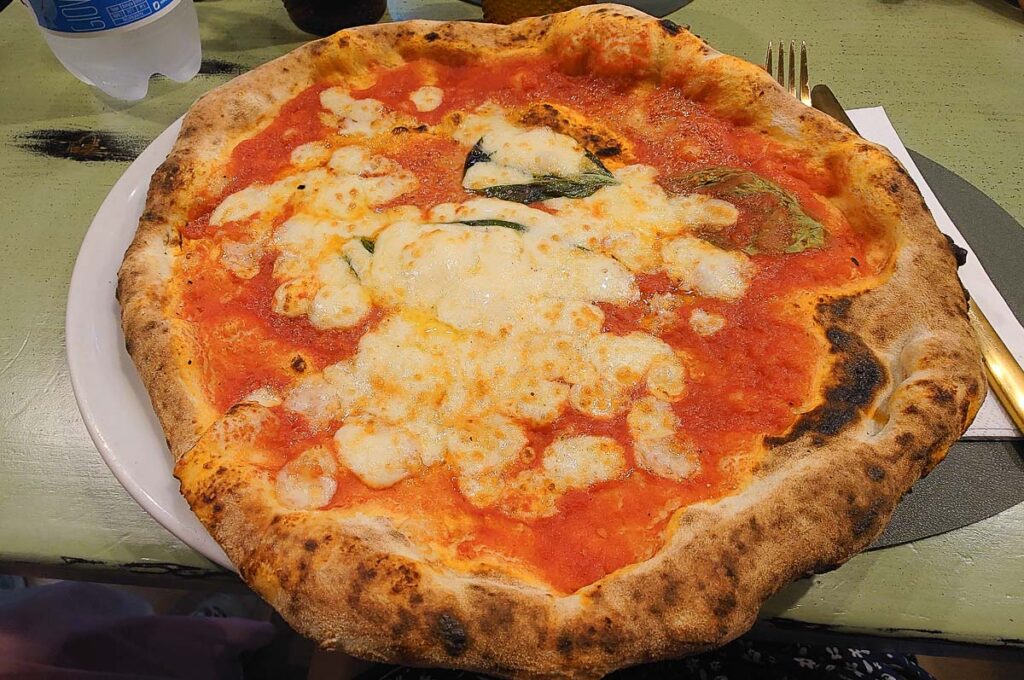
BEST THINGS TO DO IN NAPLES
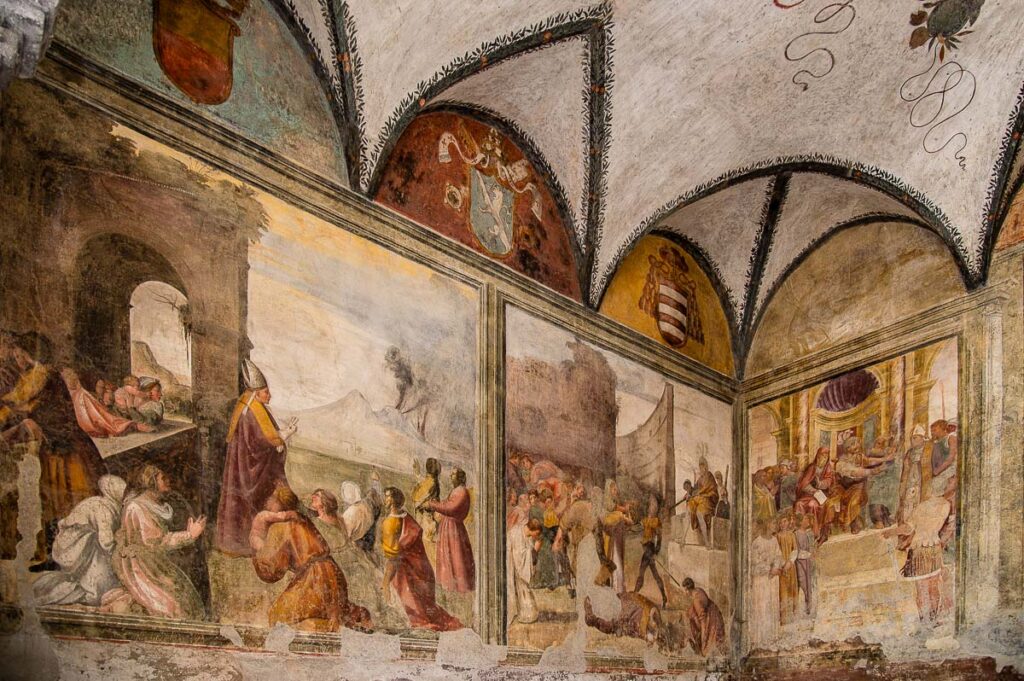
There are many wonderful and exciting things to do in Naples to suit all types of travellers and personal interests. This beautiful city has a lot to offer to the history buff, the art lover, the architecture aficionado, the foodie, the photographer, and above all the person who wants a vibrant and stimulating travel experience.
Here are the main things and activities you can enjoy in Naples. Specific examples for each one of them are provided up and down this page under the different headings of this ultimate travel guide for Napoli .
Sightseeing – Naples is studded with world-famous museums, millennia-old catacombs, and imposing churches with priceless art. With preserved outlines of its ancient Greek and Roman urban plans and plenty of historic spots to explore, this is one of the world’s best cities for sightseeing and landmark visiting.
Eating – Neapolitan cuisine has originated several of the world’s most famous foods with pizza holding the triumphal top spot. Eating here is a cultural experience. Try something new every single meal! Then take a food tour visiting historic deli shops and tiny eateries frequented by the locals. Even better, learn to make pizza the Neapolitan way yourself.
Water-Based Activities – here you are never far from the sea. You can take a ferry or a boat to the islands off the coast of Naples. Or you can enjoy a boat trip around Castel dell’Ovo and snorkelling in the gulf. If you want to combine water and history, then head to the Phlegraean Fields ( Campi Flegrei ) next door to Naples. In the Submerged Archaeological Park of Baia, you can enjoy a trip on a glass-bottomed boat and even a once-in-a-lifetime diving experience to see Roman mosaics and statues underwater.
Shopping – take advantage of exciting shopping opportunities when in Naples. Invest in a traditional Neapolitan Nativity scene (or at least in a small handmade figurine) on Via San Gregorio Armeno . Buy a selection of cornicelli (Naples’ protective amulet) to give as presents to family and friends. Get a cucumella – Naples’ traditional flip coffee pot. Splurge on handmade cameos and coral jewellery. Shopping in Naples is fun as each traditional, locally-made item has a story to tell.
Daytripping – Naples is a great base for day trips in this corner of Italy. From the world-famous Amalfi Coast to the archaeological ruins of Herculaneum , Pompeii , and Paestum , a long list of exciting destinations are only a short train ride away from Naples.
MAJOR LANDMARKS IN NAPLES
There are many must-see sights in Naples. These five major landmarks should be on top of your Neapolitan bucket list.
Spaccanapoli – one of the most iconic urban arteries in the world. This is a sequence of long straight streets which flow one into another and thus bisect Naples in two. Go for a walk along Spaccanapoli to sightsee and people-watch. Many of the city’s most interesting sights, for example, the Monastery of Santa Chiara , are on it or next door to it.
Sansevero Chapel – visit this small chapel in the heart of Naples to marvel at one of the most famous and most extraordinary statues in the world – the Veiled Christ. The chapel is a work of art in itself and was designed by the Italian soldier, alchemist, and inventor Raimondo di Sangro, Prince of Sansevero. Don’t miss the statues of the Veiled Truth and of Disillusion which are striking by themselves and were dedicated to the prince’s parents. The two 18th-century anatomical machines in the chapel’s basement are creepy yet incredibly intricate. You won’t be able to take your eyes off them!
MANN – National Archaeological Museum of Naples – a splendid museum with many excellent collections covering the ancient civilisations of Egypt, Magna Graecia, and Rome. The Pompeiian frescoes and mosaics are absolutely stunning. If you don’t blush easily, check out the Gabinetto Secreto for some ancient erotic art. To make the most of your visit, consider booking a museum tour . An expert guide will take you around the cavernous building pointing out precious artefacts and sharing the stories behind them for a truly enriching experience.
Piazza del Plebiscito – this expansive square is flanked by the imposing buildings of the Royal Palace and the Basilica of San Francesco di Paola. From Piazza del Plebiscito (a word which means ‘referendum’ or ‘vote’ in English), you can easily walk to several other must-see places in Naples. Among them is the oldest opera theatre in the world, Teatro di San Carlo , the elegant shopping arcade Galleria Umberto I , and the historic Gran Caffè Gambrinus – the oldest still in operation coffee house in the city.
Castel Nuovo (also known as Maschio Angioino ) – standing on the waterfront, this 13th-century fortress is one of Naples’ seven historic castles. Notice the large triumphal arch inserted around its main gate. It is one of the pinnacles of Italy’s Renaissance art.
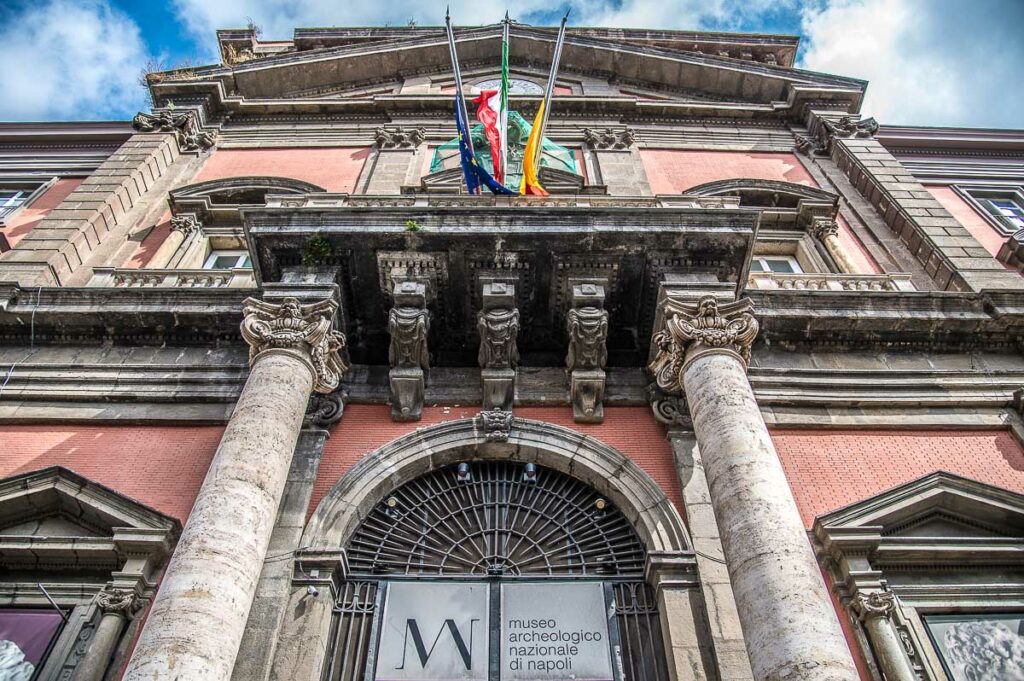
BEST MUSEUMS AND ART GALLERIES IN NAPLES

There are many exciting museums dotted all over Naples. In addition to MANN – National Archaeological Museum of Naples and the Royal Palace (see the entry above), here are five of the best among them:
Capodimonte Museum – built to house the renowned Farnese Collection of art, this former royal residence is surrounded by a lush park (originally, a hunting ground). Here you can see and enjoy an endless number of masterpieces by the likes of Botticelli, Titian, and Caravaggio as well as a number of renowned collections of art, porcelain, tapestries, and contemporary works.
Pio Monte della Misericordia Monumental Complex – run by a religious charity founded at the start of the 17th century, this is one of the must-see stops for lovers of art in Naples. It includes an octagonal chapel and a picture gallery housed in an elegant historic palace. Caravaggio’s famous painting ‘The Seven Acts of Charity’ was painted specifically for the chapel and it takes pride of place above its altar. Next door, you can browse a beautiful selection of Baroque and contemporary masterpieces and enjoy a lovely view of the Obelisk of San Gennaro and the dome of Naples’ Duomo.
Gallerie d’Italia – Napoli – I am partial to this group of art galleries which also has branches in the Italian cities of Milan , Vicenza , and Turin (you can see all their works of art on this link ). The permanent collection in Naples is eclectic and ranges from Attic and Magna Graecia pottery to works by Neapolitan, Italian, and foreign artists. This gives you a chance to explore the developments in art from ancient history to the 20th century. Caravaggio’s last painting ‘The Martyrdom of Saint Ursula’ is the crowning glory of this must-see art gallery in Naples.
N.B.: Calling all Caravaggio lovers! To learn more about the Neapolitan periods of the great Baroque master, have a look at this guided tour . It takes in the masterpieces and the places frequented in Naples by the painter of darkness and light.
Certosa e Museo di San Martino – this former Carthusian monastery nowadays functions as a museum complex with lush gardens. Here you can spend many stimulating moments looking at art used in all its forms to emphasise and decorate the impressive architecture. The charterhouse’s hilltop position opens splendid panoramic views of Naples and Mount Vesuvius. Next door, you can also explore the military fortress Castel Sant’Elmo .
Museo Madre – if by now you are feeling a bit overwhelmed by ancient ruins and Baroque splendour, a visit to Museo Madre and its excellent collection of contemporary art is just what you need to refresh your eyes and enrich even further your impressions of Naples.
BEST CHURCHES AND MONASTERIES IN NAPLES
Naples is dotted with countless churches, monasteries, and religious buildings. It’s not in vain after all that one of its monikers is the City of 500 Domes!
From the tiniest chapels to the imposing basilicas, Neapolitan churches guard priceless art repositories and unique local traditions. They are also an intrinsic part of the city’s architectural mosaic. Visiting them you can trace the development of building styles and decorative programmes from the Early Christian chapels nestled in the underground catacombs to the Gothic, Renaissance, and Baroque shrines and sanctuaries of Naples.
Here are some of the city’s must-see churches:
Duomo and Museum of the Treasure of San Gennaro – Naples’ cathedral has a millennial history and a cavernous body that incorporates two earlier churches built at the same site. One is the Church of Santa Restituta, allegedly founded in the 4th century by Constantine – the emperor who made Christianity the official religion of the Roman Empire. Nowadays, Naples’ Duomo preserves many priceless artefacts. Among them are the relics of San Gennaro or St. Januarius in English – the city’s main patron saint. It is here that the ritual of liquefying the saint’s blood takes place three times a year – an important event in the Neapoltan calendar (see the heading Events below). Next to the Duomo, don’t miss the Treasure of San Gennaro. Among the many exhibits here, you can see one of the most expensive pieces of jewellery in the world – the saint’s necklace.
Church of Ges ù Nuovo – this absolutely massive building was erected in 1470 as a princely palace. A century later it was sold to the Jesuit Order and converted into a church. Lavishly frescoed and ornamented in the Baroque style inside, its main point of interest is its unusual facade. This is made of piperno, a stone formed from volcanic magma, and fully covered by countless small pyramids. Unusual symbols are chiselled in some of these. Recently, it has been suggested that the symbols correspond to musical notes. When played, the resulting piece was, apparently, intended to attract good energy to the building.
Monastery of Santa Chiara – widely famous for its cloister decorated with lavish majolica tiles and Baroque frescoes, this monastery also has an onsite museum and guards the remnants of an ancient Roman bath. Its enormous Gothic basilica was almost completely destroyed during the Second World War (after Milan, Naples was the most bombarded Italian city) and then it was painstakingly restored to its former glory.
Museum Complex of Santa Maria delle Anime del Purgatorio ad Arco – this is one of the main centres of Naples’ curious cult of the souls in purgatory or anime pezzentelle in Italian. It consists of two churches. The decoration of the upper one explores the themes of death and salvation. The underground one is where many of Naples’ poor and destitute citizens were buried in the past. The locals, believing them to be stuck in purgatory, would come here to pray over their remains. This gave rise to the idea that the dead could serve as intermediaries between the living on Earth and the saints and God in heaven. So skulls were treated with special care and requests would be addressed to them.
N.B.: If you want to learn more about the cult of the anime pezzentelle , make sure that you also visit the Fontanelle Cemetery (due to re-open in 2024), the Monumental Complex of St. Anne of Lombardi, and the Church of Santa Luciella ai Librai.
Basilica of Santa Maria della Sanità – built over the Catacombs of San Gaudioso , this resplendent Neapolitan church is notable for its elevated altar and the double staircase that leads to it. Covered with bright majolica tiles, its large domes reflect beautifully the light, especially on a sunny day. If you book to see the catacombs (one of Naples’ best underground sights), the guide will tell you a bit about the church and the cult of San Vincenzo Ferrer – the patron saint of the quarter of Sanità and to whom the locals address prayers when they want to have a child.
Church of San Francesco di Paola – inspired by the Pantheon in Rome, this expansive Neapolitan church brims the city’s main square, Piazza del Plebescito , with its long colonnade. Built in the early 19th century in the Neoclassical style, it stands out with its portico and enormous central dome.
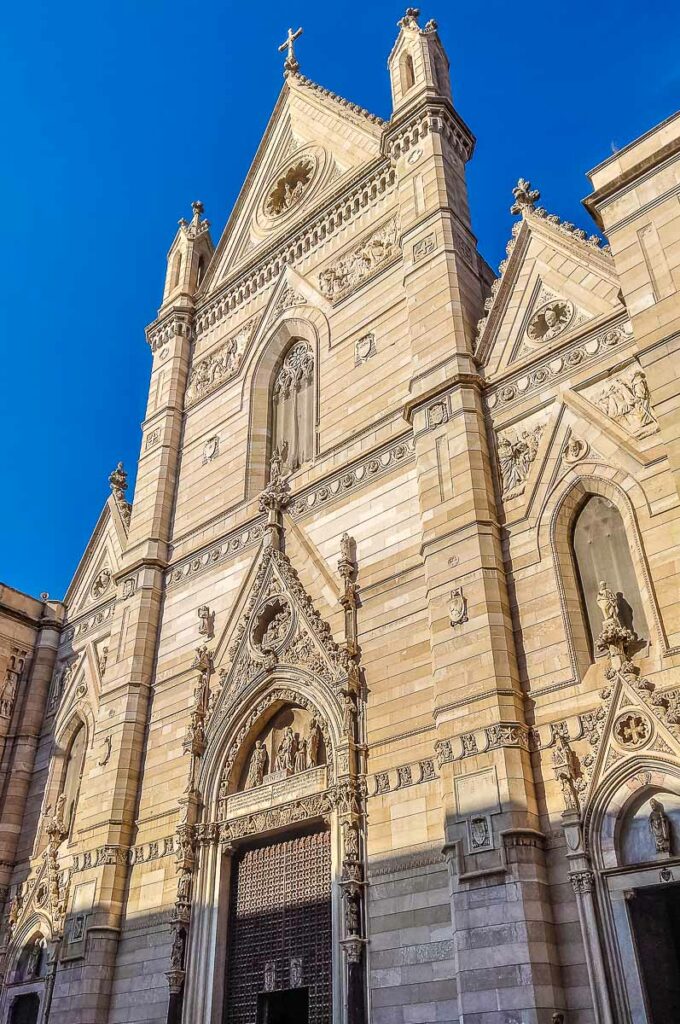
HIDDEN GEMS IN NAPLES
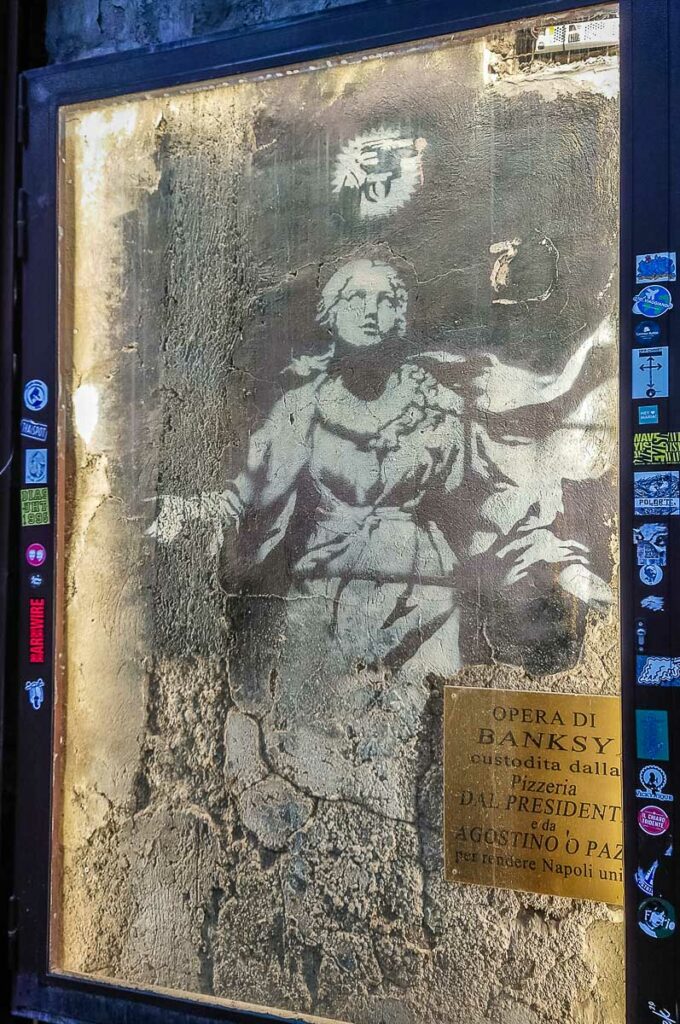
A city like Naples has a lot of secrets and hidden corners. Try to uncover as many of them as possible for a truly memorable trip. Make a note of the sights below and step off the beaten path.
Madonna con la Pistola by Banksy – up to 2019, this was the only documented mural by the artist in Italy. You can see it on Piazza dei Girolamini and it represents the Madonna with a gun where her halo should have been.
N.B.: Naples is a great place for street art. Everywhere you go, you will see murals and graffiti of differing quality adorning the facades of both historic and modern-day buildings. Keep an eye out for the graffiti of Trallalà – the moniker of the Naples-born artist Alfonso de Angelis. His fleshy ladies (known as ciaciona in Neapolitan) are particularly iconic.
Incurables’ Monumental Complex – come here to learn about the history of medicine in Naples and to visit the splendid Pharmacy of the Incurables, the Museum of the Sanitary Arts, the 16th-century cloister, and the medical garden.
Library and Monumental Complex of the Girolamini – a beautiful church with cloisters and a splendid historic library. From precious art to rare books, there is much to be seen and admired here far from the tourist crowds.
Monumental Complex of St. Anne of Lombardi – this 15th-century church preserves extraordinary works of art. In the sacristy, you can see the Sistine Chapel of Naples – an important fresco cycle by Giorgio Vasari, the Tuscan Renaissance painter and art historian. In the Crypt of the Abbots (or Hypogeum), you can learn about the Neapolitan scolatoi or draining holes where the bodies of the deceased underwent a somewhat gruesome and long procedure to liberate the bones from the flesh in an act which was believed to expiate the soul.
Naples’ Stairways – about 200 stairways and ramps connect the city’s flatter parts to its hilltop quarters. Following one of these inclined paths weaving past houses, churches, and monuments, is a great way to explore Naples and enjoy splendid panoramas of the urban sprawl and Mount Vesuvius. Among the stairways with the best views are the Pedamentina a San Martino , the Montesanto Stairs, and the Gradini del Petraio .
CATACOMBS AND UNDERGROUND SPACES IN NAPLES
Almost 3,000 years old, Naples is a city of layers. Many of these run deep under the streets and are keepers of marvellous stories that oscillate between the sacred and the macabre. Often within the same space below the surface.
Uncovering Naples’ underground secrets is a major portion of getting to know this one-of-a-kind city in Southern Italy. There is a bewildering number of underground tours and experiences for you to choose from. Here are some of the best:
Catacombs of San Gennaro and Catacombs of San Gaudioso – visiting these catacombs was my favourite experience in Naples. Both are accessible on the same ticket via guided tours. You will need to book your entry times in advance. I suggest that you head first to the Catacombs of San Gennaro on the far end of Rione Sanità (near the Capodimonte Museum and Park and next door to the imposing Basilica of the Crowned Mother of God). Here you will learn about the early Christian history of Naples and see prized frescoes and mosaics from the first millennium AD, as well as tombs chiselled directly in the volcanic tuff rocks. The focus of the guided visit to the Catacombs of San Gaudioso, on the other hand, is on the funeral ritual of scolatura . This was practised by Naples’ nobility and clergy of the 16th and 17th centuries and prescribed the draining of the bodies after death of all fluids in order to liberate the bones from the sinful flesh. Leave at least an hour between your visits to the two catacombs and explore Rione Sanità . If you can’t see both on the same day, your ticket for San Gaudioso is valid for 12 months after your visit to San Gennaro.
Napoli Sotterranea – Naples’ most popular underground tour. It takes in the city’s ancient water cisterns, the ruins of the ancient Roman theatre, stories from World War II, and even a recently planted underground garden. An exciting experience on many levels which culminates with a short walk down pitch-black narrow corridors to reach water pools with amphoras suspended above them. People suffering from claustrophobia can skip this part and wait for the rest of the group in a spacious underground chamber before continuing with the tour.
Bourbon Tunnel – built in 1853 and heavily used during the Second World War, this space below the surface of Naples has many stories to tell spanning four centuries. Especially photogenic are the abandoned cars and motorcycles that line up the tunnel. Next to them are stored statues from the fascist period.
Spanish Quarters Underground Guided Tour – winding tunnels will take you to the remains of the Neapolitan aqueduct deep beneath one of the city’s liveliest and most authentic quarters. From the ancient Greeks to the Second World War, you can trace Naples’ history as you walk along the dimly lit corridors.
San Lorenzo Maggiore and Neapolis Sotterrata – a wonderful journey through time that gives you a chance to trace Naples’ development from the 5th century BC to the 18th century AD both below and above ground. Here you can see the remains of a 1st-century AD Roman market, visit the imposing basilica where the 14th-century Renaissance humanist and writer Bocaccio met his muse Fiametta for the first time, and amble through historic halls decorated with splendid frescoes.
Basilica of Santa Maria Maggiore alla Pietrasanta and LAPIS Museum – this imposing 17th-century church stands at the spot of an early Christian basilica that was preceded by an ancient Roman temple dedicated to the goddess Diana. 35 m underneath it, you can visit Naples’ museum of water. Expect Greco-Roman cisterns and a submerged portion of the Roman Decumanus (the east-west oriented road that bisected the city in the past). Once you return to the surface, stop for a coffee in Diaz Microtorrefazione (one of Naples’ best coffee shops) in the shadow of the church’s 11th-century bell tower.
Church of Santa Luciella ai Librai – it’s easy to walk past this small church in the historic centre of Naples and not even suspect the stories and curiosities it keeps. The skull with ears takes the central place among them. They say that in the past, Neapolitan women would come to pray to it and whisper in its ears their innermost secrets and desires. The church’s crypt can be visited with a short guided tour. In the past, the funerary ritual of scolatura was practised here, too.
Underground Stations of Art – 15 stations along Line 1 and Line 6 of Naples Metro host over 200 works of art by 90 artists both from Italy and all around the world. Started in 1995, the project Stazione di Arte has produced some of the most beautiful metro stations in Europe with Stazione Toledo the receiver of many awards and accolades. Other metro stations worth a mention here are Università , Dante , Museo , Materdei , and Garibaldi . Even just travelling around the city of Naples is already an experience of art.
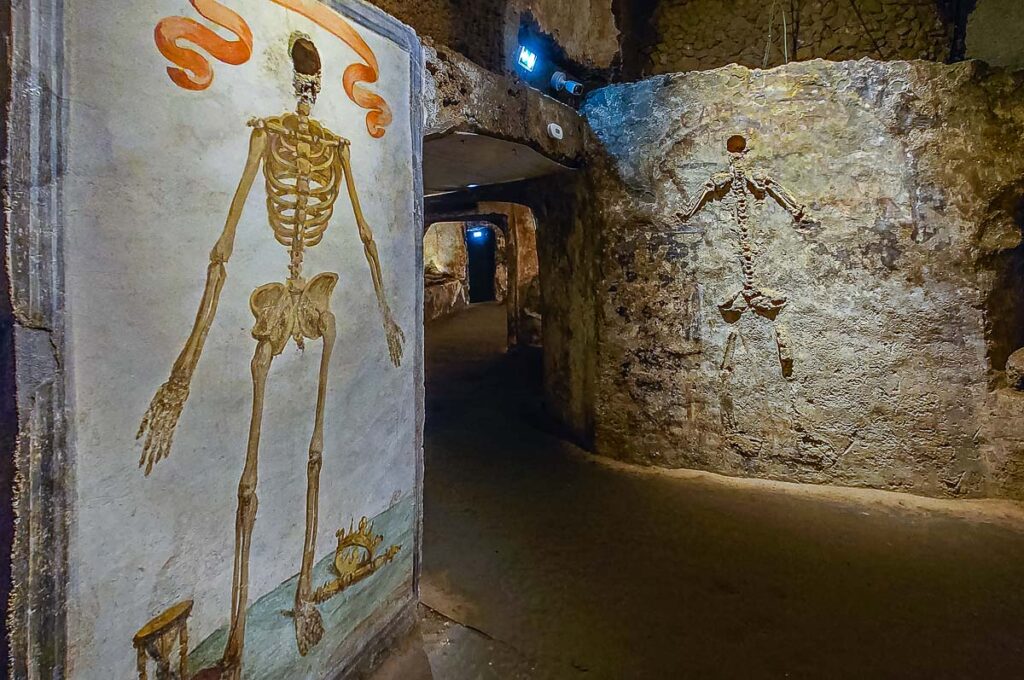
CURIOUS THINGS TO SPOT AROUND NAPLES
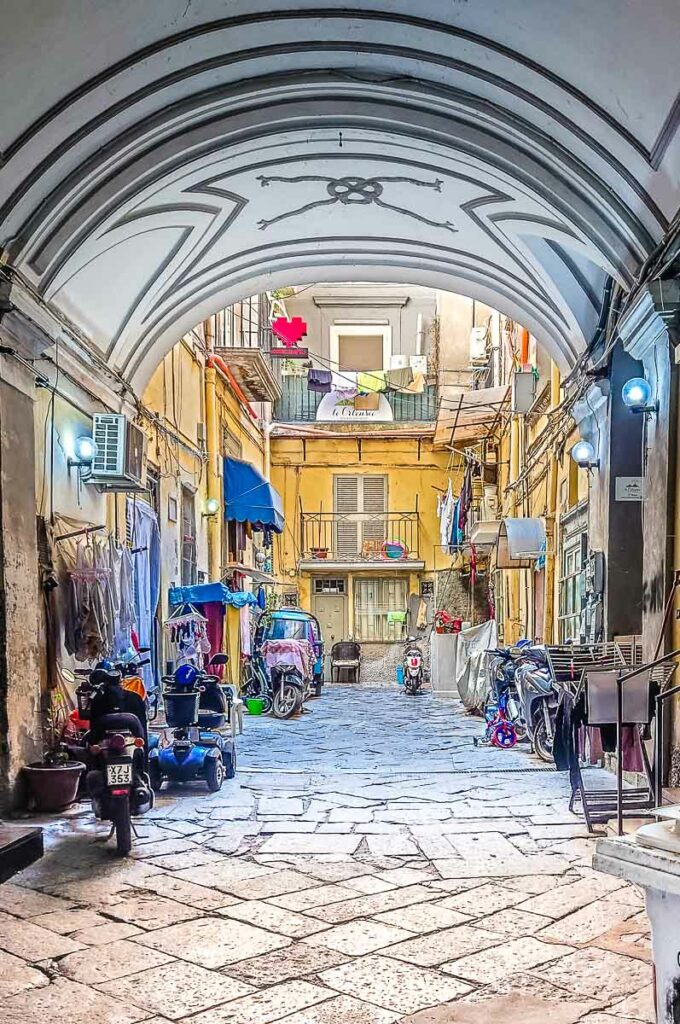
Here are five curious things that made an impression on me as I was exploring Naples with my family. You will come across them all around the city. They make it the lively, crazy, multilayered place that it is. I am mentioning them here to give you yet another angle (or angles) from which to approach Naples, experience its traditions, and capture truthfully its character.
Courtyards – a nucleus of authentic Neapolitan life, the courtyard is where you will find in no particular order parked cars and mopeds, rows of post boxes, the obligatory clotheslines, pots with plants, recycling bins with strict instructions on what to put in each, and so on. Providing an island of tranquillity in a densely built city, courtyards here are usually square or rectangular and flanked by balconies and rows of windows. Huge wooden gates block access to the courtyard from the street. These have a small door cut out in them to allow residents to walk in or out when the gates are closed.
Baskets – in a multi-storey city such as Naples, baskets come in handy when you don’t want to rush downstairs every time a delivery driver rings the bell. Instead, people drop a basket suspended by a cord from their balcony and then pull it up with the delivered item safely inside. Pure genius!
Mopeds/Scooters – these two-wheel vehicles are everywhere in the city. They are the main form of transport here, especially in the historic quarters. From teenagers to octogenarians, everyone rides them. Often, you can see a whole family with the baby and the dog on a single moped. You will quickly learn to jump out of the mopeds’ way, especially on the narrow historic streets with no pavements. Your head will be on a swivel at all times and you will subconsciously start to double up any walking time predicted by Google Maps, as by your first afternoon in Naples you will know that walking with a constant stream of mopeds right next to you is very time-consuming. Neapolitans seem to think that helmets are optional. I certainly don’t recommend not wearing one if you decide to brave the local traffic and ride around on a moped yourself.
Shrines – in Italian, they are known as edicole votive or edicole sacre . These are shrines attached to the walls of houses and buildings. You will see dozens of them as you walk around the city. A heartfelt expression of popular devotion, they vary in size and are decorated with religious images, candles, rosary beads, and plastic flowers.
Basso (pl. bassi )- also known as ‘o vascio in the Neapolitan language, these are small ground-floor flats with doors that open directly on the street. As you walk around town, your eyes will spontaneously look through the windows and the doors of many bassi giving you glimpses of real life. Some of these flats are so small that the marital bed stands right opposite the kitchen sink. In others, the occupants have reclaimed a corner of the street by fencing it off as a small verandah or placing large pots with plants to turn it into a personal garden. The family’s laundry flaps on freestanding driers placed directly on the pavement or on makeshift clotheslines. Some bassi have been turned into shops or workshops where you can buy bread or fresh fish or have your moped repaired if you need.
BEST PRESEPI IN NAPLES
A presepe (also known as presepio in Italian and a Nativity scene in English) is a figural representation of the Holy Family in the stables of Bethlehem. It is the focal point of festive decorations in Italian homes during the Christmas season. You can read more about presepi in this blog post:
- Presepe or 15 Facts about Italy’s Nativity Scenes – History, Traditions, and Meaning
Naples is Italy’s main centre of presepe -making. Handmade Neapolitan presepi are recognised for their beautifully carved and sculpted figurines, complex settings, and the introduction of folk characters, scenes of daily life, and even representations of modern-day celebrities in the Biblical Nativity scene.
A visit to Via San Gregorio Armeno is a must when you are in Naples. This is the street in the heart of the historic centre where you will find the largest concentration of presepe -making workshops. It’s Christmas all year round here.
As part of your sightseeing in Naples, don’t miss the following large-scale and very intricate presepi in the city:
Presepe Favoloso in the Basilica of Santa Maria della Sanità – this is my favourite Nativity scene in Naples. Four metres long and two metres high, it has over 100 figurines and it was made in 2021. The curious thing about it is that it incorporates figural representations of countless Neapolitan folk stories and contemporary happenings. As such, the Holy Family is surrounded by weird and wonderful characters that make you want to learn more about Naples’ myths and traditions. You can see this presepe as part of the guided tour of the Catacombs of San Gaudioso .
Cuciniello Nativity in the Museo Nazionale di San Martino – this large and complex presepe is composed of figurines of 173 people, 42 angels, and 80 animals (including two monkeys!). 450 miniature objects complete the scene.
Presepe del Banco di Napoli in the Capella Palatina of the Royal Palace – this lavish Nativity scene is composed of 354 pieces dating to the end of the 18th and the beginning of the 19th centuries. All of them were designed and handmade by famous artists of the time, for example, Giuseppe Sanmartino, the sculptor of Naples’ most famous statue – the Veiled Christ.
Presepe by Fratelli Capuano in their bottega on Via San Gregorio Armeno – this Nativity scene was made in 2006 by the artisans of one of Naples’ most renowned presepe -making workshops. In the style of an 18th-century Neapolitan presepe , it is incredibly detailed and expansive in size. There is a nominal charge of one euro to see this presepe .
Sala del Presepe in the Monastery of Santa Chiara – this large-scale Nativity scene is composed of 18th-century pieces commissioned during the reign of Ferdinand IV. The king himself was a big fan of presepi
Don’t worry if you don’t manage to see exactly these five Neapolitan presepi . Large-scale Nativity scenes are installed all over Naples, especially in the local churches. The best time of the year to see them is obviously around Christmas but they add a touch of whimsicality and wonder to your memories of this Italian city no matter the season.
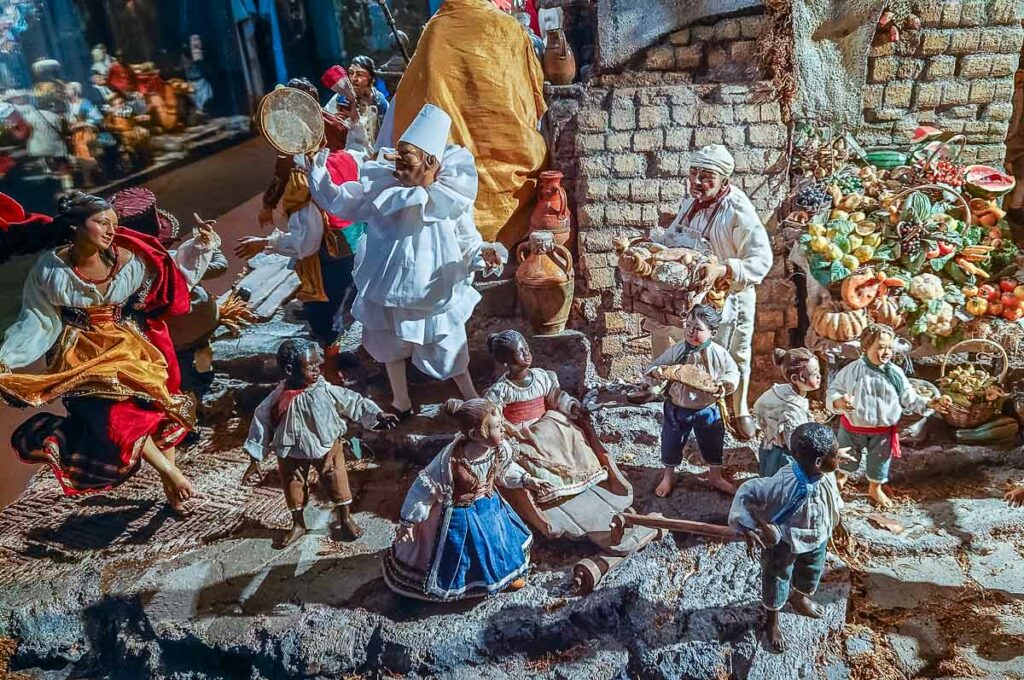
EVENTS IN NAPLES
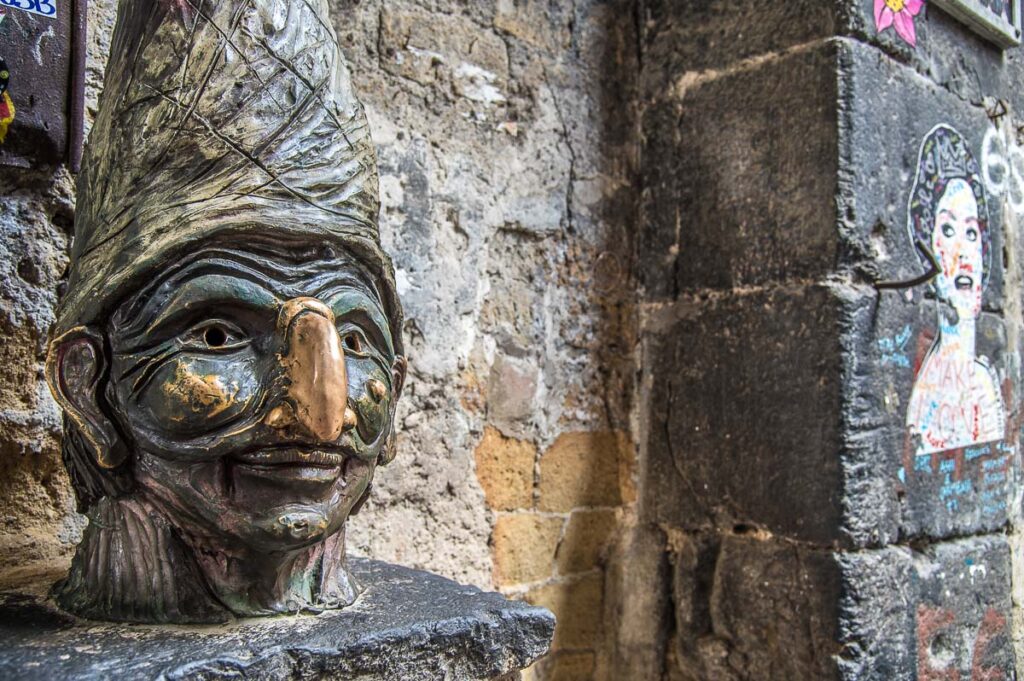
Naples has a rich calendar of events. From art exhibitions and religious festivals to culinary get-togethers (called sagra ) and street celebrations, there is always something fun and exciting to do in the largest Southern Italian city.
Here are some of the most important events in Naples to enjoy together with napoletani :
January – 6th January or Epiphany is the day of Befana, an old long-nosed lady who rides around on a broom. As one of Italy’s five Christmas gift-bearers, she brings presents to the well-behaved Italian kids. What do the naughty ones get instead? Find out here . On 17th January, Naples celebrates the day of St. Anthony the Abbot, the protector of animals, with traditional bonfires.
January/February – travel to Naples for Carnevale . This is a period of confetti, costumes, music, and fun in the city. It’s also an opportunity to spot a Pulcinella or two out and about in the historic quarters. With a black mask with a protruding nose, this is the commedia dell’arte character who hails from Naples. In English, he is also known as Punchinello and originated the British puppet character Punch (as in Punch and Judy).
N.B.: If you can’t make it to Naples specifically for Carnival, then head to Vico del Fico al Purgatorio , a dark portico right off Via dei Tribunali , at any other time of the year. Here you can see the famous bronze bust of Pulcinella by the local artist Lello Esposito. Tourists touch the bust’s nose for good luck which explains its shiny surface.
March/April – Easter is one of the major celebrations in the Neapolitan calendar. Spend the Holy Week here and immerse yourself in centuries-old religious rites and popular traditions. For example, the sepolcri and the giro delle sette chiese . The sepolcri are specially decorated altars or chapels in Naples’ churches. The giro comprises visiting seven churches to pray for benevolence. Tuck into local festive dishes such as zuppa di cozze (mussel soup eaten on Holy Thursday) and pastiera (a shortcrust pie filled with ricotta-based cream).
April – twice a year (on the 5th of April and on the first Tuesday of July) the historic quarter Rione Sanità celebrates its patron saint, the Spanish Dominican friar Vincenzo Ferrer. Known as O’Munacone – the Big Monk – it is believed that the cholera epidemics that decimated Naples in 1836 only ended after the saint’s statue was carried along the quarter’s streets.
N.B.: You can see the shrine of San Vincenzo in the Basilica of Santa Maria della Sanità. The locals pray to the saint when they want to have a child.
April/May (then Septembe r and December ) – Naples’ major celebration takes place three times per year: the Saturday preceding the first Sunday of the month of May, then the 19th of September, and the 16th of December. This is when napoletani flock to the city’s Duomo and pray for the Miracle of Liquefaction. The blood of Naples’ patron saint San Gennaro was collected in a glass vial after he had been beheaded during the persecutions of the Christians spearheaded by the Roman emperor Diocletian. Over the centuries, the blood dried and turned solid. However, on these particular dates, it becomes liquid again after a complex ceremony performed in front of the people of Naples. A successful liquefaction of the saint’s blood is a sign of forthcoming prosperity. A failure to liquefy is interpreted as misfortunes to befall Naples and the world in the months to follow.
September – visit Naples around the 8th of September for the annual Feast of the Madonna of Piedigrotta. Expect float parades, firework displays, and concerts.
December – the Christmas season is especially heartfelt in Naples. Head to Via San Gregorio Armeno to immerse yourself in the festive hubbub of shoppers seeking new pieces for their presepi . Visit the city’s churches to see their intricate Nativity scenes. Enjoy traditional Christmas desserts such as struffoli (fried balls of sweet dough covered with hot honey and colourful sprinkles) and roccocò biscuits.
NAPLES WITH KIDS
Is Naples a good place to visit with kids? This is a very valid question considering the city’s incredibly busy historic centre, the obvious social contrasts, and the large number of sights and museums where one can spend many hours walking around to full exhaustion.
My personal opinion is that Naples is a great place to visit with kids who are eager to learn new things, who love to eat, and who have vivid imaginations. Also, kids who don’t mind walking around for long stretches of time and who love exploring new places and cultures.
Here are a handful of places and sights which you may enjoy visiting particularly with your kids in Naples:
Aquarium of Naples – this is the oldest aquarium in Italy. It was opened in 1874 by the German Darwinist Anton Dohrn. Two years before that he had founded the world’s first zoological research station in Naples. The aquarium is housed in Villa Comunale – an important historic garden in the quarter of Chiaia. It has 200 animal and plant species in 19 basins and represents nine different habitats of the Mediterranean Sea. Near the aquarium, you can also visit the Museum Darwin-Dohrn .
Botanical Garden of Naples – this verdant oasis is a pleasure to visit with the family, especially on a hot day.
Ospedale delle Bambole – this Dolls’ Hospital is a very whimsical place in the heart of Naples. It first opened its doors in the 19th century and since then it has been run by four generations of the same family. It specialises in the repair of antique dolls and it has a small museum.
Città della Scienza – right next door to Naples you can visit Italy’s first interactive museum dedicated to the different branches of the sciences. A fun and educational destination for the whole family.
Below you can read my 10-year-old child’s honest opinion about visiting Naples in Italy:
Naples is a busy and lively city. With the noise, tight roads, and scooters, it gives you an air of happiness. But it is also very warm and within five days your feet can start hurting within five minutes of walking.
Children might enjoy the Napoli Sotterranea guided tour because of the dark and tight passages and the underground pools of water. One part of this tour includes something that you wouldn’t imagine being in an ordinary house but I won’t give any spoilers. (Especially as it’s underneath the bed!)
I also enjoyed seeing the Nativity scenes, especially the moving ones. Naples’ amulets – cornicelli – were everywhere.
The veiled statues made me feel a bit sad but you must visit not just the Veiled Christ in the Sansevero Chapel but also the Veiled Son (see the heading 5 Curious Facts About Naples below to find out why). In the Sansevero Chapel, you will also find a statue with an impressive fishing net around it.
I really liked Naples’ tight little streets and the way the delivery system works with baskets tied on ropes. You will find out soon enough!
Be warned! Maradona is everywhere! But I liked the fact that Naples’ colour is light blue (my favourite colour).
If you go to Herculaneum, there is a house which I liked. It has orange and red walls, which I describe as tropical. There are also some ancient Roman snack bars, but if you get hungry you can get an ice cream or a snack from the vending machines by the ruins. I liked walking around, looking into the ancient houses and naming them. Herculaneum is the perfect size to explore with kids and they even have cats who live there. I saw two of them – Ciuccio and Ercolina.
In Naples, you must go to the best ragù restaurant in the world – Tandem. And also you obviously have to taste gelato and pizza. A pizzeria to have in mind is the Pizzeria del Purgatorio. The sfogliatella riccia is quite difficult to bite, so watch it! Another thing to try are the Neapolitan taralli.
Let me tell you one thing! In Naples, they not only have granita (similar to slush puppy) but they even have watermelon and melon flavours. They are delicious!
The combination of hot, blazing sun and a full belly is not good. In this case, I suggest that you follow the Italian tradition of afternoon nap which is called riposo .
I would definitely return to Naples! I am happy that I got a Neapolitan cornicello , a fridge magnet, and some pieces for a Neapolitan Nativity scene. Naples is worth it! Especially for the food.
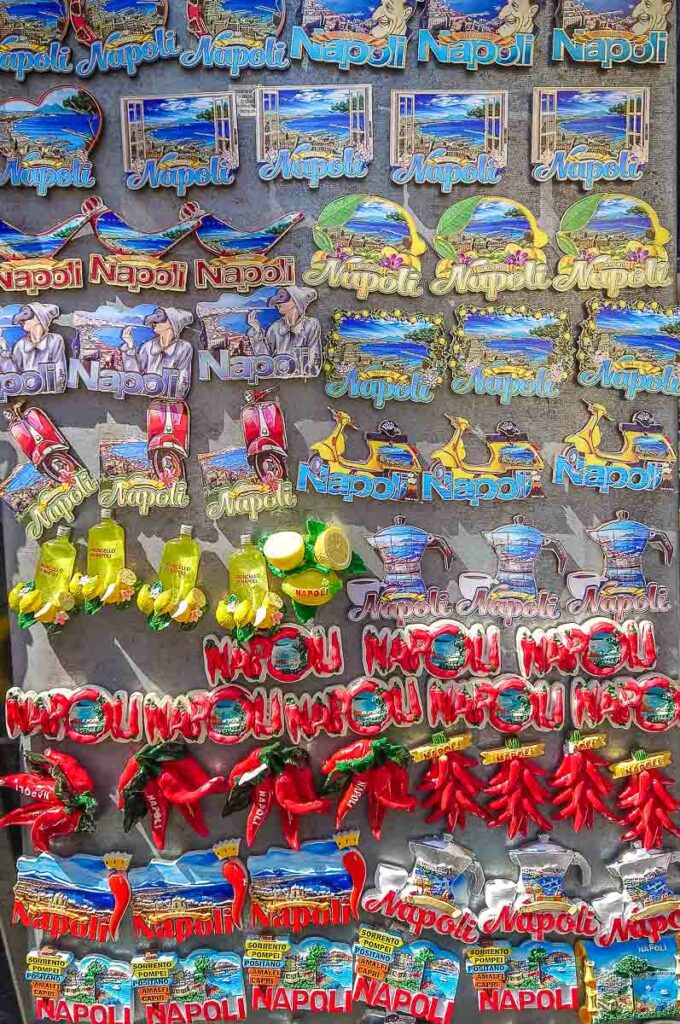
BEST ORGANISED TOURS IN NAPLES
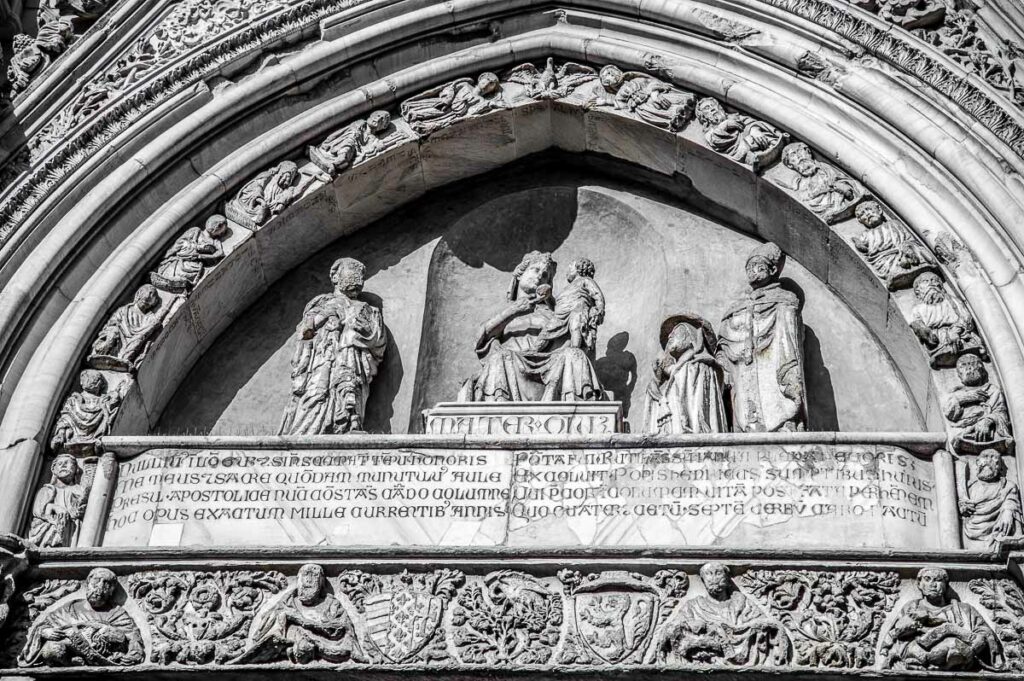
Booking an organised tour in Naples with a reputed tour guide or travel company is a shortcut to getting to know on many different levels this vibrant, stimulating, and often overwhelming city. It’s like stepping through a secret door to discover Naples’ best corners and hidden gems which otherwise may be difficult to come across one by one on your own.
With a millennial history, a rich catalogue of art, delicious local food, and many traditional crafts with outstanding output, Naples is a must-see city in Italy. This is a place that keeps many secrets that it reveals to only those in the know. No matter how many books or guidebooks you may read about Naples before coming here, the City of Pizza, Volcanoes, and Nativity Scenes can still be a shock to the system. You may find yourself ambling through its ancient streets unsure where to head to first and what to delve into next.
It is at this point that an expert local guide or a reputable tour company can be of great help. With a structured approach and offering tours covering specific fields of knowledge or tailored to your personal interests, you can see and experience the maximum of Naples within the shortest amount of time.
Here are some of the best and most highly recommended tours to take in Naples organised by category:
- Sightseeing: Hop-on Hop-off Bus ; Walking Tour with Underground Ruins ; Walking Tour with the Most Famous Monuments
- History: Pompeii with an Archaeologist ; Pompeii and Mount Vesuvius ; Pompeii and Herculaneum
- Food: Street Food Tour ; Do Eat Better Experience ; Secret Food Tour
Alternatively, select directly local tours and activities in Naples on GetYourGuide , Viator , and Tiqets .
Even if you decide against booking a tour and then you change your mind at the last moment, don’t worry! Tour guides can be hired in situ in many museums and sights in Naples. For example, when you visit Herculaneum, you will see the tour guides’ desk next to the entrance.
BEST VISITOR PASSES FOR NAPLES AND CAMPANIA
There are several visitor passes for the city of Naples and the region of Campania in Italy. In general, they cover a period of one, three, or seven days and provide free and discounted access to the best and most popular sights and museums here. Most of them also include free transport either as an included perk or as an add-on option.
The most popular visitor passes for Naples and Campania are issued by the following companies:
Campania ArteCard
Naples Pass
Both offer different options in terms of pass duration and number of free sights covered by each pass. So browsing their websites and choosing the right card for you is worth the time.
On Tiqets you can also find visitor passes just for Vesuvius and Pompeii, too.
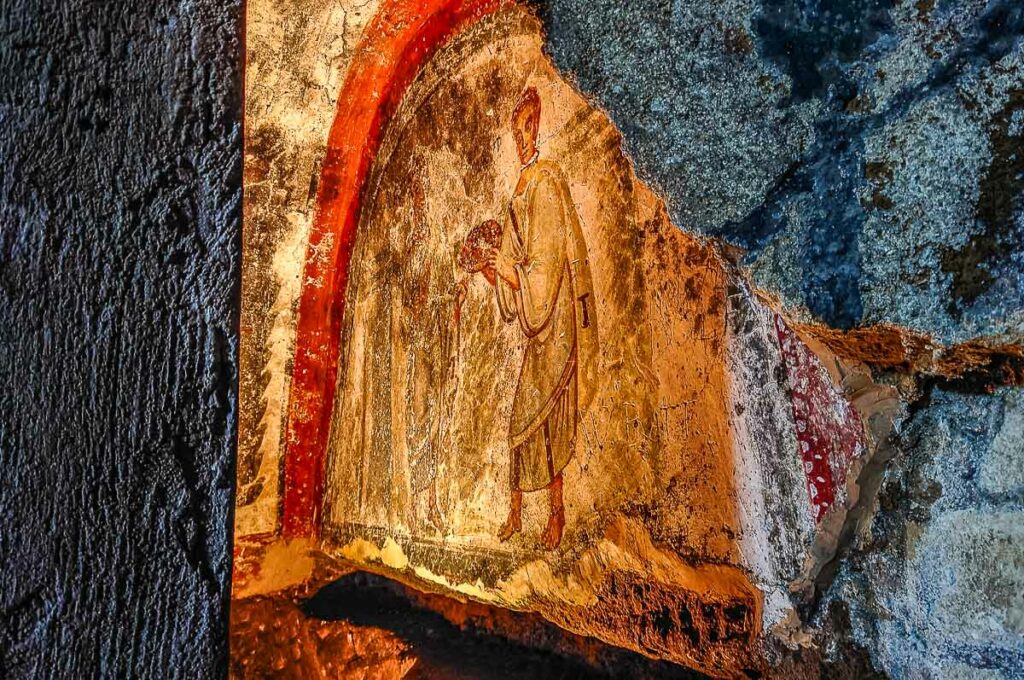
We purchased the three-day Campania Artecard as we wanted to be able to use it on our day trip to the Phlegraean Fields, too. In my personal experience, the card was useful but it had some shortcomings.
Only the seven-day card is physical. The others are virtual. You have to download an app on your phone which provides you with special QR codes to scan every time you use public transport or visit a sight. This meant that we needed to make sure that we had enough battery left at all times and that the internet was working wherever we were.
Often, the QR code wouldn’t scan easily, especially at the train stations, so we had to go find someone to let us in through the barrier. In the process, we would get approached by small-time crooks offering to open the barrier for us in exchange for a small tip.
As far as we understood, children travel for free on the parent’s card if they are under a meter tall. As our child is over a meter, we needed to go buy tickets for her with all the queuing this entailed. I would have loved to be able to pay a bit more for the card but to have my child’s travel on it or simply to have the option to buy a child’s card from the get-go.
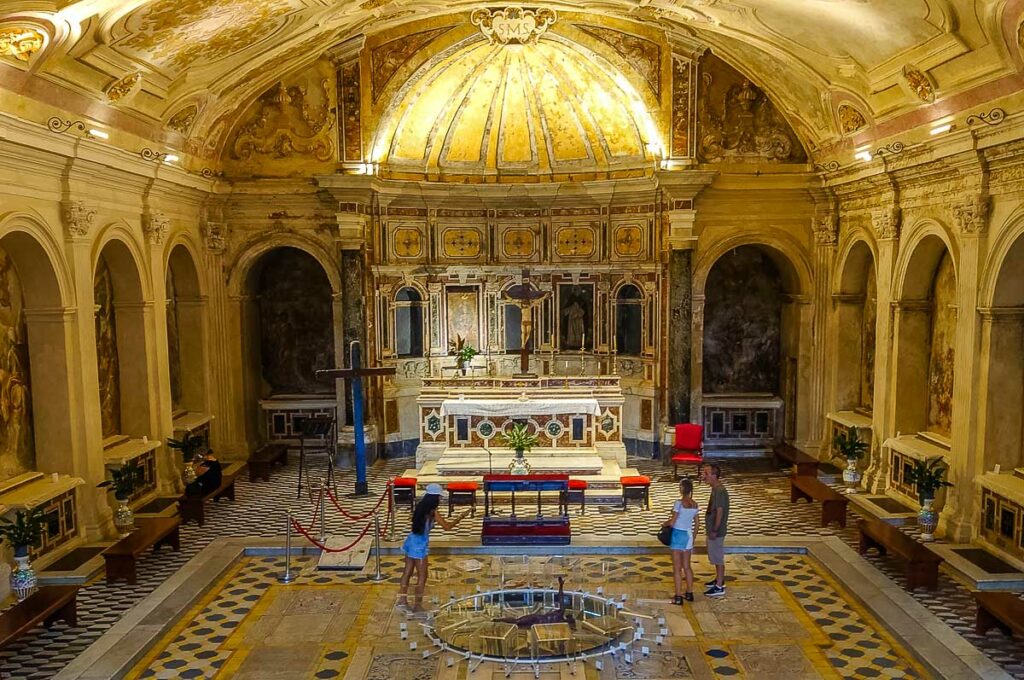
Another thing to have in mind is that the card seems to cover a specific number of days and not a specific number of hours. In other words, no matter how early or how late in the day you activate it, it counts the day of activation as a full day.
Otherwise, the card is handy as it saves you quite a lot of money. Especially, if you plan your visits in such a way that you head to the most expensive sights first. It also allows you to jump the queues at museums and sights which is a great timesaver. The app has a lot of excellent information about the sights and landmarks to see in Naples. This can give you lots of ideas for places to explore which makes your stay in Naples even more exciting.
BEST DAY TRIPS FROM NAPLES
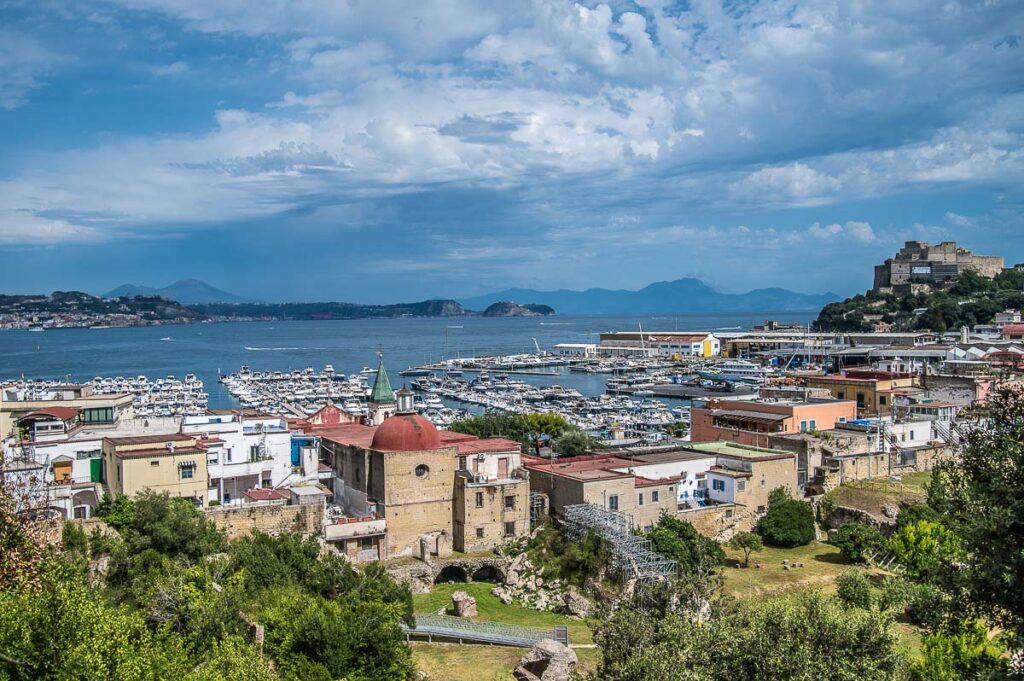
For everything that Naples has to offer, right next door to this vibrant Italian city you will also find an almost overwhelming number of must-see destinations. No matter what you are after – ancient ruins, picturesque towns, coastal villages, diving trips, natural beauty or panoramic views – take your pick from this list:
Ancient Roman Cities and Landmarks – Herculaneum and Pompeii don’t really need an introduction. Destroyed by the eruption of Mount Vesuvius in 79 AD, today the excavations of these two ancient Roman towns are a must-see if you love history and archaeology. If you have time to spare, don’t miss the Virtual Archaeological Museum of Herculaneum and Boscoreale , Oplontis , and Stabiae in the vicinity of Pompeii. Take the Circumvesuviana train and you can easily get from Naples to all of these ancient Roman hotspots by yourself. Alternatively, you can also book this highly recommended day tour which takes in Pompeii and Mount Vesuvius. If you have little time to spare, then this two-hour visit to Herculaneum in the company of an archaeologist is a great option to consider.
Phlegraean Fields ( Campi Flegrei ) – a truly exciting yet little-visited by mass tourists area right next to Naples. Here you will find small towns with fresh seafood, impressive ruins, and volcanic heritage. From the enormous Flavian Amphitheatre and the ancient Roman macellum in Pozzuoli to the Archaeological Park of Cuma and the Piscina Mirabilis in Miseno, this is the best day trip from Naples you have never heard of. I particularly loved the Roman baths in Baiae. The sea here guards the remains of once lavish Roman villas. Protected as part of the Submerged Archaeological Park of Baia, they can be seen as part of a diving or snorkelling trip.
N.B.: If little-known historic sites are your thing, then make sure that you also head to the Archaeological Site of Pausilypon halfway between Naples and the Phlegraean Fields. You can read more about it here .
Islands near Naples: a handful of beautiful islands are a short ferry ride away from Naples. The most famous one of them all is Capri but if you have the time, don’t miss Ischia and Procida. Check ferry timetables and ticket prices at the official websites of the ferry operators SNAV , Caremar , and Medmar . Don’t forget to book a boat tour of Capri in advance for maximum fun during your time on the island.
Amalfi Coast ( Costiera Amalfitana ) – this beautiful stretch of coastline along the Gulf of Salerno is dotted with small towns that are the essence of picture-perfect Italy. Amalfi, Positano and Ravello are the most famous among them and every high season suffer the effects of overtourism. Head there in the low season to avoid the crowds and for a more authentic experience. To simplify your travel arrangements, you can also book an organised day tour . Alternatively, make a plan to discover for yourself the lesser-known corners of the Costiera Amalfitana , for example, Vietri sul Mare and Atrani.
Other destinations to visit from Naples – here in no particular order but all deserving a day trip (or a longer stay) are some more must-see places for you to easily explore coming from Naples: Royal Palace of Caserta , Archaeological Park of Paestum and Velia , and the towns of Sorrento, Benevento, and Gaeta. If you have little time but you want to see the most, then you can book an organised tour taking in Sorrento and the highlights of the Amalfi Coast.
IS NAPLES SAFE?
The question ‘Is Naples safe?’ surely is one of the first things that pop into the mind of any traveller considering a visit to Naples in Italy.
For decades, books, films, and news stories have all presented this vibrant city as a beautiful yet decaying place where danger lurks around every corner. Speaking truthfully, Naples definitely is an edgy city. The consequences of limited financial means are easy to stumble upon even right next to major landmarks. Some areas here seem to experience real penury.
On the plus side, however, I felt that Naples is a friendly city where it was immensely enjoyable to walk around and talking to people felt natural and easy.
Some time ago I used to live in Northern Italy which I got to explore in depth. Yet, I always felt like an outsider and even in the city that my family called home for six years – Vicenza – there were people who refused to talk to me on account that I was a foreigner and others who kept me at arm’s length and took obvious offence to the fact that I would speak to my own child in my mother tongue instead of Italian.
In contrast to this, Naples felt easy to slot into. While I was situationally aware at all times, this didn’t interfere with my feeling relaxed, happy to explore, and at ease to talk to people. We all have been fed with cliches about Italy and some of us may have been left disappointed when some of these cliches didn’t live up to reality. Naples for me lived up to some of the best expectations people may have of Italy – friendliness, ease of communication, and the strive to create beauty in any and all circumstances. It’s a shame that this striking in so many ways city has been experiencing financial deprivation over such a long period of time. This, obviously, has left a deep imprint on its fabric!
The friend of a friend who met us at Naples Airport gave us some safety advice which I found applicable to any other large, lively city in the world. For example, no flashy jewellery, expensive watches, or branded accessories (which was easy for me as I don’t wear any jewellery when I travel), sticking together after dark (we are a family of two parents and a small child, so we tend to stick together when we walk around), and not exploring deserted areas at night (this we don’t do in principle).
Depending on where you come from and what urban environment you may be used to, what you may find unsettling in Naples at first glance are the quantities of rubbish towards the end of the day, the proliferation of graffiti (some of them are rather good), and (in some corners of the city) the obvious signs of people living rough. This is not exclusive to Naples. I live in a rather economically deprived town in England, so locally we have some of these issues affecting the community at large, too.
Before travelling to Naples, I didn’t know what to expect and I had seen all the negative reviews online. I am glad to report that I found Naples a joy to explore. It was stimulating on so many levels and offered such a rich list of things to do that I felt I could return to this city time and time again to get to know it better. Naples is full of life and this was such a wondrous thing to see and experience.
Safety is always a concern when travelling. I am speaking as the almost victim of a violent mugging in a public place in a large European city (not in Italy!), so you can be sure that when I am in a new place, especially with my child and my camera around my neck, I have my head on a swivel.
Naples is a city of great contrasts. Poverty is not conveniently hidden away here. You can see that survival is tough for many people. Beauty and decay occupy the same spaces. So, if you want to spend your holidays in a highly presentable and polished environment, then maybe Naples is not your destination. If, on the contrary, you are looking to see a place that has nurtured life in all its manifestations – from the creative to the destructive – for close to three millennia, then Naples is an excellent choice to consider.
As in all other places, be travel-smart. Keep your belongings close to you, be aware of your surroundings, in control of your abilities, and don’t engage in conversations with overly friendly people who approach you first. They are running a small-time scam where they give you some information and then ask for a tip. And, if you need a good list with lots of common-sense safety tips applicable to all destinations, have a look at this article on my blog.

BEST TRAVEL GUIDES FOR NAPLES

WHAT TO BUY FOR NAPLES

WHAT TO BUY IN NAPLES
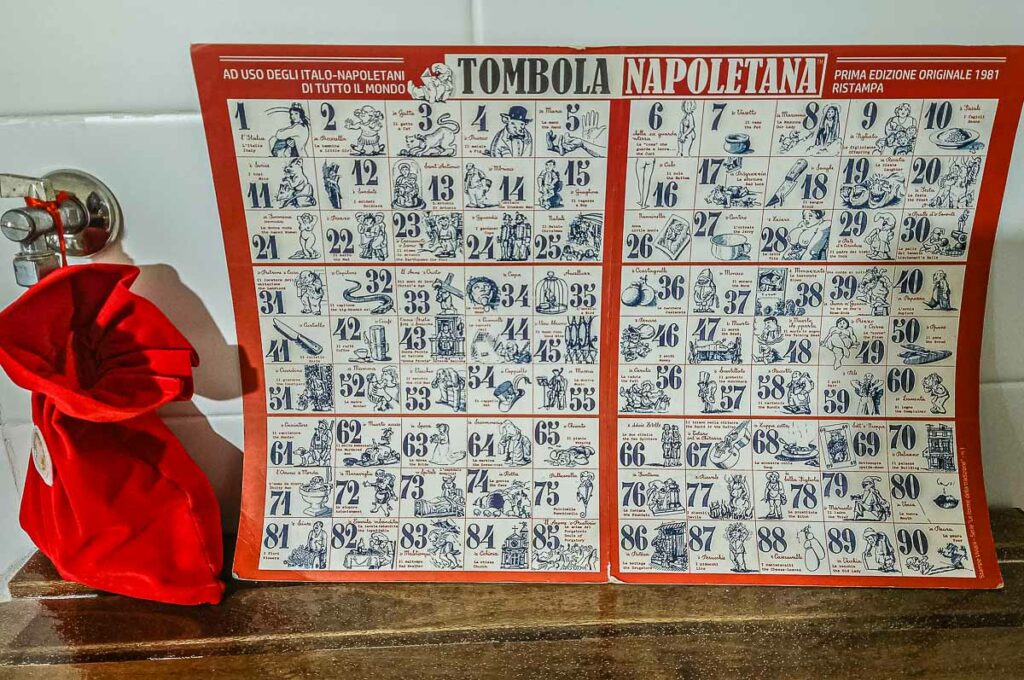
Shopping in Naples is an exciting experience on many levels. From artisan products and luxury goods to treat yourself to heaps of imaginative and colourful souvenirs to take home for family and friends, you will be tempted to spend, spend, spend time and time again.
Artfully arranged shelves and windows tempt you with handmade Nativity scenes , hand-painted Neapolitan tambourines, beautiful ceramics, hand-carved cameos , antique books, and so many more weird and wonderful, unusual and eclectic, rare and irresistible things.
Prices accommodate every budget! So, here are some cool things to buy in Naples and some of the best local makers to purchase them from:
Handmade Neapolitan Nativity scenes from Fratelli Capuano , La Scarabatola , and the shops along Via San Gregorio Armeno . Handmade Nativity scenes (known as presepe or presepio in Italian) are an intrinsic part of Naples’ artisan heritage.
Corno portafortuna (also known as cornicell o ) – you will see these chilly-like horns all around Naples. Traditionally red, nowadays they come in all sizes, colours, and variations. The locals believe that this Neapolitan amulet protects you and brings you good luck. For it to work, however, it needs to be handmade and given to you as a present. Apparently, you can’t just buy your own! D’Auria Artigiani make a large selection of cornicelli . Otherwise, you will find these amulets all over Naples.
Cameos by Gerolomini Gallery – this elegant shop has a wide selection of beautiful handmade cameos and coral jewellery. It also has a small museum dedicated to the delicate art of cameo-carving which is typical for the area around Naples.
Handmade bags and purses by Jiji Lovemade – I fell in love with Jiji’s colourful, vibrant bags during my week in Naples this summer. With beautiful patterns, they are both practical and elegant, perfect for city living and weekend travel.
Neapolitan tombola – a cheeky lotto-like game that Neapolitan families play together, especially at Christmas. Many small shops along Spaccanapoli and Via San Gregorio Armeno sell it.
Artisanal chocolate by Gay-Odin – this over a century-old Neapolitan company makes high-quality chocolates and chocolate-based products.
Cucumella – this traditional Neapolitan flip pot produces smooth and strong coffee. With its elongated design, it is a great conversation starter and is a great gift for the coffee lover in your life.
BEST BOOKS ABOUT NAPLES

5 CURIOUS FACTS ABOUT NAPLES
1. Naples has 52 patron saints – one for each week of the year. The city’s main patron saint is San Gennaro with whom napoletani signed a notarised contract on 13th January 1527 stipulating that the saint was to protect them from plagues and eruptions of Vesuvius.
2. In Naples, you can see not just the worldwide famous sculpture of the Veiled Christ , but also the sculpture of the Veiled Son. Both are carved from a single block of marble and the latter is the work of Jago – an Italian sculptor currently residing in New York. The Veiled Christ is in the Sansevero Chapel. The Veiled Son is in the Basilica of San Severo fuori le Mura. Both are a must-see!
3. Via di San Gregorio Armeno (also known as Via dei Presepi ) is Naples’ famous street that houses the workshops of the artisans who make the famous Neapolitan presepi . These intricate Nativity scenes include dozens of figurines and represent the Holy Family in the stables often surrounded by purely Neapolitan characters and settings. Curiously, millennia ago, this same street was lined with workshops producing terracotta figurines which people bought and left as votive offerings at the adjacent temple of Ceres – the Roman goddess of agriculture.
4. Naples’ historic city centre is one of the largest in Europe. Its many layers – from the deepest catacombs and underground water cisterns to its tall obelisks and church domes covered with majolica tiles – are the result of 27 centuries of history. Its surface encloses 1,700 hectares, 1,021 of which were declared a UNESCO World Heritage Site in 1995!
5. Napoletani are football-mad and are particularly obsessed with Maradona. Hailing from Argentina, the legendary footballer played for S.S.C. Napoli from 1984 to 1991 and took the Neapolitan team to the top of the game. To this day, Maradona has a god-like status in the city. Everywhere you go you will see his face on flags, murals, and even packets of crisps.
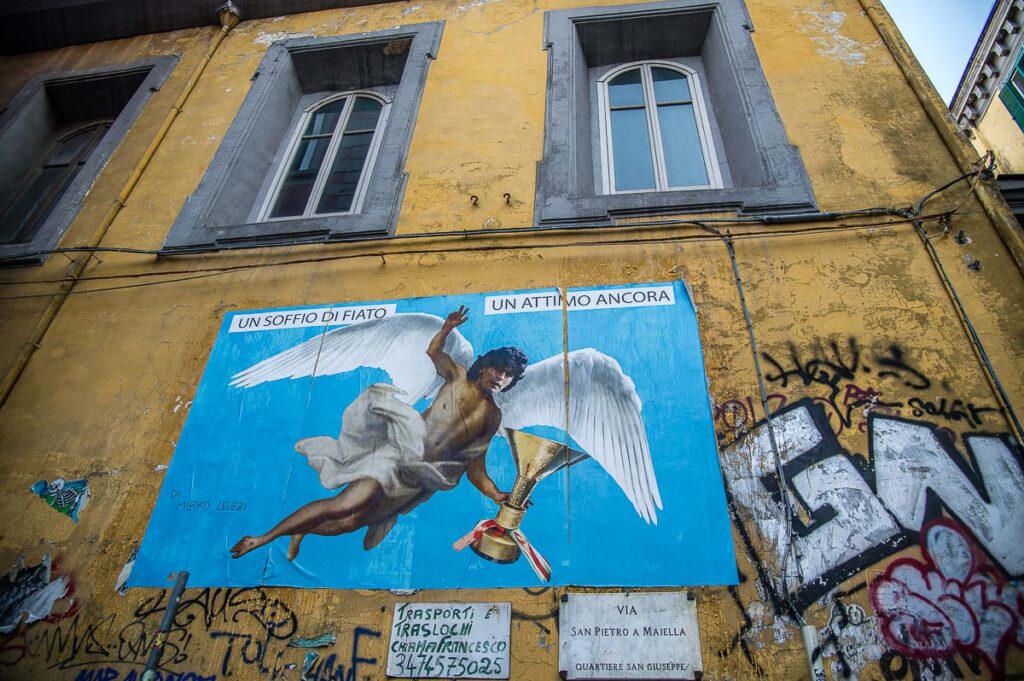
MY TOP 5 TIPS FOR NAPLES
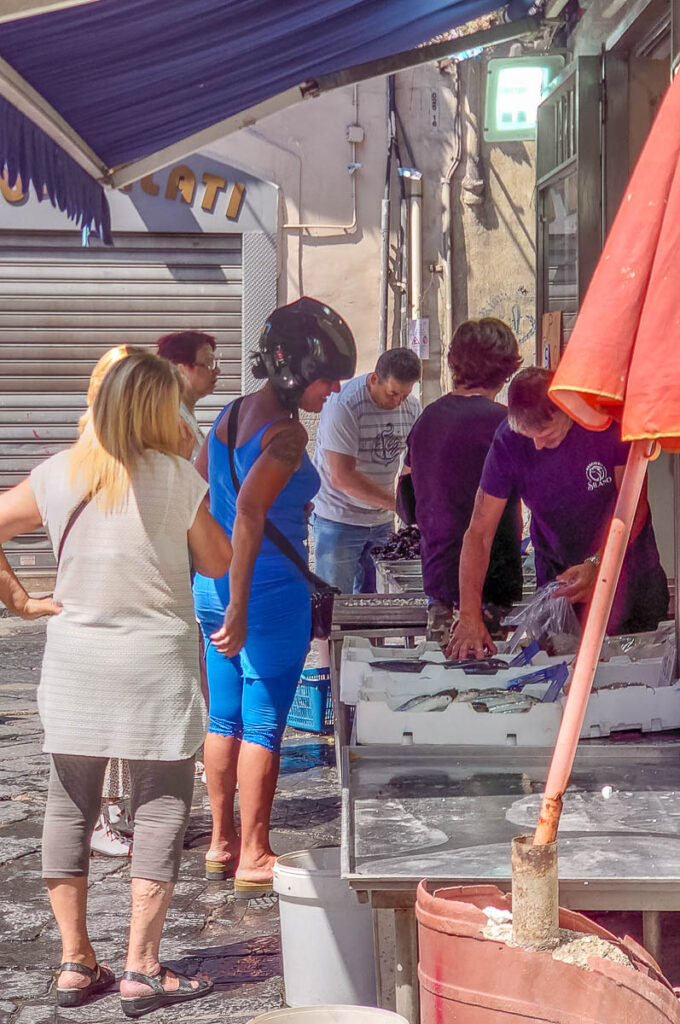
- Explore Naples area by area. This is a large and exciting city with lots to see and do. Group the sights you want to visit based on their proximity to one another instead of exhausting yourself by running all over town every day of your stay.
- Where possible, book entry tickets and tours in advance. This will minimise waiting times and will allow you to make the most of your day. Tiqets is a great resource for tickets for Naples’ best museums and landmarks. Viator is my favourite tool for booking guided tours.
- Bring your appetite. Naples is a city where eating is akin to an elevated cultural experience. From bakeries and family-run trattorias to restaurants with sea views and unmissable gelaterias, Naples runs on excellent food. Don’t skip a meal!
- Embrace Naples’ joy of life! This is a vibrant city that stimulates the senses on many different levels. Let it get under your skin!
- Indulge in people-watching. Naples is as much about its historic and artistic heritage as it is about its people. Take time every day to just stop and take in little scenes of daily life. Many napoletani are worthy of a book and you can read their story on their faces, in their gestures, and in a conversation with them.
5 THINGS NOT TO DO IN NAPLES
- Don’t expect to see the whole of Naples in a day or two. This is a large city with lots of major sights and plenty of hidden gems.
- Don’t hire a car. Traffic in Naples is intense, the driving style is incredibly assertive, and the historic quarters are akin to mazes of narrow streets. Free parking spaces can be very difficult to come across, so parking needs to be organised in advance. Most importantly, Naples has several ZTL’s (limited traffic zones) which are accessible only with special dispensations (for example, local residents and hotel guests) and more or less cover the areas with the biggest concentrations of landmarks and sights.
- Don’t buy counterfeit luxury and designer goods . Heavy fines are in place for tourists tempted to buy knock-offs which you may see being sold from sheets spread directly on the ground around town.
- Don’t be negative about Naples and/or its icons. As with every large city with a millennial history, Naples has its own specific problems which are easy to spot. The least a visitor to the city can do is to show respect to the people who have to deal with them on a day-to-day basis. Neapolitans have also elevated certain personalities to a god-like status. Disrespect is not tolerated no matter how well-based your opinion about them may be.
- Don’t accept unsolicited offers for help. Most often than not they will be followed by a request for a tip. At busy spots around town, for example, train or metro stations, you may be approached by a smiley person eager to explain how to get from point A to point B. Don’t engage! If you really need directions, it’s best to ask at the ticket office or a uniformed employee.
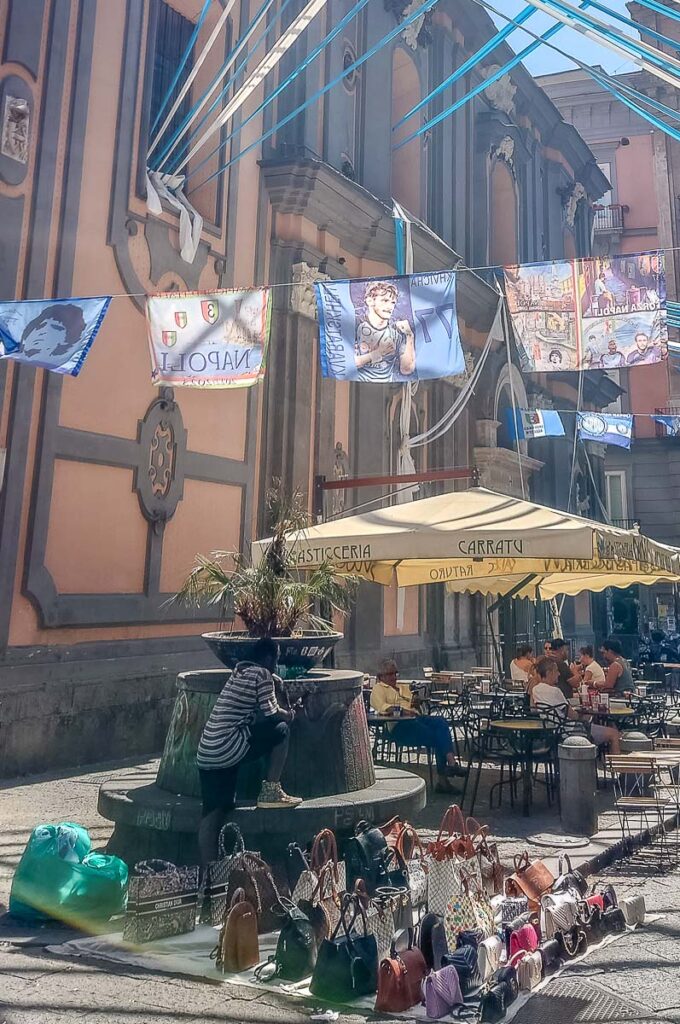
MORE INFORMATION ABOUT ITALY
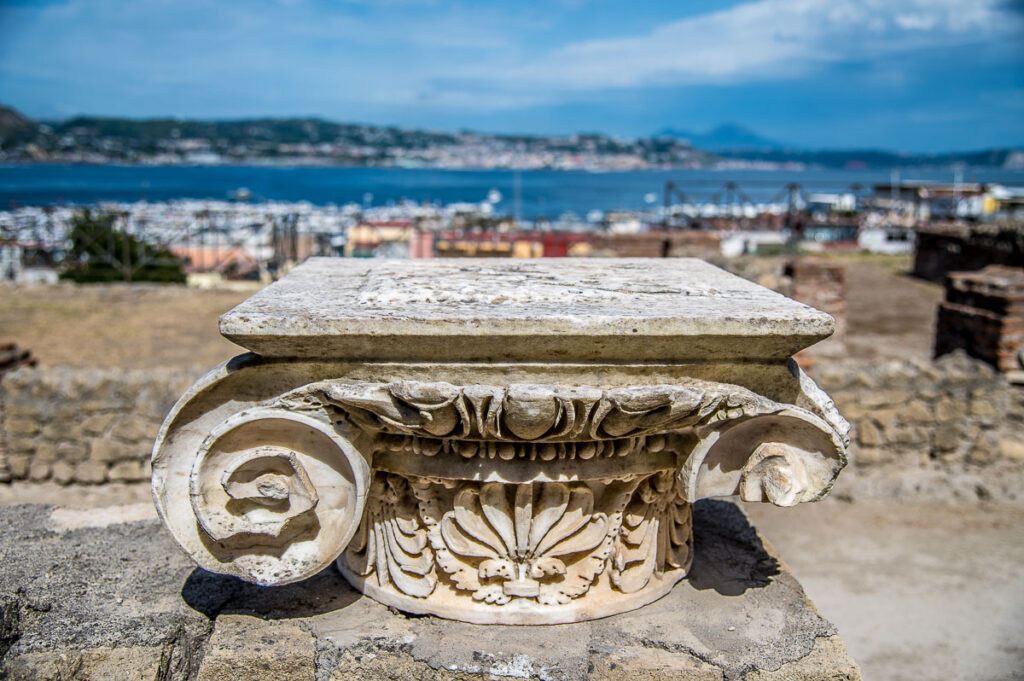
I have been blogging about travel in Italy for almost ten years now providing detailed and first-hand tried and tested information about the best things to do in this beautiful country. It’s all based on my close to twenty years of visiting Italy solo and with my family. Six of them, we actually spent living in Vicenza in the north of the country .
If you are after in-depth researched and illustrated with dozens of original photos articles about Italy, have a look at the following categories and blog posts:
- Italy – a full list of all my blog posts about Italy
- 10 Reasons to Visit Northern Italy
- Veneto , Trentino , Emilia Romagna , Umbria – full lists of all my blog posts about these Italian regions
- Venice , Padua , Lake Garda , Lake Como , Milan – full lists of all my blog posts about these must-see destinations in Italy.
In addition, right at the end of this page, you will find a list with links to some of my most popular blog posts about many beautiful and exciting cities, towns, and regions to visit in Italy. So, just scroll down and then click on the ones you want to know more about.
Finally, Italy’s official tourism website is a great source of the latest news about travel in Italy. Otherwise, this is one of the best guidebooks about Italy.
THANK YOU FOR READING
Have a look also at my ultimate travel guides for Venice , Lake Como , and Lake Garda .
For more useful information like this, please, like my blog’s page on Facebook and Instagram and subscribe to my strictly no-spam newsletter.
Email address:
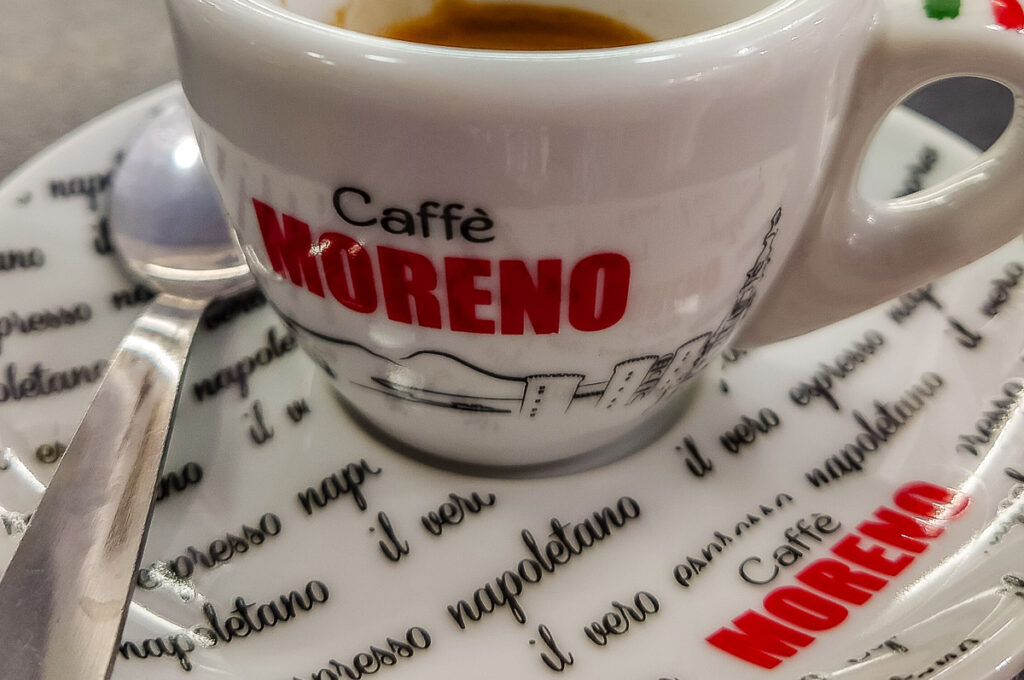
TRAVEL TOOLS
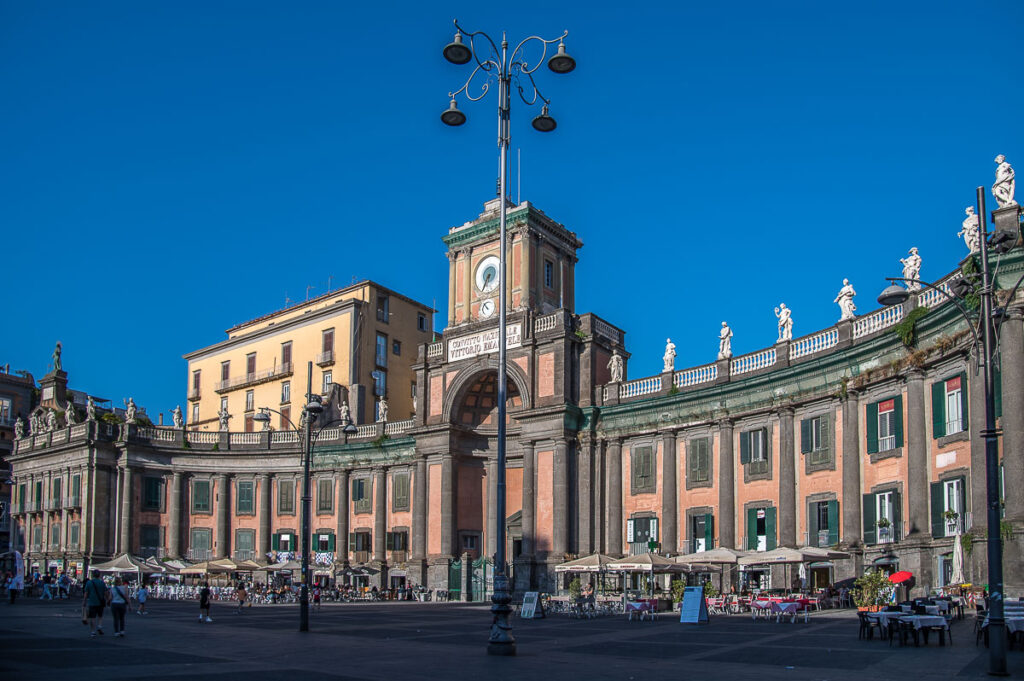
Get Ready for Your Trip to Naples in Italy
Get a guidebook from Amazon. Buy plane tickets , train tickets , and bus tickets through Omio. Research accommodation on Booking.com. Select local tours and activities on GetYourGuide , Viator , and Tiqets .
EVEN MORE HELPFUL INFO ABOUT ITALY FOR YOU
Best of Italy: Italian Piazzas , Italian Markets , Accommodation for Every Budget , Best Times to Visit Italy , Italy in Summer , Italy with Kids Italian Food: Best Italian Food Gifts , Cheap Italian Food , Rules of Italian Breakfast , Italian Breakfast Foods Italian Coffee: Italian Coffee Culture , Italian Coffee Drinks , History of Coffee in Italy Christmas in Italy: Fun Facts , Things to Do , Italian Nativity Scenes , Panettone , Christmas Guide Northern Italy: Best Cities to Visit , Major Airports , Reasons to Visit Lake Como: Ultimate Travel Guide , Best Towns , Best Things to Do , How to Get to Lake Como , Milan to Lake Como , Best Airports , Photos of Lake Como Lake Garda: Ultimate Travel Guide , Best Towns , Desenzano del Garda , Lazise , Riva del Garda , Malcesine , Torri del Benaco , Punta di San Vigilio , Campo di Brenzone , Borghetto and Valeggio sul Mincio , Map of Lake Garda , Getting Around Lake Garda , Lake Garda with Kids , 8 Best Airports , Venice to Lake Garda , Verona to Lake Garda , Milan to Lake Garda , Bologna to Lake Garda Venice: Ultimate Travel Guide , Essential Tips , Things to Do , Major Landmarks , Hidden Gems , How to Navigate Venice , Venice in a Day for Art Lovers , Train Stations , Nearest Airports , Best Tours , Beaches of Venice , Quotes about Venice , Boats in Venice , Haunted Venice , Day Trips from Venice , Arco del Paradiso Verona: Things to Do in One Day , Verona Opera Festival , Day Trips from Verona , Romeo and Juliet Itinerary , Verona to Venice , Verona to Milan Padua: Things to Do in One Day , 101 Facts About Padua , 10 Reasons to Visit Padua , Day Trips from Padua Vicenza: Things to Do , Day Trips from Vicenza , Best Museums , The Beauty of Vicenza Veneto: Top Places to Visit , Unique Adventures , Most Colourful Places , Mysterious Places , Most Beautiful Lakes , Reasons to Visit , Main Cities , Prettiest Small Towns , Most Beautiful Villages Lombardy: Best Cities and Towns , Reasons to Visit , Brescia Friuli Venezia Giulia: Venzone , Most Beautiful Villages Emilia Romagna: Bologna , Ravenna , Comacchio , Most Beautiful Villages Marche: Reasons to Visit , Gradara , Frasassi Caves , Temple of Valadier Umbria: Reasons to Visit Perugia
Things to do in Naples Italy: attractions
Top 25 tourist attractions, sightseeing and what to do in naples italy.

Top 25 best things to do in Naples (Napoli), sightseeing and all must-see sights, tourist attractions and landmarks. What to do, the highlights and best places to visit in Naples Italy?
What to do in Naples Italy: Attractions & Sightseeing
What to see in Naples Italy ? The city in the south of Italy initially exudes chaos in everything from filthy streets to the traffic, but beautiful museums and churches are often hidden behind the facades of the dilapidated buildings. You can easily spend several days to visit all the sights, because not only famous places such as Pompeii , Herculaneum and the Naples underground are worth seeing, but the city of Naples offers you much more than that. The city's history is so closely linked to the present, that unique landmarks can be found on several places in the city. On the list of ' Things to do in Naples ' there a lot of impressive churches that are unique in the world such as the Duomo and the Gesù Nuovo.
In addition, Naples is rich of museums , of which the themes vary widely. You have the national archaeological museum which is very famous, but also the beautiful museum of Capodimonte. In addition, the city has special places such as Cimitero delle Fontanelle, an old cemetery with skulls and the impressive Cappella Sansevero. The region of Naples is also worth a visit, where you can stroll around in small villages of the Amalfi Coast. Or visit islands such as Capri and Procida, which are located off the coast of Naples. Click on one of the highlights below for more information about the Naples tourist attractions and sightseeing . View our ' 25x What to do in Naples? ':
25x Best things to do in Naples
Popular activities in naples italy, where are the landmarks in naples.
Not all the highlights and landmarks of Italian Napoli are within walking distance of each other, so you have to rely on public transport for some tourist attractions. Where are the highlights, tourist attractions and places of interest in Naples? You can zoom in further on the attractions in this Italian city via the map with sights below:
FAQ Tourist Attractions Naples Italy
The main attractions around Naples are the archaeological areas of Pompeii and Herculaneum, which were made famous by the eruption of the adjacent Vesusvius volcano. In the city of Naples, the beautiful chapel Cappella Sansevero, the underground Naples of Napoli Sotterranea, the catacombs of San Gennaro and the archaeological museum are the most visited places of interest. In this article you can read all about the Top 25 of Naples attractions .
Only a short drive from Naples are the excavations of Pompeii and Herculaneum, but you can also choose to visit the Mount Vesuvius. South of the city is the beautiful Amalfi Coast with picturesque places like Sorrento and Positano. You can also easily visit beautiful islands such as Capri, Ischia and Procida by ferry. More info about these places of interest in the naples area .
Under the city of Naples is a vast expanse of caves, passageways and ancient catacombs. With a guided tour you can see the remains from the Roman era as well as from the 2nd World War. More info about Naples underground .
The most famous museum is the Archaeological Museum with many excavations from Pompeii and Herculaneum. In addition, the museum of Capodimonte and the museum of the Cappella Sansevero are frequently visited. In this article you can read all about the museums in Naples .

Partner of: Reykjavik attractions and Venice attractions
Most visited attractions
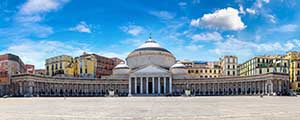
Top 25 Things to do in Naples
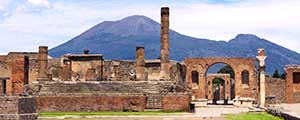
Pompeii Tickets & Tours
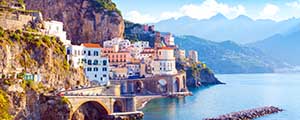
Day trips from Naples
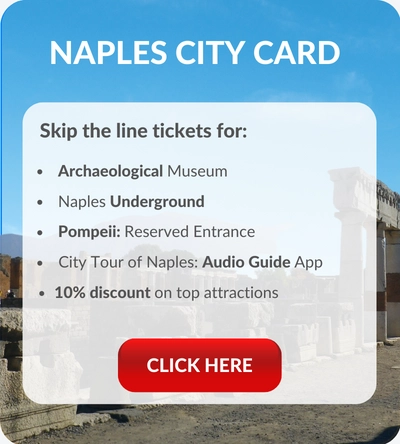
The 30 best things to do in Naples Italy – Everything you need to know
What’s in this article
When people mention Italy, the first cities that spring to mind are Venice, Rome , Florence , and Milan , all of which are beautiful. But Naples is different.
Naples is a city of contrasts. It combines the urban and the rural, the ancient and the modern, the cultural and the commercial.
Naples is a wonderful city where art and history coexist with city traffic and people’s screams.
It’s a city with a thousand facets: chaotic, folkloristic, colorful, energetic. I could go on and on with adjectives, but to fully appreciate it, you must be able to observe it, understand it, and avoid being swayed by bias.
Naples is one of the world’s most fascinating cities, it’s rich in monuments, history, and culture.
It’s also one of the oldest cities in the world.
Its historic center is Europe’s largest, and it has been designated a UNESCO World Heritage Site.
When you consider that you can eat really well while spending less than the national average, this city becomes the ideal destination to include on your itinerary if you’re a foodie like me and are willing to discover the best pizzerias.
But of course, pizza is not the only thing you can eat in Naples, nor the only attraction Naples has to offer.
If you’re stuck for ideas on what to do in this incredible city, I’ve got you covered.
There are so many tourist attractions in Naples, and here I’ll break them down for you.
If you’re looking for the best things to do in Naples, read on!
Things to do in Naples: The main attractions
Naples, as previously stated, is a city rich with sights to see. It’s an extremely large city, and you could spend weeks exploring all the nooks and crannies of this fantastic place.
There are hundreds of historical sites, museums, galleries, gardens, and churches that offer a huge variety of activities for you to enjoy.
To get a sense of this incredible and colorful city, you should know that Naples is made up of an infinite network of streets and alleys that connect the city’s many neighborhoods (quartieri). The neighborhoods are sections of the city, and each has its own personality that will not fail to surprise you.
Here, I’ll be focusing on some of the major tourist attractions in Naples, beginning with the historical center and the many amazing sights that you can’t afford to miss during your stay here.
The Historic Center (Centro Storico)
Naples’ historic center is the largest in Europe and the city’s most touristy, authentic, and historically rich area. It has been designated a UNESCO World Heritage Site in 1995.
It’s unquestionably the best place to begin exploring the city, maybe with a guided tour , or even a free tour !
Sample the city’s best pizzerias on Via Dei Tribunali
The historic center is a maze of colorful and bustling streets steeped in history and tradition.
Here are some of the most famous and popular streets in the city, such as Via dei Tribunali, which is one of the busiest streets in the old town.
It’s a street lined with churches and monuments from the Gothic, Renaissance, and Baroque periods.
Here you will find the entrance to “Napoli Sotterranea” (Naples underground) as well as several stores selling local handicrafts, fryers, and the city’s oldest pizzerias.
As a matter of fact, people looking for authentic Neapolitan pizza should come here.
Stop Into The Duomo di Napoli (Naples Cathedral)
Walking along Via dei Tribunali, you will come to Via Duomo, where you will see the cathedral dedicated to Santa Maria Assunta, a 13th-century cathedral that is the Duomo of Naples.
The cathedral’s interior is a mix of Renaissance and Baroque styles.
Here you’ll find the Basilica of Santa Restituta, the Baptistery of San Giovanni in Fonte, the Chapel, and the Museum of the Treasure of San Gennaro, which preserves the blood of Naples’ patron saint.
Did you know that September 19, the day we commemorate San Gennaro, Naples’ patron saint, is a significant date for Neapolitans?
Three times a year, a vial containing what is supposed to be the dried blood of St. Gennaro is displayed in the city’s cathedral, where people gather to pray and witness it liquefy.
The event is referred to as the “Miracle of San Gennaro.”
While it is still considered a bad omen, it is regarded as less serious on the other two occasions (December 16th and the Saturday before the first Sunday in May).
However, if the blood doesn’t liquefy on the saint’s feast day, September 19th, people get more concerned since it is a bad omen for the city.
Entrance to the Cathedral of Naples is free and available at the following times:
Hours: 8:30 a.m. to 12:30 p.m. and 2:30 p.m. to 7:00 p.m. daily
If you’re willing to visit the museum of the Treasure of San Gennaro, you’ll find updated information here .
Visit Napoli Sotterranea (Naples Underground)
Continuing on Via dei Tribunali and a few steps from San Gregorio Armeno, you’ll find the entrance to Napoli Sotterranea (Naples Underground). It’s in Piazza San Gaetano, n.68.
A local expert guide will accompany you on the underground journey, rich in history and linked to the rediscovery of a rare and unique heritage.
You’ll walk among the ruins of the ancient Greek-Roman aqueduct, pass through World War II air-raid shelters, and see the War Museum and the Greek-Roman Theater.
The guided tour lasts about two hours, and I recommend that you arrive early because the line is often very long. Reservations are not required for groups of less than ten people.
The cost of the ticket is ten euros per person.
The hours of entry are from 10 a.m. to 6 p.m.
Excursions leave every hour with an Italian guide and every two hours with an English guide. More info here .
Grab A Souvenir On Via San Gregorio Armeno, The Street Of Cribs In Napoli
Via San Gregorio Armeno is a well-known street known as “Via dei Presepi” (street of the cribs).
This street is the heart of Neapolitan crib art, which is displayed and sold all year.
The best way to explore this area is to get lost in the colorful streets, discover the local shops, and be immersed in the unique atmosphere.
Avoid visiting Via San Gregorio Armeno during peak tourist hours, as it can become overcrowded.
Visit the Ospedale delle Bambole (The Dolls Hospital)
One of Naples’ most unique attractions, Ospedale delle Bambole (Hospital of the Dolls), is located just a short distance from Via San Gregorio Armeno (the Crib Street).
It’s on Via San Biagio dei Librai, also known as “Spaccanapoli,” the street that perfectly cuts Naples in two from north to south.
Since 1800, it has been caring for children’s dolls and toys from all over Naples and Italy, carrying on a unique craft tradition.
Aside from the workshop, you can also visit the small museum dedicated to a narrated multimedia experience that will introduce you to this fantastic world.
Visit the Cappella San Severo and The Cristo Velato
The Chapel of San Severo, located in the heart of Naples, just a few steps from Via Dei Tribunali, is one of Italy’s internationally recognized jewels of artistic heritage.
What makes this chapel famous is the wonderful masterpiece of the “Cristo Velato” (Veiled Christ), a sculpture made in 1753 by Giuseppe Sanmartino.
The work that depicts Jesus Christ, covered by a transparent marble shroud, is carved from a single block of stone, without the help of any alchemy, as it was once thought.
It’s regarded as one of the world’s greatest sculptural masterpieces, both for its beauty and for the artist’s use of marble to achieve the veil effect.
To visit the San Severo Chapel, you need to make a reservation well in advance.
Here’s a link to all of the information.
Stroll down Spaccanapoli in Old Town
As previously mentioned, Spaccanapoli is a long street in Naples’ historic center that cuts the city in half.
It’s the heartbeat of the city, some of the city’s most important churches and chapels can be found along and around the street.
The Monastery and Church of Santa Chiara, the Church of Gesù Nuovo, and the complex of San Domenico Maggiore are all located here.
A Spaccanapoli tour is a journey through the city’s thousand-year history and is certainly one of the best things to do in Naples.
Along with the old buildings and churches, you will find tales and the unique scents of Neapolitan food.
There is no other location in the city that will give you a better understanding of the soul of Naples.
Spaccanapoli is the essence of Naples.
Admire intricate designs at the Chiostro di Santa Chiara (Santa Chiara’s Monastery)
One of the things to do in Naples, Italy, for history buffs and art lovers, is visit the Monumental Complex of Santa Chiara, also known as “The Chiostro di Santa Chiara.”
The Complex is located in the city’s chaotic center, but away from the city’s hustle and bustle. Here you will find an atmosphere of peace and calm.
The complex was built in 1310 at the request of King Robert of Anjou and his wife, Sancha of Majorca. It also includes a church with a simple facade and an ancient pierced rose window.
The enchanting garden’s avenues are lined with blossoming orange trees and pillars covered in brightly colored majolica tiles.
The majolica pillars are linked together by seats depicting scenes from daily life of the time. The walls of the cloister’s four sides are completely covered in 17th-century frescoes.
Stop Into The Chiesa Del Gesù Nuovo
The Chiesa del Gesù Nuovo is one of Naples’ most scenic and elegant churches, built at the end of the 1500s. It is located in the Piazza del Gesù, directly across from the Monumental Complex of Santa Chiara.
The church is one of the things to do in Naples because of its unique facade made of diamond-shaped ashlar.
In addition to the church, which I recommend you visit, there are also beautiful noble palaces in Piazza del Gesù, such as Palazzo Pignatelli di Monteleone, which was built in the sixteenth century, and Palazzo Pandola.
At the center of the square stands the 30-meter-high Immaculate Conception obelisk.
Stroll Along Via Toledo & Visit Toledo Metro Station
A walk through Via Toledo is another stop that should be added to your list of the best things to do in Naples.
It’s a famous street in Naples with shops, restaurants, and cafes on both sides.
Along with Corso Umberto, it’s ideal for those looking to do some shopping.
Do not miss a visit to the Toledo metro station, which has been dubbed “the most beautiful station in Europe” by the Daily Telegraph.
It was built in 2012 and designed by Spanish architect Oscar Tusquets.
You’ll feel as if you’re in an underwater world thanks to Robert Wilson’s work “Relative Light,” and you’ll be amazed by the extraordinary play of light in the color range of blues.
To be honest, I believe that entering any of the Naples metro stations, also known as the Art Metro, is like entering a real museum of contemporary art.
At each station, you’ll find the work of a contemporary artist, and you can admire them with a metro ticket, only €1.10.
Can you believe it?
Stroll Through The Spanish Quarters (Quartieri Spagnoli)
The neighborhood around Via San Gregorio Armeno has long been a hub of Neapolitan life, and it’s an ideal place for a leisurely walk.
Here you can find craftsmen working alongside churches, palaces, and museums. (You’ll also spot plenty of antiques shops.)
When you’re done strolling, refuel at one of the many bars & pizzerias lining in this area.
Shop in style at Galleria Umberto I
The Galleria Umberto I is a shopping mall and leisure complex located in central Naples, Italy.
The Galleria was built by king Umberto I of Italy and was opened to public on May 19, 1889.
It was designed by architect Gaetano Genovese along with engineer Giuseppe Lucchini who were also responsible for designing Milan’s Galleria Vittorio Emanuele II, another early 20th century shopping mall.
Tour The San Carlo Opera House
The San Carlo Opera House in Naples was built in 1737 at the request of King Charles III of Bourbon, and its foundation precedes the Scala theater in Milan by 41 years and the Fenice Theater in Venice by 55 years, making it Europe’s oldest theater and one of the largest in Italy.
Since that time, it has become one of Italy’s most famous and treasured theaters.
Tours are available every day of the week, with guided tours available from 10.30 a.m. to 17.00 p.m.
Stroll Around Piazza del Plebiscito
Piazza del Plebiscito is Naples’ largest square.
It is partially surrounded by a large semicircular colonnade, from which emerges the neoclassical dome of the basilica of San Francesco di Paola, which is located directly across from Naples Royal Palace, which has statues of the monarchs of Naples on its façade.
While you’re in the area, you could chill off at “Caffè Gambrinus,” an Art Nouveau café with sculptures and really elegant paintings.
Walk Through The Royal Palace Gardens
After the break, you could spend a few hours walking through the Royal Palace of Naples’ gardens and courtyards, which are located near the large Piazza del Plebiscito.
Originally, only royals and their guests were allowed inside its gates, but it’s now open to anyone who wants to wander along tree-lined pathways or enjoy postcard-worthy views of Mount Vesuvius and the Gulf of Naples.
Visit The Iconic Castel Nuovo (Maschio Angioino)
After seeing the royal palace, walk around the perimeter to the national library and then to the Castel Nuovo, or Maschio Angioino, as it is known locally, which reflects the various rulers of Naples.
It was built in 1279–82 by Charles I of Anjou and expanded by Alfonso I of Aragon, who added a Triumphal Arch between 1453 and 1467 to celebrate his victorious entry into the city.
The hall is now used for events and expositions, but it can still be seen at times.
Also open are the southern courtyard, the Charles V Hall, and the Sala della Loggia.
Unwind on Lungomare Caracciolo
It’s time to unwind on the seafront along Via Partenope and Via Caracciolo, taking in one of the world’s most unique promenades.
Along the way, you’ll pass by the Fountain of the Giant and shortly arrive at Borgo Marinai, where you’ll see Castel Dell’Ovo.
Admire Castel Dell’Ovo & Borgo Marinari
Castel Dell’Ovo is the oldest castle in Naples, dating back to the 12th century, is perched atop a small island-turned-peninsula of Megaride and overlooks the Gulf of Naples.
Today, it is home to the Campania Regional Direction for Cultural Heritage.
In addition to Castel Dell’Ovo, on the Megaride’s islet, there is also a small marina known as Borgo Marinari, which is very popular with locals during the summer for its sea breeze and drink options.
Borgo Marinari has a plethora of restaurants and bars with breathtaking views of the Gulf of Naples from their terraces.
The entrance to Castel dell’Ovo is free, but it’s often closed for private events.
Explore The district of Chiaia
Chiaia is the city’s most elegant area, not only for its art, historic buildings, and luxury hotels, but also for its clubs, lounge bars with a wide range of aperitifs, and luxury stores.
It’s bounded by Via Toledo, Piazza del Plebiscito, and the waterfront, also known as the Mergellina area.
Walking through this neighborhood is definitely one of the best things to do in Naples.
While you’re in this area, look for Palazzo Mannajuolo, which is a private Art Nouveau building, and be amazed by its staircase, which is also one of Naples’ most photographed “hidden” views.
Go beneath the surface at the Galleria Borbonica
If you have time, don’t forget to stop by the Bourbon Tunnel in via Domenico Morelli.
It’s an ancient passage with a fascinating history and a one-of-a-kind collection of abandoned cars and motorcycles from the 1940s, 1950s, and 1960s, as well as statues and relics from World War II that have been discovered inside the gallery and can be seen during guided tours.
There are several tours to choose from; I’ve included a link to the official website for more details.
Posillipo
Posillipo is a residential neighborhood on a hill overlooking the Gulf of Naples.
Here, you may discover a different Naples, one of unparalleled natural beauty and relaxation.
There are various palaces in Posillipo, including Palazzo Donna Anna, as well as very magnificent villas, such as Villa Rosebery, one of the three official residences of the President of the Italian Republic.
Here you can also find the famous Villa Volpicelli, or Villa Palladini, which became well-known among locals and Italians thanks to the Italian television drama, “Un Posto al Sole.”
I also recommend you go to the Gaiola archaeological park, the Baia di Trentaremi, and the spectacular Roman theater.
A lovely spot in Posillipo is the nearby Marechiaro, where you can dine in one of the many restaurants.
Vomero
Vomero is a neighborhood that is as elegant as Chiaia. It’s a residential area located on a hill. Here you will find beautiful boulevards and shopping streets, a vibrant nightlife, and a breathtaking view of the entire city.
You can also wander down Via Scarlatti and the Parco Floridiana, but a must-see on this hill is Castel Sant’Elmo and the lovely Cartosa Di San Martino.
There are three funiculars to reach the Vomero:
The central funicular, which departs from Piazzetta Augusteo (via Toledo),
The Chiaia funicular, which starts from Piazza Amedeo and the Montesanto funicular.
Castel Sant’Elmo
Castel Sant’Elmo is a medieval castle on the hill of Vomero, overlooking Naples.
It was built by Charles II of Anjou and is easily one of Italy’s most impressive castles.
It’s surrounded by a spacious park and offers both a panoramic view of Napoli as well as picturesque sea views.
In 2017, a railing with braille describing the view was placed on the panoramic terrace of Castel Sant’Elmo. Paolo Puddu created this one-of-a-kind piece titled “Follow the shape.”
Inside the castle, you can see the Museo Napoli Novecento and a small church dedicated to Sant’Erasmo.
To get to Castel Sant’Elmo, continue along Via Toledo until you reach the Montesanto funicular railway, which will take you to the castle. The funicular station is directly behind the well-known Pintauro pastry shop.
Castel Sant’Elmo is located right next to the Certosa di San Martino, making for an ideal afternoon activity.
Take In The View From Certosa & Museo di San Martino
The Certosa di San Martino is the only surviving example of a great 18th-century Carthusian monastery in Italy, and is one of Naples’ most imposing sights.
The church and monastery were founded in 1325 at the request of King Charles of Anjou.
The facade was added 500 years later, around 1590, and the neoclassical cloister dates from 1826.
The church is worth seeing because it houses Neapolitan cultural and artistic masterpieces.
Not to be missed is the Sala della Carrozza, which houses the famous Carrozza degli Eletti.
The famous Cuciniello Crib, considered the most important and famous crib in Naples, is also located here.
It’s said to be made of up to 800 individual pieces of exceptional craftsmanship.
But what makes this place amazing is the breathtaking view: from its terrace, you can see the long street known as Spaccanapoli, the Gulf of Naples, and Mount Vesuvius in the distance.
It’s best to visit at sunset.
You may take the famous Pedamentina monumental stairway from the San Martino square to go down to the Spanish quarters or into the city center in about 15 minutes.
Visit Rione Sanità & Capodimonte Museum (Museo Di Capodimonte)
Rione Sanità is a popular, folkloristic neighborhood known for being the birthplace of the famous Totò (Italian actor, comedy writer, and poet) and is one of Naples’ most authentic neighborhoods.
In this district, you can admire the Palazzo dello Spagnuolo, and you can visit the Cimitero delle Fontanelle, the Catacombe di San Gennaro, the Catacombe di San Gaudioso, and the Catacombe di San Severo.
From here, moreover, it’s possible to reach the Museum and Real Bosco di Capodimonte by walking along Corso Amedeo di Savoia.
The Capodimonte Museum is yet another outstanding example of Naples’ artistic legacy.
In 1738, Charles of Bourbon chose to convert his hunting lodge into a Royal Palace Museum in order to house the Farnese Collection, which he had received from his mother.
Here you’ll find some of Italy’s best art, including works by Michelangelo, Rubens, Titian, El Greco, Velázquez, and Tintoretto, as well as Caravaggio’s “Flagellation of Christ”.
Visit San Gennaro Catacombs
The Catacombs of San Gennaro are definitely one of the things to do in Naples, Italy.
Visiting the Catacombs of San Gennaro is like traveling back in time, where you will encounter gigantic underground basilicas and magnificent murals and mosaics that tell a thousand-year-old story.
San Gennaro’s catacombs are the largest in southern Italy and are carved into the tuff of the Capodimonte hill.
But don’t expect to find the cramped spaces typical of Roman catacombs. Here you will find yourself in enormous spaces and feel as though you are in a great underground cathedral dug out of the tuff.
San Gennaro’s catacombs entry is near the Basilica del Buon Consiglio in Via Capodimonte 13, often known as “Little San Pietro,” which I recommend you visit, and are open for tours every hour from 10 a.m. to 5 p.m., and on Sundays from 10 a.m. to 2 p.m.
The ticket price is 9 euros. After your visit, don’t throw your ticket away because it is valid for 12 months to visit the San Gaudioso catacombs.
Check out the MANN – Museo Archeologico Nazionale di Napoli
The Naples Archeological Museum was founded in 1816 and is currently one of the world’s most important museums due to the high quality and number of exhibits on display.
It contains an immense collection of Greek and Roman antiquities, including material from Pompeii and Herculaneum.
The museum also hosts the Farnese collection, which fills this room with paintings, sculptures, and gems that originally adorned the Farnese family’s palace in Rome.
Finally, you shouldn’t miss the wonderful collection dedicated to ancient Egypt, second only to that of Turin in Italy and the oldest in Europe.
It’s a certain hit for history buffs and an ideal rainy day visit.
Check out this private tour to see if it’s of interest to you!
Things to do in Naples: Suggested 1 day itinerary
If you only have one day in Naples, here is an itinerary I recommend you follow to get a sense of the city and its essence:
Start your day in Spaccanapoli, considered the city’s soul. Here you will find the above-mentioned monuments that are symbols of the city, as well as the San Severo Chapel Museum, which houses the Veiled Christ. Then visit Naples’ Duomo, which houses the Treasure of San Gennaro.
For lunch, I recommend taking advantage of the excellent Neapolitan street food available throughout the city, my fave is the pizza a portafoglio. Pizza a portafoglio is a conventional pizza folded in a unique way that makes it portable and easy to eat with your hands, and it resembles a wallet. “Portafoglio” is the Italian word for “wallet.”
Then continue your walk through the historic center, first to Via San Gregorio Armeno, with its nativity scene district, and then to Via Toledo, where you can visit the Toledo Metro Station, which is considered one of the most beautiful in Europe. Head to the Quartieri Spagnoli and, if time allows, take an exploration tour. Finally, make your way to Piazza del Plebiscito, going through the Galleria Umberto I, the San Carlo Theatre, and the Royal Palace.
In the evening, take a stroll along the Lungomare (seaside promenade) and dine at one of the restaurants in Borgo dei Marinai, which also houses Castel dell’Ovo.
Things to do in Naples: Where to eat
Among the things to do in Naples, I couldn’t leave out a list of the top places to eat.
Neapolitan cuisine is rich and flavorful, extending from first and second courses to desserts, various side dishes and fried foods, and, of course, pizza.
The only risk here is being spoiled for choice!
Here are some of my favorite spots to eat whenever I go to Naples.
Where to eat pizza
Pizza is good almost everywhere in Naples, but these are my favorite pizzerias:
Antica Pizzeria da Michele
What I like best about Antica Pizzeria da Michele is that it only serves two types of pizza: Margherita and Marinara. The only other option is a margherita with double mozzarella; their motto is “no weird pizzas.”
The pizza is delicious, and the service is friendly, but there is often a huge line, especially at busy hours.
However, I can guarantee you that the pizza is well worth the wait.
The Antica Pizzeria da Michele is located on Via Cesare Sersale 1, a side street off Corso Umberto I.
Starita a Materdei
Pizzeria Starita in Via Materdei is one of Naples’ oldest pizzerias, having been in business since the 1950s. There are many different types of pizzas available here, but I recommend you try the “pizza fritta,” (fried pizza), which is one of the best in Naples. This is definitely one of those spots that you shouldn’t miss.
The pizza here is not only delicious but it’s also light and easy to digest, one of the tastiest I’ve ever had!
The location is also fantastic: it’s located in Piazza Sannazaro, close to Mergellina and the Caracciolo promenade, making it ideal for an after-dinner stroll.
Concettina Ai Tre Santi
Another spot I recommend is Pizzeria Concettina ai Tre Santi in Naples’ Sanità area, which is a must-visit if you like pizza.
Here you can even order a high-quality tasting menu.
However, you might need to queue here as well, and you can’t book in advance.
If you don’t want to queue up, the nearby restaurant, run by the same owner’s father, serves street food such as pizza a portafoglio, pizza fritta, frittatina alla genovese, and many other specialties.
Where to eat in Naples – Other places I recommend:
La Masardona
It’s an incredible place where you can eat very well and, above all, enjoy a great fried pizza, one of the best in Naples, which is light and flavorful.
Trattoria Da Nennella
“Da Nennella” is a restaurant in Quartieri Spagnoli, a true Naples tradition.
The cuisine here offers simple, traditional dishes at reasonable prices.
Their pasta with provola cheese, potatoes, and smoky bacon is delicious.
You can’t book here either, so make sure to get there early unless you want to be stuck in a never-ending queue.
However, while you wait, you may enjoy a spritz for only 1 euro at Bar Cammarota, which is right next to the restaurant.
Pizzeria Gino Sorbillo
If you like street food, this pizzeria is for you, as it serves a variety of take-away delicacies as well as superb pizzas. It is located on Via dei Tribunali 32, which is home to some of the city’s best pizzerias.
Where to get a traditional dessert
Naples is also spoiled for choice when it comes to desserts.
If you want the best “babà” in town, go to “Sfogliatelle Mary”, and if you want the best sfogliatelle, either go to Scaturchio, Pintauro, or Attanasio.
Then you should try Pasticceria Poppella’s “Fiocco di neve” (snowflake). It’s a little dough ball filled with a creamy mixture made of ricotta and whipped cream.
The main pastry shop is located on Via Arena alla Sanità n.28/29, in the center of the Sanità district.
Another shop can be found at via Santa Brigida n.69/70, near the Maschio Angioino, Galleria Umberto I, and Teatro San Carlo.
Then treat yourself to a tasty “gelato” (ice cream). My favorite is Gelateria Casa Infante on Via Toledo, 258.
Things to do in Naples Italy: Where to stay
The first thing to remember while looking for accommodation in Naples is that the city is best explored on foot, and it’s best to get around the city with public transportation, especially since driving to the city will require you to either pay for parking or look for accommodation with parking facilities.
If you just have a few days to spend in Naples, the ideal spot to stay is in the historic center.
You’ll be in the heart of things to see and do, and you’ll find many b&b’s and hotels that are less expensive than in areas closer to the sea.
And you’ll also be able to quickly reach the metro stations at Piazza Dante, Toledo, and Materdei stops.
If you want to stay in Naples’ historic center, I suggest the “Santa Chiara Boutique Hotel”
or the “Decumani Hotel De Charme.”
If you like to stay in a hotel by the sea with a panoramic view and don’t have a tight budget, I recommend staying in Borgo di Santa Lucia, the city’s most romantic neighborhood, or in the Chiaia district.
Here you will find the best luxury hotels in Naples, with breathtaking panoramic views.
I recommend three of the most luxurious, all of which are located directly in front of the small island of Megaride, which also houses Castel Dell’Ovo and Borgo dei Marinari:
Eurostars Excelsior Hotel
Grand Hotel Vesuvio
The Royal Continental Hotel
Are you planning a trip to Naples? Find the latest deals on places to stay!
In conclusion, Naples isn’t just another Italian city. It’s unique.
And even if you’re not planning to visit, I hope you still enjoyed reading about what makes this part of Italy so special.
Ciao & safe travels!
I'm a freelance travel writer and SEO copywriter, and I absolutely love what I do. Writing has always been a passion of mine, and traveling is the ultimate source of inspiration for me. In fact, I became particularly drawn to planning travel experiences in Italy back in 2015, and I've been hooked ever since!
I'm what you might call a "slow traveler" - someone who likes to take their time exploring new places and soaking up different cultures. And when I started writing about my travels a few years ago, I was blown away by the incredible opportunity it gave me to share my experiences with others and learn from them in turn. It's truly an amazing thing!
Similar Posts
Insider Tips: How To Plan The Perfect One Week Italy Itinerary
Facebook Italy is truly one of the most amazing places to visit, with so much incredible history, art, culture and food. I’m sure you’ll love it here. But if you only have a week for your trip, seeing everything Italy has to offer can feel a bit overwhelming. Where do you even start planning with…
10 Things to Do in Locorotondo That Will Make You Fall in Love With Puglia
Facebook Looking for things to do in Locorotondo, one of the most beautiful villages in Italy? With its circular layout of narrow, concentric streets, traditional white houses, and breathtaking views of the countryside, Locorotondo is a picturesque destination that will leave you breathless. The town’s name comes from the Latin Locus Rotundus, which means “round…
Where to stay in Venice, Best Hotels in its 6 coolest Neighborhoods
Facebook Looking for the perfect place to stay during your trip to Venice? Keep an eye on one essential factor in Venice: location. While the city is relatively small, it’s wise to be strategic about where you lay your hat because the islands of Venice are linked by canals and bridges, making some areas more…
10 Travel Hacks To explore Italy Like A Local, Tips By An Insider
Facebook If you want to explore Italy like a local, take time to stop, eat, and engage with the locals about their customs and habits, and enjoy the scenery. There is no need to rush; after all, that’s the definition of “la dolce vita.” It’s only by doing so that you’ll truly be able to…
16 Best Places to Visit in Milan right now
Facebook Planning a trip to Milan, Italy? You’re in for a real treat! While it’s known worldwide for its fashion, there is much more to discover in this beautiful city beyond the shopping mall. Fashion is definitely part of the charm – just walking down the streets you see well-dressed locals and displays in shop…
How to Travel by Train in Italy: all you need to know
Facebook Italy’s well-known for its rich history, striking architecture, stunning landscapes, and mouth-watering cuisine. Travelling by train in Italy is a convenient and enjoyable way to explore Italy’s magnificent cities and charming towns. Italy boasts an extensive rail network that seamlessly connects major cities and picturesque countryside, offering a cosy and hassle-free journey. The affordable…
Create a website and earn with Altervista - Disclaimer - Report Abuse - Privacy Policy - Customize advertising tracking
28 Fabulous Things to Do in Naples Italy
Adventurous Kate contains affiliate links. If you make a purchase through these links, I will earn a commission at no extra cost to you. Thanks!
Naples is one of my favorite places in Italy — and the world. This wild and fascinating city is chaotic, affordable and friendly. I can’t get enough of it, and I’m always thinking about my next visit.
There are so many cool things to do in Naples Italy, no matter what kind of traveler you are. (Honestly, if you did nothing but eat pizza the entire time, I would get it! It’s that good!) Of course you have cathedrals and museums and piazzas — but you also have fantastic pastries, interesting museums, and a a looming volcano in the background!
Planning your trip to Naples last minute?
Naples is a popular destination, so be sure to book hotels and tours as far in advance as possible!
🏔️ Top Experiences and Tours in Naples:
- Go on a walking food tour (a must!)
- Take a cooking class (learn to make authentic pizza!)
- Take a day trip to Mount Vesuvius (half-day tour!)
🛌 Top-Rated Hotels in Naples:
- Amadomus Luxury Suites (Close to the historic center)
- Sanfelice 33 Luxury Suites (Modern & colorful rooms)
- Il Taschino Suite (Great budget option)
🚗 Renting a car from the Naples Airport? Find deals on car rental rates here.
Beyond the city itself, Naples is perfectly positioned for some of the best day trips in Italy, from Pompeii to Capri to the Amalfi Coast.
But for me, what makes Naples special is the energy. It’s wonderfully unpretentious, full of locals who are gregarious and welcoming. And they don’t rebuild their city to cater to tourists — they know what a special place they have, and that it should be appreciated for what it is.
Naples is incredible, and I can’t wait to show you the best of the city Italians call Napoli.
This post was published in June 2023.
Table of Contents
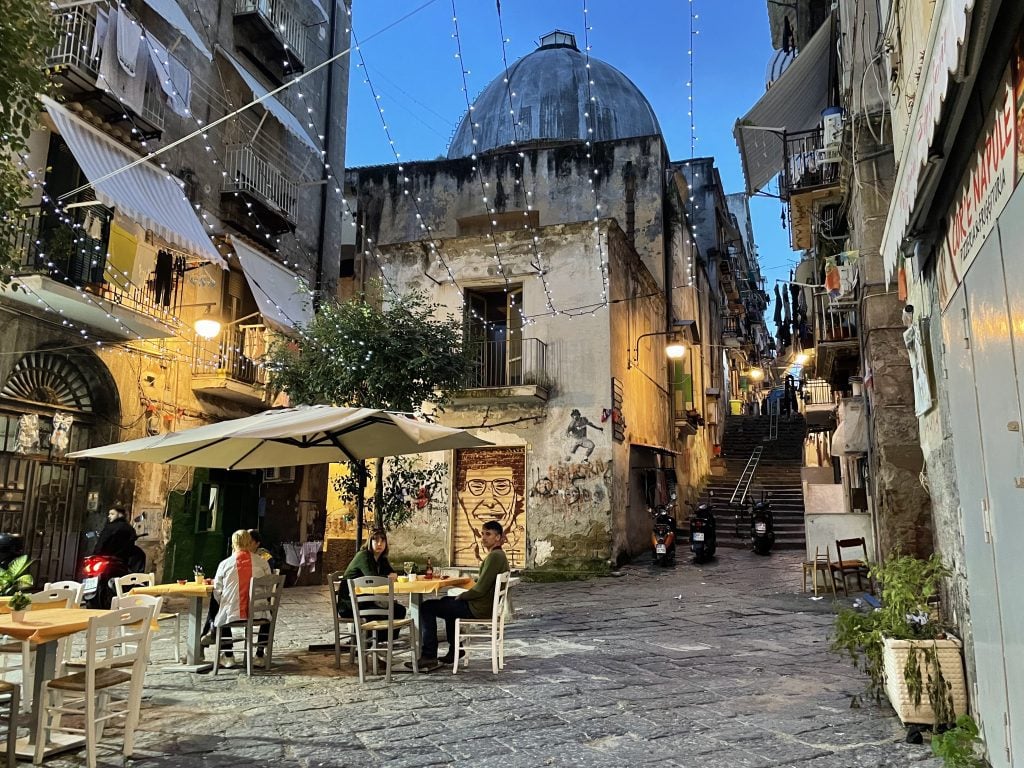
Things to Do in Naples, Italy
Definitely eat all the best pizza , visit Mount Vesuvius , explore the Old Town , and take in the Naples Archaeological Museum !
Naples is much safer than people think , and likely safer than your hometown. Treat it like any other big city and keep an eye on your belongings.
Naples is a FANTASTIC base for day trips. I recommend visiting Pompeii , Procida island , and the Amalfi Coast !
Late spring and early fall are fantastic times to visit Naples — you’ll enjoy beautiful outdoor weather and far smaller crowds. Think late May and early October.

Eat the Best Pizza in the World
If you are a pizza fiend like me, you are going to LOVE Naples. Naples is where pizza was invented! Of COURSE it’s going to be amazing!
There are so many excellent pizza places throughout Naples, and they are all cheap. Honestly, if you’re paying more than six euros for a pizza in a casual spot in Naples, you’re getting ripped off. Usually you’ll pay closer to four euros for a pizza the size of your head. (It’s more expensive at more high-end spots, though. Like eight euros for a margherita.)
So where should you go? Two of my favorite places for pizza in Italy are also two of the most famous: L’antica Pizzeria Da Michele and Sorbillo .
Da Michele is the famous pizzeria from Eat, Pray, Love , whose identity writer Elizabeth Gilbert initially kept secret before deciding to share it with the world. Get a ticket with a number outside and you’ll be ushered inside to order from their simple menu: classic margherita with fior di latte mozzarella, marinara (no cheese) or cosacca (with pecorino instead of mozzarella).
Sorbillo is a bit more formal (by Neapolitan standards, anyway) — you wait in line and sit down in the restaurant. There’s a more detailed menu with more toppings, but the pizza is just as good.
Two more modern pizzerias that I really enjoyed are Pizzeria 3.0 Ciro Cascella (one of the best margheritas I’ve EVER had, plus PIZZA DONUTS!!) and 50 Kalo (just fabulous all around). These two spots are off the beaten path and will be full of locals. Book ahead.
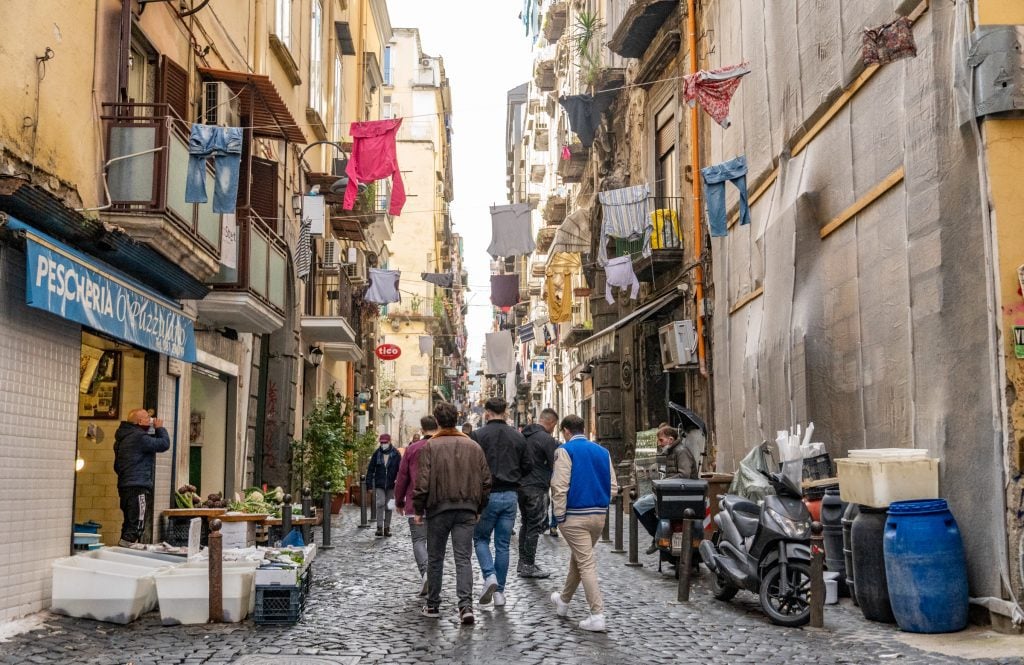
Explore the Historic Center of Naples
The historic center of Naples is a UNESCO World Heritage Site, and for good reason — it dates back to 470 BCE and carries layers upon layers of civilizations. Here you have Ancient Greek city walls, Byzantine churches, French Gothic architecture from the Angevin, and Tuscan architecture from the Aragonese.
But for me, I feel that this neighborhood is where you feel the essence of Napoli in its carefree glory. Motorcycles speed down the street, shopkeepers yell animatedly with each other, walls are covered with religious art and graffiti, and that one guy with a balcony is singing into a karaoke machine, performing for the people waiting in line for pizza at Sorbillo.
Spend time walking around this neighborhood, photographing anything that catches your interest — or just sitting back and watching the show, a big smile on your face.
And don’t miss the Quartieri Spagnoli, or Spanish Quarter — it’s just down the street from the Historic Center and is brimming with tons of character as well.
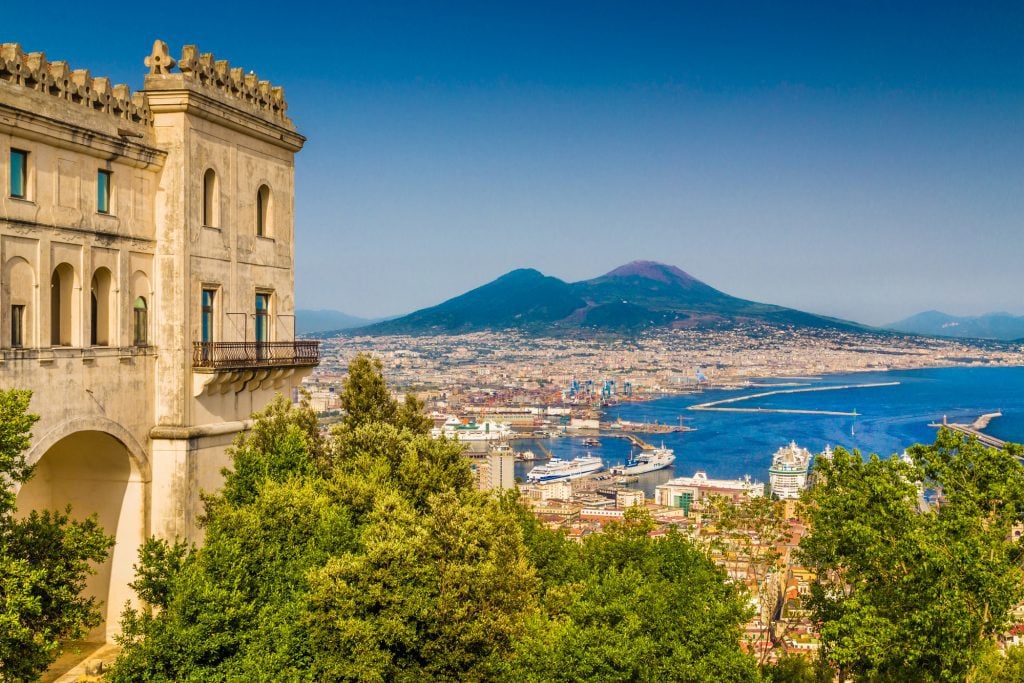
Visit Mount Vesuvius
Mount Vesuvius is one of the symbols of Naples, towering over the city and its surroundings. Vesuvio, as the Italians call it, is close enough to Naples that it’s pretty much part of the city.
Lots of locals and tourists alike enjoy hiking Mount Vesuvius, which is best done in the cooler months of the year, or early in the day during the summer.
Not up for a big hike? You can easily visit Mount Vesuvius on a half-day tour from Naples , where you’ll climb the mountain by bus and on foot, take in views of the Bay of Naples, and learn about the volcano’s violent history.
You can also take a full-day tour to Mount Vesuvius and the ruins of Pompeii , which go very well together for obvious reasons! Those poor Pompeiians…
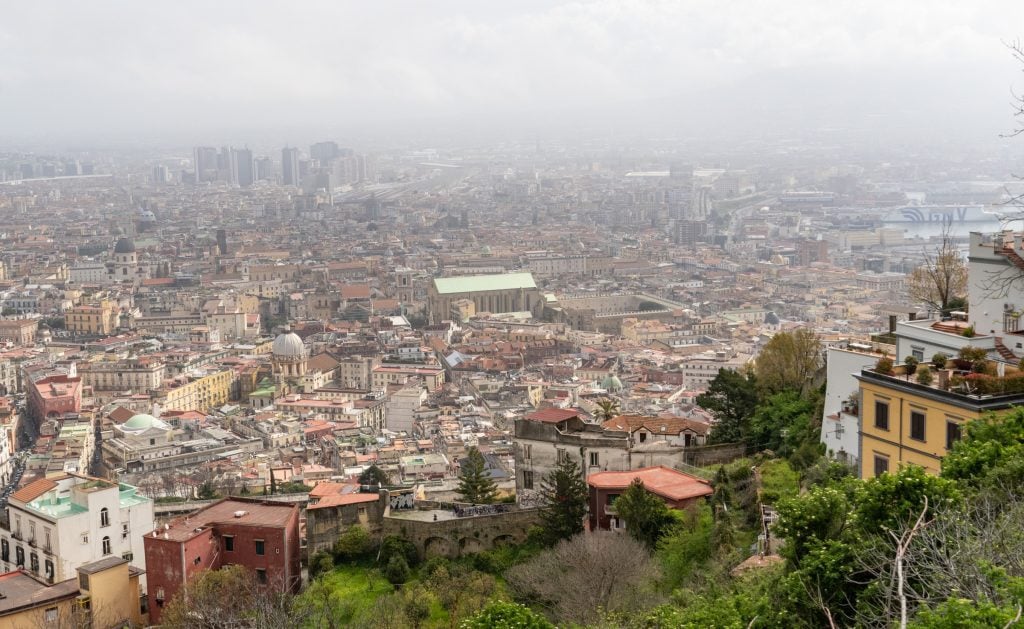
Take in the View from Castel Sant’Elmo and Vomero
For a different side of Naples, check out the Vomero neighborhood — while the name might cause you to blanche for a moment (no? Just me?), it’s actually the fanciest and ritziest neighborhood in Naples. Located on Vomero Hill, far above the city center, it’s a beautiful place to take in the views over Naples, Mount Vesuvius in the background.
You can explore the castle and its star-shaped military fortress. It’s been in action since the 13th century, and it has a hell of a lot of history! You can buy skip-the-line tickets here.
To get to Castel Sant’Elmo, take the funicular to Morghen station and walk. I highly recommend taking the funicular up and walking your way down afterward. (Though be sure to wear closed-toe shoes — I stepped through a surprising amount of broken glass on the stairs down from the castle.)
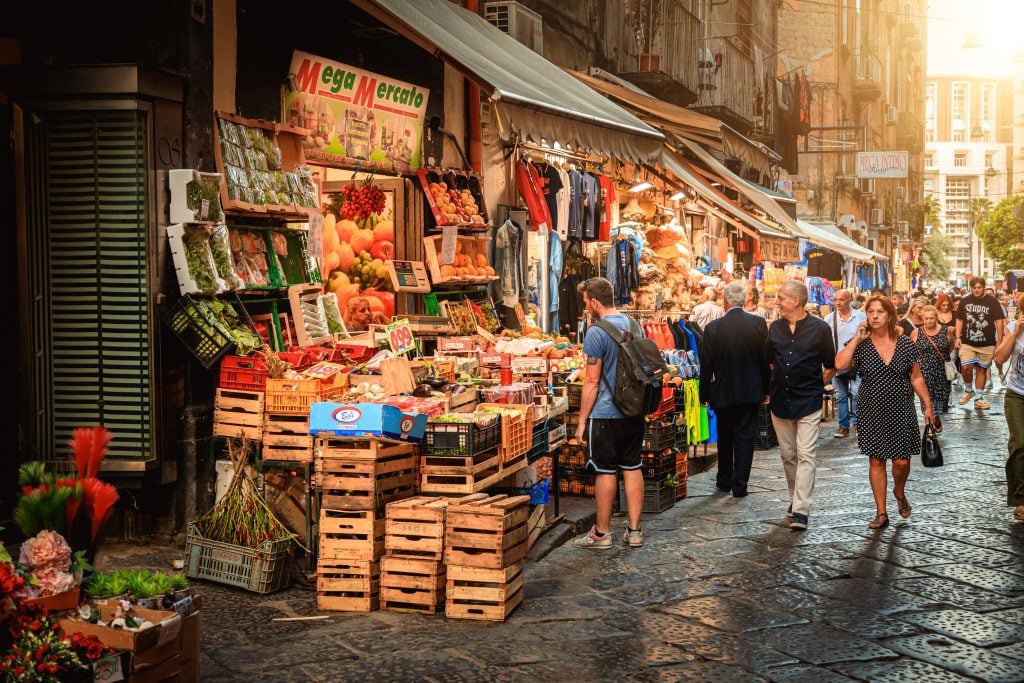
Go on a Street Food Tour
No matter where you are in Italy, the food will be good — but the food culture in Naples one of my favorites in the country. Naples is one of Italy’s historic food capitals, and the locals know how to prepare a fresh meal, so you cannot go wrong with a street food tour .
This food tour stops at all of the hot spots – basilicas and main squares – along with out-of-the-way stops that add a unique flavor to the mix. Participants will sample traditional dishes while getting an entertaining education into the history of the city as you visit cultural attractions in between bites.
Come hungry, because while you’ll only be sampling the dishes, there’s a lot of ground to cover! Ragù, baccalà, and pizza are just scratching the surface, and vegetarian options are available everywhere. Prices for this tour start at 42.50 EUR ($45.90 USD).

Take a Cooking Class
If your foodie style is more hands-on, a cooking class is really the best way to immerse yourself in Italian culture. So what will it be? Pizza or pasta? Why not do both?
You may think you know how to make pizza from scratch, but this Neapolitan pizza class teaches you the well-kept Italian secret of doughmaking, passed down through the generations. The art of pizza-making is an emotion, and a master pizza maker will show you how to feel it. Then you can indulge in your creation, complete with an appetizer and drink.
The fettuccine and ravioli option involves the intimate act of small-group pasta making. Set in a historic restaurant in Naples, it includes fresh local products like mozzarella, cured meats, produce, and yes, of course you will be eating your creations here as well! Prices start at 44.50 EUR ($48 USD).
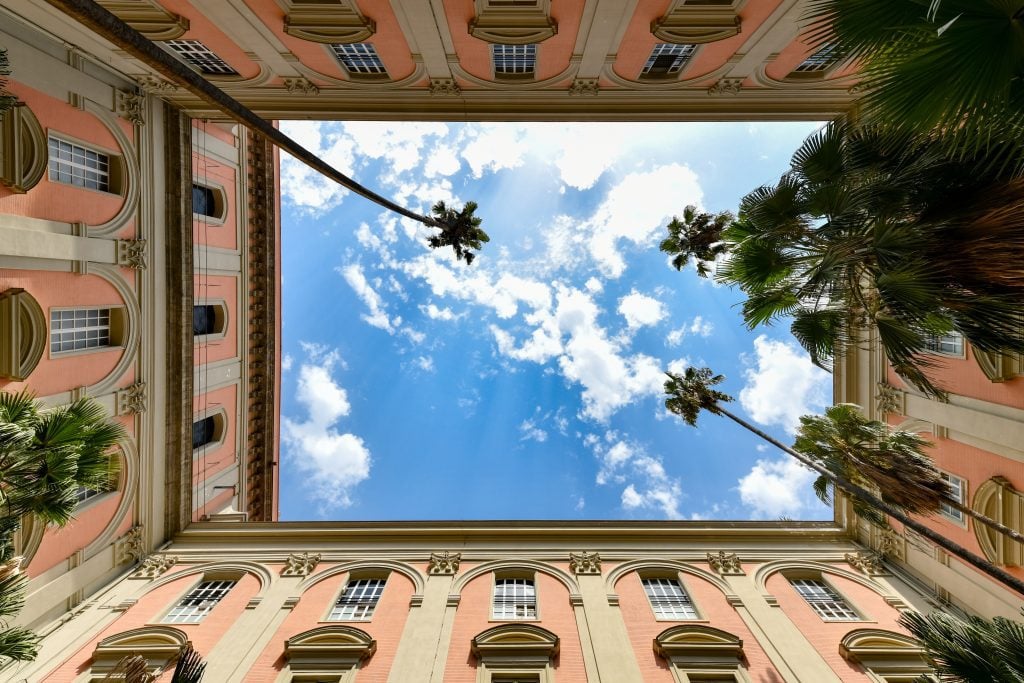
Naples National Archaeological Museum
Visit Naples’ National Archaeological Museum to get an intriguing peek into ancient life. There you will see artifacts rescued from Pompeii and Herculaneum, plus magnificent Greek and Roman sculptures and mosaics spanning millennia of history.
This neoclassical museum boasts an expansive collection that includes ancient Egyptian relics. Egyptology exhibits are particularly popular, and you’ll find seven rooms dedicated to Egyptology – covering themes like power, social structure and death.
The National Archaeological Museum in Naples is an essential stop on any trip, and can often become overrun during weekends and peak season.
To ensure you can fully experience it during your stay, book skip-the-line National Archaeological Museum Naples tickets beforehand to ensure maximum enjoyment! Admission is 22 EUR ($23.50 USD) and tickets are valid for two consecutive museum days.
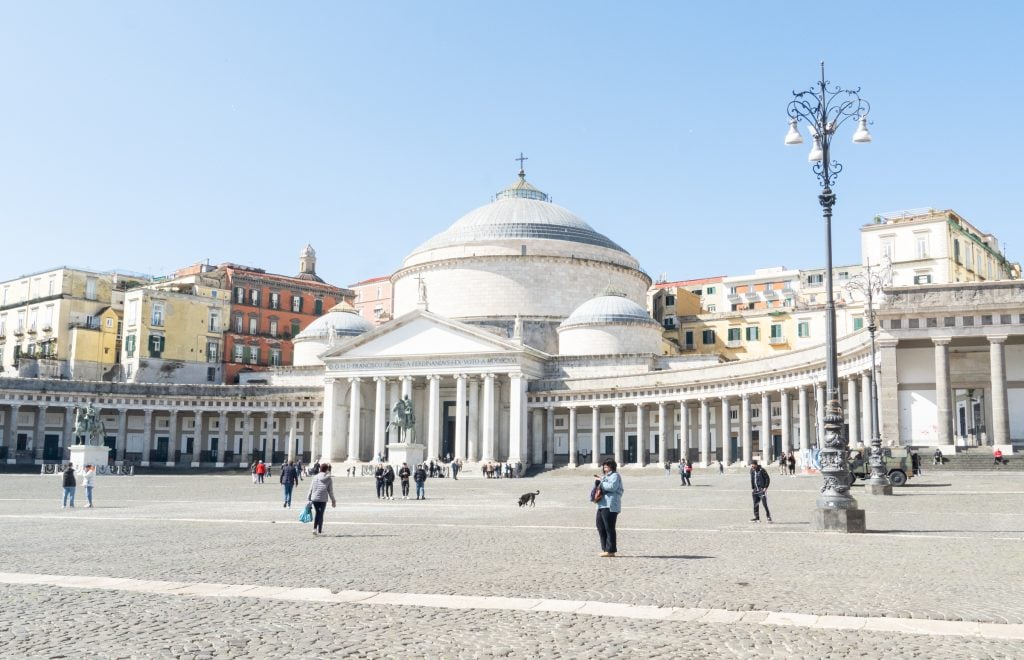
Piazza del Plebiscito
The Piazza del Plebiscito is one of Naples’s grandest squares. It was named to honor an 1861 plebiscite that united Italy from two separate realms into one nation-state — specifically, the Bourbon Kingdom of Two Sicilies merging into the Kingdom of Italians.
It is also one of the most beautiful spots in all of Naples, playing host to a number of cultural events throughout the year. When you arrive, you may notice two impressive buildings: at one end of the square is San Francesco di Paola Basilica, a wonderful Neoclassical structure and one of Naples’s largest churches.
On the other end is the Royal Palace of Naples, a real monument to the city, thanks to its expertly preserved state. For a short while in the 1960s the square was sadly used as a car park, but today is now strictly pedestrian and a great place to escape the traffic of Naples.
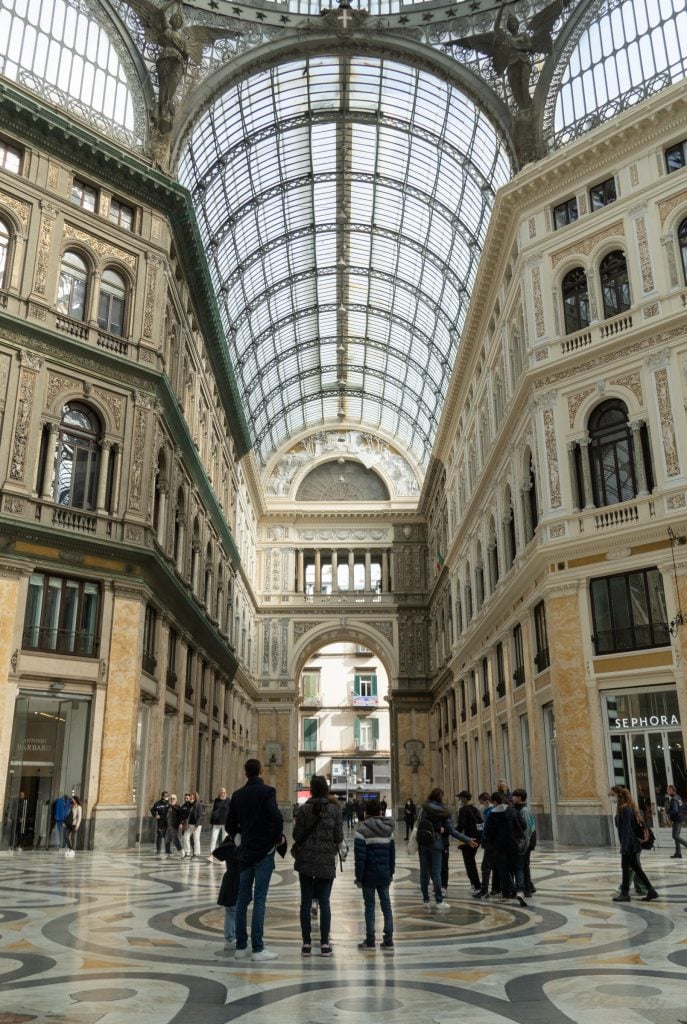
Galleria Umberto I
Located in a vibrant area of downtown Naples, Galleria Umberto I is an exquisite shopping center that also doubles as an art installation, similar to Milan’s Galleria Vittorio Emanuele II. Here you can explore various collections, such as Italy’s second-largest Egyptian collection.
It all started back in 1887 (pretty recent by European standards!) by the will of King Umberto I, a mere nine years after the Galleria Vittorio Emanuele in Milan. With an arching dome reaching 184 feet high, the arcade takes on a criss-cross shape, with a gorgeous mosaic of the zodiac on the center floor.
There are four entrances and plenty of shopping to be had, along with cafés and restaurants. Admission is, of course, free. However, you’ll still need your wallet for all of the purchases you’ll make!
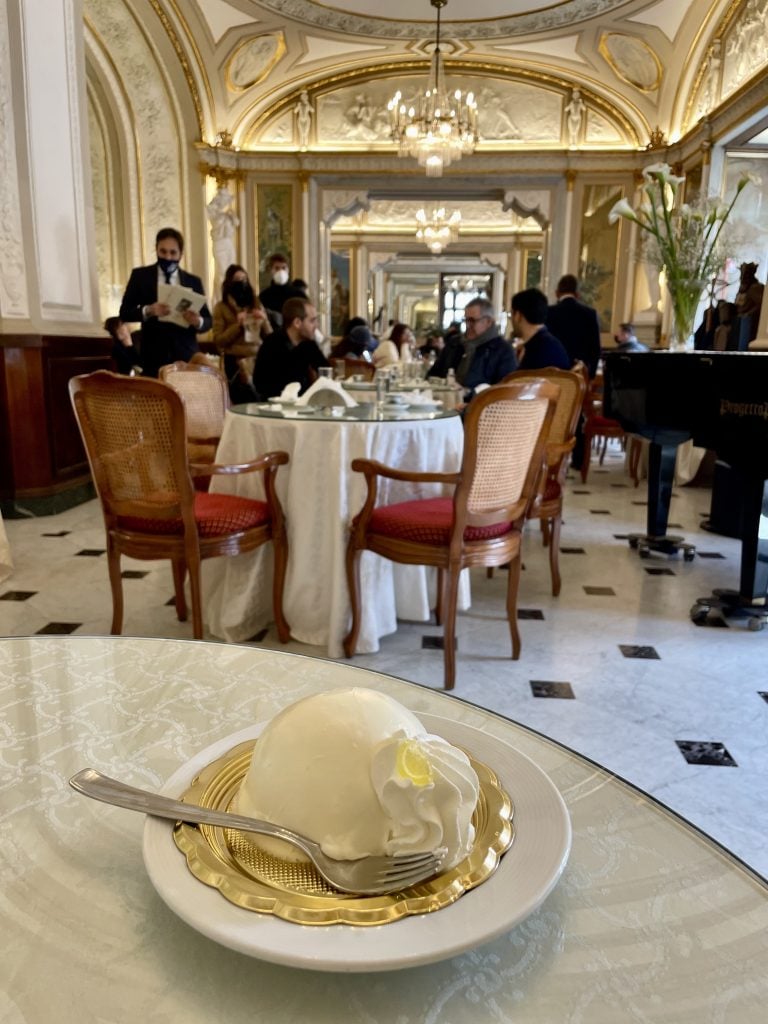
Have Fancy Pastries at Gran Caffè Gambrinus
I love visiting elegant cafes throughout Europe — but I was surprised to learn that one of the best was in Naples! Gran Caffè Gambrinus is located right on Piazza del Plebiscito and feels like another world. You walk into the cafe and are spellbound by its crenellated walls with gold trim, statues on display in the alcoves.
And a fancy cafe deserves a fancy pastry. I highly recommend trying a delizia del limone , a special cake from the Campania region that is filled with and topped with lemon custard.
Pair it with any of the fancy, ornate coffee drinks. Somehow I ended up with a drink that was a shot of espresso between multiple layers of thick cream, topped with pistachios.
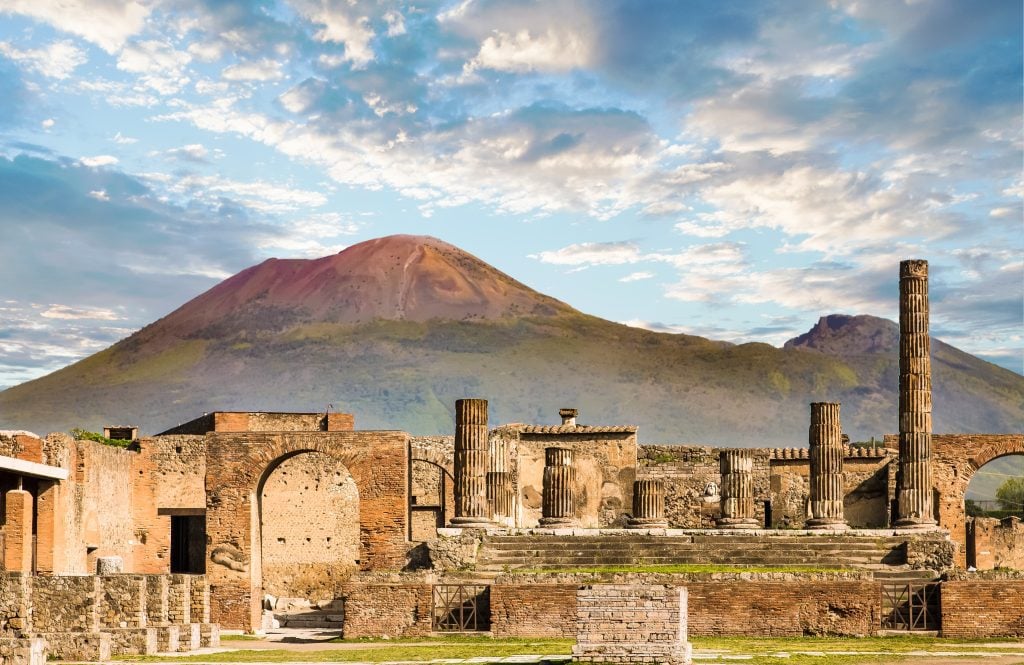
Visit Pompeii (and/or Herculaneum)
In the year AD 79, Mount Vesuvius exploded, burying the city of Pompeii in ash and preserving it for centuries since. If you’re a fan of ancient history, Pompeii is one of the ultimate destinations for you, in Italy or worldwide — it’s rare to see a city so well-preserved to this day.
Pompeii is located close to Naples and makes an easy and fascinating day trip. It can also be surprisingly moving, seeing plaster casts of bodies in their last moments of life.
Near Pompeii is Herculaneum (Ercolano in Italian), which is another site worth visiting. It’s smaller than Pompeii (and easier to get around on foot if you have limited mobility), and in some ways is better preserved thanks to being closer to the volcano and being excavated more recently.
You have a few options for visiting Pompeii from Naples:
This tour from Naples includes Mount Vesuvius and Pompeii , which are cool to visit back to back and have the historical context.
This tour from Naples includes both Pompeii and Herculaneum , giving you a taste of both sites.
This tour from Naples includes Pompeii, lunch, and wine tasting , a fun way to do a lot in a half-day tour.
If you want to visit Pompeii independently, you can take the train from Naples to Pompeii on the Circumvesuviana Line , which takes about 37 minutes. For Herclaneum, take the train from Naples to Ercolano , which is a bit further.
If you take the train to Pompeii, I highly recommend taking this tour of the ruins with an archaeologist , which has long been one of the best-rated tours in the Bay of Naples!
Remember to bring a water bottle and sun protection, including a hat and long-sleeved shirt or jacket — these ancient sites can get especially hot in the summer months, and there isn’t much shade.
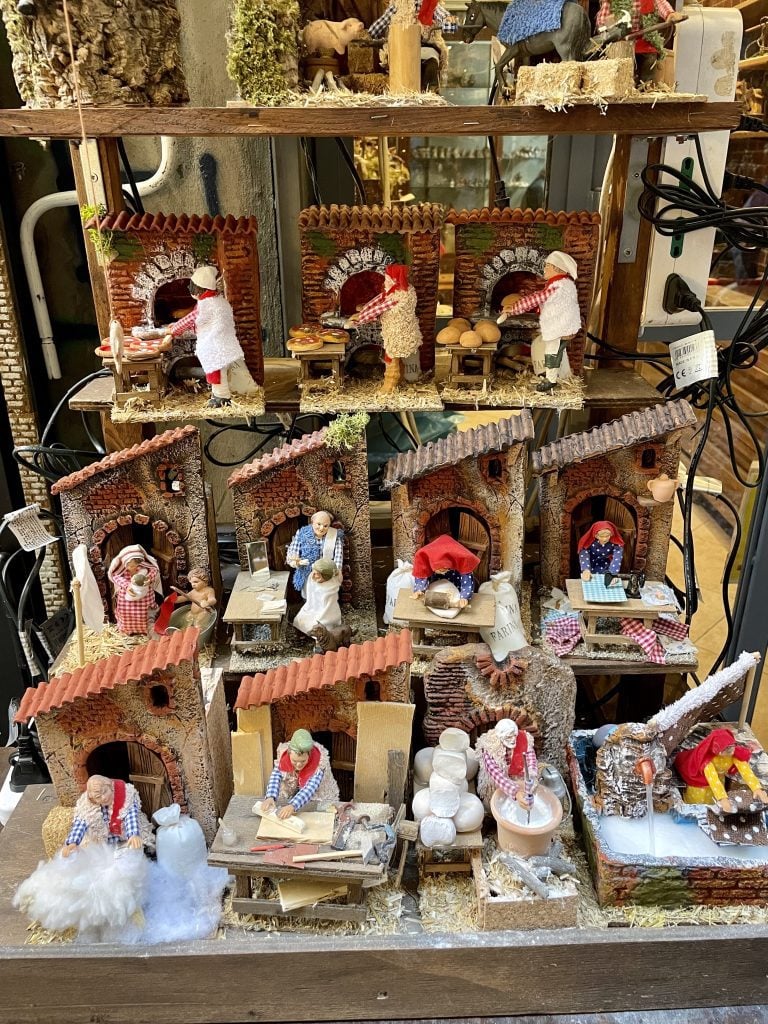
Gawk at Nativity Scenes on Via San Gregorio Armeno
Naples’s historic center is a wonderful place to get lost — but whatever you do, find your way to Via San Gregorio Armeno. This little street, located between the main thoroughfares of Spaccanapoli and Via dei Tribunali, is home to hundreds of nativity scenes.
These scenes, called presepi in Italian, contain all kinds of figures — and they’re all for sale. Of course you can find baby Jesus and camels, but here in Naples you can find a pizza-maker figurine! Because we all know they were having margheritas at the birth of Jesus!
Anyway — this street is an unmissable place in Naples, and if you know anyone who collects nativity scenes, these figurines make the perfect gifts.
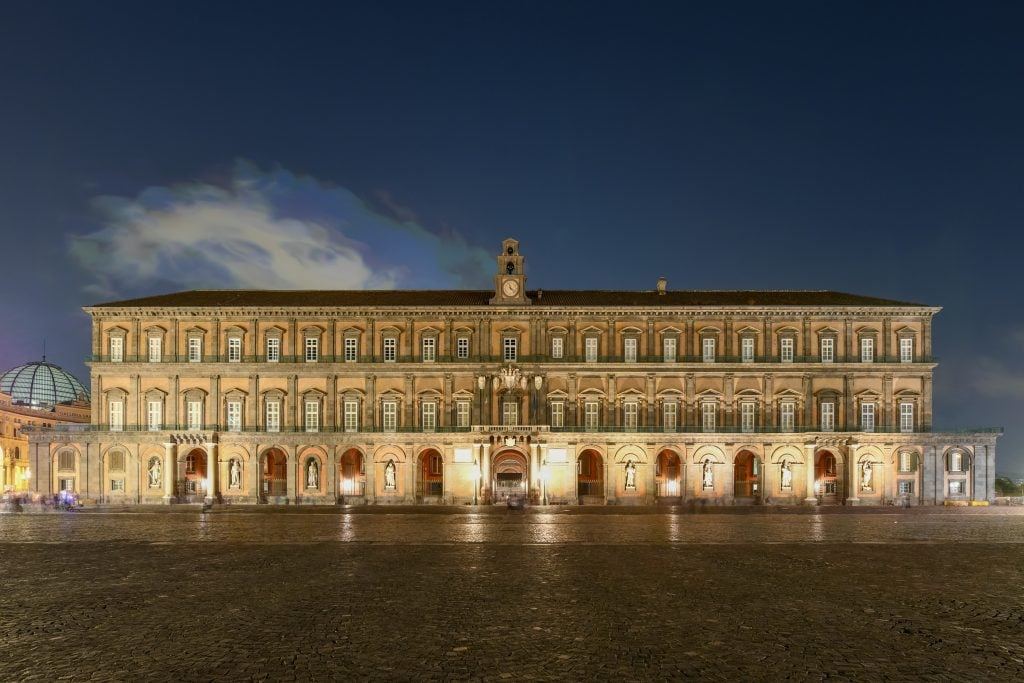
Royal Palace of Naples
At the heart of Naples lies the Royal Palace, known by locals as Palazzo Reale. Take a guided tour to appreciate its beauty and history – from the apartments of Royal Families to its grand court theater featuring tapestries, marble sculptures and frescoes adorn its walls.
Discover how the rich and famous lived in Naples at this lavish palace that has been carefully preserved as it was when used by royal families. Step inside the throne room, imagine operas or plays being staged at its private theatre, or simply stroll through lavish rooms adorned with antique furniture and art.
Explore Spaccanapoli Street to reach the Gesu Nuovo church and admire its gorgeous interior as you stroll to its lovely cloister – Caravaggio has painted three of his iconic paintings here: Seven Acts of Mercy in Gesu Nuovo church, Flagellation at Capodimonte National Museum, and The Taking of Christ at Sansevero Chapel. Admission is 10 EUR ($11 USD).
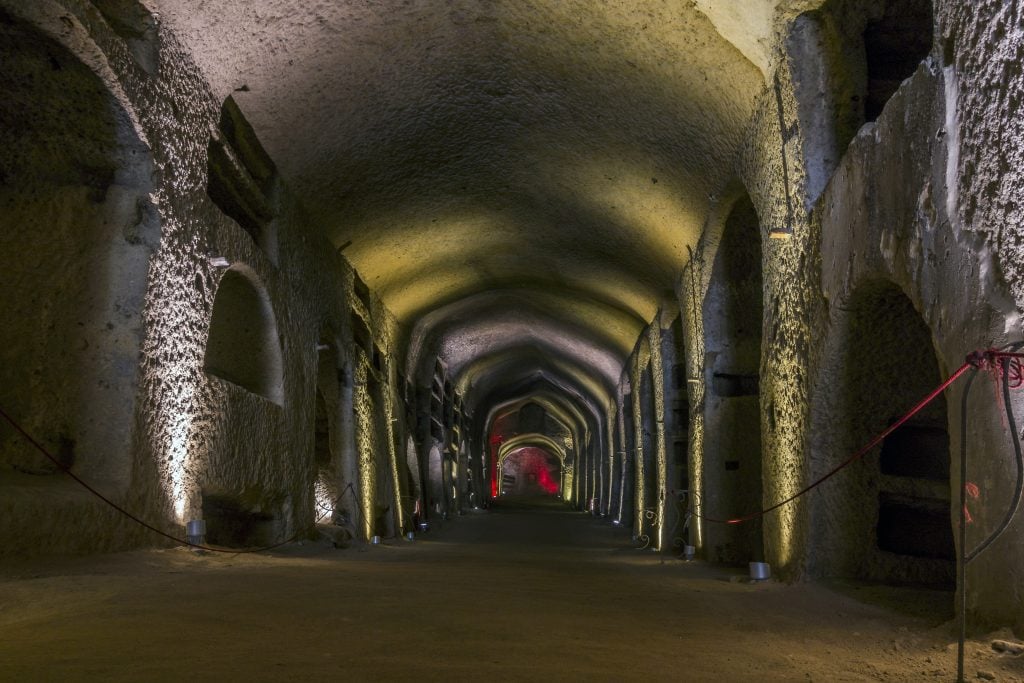
San Gennaro Catacombs
To gain some insight into a rich culture of death, the catacombs will more than satisfy. Here you will discover San Gennaro’s tomb, where his remains were brought for transference as the patron saint of Naples.
The Naples Catacombs is one of Italy’s most unusual attractions. These burial sites of early Neapolitan Christians offer an eye-opening underground world, complete with rooms cut into rock faces and decorated with 2nd century frescoes from churches like San Gennaro (also known as Faccia Gialla, or Yellow Face). One tomb in particular stands out, which may contain one of his oldest depictions — it could even contain his face itself! To find out, you’ll just have to come see it for yourself.
Visit the highlights with ease by taking a guided tour, held every hour (at extra cost). Regular admission is 17 EUR ($18 USD); for students, seniors, and groups of 20 or more, it is 13 EUR ($14 USD) per person. You can get your tickets here.
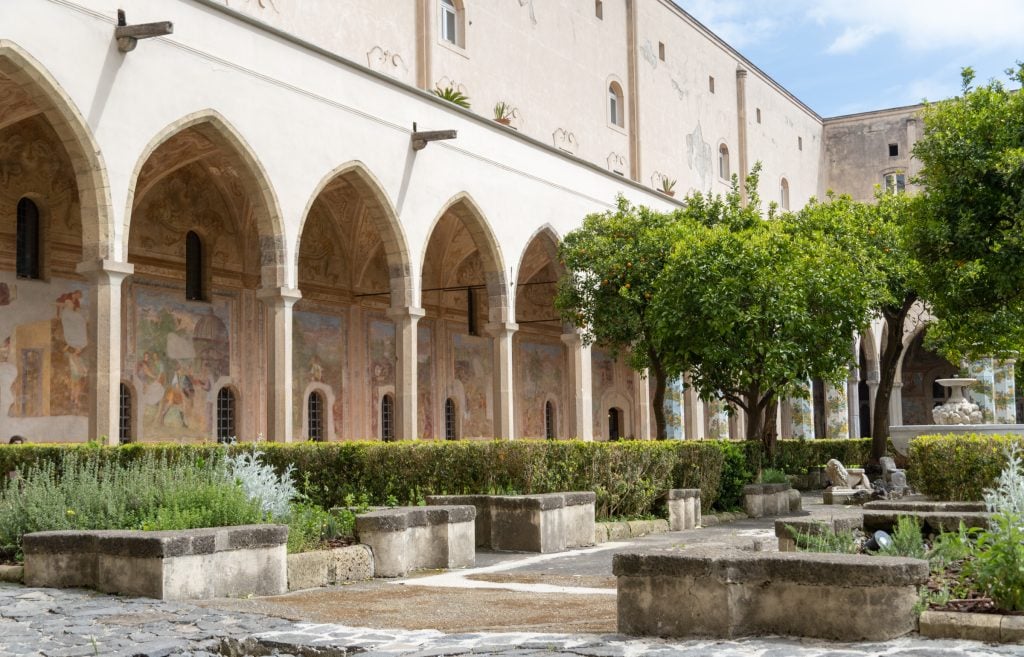
Chiostro di Santa Chiara
Tucked away behind a 14 th century church, the Cloister of Santa Chiara is an impressive monastery with an intriguing backstory. Originally built to house 200 monks and the tombs of the Angevin royal family, it was disregarded as a lowly stable by the son of the builder. As a result, it received an exquisite baroque makeover years later.
A major draw for visitors, it may well be the most photographed spot in Naples. In fact, the Santa Chiara itself was only built in the 18 th century, and both church and monastery suffered bomb damage in WWII (which has since been renovated.) Of particular note are the majolica-tiled benches and ornate pillars that line the paths.
Look out for the ceiling fresco and luxurious interiors and make sure to view its three presepi (Christmas crib scenes) circa the 1700s. These elaborate tableaux are one of the city’s signature features – perhaps the most elaborate in all of Italy. Admission is 6 EUR ($6.50 USD) and 4.50 EUR ($5 USD) for teachers, students, and seniors over 65).
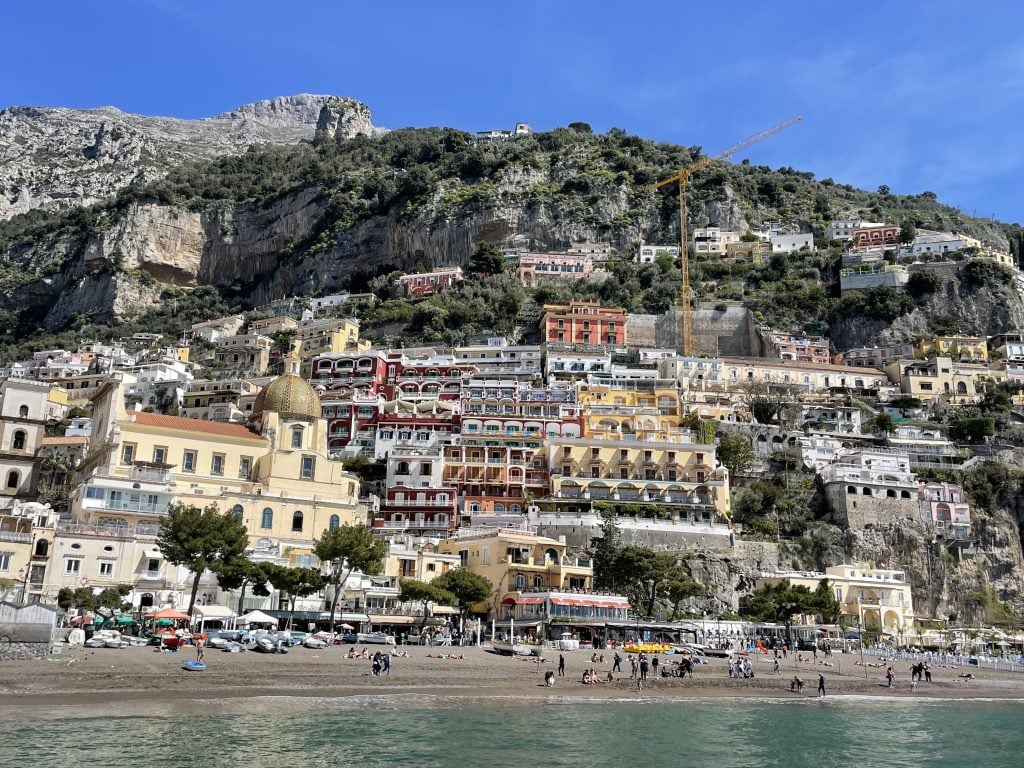
Visit the Amalfi Coast
The Amalfi Coast is one of the most spectacular places to visit in Southern Italy. And one of the best things to do in Naples is to head to these stunning cliffside towns for a day!
To get the most out of a day to the Amalfi Coast, I recommend visiting the towns of Positano and Amalfi — two towns that are gorgeous, easy to get to (by Amalfi Coast standards), and pack a lot of value into a single day.
First off, you can take a tour from Naples to the Amalfi Coast that includes visits to Positano, Ravello, Amalfi, and lunch overlooking the sea in Conca dei Marini. This is the easiest option, and a great way to relax and enjoy yourself.
Want to do it more independently? You can take a ferry from Naples to Positano (or, alternatively, Naples to Amalfi ), and explore those towns on your own. You can’t beat the ferry views!
You can also book a private transfer from Naples to the Amalfi Coast . This is more expensive, but door-to-door experience can be worth it, especially if you’re splitting it between a few travelers.
And for the cheap option? Book a bus from Naples to Positano via Sorrento . Just know that you get what you pay for, and this can take a while.

Have a Sfogliatella for Breakfest
Italy may be my favorite foodie destination in the world — but not for breakfast. I feel like Italy goes light on breakfast (usually just a cornetto and caffe , or another light pastry) so they can throw all their energies into the other meals.
But Neapolitans know what’s up — they eat sfogliatelle for breakfast. Known as lobster tails in the US, these are long, curved pastries with layers upon layers of flaky pastry, wrapped around ricotta cream. Sometimes the cream is enhanced with orange, cardamom, candied lemon peel, or almond paste.
So if you’ve been looking for an excuse to indulge in your breakfast, grab yourself a sfogliatella in Naples!
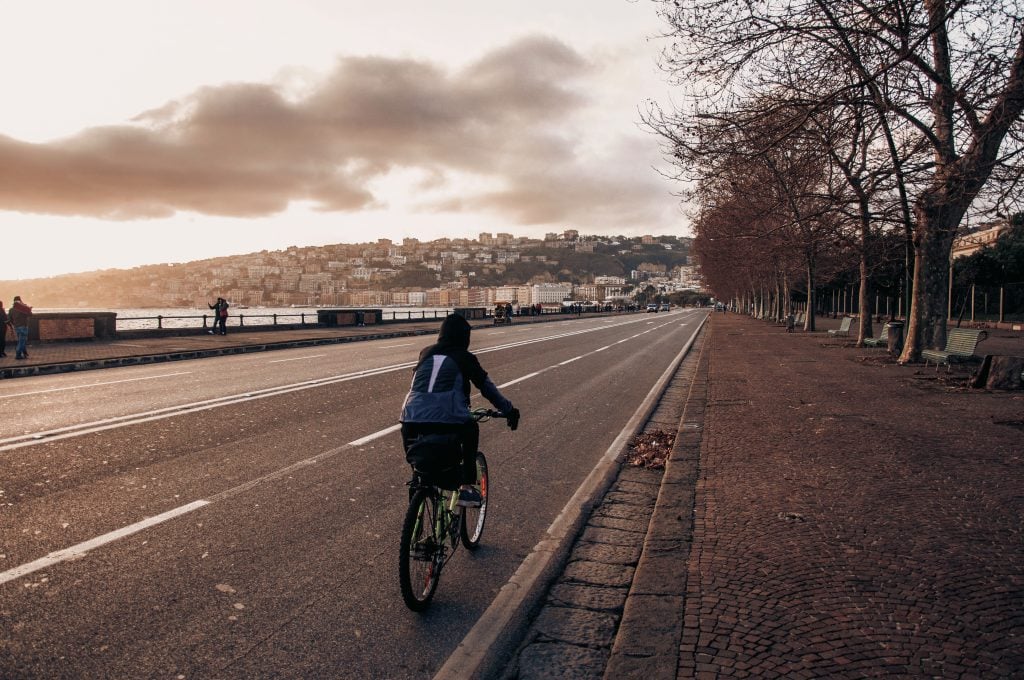
Wine, Food and E-Bikes
Leave the city behind, if only for a few hours, and explore outside Naples effortlessly on two wheels with an e-bike food and wine tour ! You will ride through the gorgeous Phlegrean Fields with your informative guide on this e-bike tour.
Travel along the coastline, passing ancient ruins along the way to Lake Averno, a volcanic site where you will stop and enjoy lunch and a wine tasting on the shores of the lake. This is a relaxing change of pace from the bustle of Naples! Alcoholic beverages are available for those who wish to partake. Prices start at 77 EUR ($83 USD).
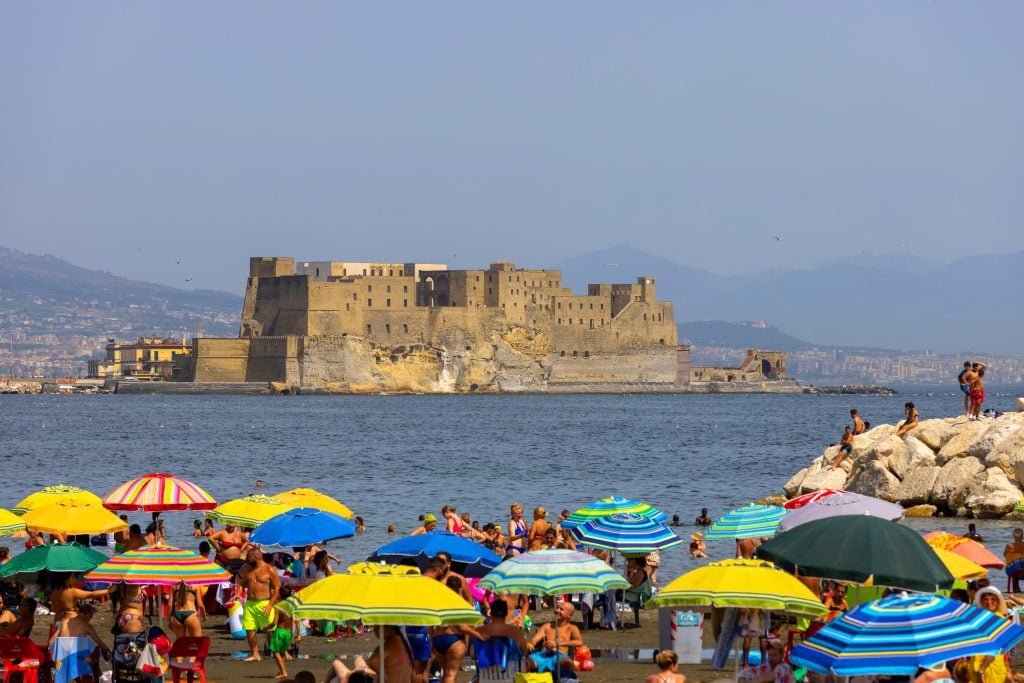
Castel dell’Ovo
Castel dell’Ovo (roughly translated to “Egg Castle”) is one of Naples’s iconic landmarks and an intriguing destination to visit for both its story and architecture. Legend holds that Roman poet Virgil placed an egg into its foundation as part of an agreement, declaring if ever broken, so too would both Naples City and Castle dell’Ovo become unsteady structures.
As soon as you arrive at a castle, make sure to venture inside to explore its lavish interiors. There’s much to see – including an extravagant church featuring frescoes and gold decor – including a cavernous church that’s almost surrealistically lavish in size and decoration.
Located right on the coastline, the Castell dell’Ovo can be an imposing structure as seen from the water, with Mount Vesuvius in the background. In fact, it is the oldest standing fortification in Naples. Today, it is used for temporary art exhibitions and events. And that’s not all — it’s one of the free things to do in Naples Italy!
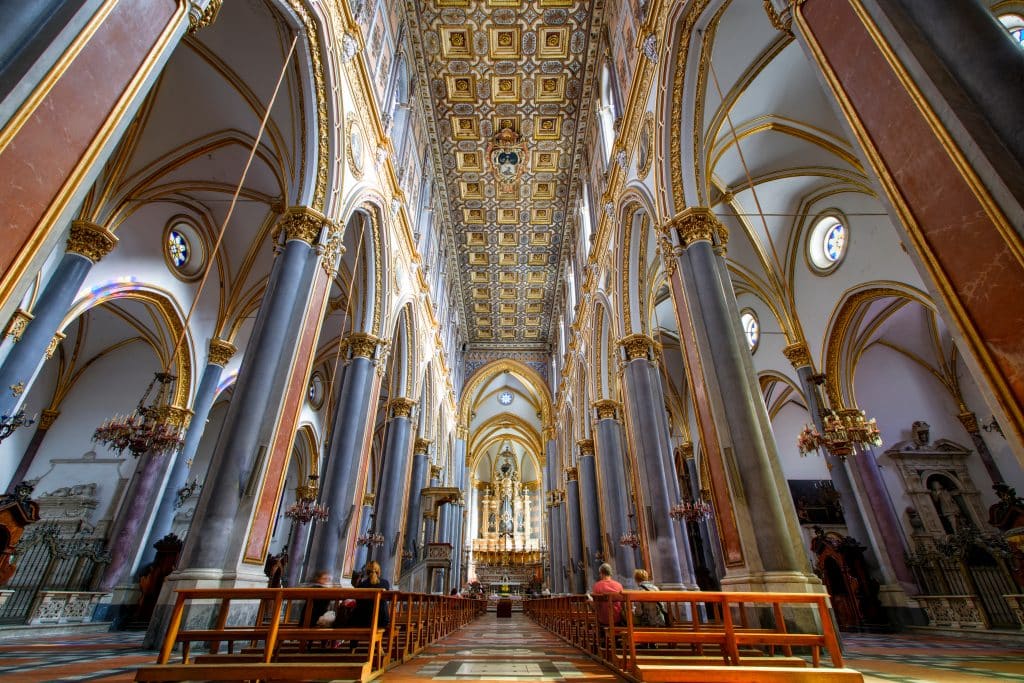
Basilica San Domenico Maggiore
Basilica San Domenico Maggiore should also be on your itinerary; this church in Naples’ central district stands as one of its most impressive landmarks. It features Gothic architecture with three-sided palazzi, including an impressive double staircase, Cappella Royale that houses an 18th-century Nativity scene and some incredible artwork pieces inside its walls.
While the exterior may seem interesting, if not a tad austere, once you enter, the interior will blow you away. Opulently decorated with intricate gold detail and tall columns, it is filled with sculptures and paintings.
Be sure to pop into the Capella Brancaccio to see some of the church’s original frescos from the 14 th century. Admission is free, but there are various guided tours starting at 5 EUR ($5.50).
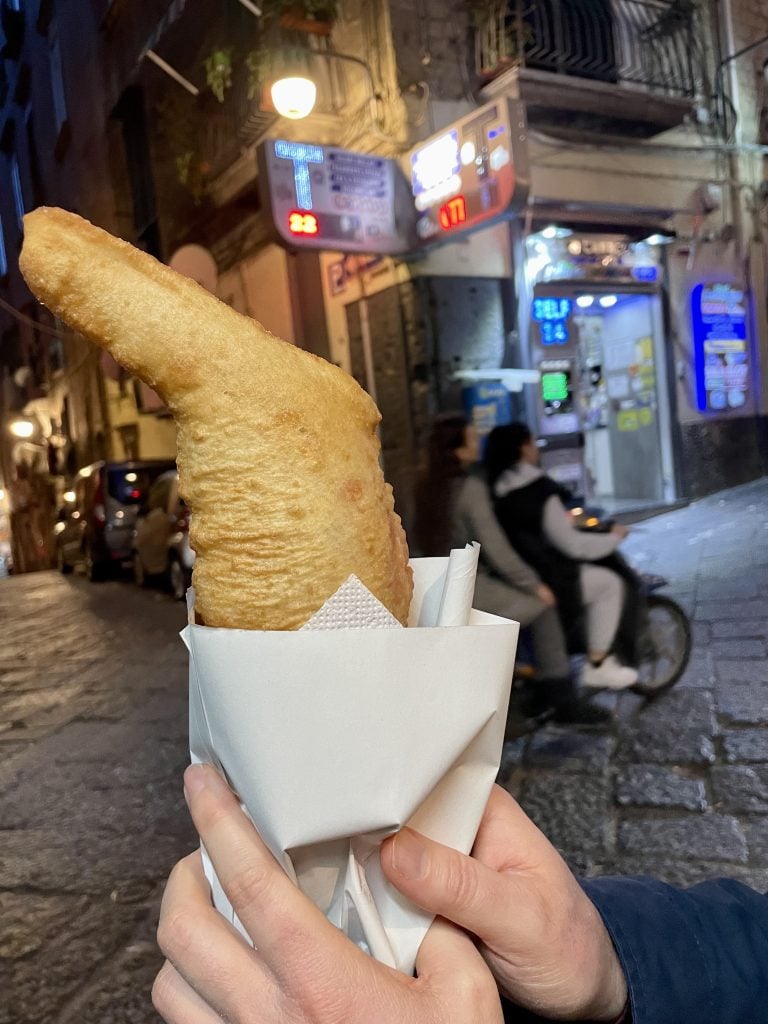
Try a Pizza Fritta
If you haven’t been pizza’ed up to your eyeballs yet, go a step further and try a pizza fritta (fried pizza)! Nope, this isn’t deep-fried slices of pizza like you’ll find in Scotland — this is more like a piping hot calzone.
Pizza fritta is similar to the panzerotti you’ll find in Puglia, with a thin dough shell that is deep fried and crispy on the outside (rather than the doughier Sicilian-style panzerotti ), filled with tomato sauce, mozzarella, and sometimes other fillings. It’s a decadent snack and one that you should try at least once.
Best of all, you can find pizza fritta all over the historic center and the Quartieri Spagnoli, and it won’t cost more than a few euros. It makes a GREAT late-night snack after a few cocktails!
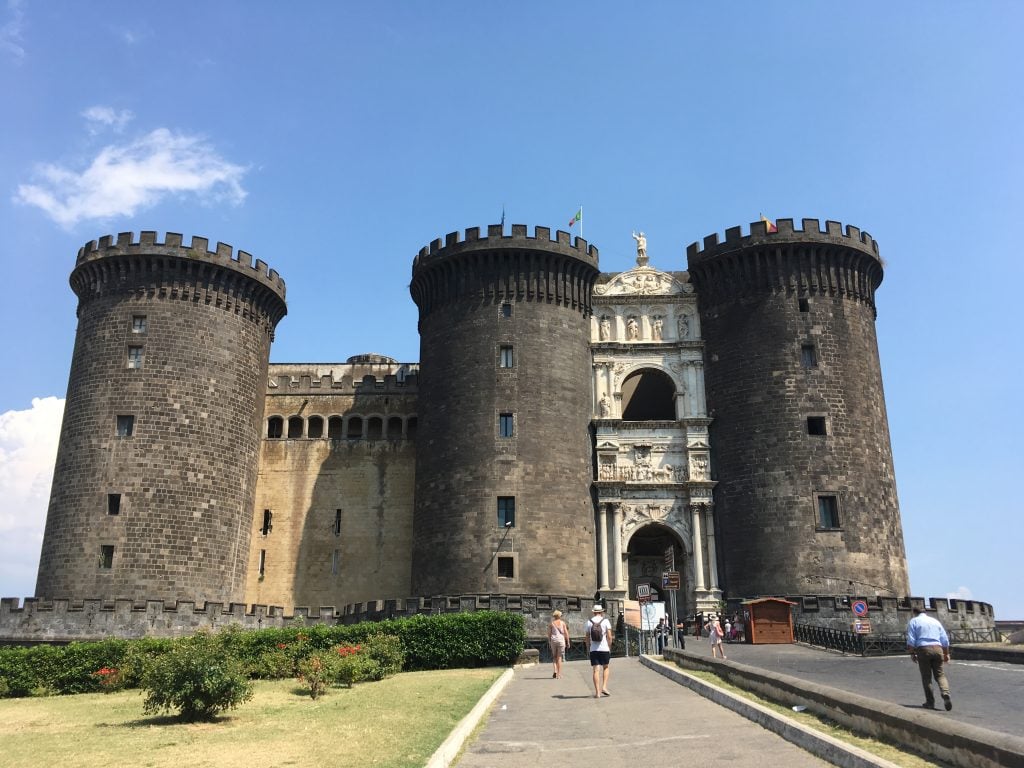
Castel Nuovo
For over eight centuries, the Castel Nuovo has been one of Naples’s iconic landmarks and an absolute must for history enthusiasts. Facing the Mediterranean, the Castel’s majestic walls create an unforgettable view, while its towering structure houses both a Municipal Museum and a local history exhibit.
The collection showcases art from both the Neapolitan Renaissance and Baroque periods, such as works by Battistello Caracciolo, Luca Giordano and Francesco Solimeno. Also, be sure to visit Palatine Chapel and Armoury Hall while at the palace. Many myths and legends surround this ancient structure, just one of which is the “Prison or Pit of the Barons.”
These are four secretly stored coffins with no inscription that contains mortal remains. It is thought that they are nobles who had participated in the Barons’ conspiracy of 1485. But who knows? The only way to find out is to visit. Admission is 6 EUR ($6.50 USD).
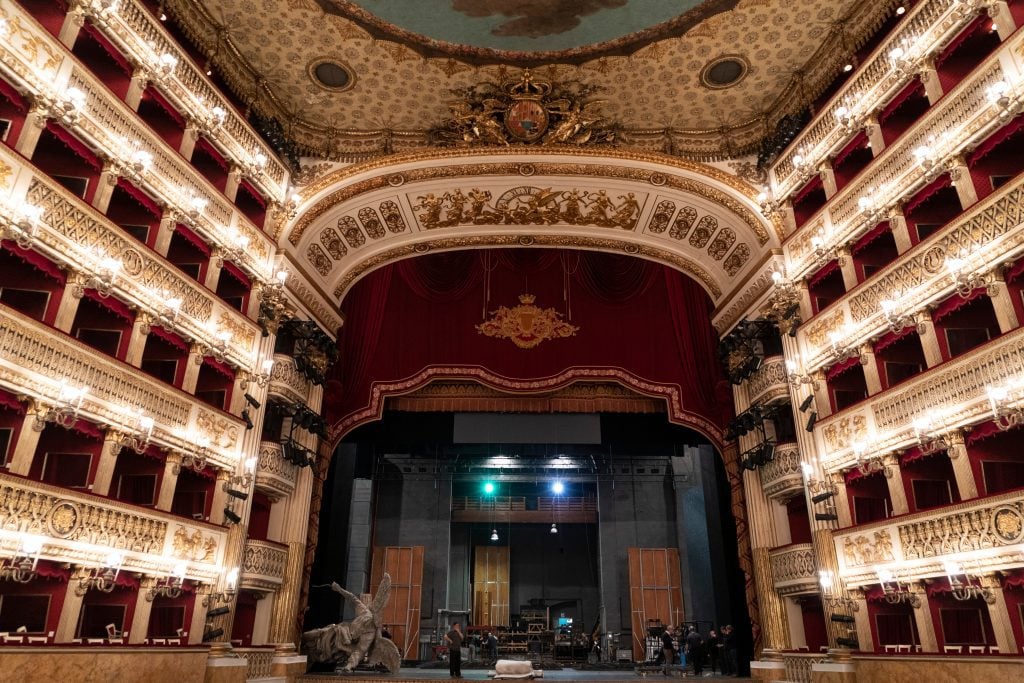
Teatro di San Carlo
Naples’ oldest opera house, a UNESCO World Heritage site, should not be missed. It features stunning ceiling frescoes decorated in luxurious red and gold, and horseshoe-shaped auditorium seating arrangements. It is one of Italy’s premier opera houses and offers both classical and contemporary performances year-round. Ideal for culture seekers visiting Naples!
This theater opened its doors in 1737 and has seen some iconic opera and musical performances take place there including Christoph Willibald Gluck’s 1852 Clemenza di Tito and Johann Christian Bach’s 1761-62 Alessandro nell’indie, written by Bach himself! You may purchase additional tickets (when available) to explore its historical hall, boxes and foyers of this theater.
Apart from regular performance tickets, which start at 20 EUR ($21.50 USD), you may purchase guided tour tickets for 9 EUR ($9.70 USD) to explore its Main Stage Hall, Royal Box and Foyers of this theater. Tours are in English and Italian.
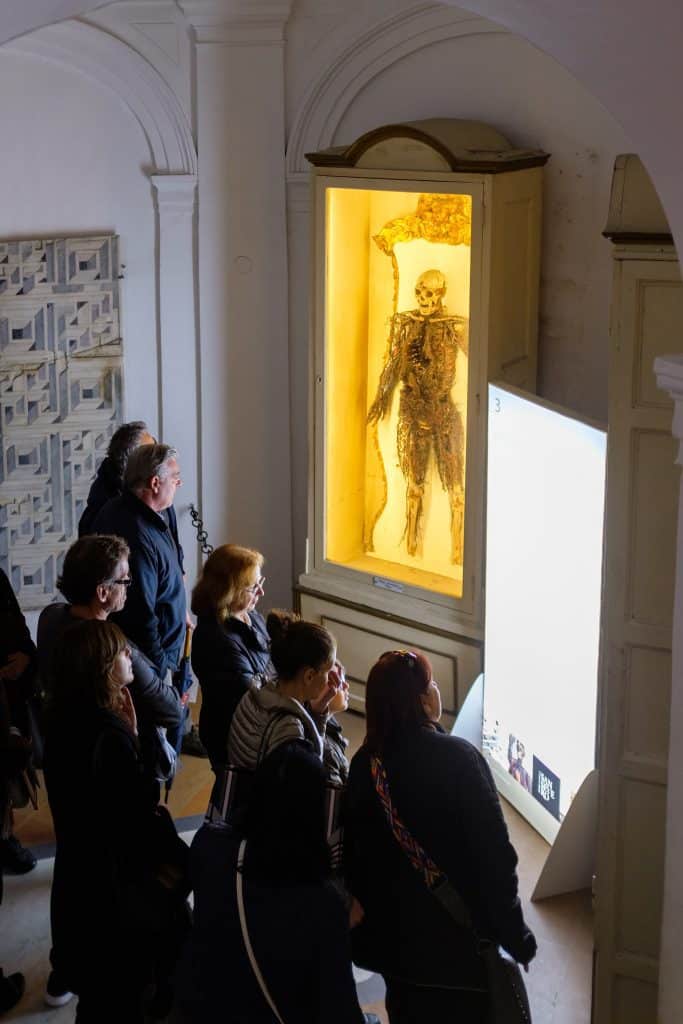
Museo Cappella Sansevero
Museums and churches throughout Rome are an impressive spectacle to behold, including Museo Cappella Sansevero with its celebrated Veiled Christ – one of the crowning achievements of Rococo architecture combined with religious symbols and motifs.
The entrance to the Museo is unassuming, as if it wants to keep the secret of the treasures just past the threshold. Once past its deep olive doors, the softly illuminated interior leaves you spellbound by the mystery and dramatic air that permeates this space. Step into the chapel and be transported to a time long past.
The Statues of the Virtues are particularly impressive. Take in the grandeur of intricate sculptures representing the virtues of Education, Self-control, Liberality, Marital Sweetness, and Modesty, to name a few. They are meant to represent the different stages on the path to enlightenment. But ornate sculptures only scratch the surface of what this amazing museum has to offer.
Admission is 10 EUR ($10.80 USD) and 7 EUR ($7.50 USD) for young people up to 25, as well as physically-challenged visitors and their handlers (who can enter on just one ticket.)
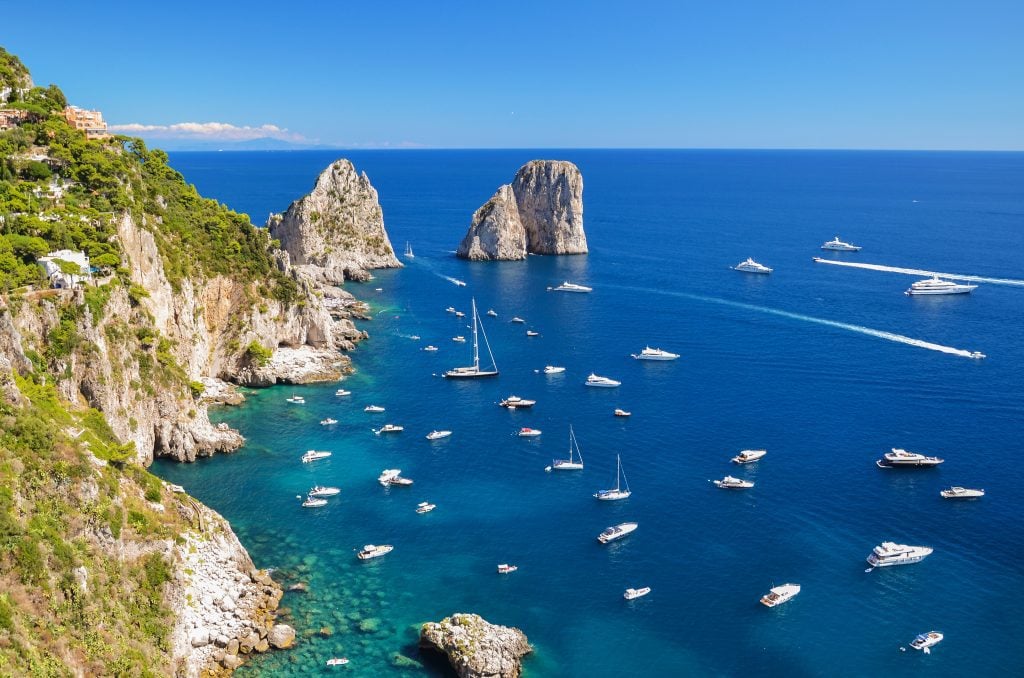
Visit Capri
The island of Capri holds a magic all its own. Known as the “island of a thousand faces,” Capri features rocky cliffs along crystalline waters and a vibrant city with a lively piazzetta tailor-made for high-end shopping and people-watching.
You can take the ferry from Naples to Capri yourself, which is a 50- to 70-minute journey depending on the ferry. See the full ferry schedule and book here ; I recommend booking ahead of time in high season.
You can also take a full-day tour that begins with an exhilarating jetfoil ride from Naples to Capri. Then, take in the views as you traverse Mamma Mia road before stopping in Anacapri for a little shopping. From La Piazzetta, ride the furnicular to Marina Grande and take in the natural wonders of the Blue Grotto.
As the day winds down, return to your pick-up point by jetfoil. It’s an action-packed day of natural beauty and authentic Italian island life that you can’t quite get in Naples. Prices for the tour start at 162 EUR ($175).
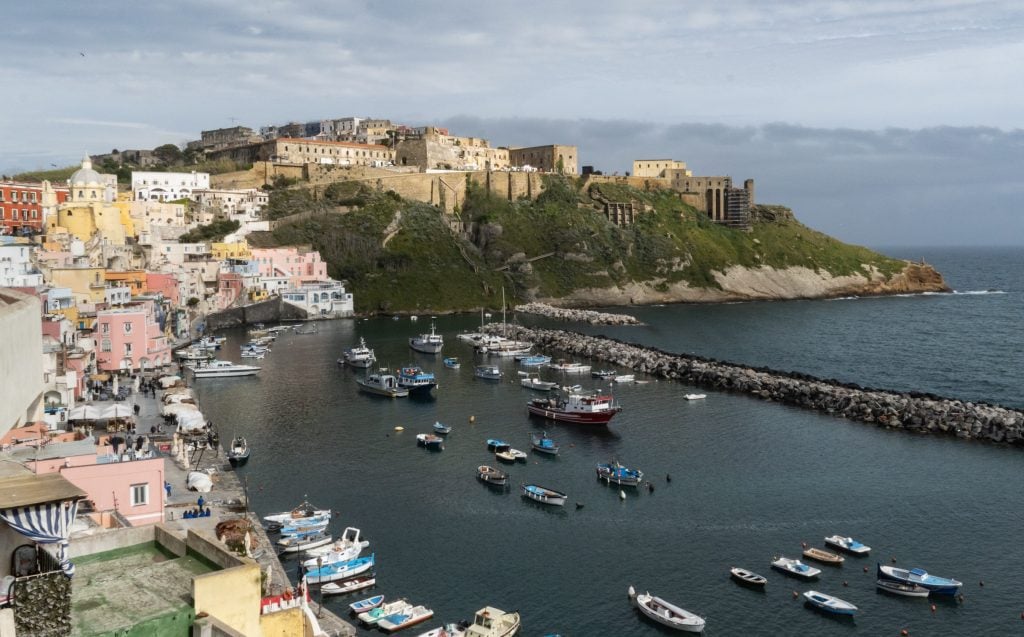
Visit Procida
Of the three major islands in the Bay of Naples — Capri, Ischia, and Procida — Procida is the closest to Naples, the smallest, and the least well-known. If you’re going to do any island day trip, Procida makes a great choice!
Procida is home to one of the most colorful harbors in Italy — seriously, it puts Cinque Terre to shame — and it’s a lovely, laid-back place. It makes a pretty fantastic foil to Naples! And I love that it’s small enough to get around the whole island on foot.
I happened to be in Procida on the day it was declared Italy’s Capital of Culture in 2022, and the entire island erupted in a colorful celebration. What a time to visit!
You can take the ferry from Naples to Procida yourself, which is a 30- to 60-minute journey depending on the ferry. See the full ferry schedule and book here ; I recommend booking ahead of time in high season.
Want the easier option with swim stops? Book a boat tour to Procida that includes lunch . Alternatively, you can do a combination trip to both Procida and Ischia from Naples .
A word to the wise: take a motion sickness pill if you’re taking the fast hydrofoil. The car ferries are much slower and more stable.
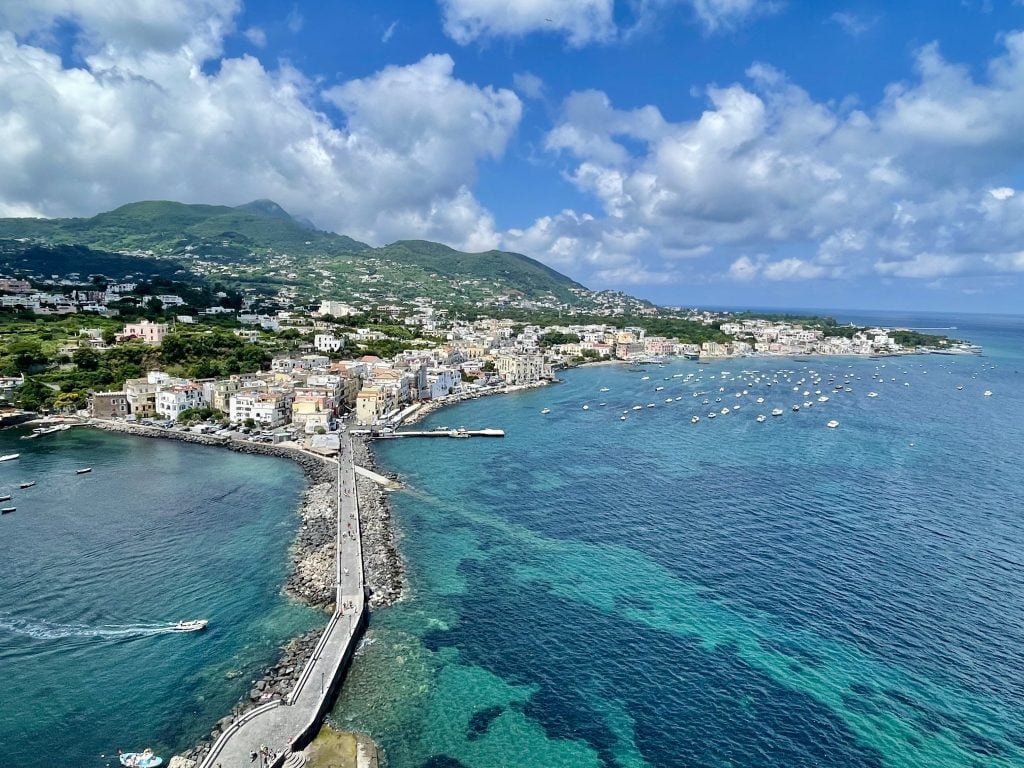
Visit Ischia
Ischia is the largest of the three islands in the Bay of Naples — and a bit of an enigma. While enormously popular with Neapolitans looking for a summer getaway, Ischia isn’t nearly as popular with international travelers, which gives it a much more feel.
Ischia is one of my favorite islands in Italy. It reminds me a bit my beloved Koh Lanta in Thailand — the development is kept at a reasonable level, which keeps it from turning into a madhouse (or overpriced Capri).
You might know Ischia from Elena Ferrante’s Neapolitan novels — a pivotal scene from My Brilliant Friend happens on the beach in Ischia!
Aside from the beaches in Ischia, you can enjoy the hot springs (including some lovely hot springs resorts like Negombo), enjoying the views from the Castello Aragonese, hiking up to Mount Epomeo, and eating local rabbit (for an island, they sure enjoy their inland food!).
You can take the ferry from Naples to Ischia yourself, which is a 50- to 90-minute journey depending on the ferry. See the full ferry schedule and book here ; I recommend booking ahead of time in high season.
Up for a tour? You can book a boat trip to Ischia from Naples, complete with lunch . Want a bit more? Book a combination trip to both Procida and Ischia from Naples .
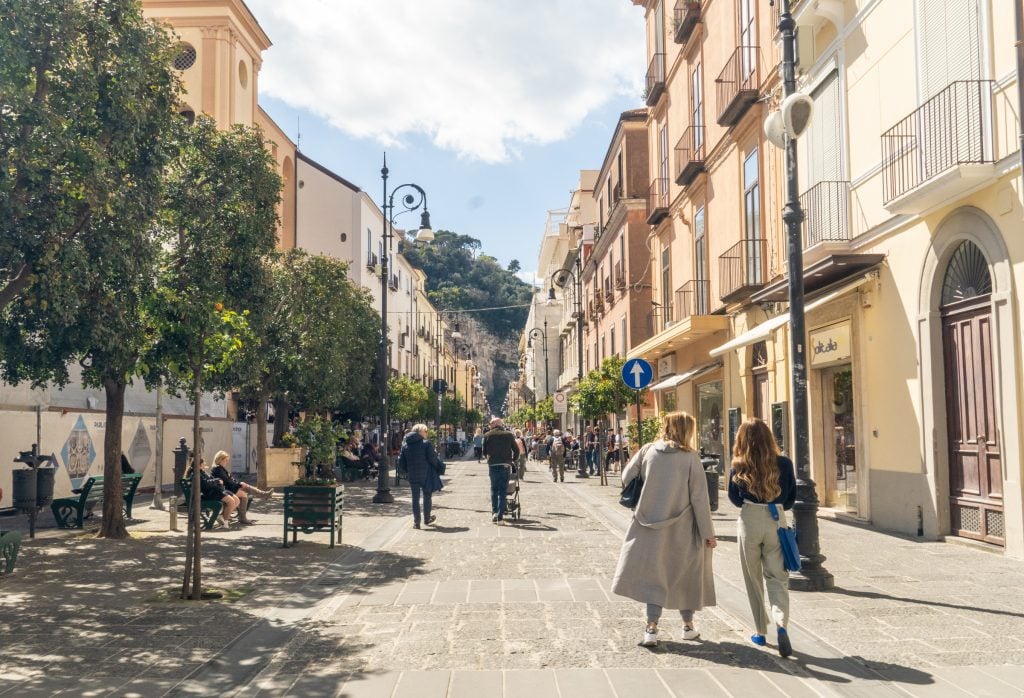
Visit Sorrento
Sorrento is one of the most popular tourist towns on the Bay of Naples. In fact, it’s perhaps more famous to be used as a base to visit the other, more spectacular surrounding destinations, like Positano and Capri.
But if you want to explore a pretty and chilled out town, Sorrento makes a lovely day trip from Naples. Spend your day walking the colorful streets, having fish by the seaside in Marina Grande, or tasting Sorrento’s finest local limoncellos.
The best way to get from Naples to Sorrento is to take the Campania Express train from Naples. This is a tourist train down the coast that only takes 50 minutes, and the railway staff will actually walk you down to make sure you get on the right train!
But if you’d rather travel by water, the ferry from Naples to Sorrento takes 35-45 minutes, which you can book here .
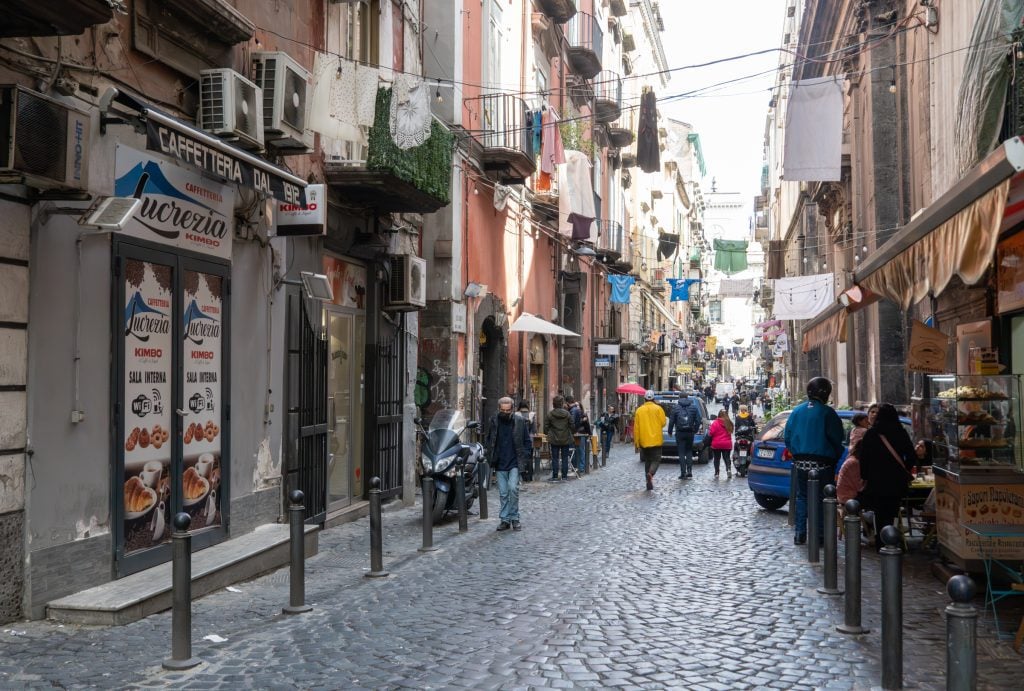
Is Naples Safe?
You might be wondering whether Naples is a safe place to visit in Italy, and I understand — Naples hasn’t always had the greatest reputation. But what you should know is that nowadays, Naples is as safe as any other major city in Europe today.
Naples might not be as chic as Milan or as sophisticated as Florence, and poverty is more visible here, but that doesn’t mean it’s less safe for you as a traveler. People in Naples look out for each other, and it’s much, much safer than it used to be a few decades ago.
For the most part, you can stay safe in Naples by doing what you’d do in any other major city: keep an eye on your belongings; use a crossbody purse that zips shut; limit your drinking; call a taxi at night if you don’t want to walk or take transit. You can see more in my travel safety tips for women .
Other than the basics, in Naples I would recommend avoiding the port area and the area around the train station after dark, and being extra cautious when crossing streets, as the driving here is as wild as it gets. Don’t drive here if you don’t thrive in a chaotic driving environment.
Read More: Solo Female Travel in Italy: Is it Safe?

How Much Time to Spend in Naples Italy
How much time do you actually need in Naples, Italy? Lots of people pop in for a single day visit and head off to Sorrento, and it makes my heart hurt thinking about how much those travelers are missing!
I personally recommend spending three days in Naples — two days for exploring the city, and one day reserved for the day trip of your choice (Pompeii, Procida, Amalfi Coast, etc.).
Eat pizza every day. Or multiple times a day. You won’t regret it!
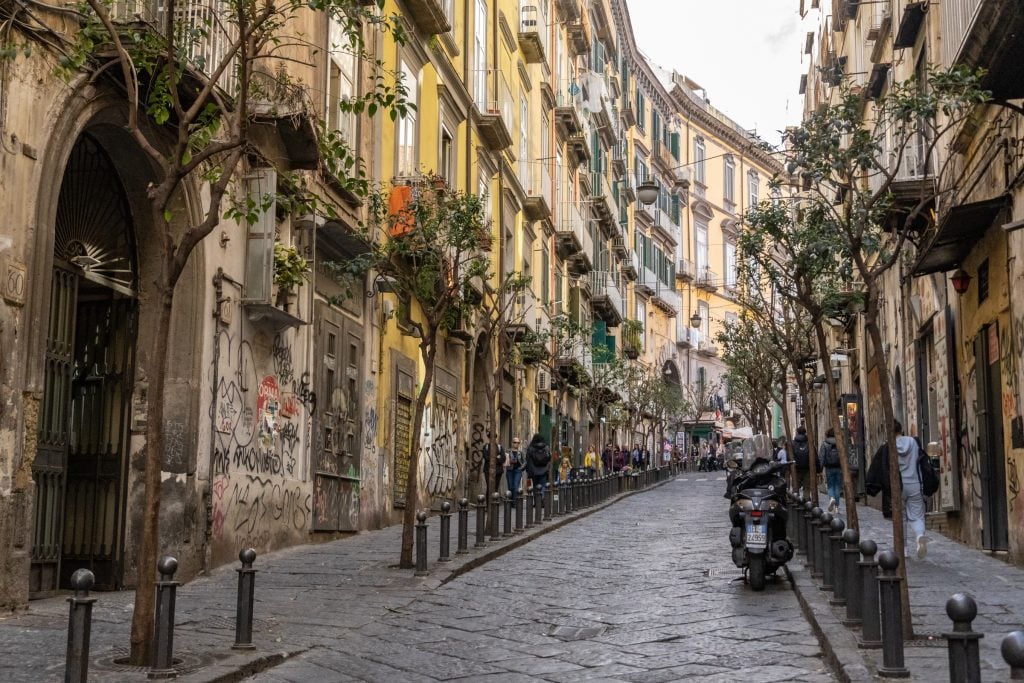
How to Get to Naples, Italy
Naples is extremely well-connected by airlines. Budget airlines connect Naples with cities all over the European continent, and there are easy connections from North America and beyond (often through Milan, Rome, or Frankfurt). I recommend checking Skyscanner for the best rates.
As for traveling within Italy, there are plenty of train connections to Naples, including high-speed connections. I recommend planning European train journeys with Omio.
There are abundant bus and ferry connections to Naples as well.
If you’re road-tripping through Italy, though, I urge you not to drive in Naples. You won’t need a car in the city and the driving here can be really awful. Leave your car outside the city, or make this the end or beginning of your trip.
Read More: 17 Must-Know Tips for Driving in Italy
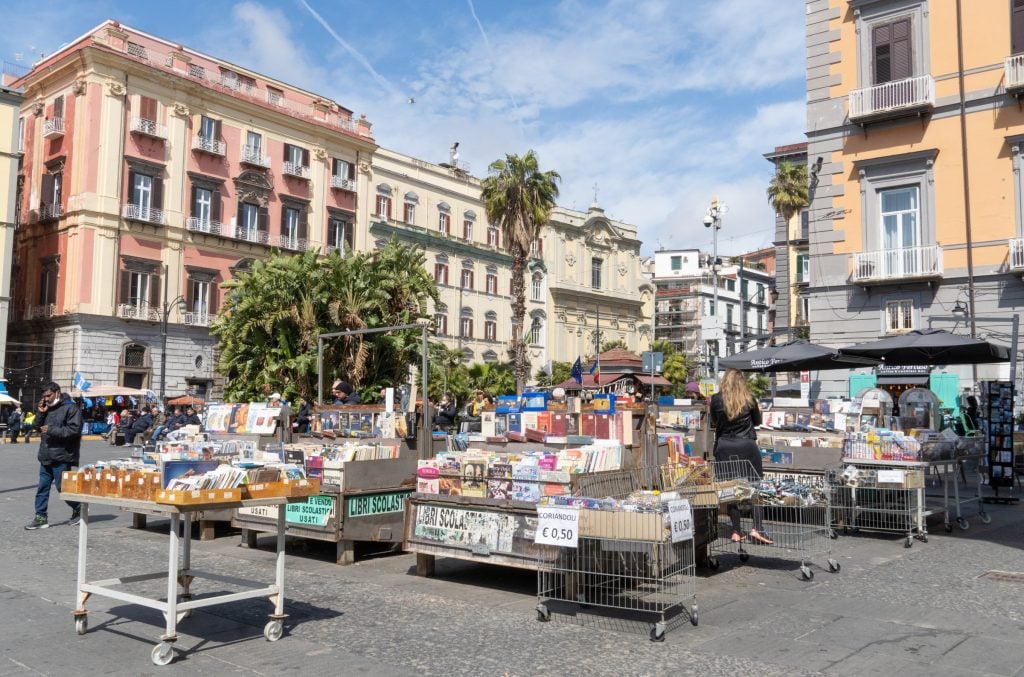
Best Time to Visit Naples, Italy
Naples is a thriving city where people live year-round, and for that reason, you can visit Naples at any time of year and have a great time. But what time is best?
In general, I think Italy is best visited during the spring and fall (perhaps the fall a bit more than spring), and that goes for Naples as well. But because it’s a bit warmer in Campania and Southern Italy, you can enjoy a longer summer. You can swim as early as May or as late as October.
If I were planning a sun-beach-and-water trip to the Bay of Naples (Naples, Amalfi Coast, islands, etc.) — I would go in early June or early October. If it’s just a city getaway to Naples, I think April, May, October, or November would be lovely.
Summer can get extremely hot, crowded, and expensive. And don’t think that September is shoulder season — September is now the priciest month of the year for accommodation on the Amalfi Coast!
If you visit in winter, this can be a cheap and crowd-free time to visit — but keep in mind that many buildings in Southern Italy are not heated well at all. I learned that the hard way in Sicily in winter , and this can often make it feel even colder than it is. Be sure to bundle up, even if it’s warmer than winter in your home.
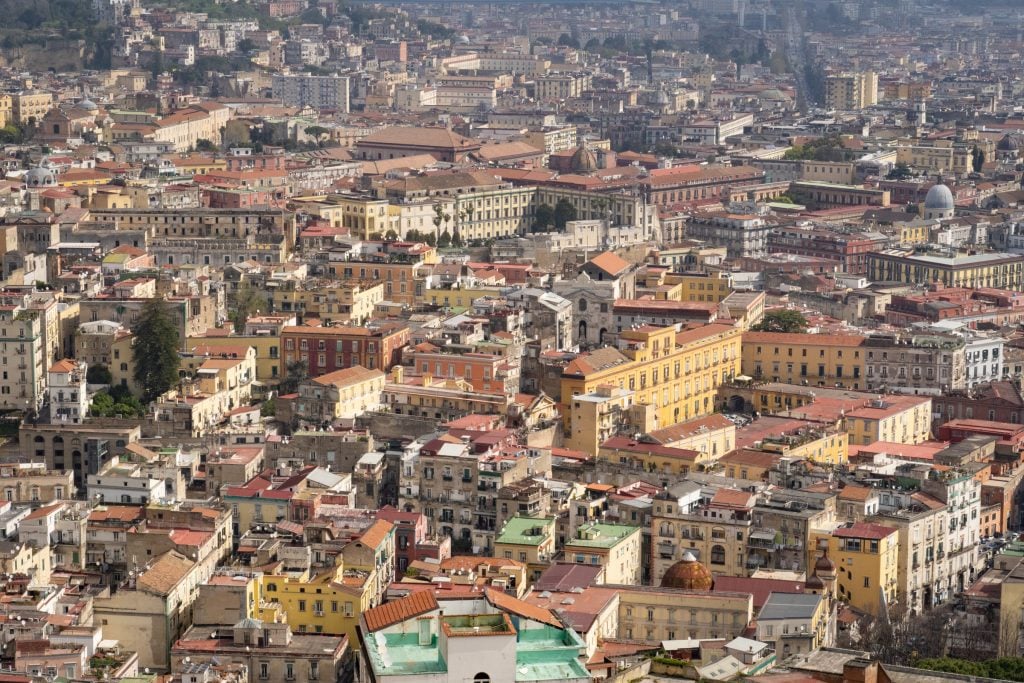
Where to Stay in Naples, Italy
Accommodation in Naples can be a bit tricky. There aren’t as many high quality hotels here than in other Italian cities, and you might notice that there are very few chains you’ve heard of.
In general, I recommend staying within walking distance of the historic center, or near the Quartieri Spagnoli. Avoid the area by the train station. And if you’re looking for something more high-end, some of the more luxurious hotels are along the waterfront.
Even so, I’ve gone through the list and picked out a few with high ratings from the best neighborhoods:
Top-Rated Hotels in Naples Italy:
- Top-Rated Luxury Hotel in Naples, Italy: Amadomus Luxury Suites has gorgeous, high-quality suite-style rooms a stone’s throw from the historic center of Naples.
- Top-Rated Mid-range Hotel in Naples, Italy: Sanfelice 33 Luxury Suites features modern, colorful rooms, some with balconies looking over the vibrant street life!
- Top-Rated Budget Hotel in Naples, Italy: Il Taschino Suite is a bit between the Centro Storico and Quartieri Spagnoli and features simple rooms in a great area for a low price.
Find deals on hotels in Naples here.
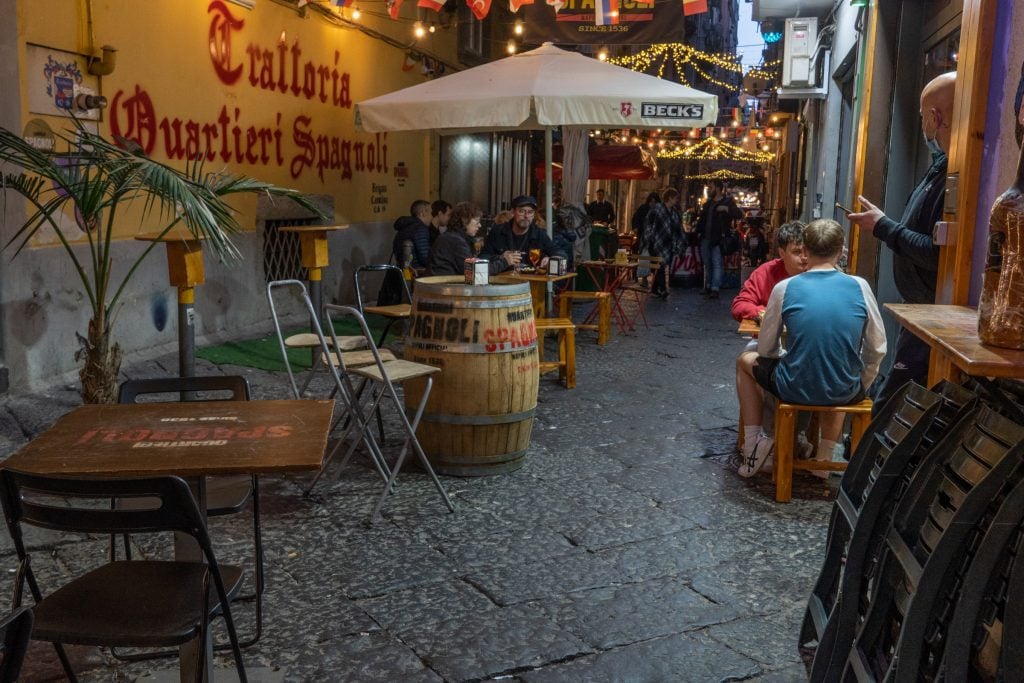
Travel Insurance for Italy
One last note — it’s absolutely vital to have travel insurance before traveling to Naples, or anywhere in Italy. If you get sick or injured on your trip, if you get robbed, or even if you have to be flown home for more care, travel insurance will protect you from financial ruin. World Nomads is a company I have used for trips to Italy.
Travel insurance will help you in your hour of need if you come down with appendicitis in Naples, or trip and break an ankle while climbing down those stairs, and if your flights get canceled, you can get accommodation and new flights paid for.
As always, be sure to read your policy carefully and make sure it’s a fit for you. See what World Nomads covers here.
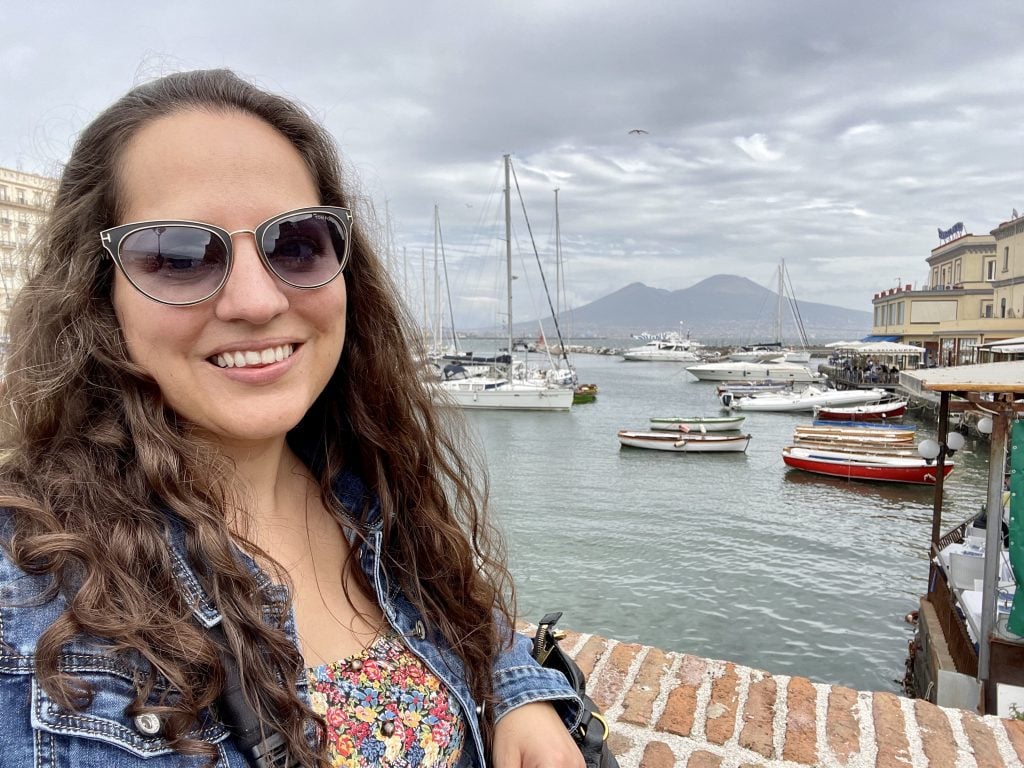
Is Naples Worth It?
Naples is one of my favorite cities, and a place that I will ALWAYS be happy to come back to — so YES, Naples is absolutely, 100% worth it. In fact, I wish that more travelers to Italy spent more time in Naples.
So many people think that Naples is only a place to visit quickly before heading out to the more aesthetically pleasing destinations of the Bay of Naples, from Positano to Sorrento to Capri.
But Naples is such an interesting place to visit on its own. And if you let it get under your skin, I know you’ll love it as much as I do.
Go enjoy your time in Naples — then come back and tell me all about it!
Planning a Trip to Italy:
- What NOT to Do in Italy
- Solo Female Travel in Italy: Is it Safe?
- Ultimate Guide to Driving in Italy
- How to Stay at an Agriturismo in Italy
- 30 Cities in Italy Most Worth Visiting
- 30 Stunning Mediterranean Islands To Visit In Your Lifetime
Cool Places in Southern Italy:
- Tropea, Italy: A Spectacularly Situated Beach Town
- The Stunning Trulli of Alberobello, Italy
- The Joys and Challenges of Traveling in Sicily
- Where to Go in Eastern Sicily
- 23 Fun Things to Do in Palermo, Sicily
- Complete Guide to the Aeolian Islands, Sicily
- Aci Trezza: A Laid-Back Coastal Town in Sicily
- Visiting Sicily in the Winter: Worth it or not?
- 22 Best Places to Visit in Sicily
- 16 Fun Things To Do In Sorrento
- 16 Fab Things to do in Lecce, Italy
- 17 Fun Things to do in Bari, Italy
- 15 Best Things to do in Monopoli, Italy
- 17 Fun Things to do in Matera, Italy
Cool Places in Northern Italy:
- Three Weeks in Northern Italy: An Itinerary
- Parma, Italy: A Colorful, Artsy, Delicious Town
- Where to Stay in Rome: Best Neighborhoods and Accommodation
- Three Days in the Dolomites: A South Tyrol Getaway
- Best Day Trips from Florence, Italy
- The Immaculate, Bursting Mosaics of Ravenna, Italy
- 25 Best Food Experiences in Emilia-Romagna, Italy
- 23 Best Things to Do in Bologna, Italy
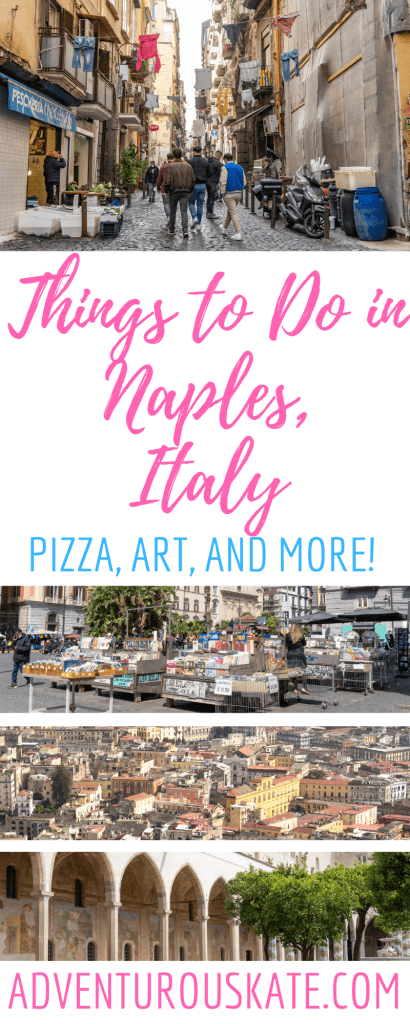
Have you been to Naples Italy? What’s your favorite thing to do? Share away!

The 15 Best Things to do in Naples, Italy
- Pinterest 85
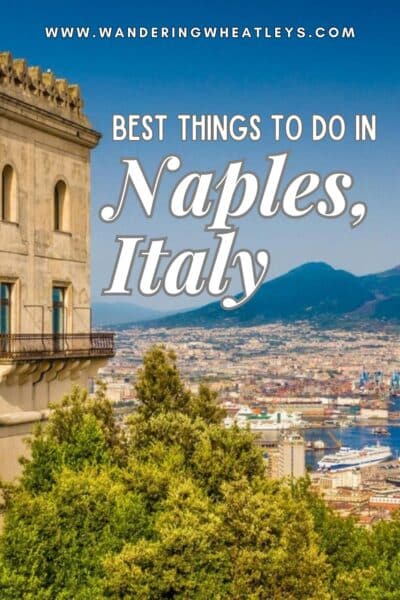
Famous for being the home of amazing pizza with a super light and fluffy crust, there’s a lot more to Naples than one of the best dishes that’s ever been invented. It may look a little rough and ready, but the city’s ancient streets harbor a wealth of fascinating attractions and unbeatable experiences you’ll be talking about for years to come.
Winter in Naples can get a little grim, with temperatures dropping down to 40°F and plenty of rain. That’s why we recommend visiting in summer. At this time of year, the skies are clear, there’s plenty of sunshine, and temperatures are around the mid-70s. It’s a wonderful time to explore the many outdoor attractions the city has to offer.
With so many exciting things to see and do, you may be struggling with where to begin. To help you out, we’ve put together a list of the ultimate best things to do in Naples, Italy . Add these cool activities and attractions to your Naples bucket list, and you’re guaranteed to have an incredible time exploring this historic Italian city.
Disclaimer: This post may contain affiliate links. If you make a purchase or booking through one of our links we may earn a small commission (don’t worry, it’s at no extra cost to you).
The 15 Best Things to do in Naples
1. see the erotic art salvaged from pompeii and herculaneum.
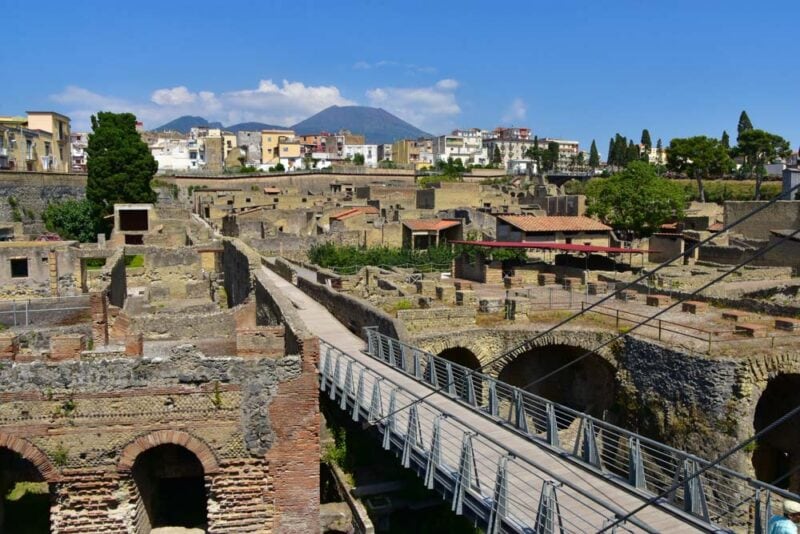
Pompeii is one of the most important sites in Italy. But you won’t find all the cool stuff that was salvaged after the eruption in the cities. If you want to see that, you need to go to the National Museum (Museo Archeologico Nazionale di Napoli).
This fascinating museum is home to all sorts of erotic art that was discovered by archaeologists in the 19th century as they were excavating the area. Definitely one of the most unique things to do in Naples, a trip to this museum will open your eyes to statues of the incredibly well-endowed god Priapus who was often used as a good-luck symbol on everything from phallic wind chimes and all kinds of bizarre sexual paintings.
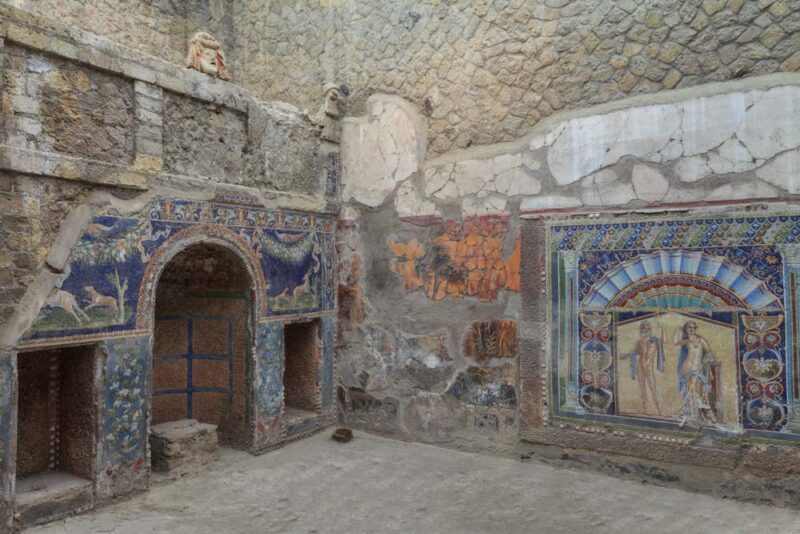
The Goat is the most popular piece to check out. The unusual artifact depicts a satyr being intimate with a female goat. If you take a close look, you can see the couple gazing into each other’s eyes romantically.
2. Stand at the Peak of Mount Vesuvius
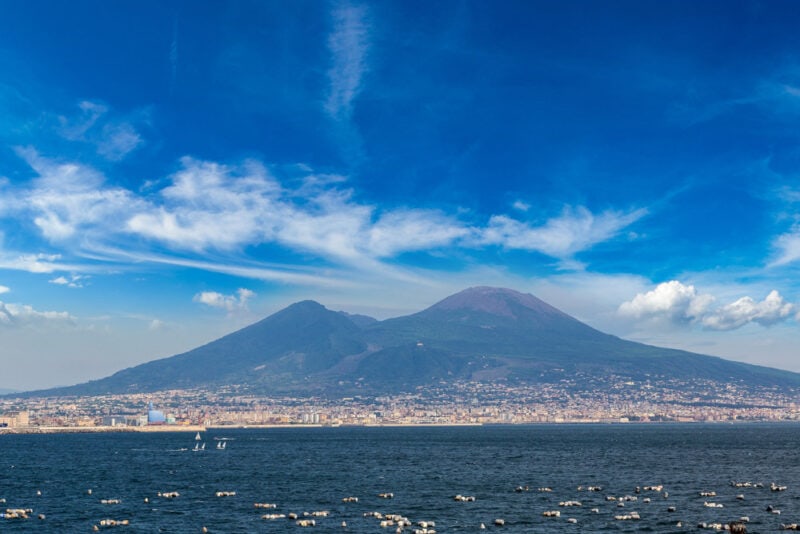
You won’t find the most astounding panoramas at street level. For the best sights in Naples, you need to grab your hiking boots and conquer Mount Vesuvius. This natural wonder dominates the skyline and can be seen from practically everywhere in the city.
It erupted way back in 79 AD, causing the catastrophic destruction of Pompeii and Herculaneum. Although it’s still classed as an active volcano today, it’s very unlikely to erupt, making it safe to climb.
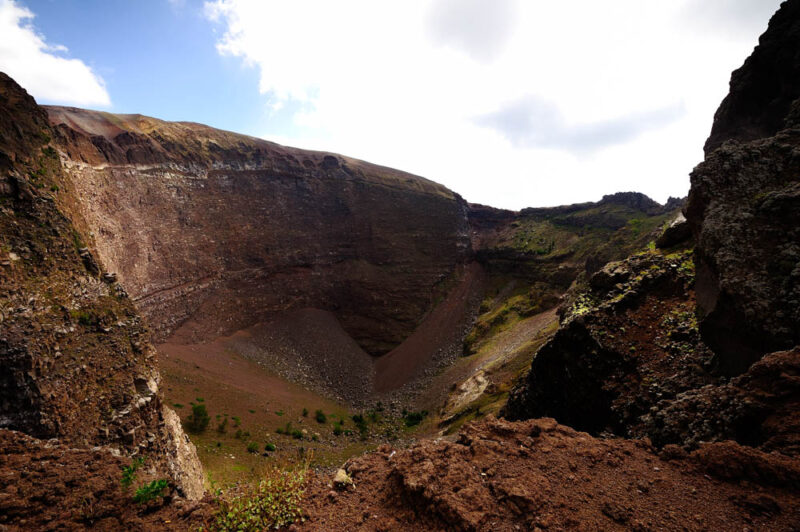
To reach the summit, you’ll need to take the EAV Circumvesuviana train from Napoli Piazza Garibaldi to Ercolano, then hop on a shuttle bus. After that, there’s just a 20-30 minute hike to the top of the volcano.
If that sounds like too much fuss for you, there is an easier way – sign up for a guided tour. This relaxed tour starts with a wonderful lunch at a vineyard before heading to the peak of Mount Vesuvius. It includes skip-the-line tickets, so you don’t have to worry about wasting any time.
3. Step Back in Time at Castel Nuovo
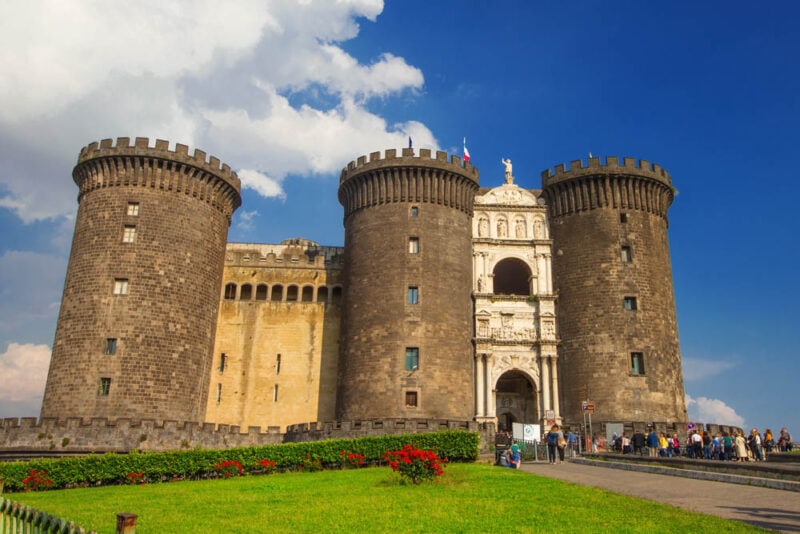
For some top-notch Naples sightseeing, head to Castel Nuovo. Originally built sometime between 1279 and 1282, this ancient fortress is one of the main features of the city’s skyline and is the first thing that will pop into view if you arrive in the city by cruise ship.
Thanks to its convenient location, just steps away from the Piazza del Plebiscito, Castel Nuovo is incredibly easy to access. Although it was first built in the 13th century and commissioned by King Charles I of Anjou, it was completely rebuilt in the 15th century under the rule of Alfonso V of Aragon. This is why it has a quintessential Medieval Renaissance look today.
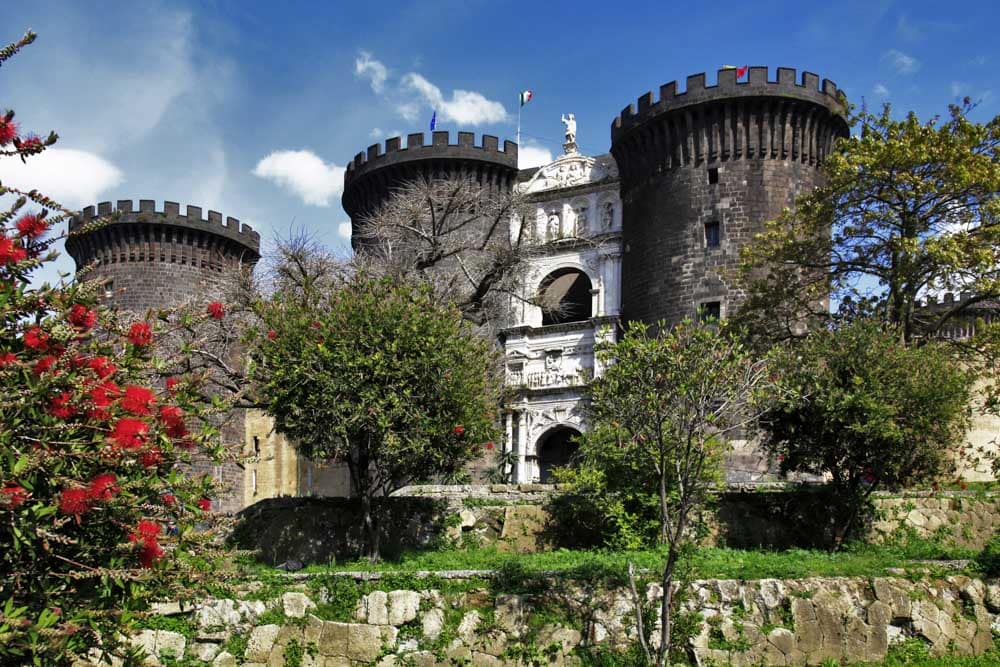
Castel Nuovo is overwhelmingly large, and you could easily spend an entire day exploring it. It’s made up of five round towers, which are joined together by solid stone walls. To enter, you have to pass through a stunning white marble arch tucked between two watchtowers.
Some of the most impressive parts of the castle you’ve got to check out include the Cappella Palatina, where you can see ancient frescoes, and the Armory Hall, where you’ll find genuine Roman ruins kept safe below a glass floor.
4. Stop by the Most Beautiful Metro Station in Europe
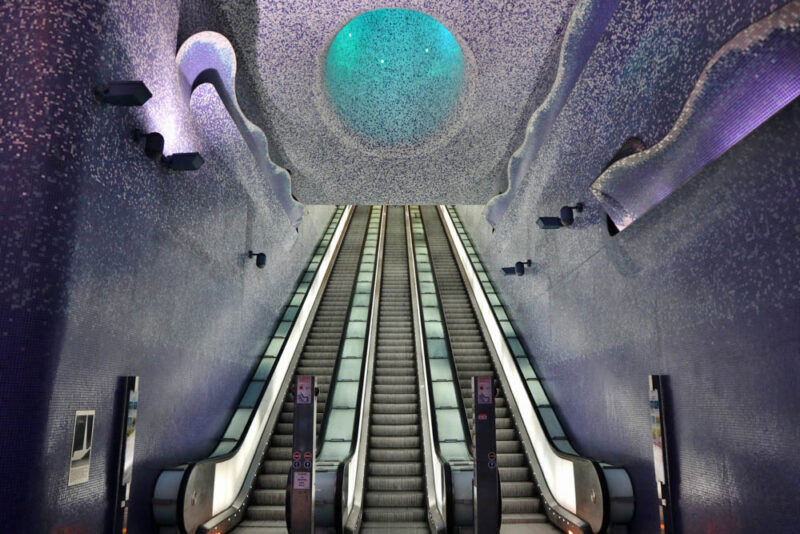
You may not think a metro station is worthy of being on a list of the best things to do in Naples, but just wait until you see the Toledo metro station. This station looks perfectly ordinary from the outside. But as you step onto the escalator that takes you 130 feet underground, you’ll feel like you’re in an art gallery – not a place where the metro whizzes through.
The Toledo metro station is divided into levels, each of which is themed with a different color that relates to a certain aspect of the city. The atrium on the first floor is black – a reminder of the asphalt of contemporary civilization. Take a look around, and you’ll spot original Aragonese mosaics set into the walls.
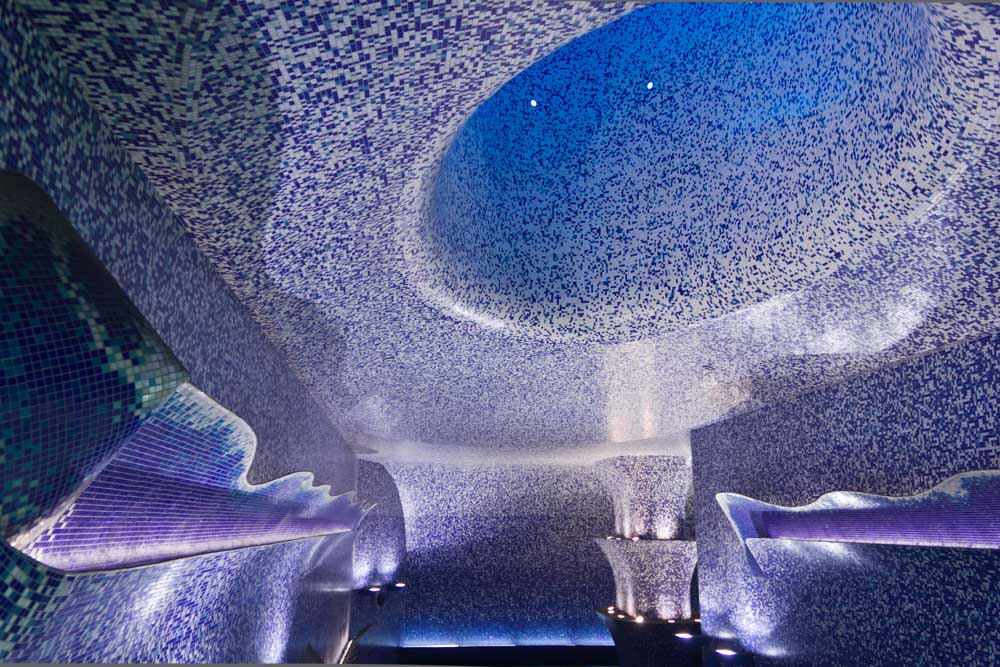
Continue on down, and you’ll discover mesmerizing walls that transform to shades of red and yellow, reflecting the Neapolitan sun. The deepest level is reserved for an impressive blue and green color scheme that has been influenced by the sea.
5. Fall In Love With Authentic Neapolitan Pizza

No matter how many times you’ve had this fast food favorite before, ordering a genuine Neapolitan pizza is one of the must-do things in Naples. What makes Neapolitan pizza unique is the requirements it must meet to be worthy of the name.
It can only be topped with San Marzano or Pomodorino del Piennolo del Vesuvio tomatoes and Mozzarella di Bufala Campana or Fior di Latte. The pizza dough must be made from wheat flour, Neapolitan or brewer’s yeast, salt, and water. This all makes it sound pretty boring, but just wait until you taste it!

One thing to keep in mind is that you won’t see Neapolitan pizza advertised in Naples. This is because all the pizza in the city is Neapolitan. So wherever you see pizza on sale, you can be sure it’s the special kind.
Sorbillo is one of the most popular pizzerias in Naples, and for good reason, too. You may find yourself waiting up to 90 minutes to get in, but it’s worth it for the chance to devour some of the most incredible pizza you’ve ever had in your life.
6. Walk through the Ruins of Pompeii
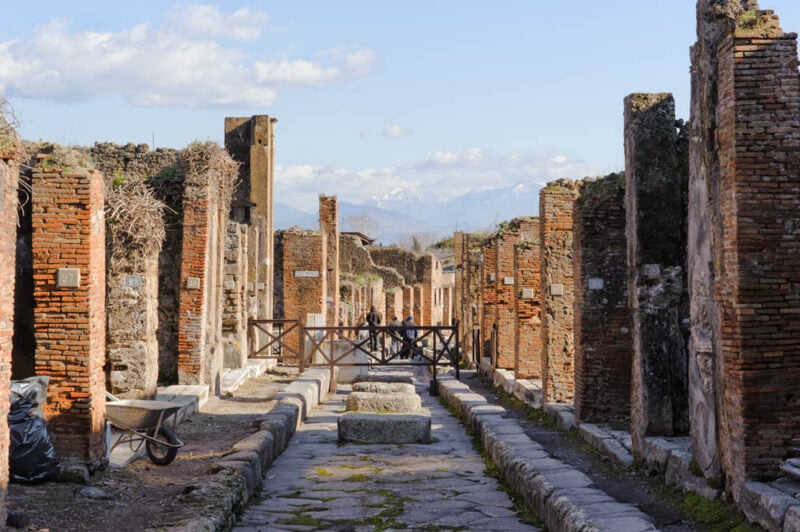
Wandering around the ancient remains of Pompeii is definitely one of the coolest things to do in Naples. This is the city that was almost completely destroyed when Mount Vesuvius erupted in 79 AD. Although a lot of the most interesting artifacts and discoveries are kept safe in the National Museum, there are still plenty of remarkable things to discover in the city.
The significant amount of ash that settled over the city acted as a protective layer, keeping Pompeii in a pretty good condition. Some of the most impressive parts of the city include the Temple of Jupiter, the Temple of Apollo, and the Amphitheater. While you’re totally free to explore the place on your own, we suggest you sign up for a tour to get the most out of it.
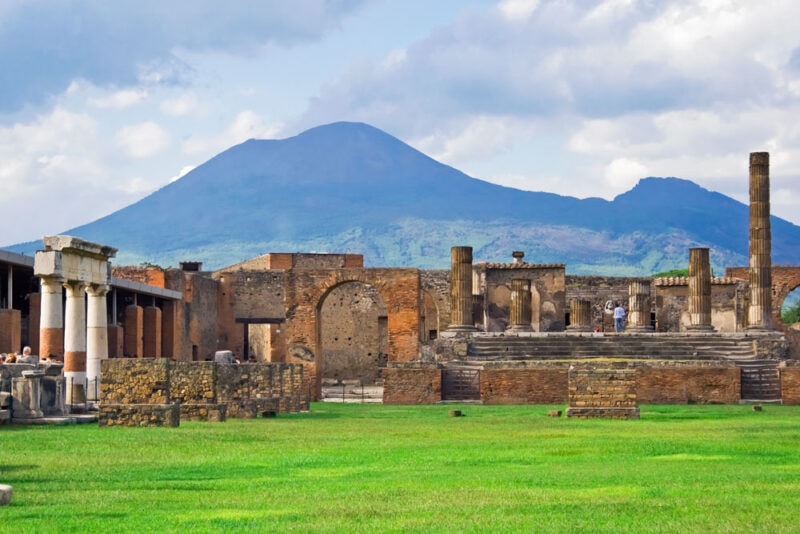
This small group tour starts with an overview of the settlement, where your guide will point out the most important structures. They’ll also help you spot the hidden-in-plain-sight signs that pointed to brothels almost 2,000 years ago. They’re really hard to spot on your own if you don’t know what you’re looking for. You’ll have the chance to spend the rest of the day exploring at your own pace.
7. Explore Places Usually Off-Limits as Part of Maggio dei Monumenti
If you’re planning on visiting the city in late spring or early summer, you’ve got to check out the Maggio dei Monumenti. One of the top Naples activities, this event takes place throughout April, May, and June and gives you the chance to explore fascinating cultural spots that visitors aren’t normally allowed to enter.
With an exciting program packed full of guided tours, theater performances, art displays, rare exhibits, book readings, and loads more, there’s plenty of stuff going on to keep you entertained, whatever you’re into. Most of the activities are held in churches, palaces, and exhibition halls that waive the entrance fee as part of the event.
Although each edition of the festival features similar activities, every year follows a new theme, making it unique. The themes are usually dedicated to a specific historical character who had a major impact on Naples.
As all the events are free and accessible to everyone, Maggio dei Monumenti is an excellent opportunity to learn more about Naples’s culture and history on a budget.
8. Be Amazed by the Displays at the Museo Cappella Sansevero
Naples is bursting with magnificent architecture, and the Museo Cappella Sansevero is one example you’ve got to check out. One of the most astounding things to see in Naples, this conspicuous chapel was built in 1590 and was originally a private building exclusively created for the Duke of Torremaggoire.
By 1613, it had become the family’s chapel, and today it has progressed into one of the most stunning tourist attractions you’ll find in the city. From the outside, the chapel doesn’t look like it’s even worth visiting. But as soon as you step through the entrance, you’ll definitely be glad you did.
Almost every inch of the inside of the church is decorated with incredibly intricate carvings and sculptures. There’s so much to take in that it’s impossible not to feel overwhelmed. No matter how long you spend looking around, you’ll notice new things you didn’t see at first again and again.
Even the ceiling is covered in dramatic frescoes with marvelous marble statues perched on either side.
9. Celebrate Christmas at Via dei Presepo
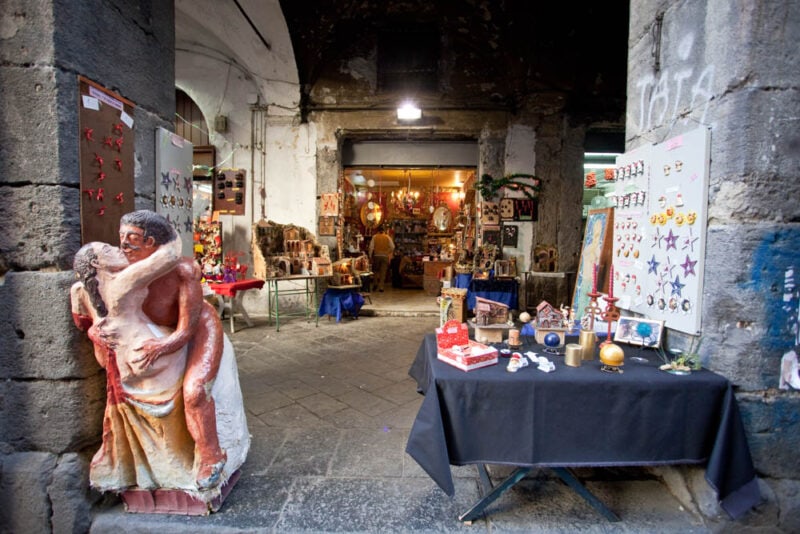
No matter what time of year you choose to visit, one of the most fun things to do in Naples is to take a walk down Via dei Presepo. Located in the beating heart of the city, this street is officially known as Via San Gregorio Armeno, but it’s known by its nickname because it’s filled with cute shops selling the traditional Neapolitan presepio (Christian nativity scene).
Whether you visit at the beginning of December or the middle of August, you’ll find this street packed with stores of all sizes selling every kind of nativity figure you could imagine. As well as all the classic characters you’d expect to see, some of the stores even sell modern figurines, like Taylor Swift, Kim Kardashian, and Johnny Depp, which you can use to create a one-of-a-kind festive scene.
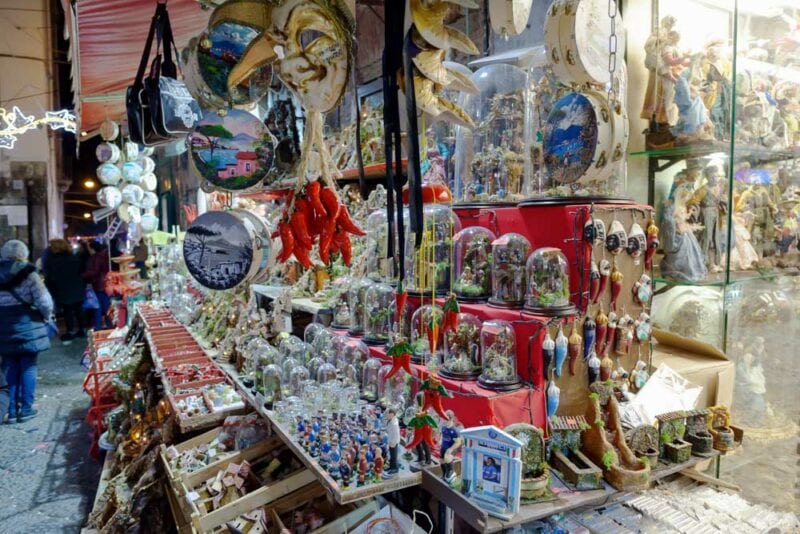
This street is a fantastic place to swing by to pick up a unique memento of your trip or quirky gifts for friends and family back home. Because there’s so much competition along the street, all the prices are pretty reasonable, so you don’t have to worry about shopping around.
10. Snack on Sfogliatelle

When you need a break from hopping between all the Naples attractions, stop by a bakery and order yourself a sfogliatelle . Known as a lobster tail in the US, these amazing pastries are so addictive that you’ll never be able to stop at just one. The name translates into English as “small, thin leaf” and that’s what they look like – super-fine layers of pastry piled high, with a wonderfully rich and creamy filling in the center.
You’ll find two different types of sfogliatelle in Naples. There’s a “Riccia” version which is the flaky, curly ones most people are familiar with and the “Frolla” type which is like a miniature ricotta pie. Try both and work out which one you like best!

SfogliateLAB is the best place in the city to try this classic pastry. This bakery has been owned by the Ferrieri family for more than 100 years and serves traditional sfogliatelle . The master bakers also deliver amazing sfogliacampanella , which is a combination between sfogliatella and baba .
11. Live the Neapolitan Life in Santa Lucia
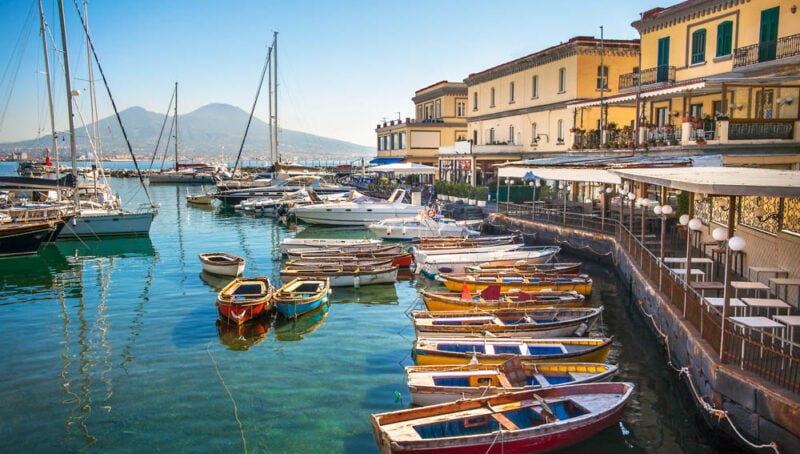
Neapolitan towns and villages are beyond stunning, and one of the top things to do in Naples is to take your time and really get to know them. One gorgeous neighborhood that’s worth going out of your way to check out is Santa Lucia. Located to the west of Piazza del Plebiscito, this enchanting district is teeming with narrow cobbled streets that are just begging to be explored.
We suggest you simply start walking and see where your feet take you. Head inland, and you’ll find countless cute cafes, bars, restaurants, and craft shops. Or head toward the coast, and you’ll wind up walking along a dazzling path that lines the ocean and marina.
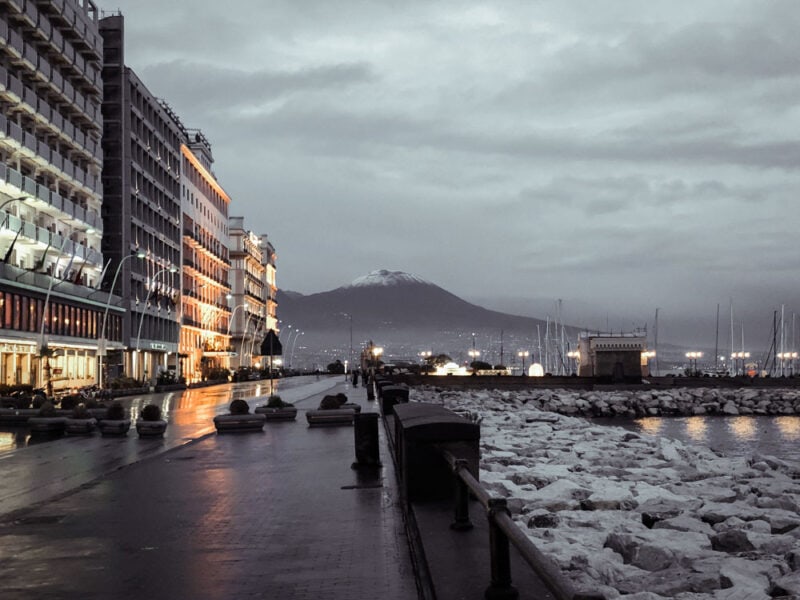
This part of the city is always bustling with locals. During the week, you’ll find them going about work chores and errands. Or if you visit on a weekend, you’ll be surrounded by locals making the most of their free time, walking along the promenade, chatting in cafes, and shopping for trinkets.
12. Attend the Napoli Teatro Festival Italia

If you’re searching for a little bit of culture, checking out the Napoli Teatro Festival Italia is one of the best things to do in Naples. This event takes place every year across several weeks between June and July, then again between September and October, giving you plenty of opportunities to take part.
Around 140 engrossing events are held throughout the festival, including exhibitions, workshops, theatrical performances, opera concerts, dance recitals, and an awards ceremony. Each year there’s also a surprise show which is definitely worth checking out.
Don’t let the language barrier put you off. A lot of the performances are very visual, making them accessible to everyone.
If you can only make one performance, we suggest the opening or closing show. They’re always the most spectacular. Take a look at the official website to find out the exact dates, times, and locations of performances.
13. Explore the Secret Catacombs of San Gennaro
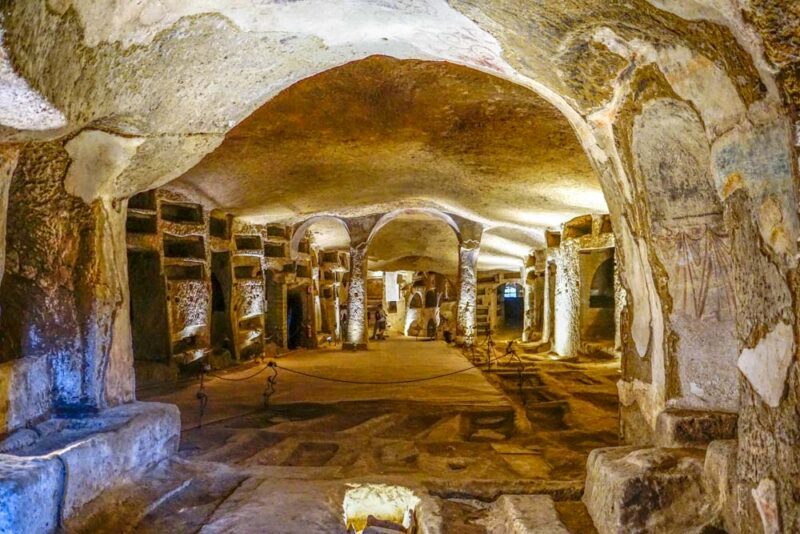
Looking for obscure activities that you won’t find in all the other travel guides? Then make plans to visit the Catacombs of San Gennaro . One of the most unusual and interesting Naples attractions, the catacombs are an underground labyrinth home to all kinds of captivating, if a little macabre, things to see.
As you explore the network of passageways and tunnels, you’ll come across hidden crypts and graves that date back to the beginning of Naples. The catacombs are divided into two intriguing layers, both of which are worth checking out.
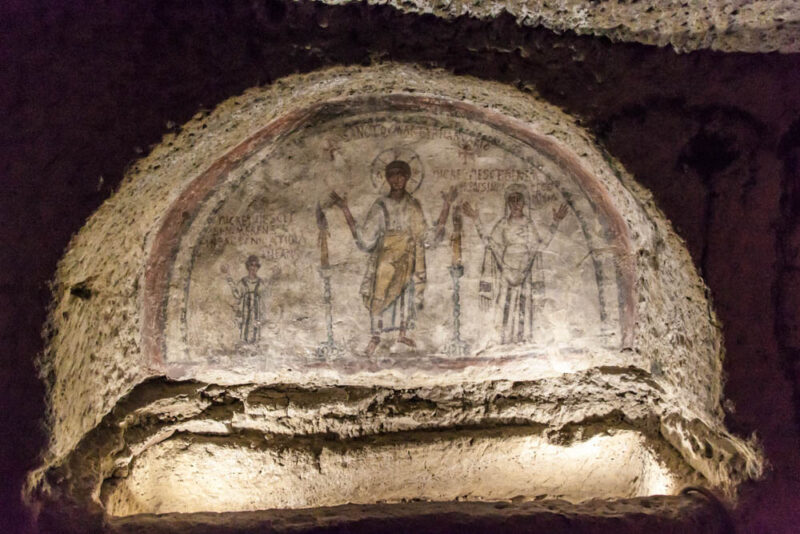
The bottom level alone is where you’ll find more than 3,000 burial sites, gently illuminated by dim lights, which adds to the eerie vibe. The top level of the catacombs is a little less spooky. Here you can take a look at beautifully detailed frescoes and remarkable artwork.
One of the best things about this attraction is that your ticket is valid for 12 months. So if you’re not sure when you plan on fitting it in, it’s still worth buying a ticket in advance.
14. Visit the Magnificent Caserta Royal Palace
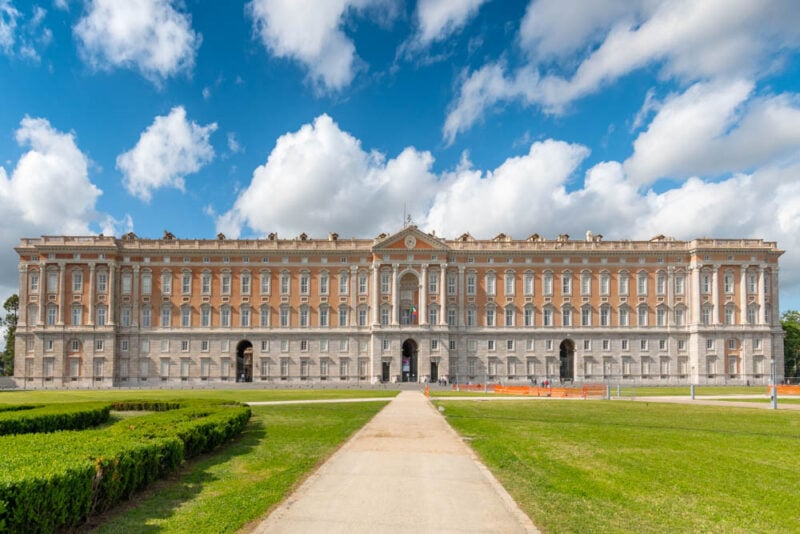
Find out how Naples’ rich and famous lived centuries ago at the Caserta Royal Palace. This gorgeous building was built in the 18th century and boasts a whopping 1,200 rooms, each of which is more exquisite and ostentatious than the last.
The regal residence has a stunning combination of styles from Tuscany, Rome, and Versailles, giving the palace a unique look you can’t help but fall in love with. It’s considered one of the best examples of Italian Baroque architecture and was way ahead of its time.
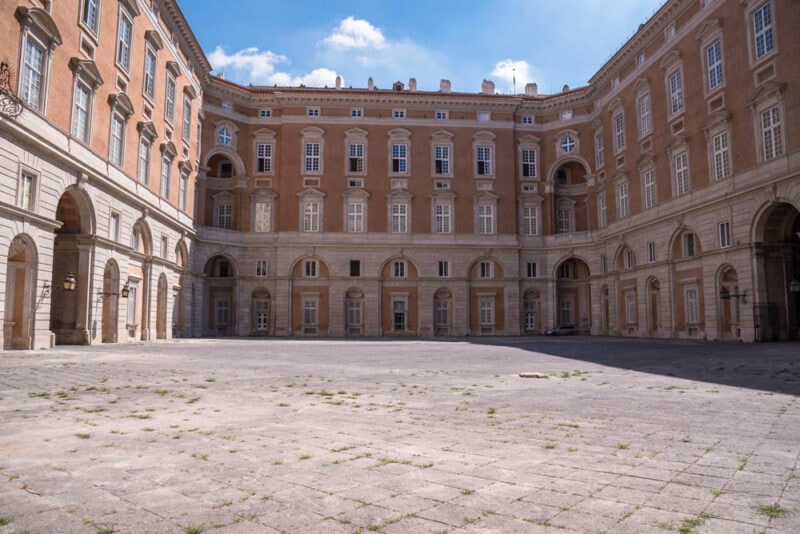
As well as the dazzling rooms, the Caserta Royal Palace also boasts 4.5 hectares of impeccable gardens. Take your time and explore the manicured lawns, bubbling fountains, shimmering pools, and cascading waterfalls that make the gardens so peaceful and relaxing.
For an awesome picture, stand at the side of the garden furthest away from the palace and look back to the building. The talented architect who designed the grounds incorporated a telescope effect that allows you to capture almost two miles of the gardens in a single shot.
15. Mix It Up With Fried Pizza

You’ve almost certainly had pizza before. But have you ever tried fried pizza? This unusual dish is hugely popular throughout Naples and tastes even better than you can possibly imagine.
The dough is made fresh and topped with creamy ricotta cheese, smoked provolone, chunks of meat, black pepper, and fresh basil – just like you’d expect from an excellent pizza. But instead of being cooked in a wood-fired oven, it’s folded in half, the edges are pressed together (like a calzone), and it’s gently placed in a deep-fat fryer.

After a few minutes, the most beautifully golden and wonderfully crispy concoction is retrieved and served while it’s still hot. Antica Pizza Fritta da Zia Esterina Sorbillo is famous for serving some of the best fried pizza in the city.
They’re bigger than your head and have the most incredibly crispy crust. They’re fabulously light, not in the slightest bit greasy, and come with a variety of fillings.
There you have it! The 15 best things to do in Naples, Italy. What’s your favorite thing to do in Naples?
Share this on pinterest.
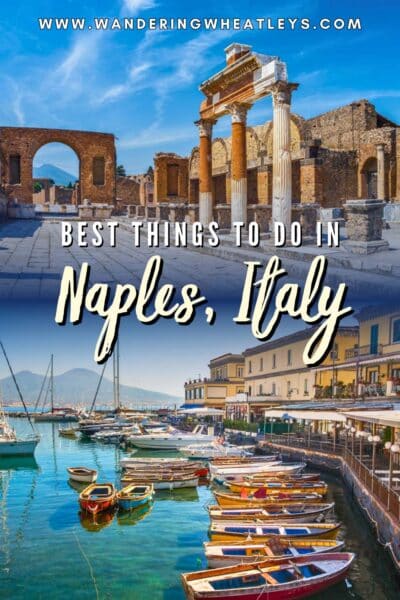
Nicola is a freelance writer with an insatiable hunger for travel. She swapped her home in the UK for the sunny Canary Islands when she was just 11 and she has been based there ever since. From crawling on her hands and knees inside pyramids in Egypt to swimming with baby sharks in Bali and searching (fruitlessly!) for the Northern Lights in Iceland, Nicola takes every chance she gets to explore new places. The incredible experiences she has around the world fuels her writing and inspires her to plan even more adventures for the future.
Related Posts
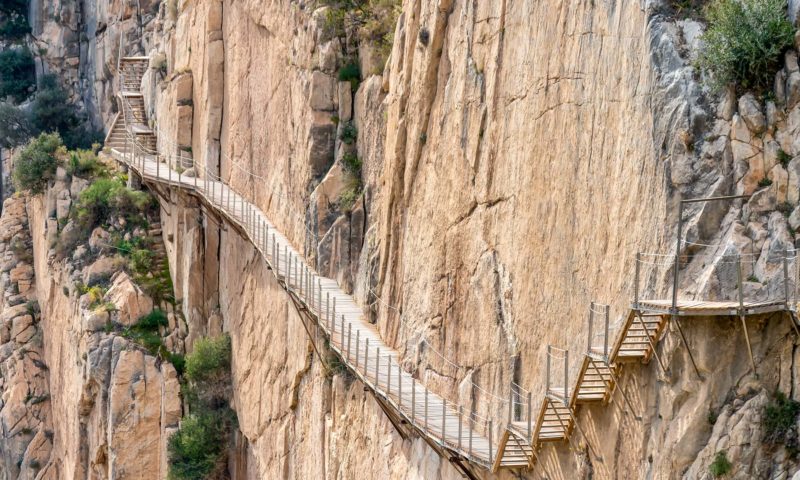
The 25 Best Things to do in Spain
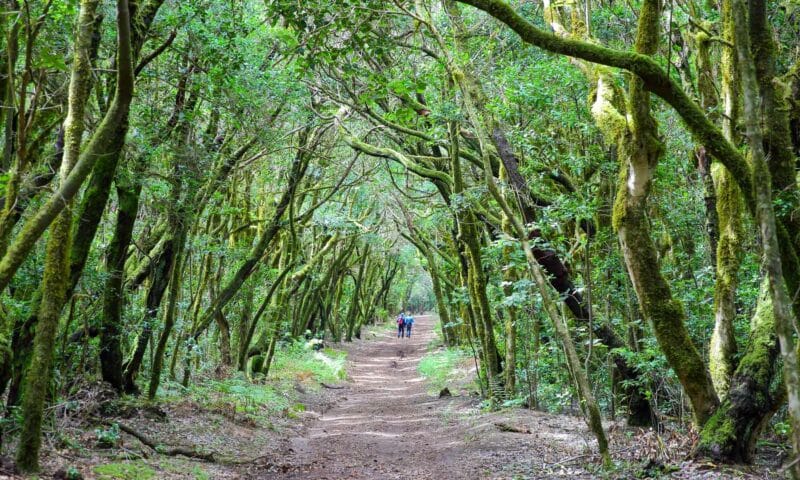
The Best Hikes in the Canary Islands – According to a Local!

3 Days in Cologne: The Perfect Weekend Itinerary
Leave a comment cancel reply.
Your email address will not be published. Required fields are marked *
Italian tourist town near Naples Crossword Clue
Italian tourist town near Naples NYT Crossword Clue Answers are listed below. Did you came up with a solution that did not solve the clue? No worries we keep a close eye on all the clues and update them regularly with the correct answers.
ITALIAN TOURIST TOWN NEAR NAPLES Crossword Answer

Best 2 Days Naples Italy Itinerary (By a Local)
By: Author Amanda OBrien
Posted on Last updated: 16/02/2024
In this article, I propose a perfect 2-day Naples Italy itinerary. Since Naples is one of the most beautiful cities near Rome , my hometown, I visit it quite often.
You may have wondered how many days are enough to visit Naples. Well, 48 hours is just the minimum amount of time you can devote to this city, vibrant with culture, beauty, and delicious food. It is the birthplace of pizza!
A famous local saying goes:
“A foreigner in Naples cries twice: when he arrives and when he leaves.”
When you set foot in the historic center of Naples, Italy, the hustle and bustle of people and scooters, the local dialect shouted from house to house, the apartment-filled old palaces will make you “weep” if you are not used to it.
But for sure, you will never want to leave the capital of “southern Italy” again.
Naples rises at the foot of Vesuvius, the volcano that destroyed the city of Pompeii in 79 A.D.- and stretches to the sea. The Gulf of Naples offers breathtaking sunsets, and the Mergellina waterfront is the perfect place to admire them while sipping a glass of wine.
In addition to natural beauty, enjoys a vast artistic heritage: some of the best places to see and main attractions include sculptures like the Veiled Christ, churches, and museums that will leave anyone who loves art speechless.
Naples Itinerary in 2 days
Day 1 – morning.
You will need very little to adapt to the vitality of this city that has been the birthplace of so many influential people, including famous Italian philosophers like Benedetto Croce.

The best way to do this is to walk on the city’s most famous street, Spaccanapoli, which literally means “cuts Naples in half.” Use the metro and get off at the Dante stop to get here. You will be in the heart of Naples’ city center or centro storico.

About two kilometers long, Spaccanapoli St. collects many of the city’s treasures.
PLEASE NOTE: Spaccanapoli is just the traditional name of this street, which is named after 7 different streets on the maps.
Why not book a Naples Walking Tour? Let a local expert bring the city to life.
GESU’ NUOVO CHURCH AND PIAZZA
Start with the Gesù Nuovo Church and Piazza. A typical Neapolitan Baroque building, the church features paintings, stupendous columns, and marble compositions. The highlight is the church’s peperino stone facade, whose blocks are carved to form spikes, like the armor of a prehistoric animal.
Immediately outside the church, the Piazza del Gesù Nuovo is a great place to admire the Obelisk. The charm of this work lies in its legend. On the tip of the Obelisk is a bronze statue of the Virgin Mary, but it is said that if you look at it from behind at dawn or dusk, you will see the likeness of the devil.

Continue on Spaccanapoli St., which here takes the name Via Benedetto Croce St., and you will arrive at the San Severo Chapel Museum. It is worth the €10 entrance fee to enter the chapel, which houses some of Italy’s most spectacular sculptures.
The chapel dates back to the 16th century when the nobles of the Sansevero family built it as a tribute to the Virgin Mary, who had performed miracles at this site.
As you enter, you will see yourself surrounded by beautiful white marble sculptures. The most spectacular is the Veiled Christ: a sculpture by Neapolitan Giuseppe Sanmartino (18th Century) representing Jesus Christ covered by a shroud.
Inside the Sansevero Chapel is also another sculpture that one cannot help but admire: the Veiled Modesty by Antonio Corradini. This time, the subject is a young noblewoman (Cecilia Gaetani dell’Aquila d’Arargona) covered by a veil. The artist used a sculptural technique to represent the veil as if wet, making it adhere perfectly to the woman’s body.
VIA SAN GREGORIO ARMENO
Continue along Spaccanapoli to see another famous street.
Via di San Gregorio Armeno St. is home to dozens of small workshops where all the creativity of Neapolitan artisans finds expression. The Nativity scene is a traditional element of Italian Christmas decorations. You will find current characters in a satirical key in these workshops, along with figurines carved with classic Nativity characters.

Have fun admiring figurines of politicians, actors, soccer players, and even reproductions of the Pope. In short, this street is one of the most attractive in the city; if you don’t visit it, you can’t say you’ve been to Naples. Besides, it is also the perfect place to buy souvenirs.

SNACK BREAK
When you reach the end of the street, you cross Via Dei Tribunali St. Here, you can find many venues to have a mid-morning snack. Those who love savory food should try the Neapolitan “cuoppo.” Cuoppo is a paperboard cone full of tiny fried foods.
For those who prefer a sweet treat, the mandatory stop is at one of the many pastry shops you will encounter on this street. Ask for baba’, sfogliatella, and pastiera, the most typical pastries of the Neapolitan tradition. But mind, do not get too full. Leave some space for lunch.

UNDERGROUND NAPLES
Napoli Sotterranea is a network of tunnels and galleries underground in the city. Perfect for lovers of history and adventure, this part of the city will awaken the Indiana Jones in you and is one of the best things to do in Naples.
You’ll discover evidence from multiple historical periods in these tunnels. Findings belonging to the Greek era of the 3rd century B.C., Roman remains from the Augustan age, and even from World War II. The tour lasts between 90 minutes and 2 hours.
I recommend booking it in advance because it is easily sold-out. You can do that here.
You might enjoy reading some of my other articles about Italy. Check out things to do in Rimini , wineries in Montepulciano , Rome landmarks , the most beautiful cities in Italy , Italian Landmarks and things to do in Sicily.
EUROPE’S MOST BEAUTIFUL METRO AND LUNCH
The tour will end around lunchtime. It’s time to go to Trattoria Da Nennella in Piazza Carità and have Neapolitan pasta e patate. There are many specialties to try at this trattoria, but the one you absolutely must order is precisely the dish just mentioned. One of the city’s typical dishes consists of pasta, potatoes, provolone cheese, cherry tomatoes, and bacon. This trattoria is one of the most popular in Naples, so book your table in advance.
About a 5-minute walk from the trattoria is a metro stop that is also a must-see contemporary art stop: the Toledo metro station. You will see quite a few people queuing up at the box office that sells metro tickets; do it too, the line will be fast.

You only need the ticket to walk down to the platform and then go right back up by the escalator. This way, you will have plenty of time to admire the ceiling of the subway, which is an immense mosaic reproducing the seabed. The artwork by architect Oscar Tousques Blanca makes the station, according to the Daily Telegraph , the most beautiful in the world.
Day 1- afternoon
Spanish quarters.
Now, take a walk through one of the city’s popular neighborhoods. You are right in the Spanish Quarter. The area is so named because Spanish troops settled here in the 16th century.
Today, walking through the alleys and narrow streets, at every corner, you can take a photograph that is a postcard of Naples. Clothes hanging on the wires that go from one building to another, open doors from which you glimpse inside the houses, mopeds with drivers without helmets returning home. If you wish to learn about the ways of southern Italians , you can do so here.

The Spanish Quarters are also famous for murals, the ones you absolutely must visit are:
- Modesty – is a reproduction of the sculpture found in the Sansevero Chapel.
- The mural portraying soccer player Diego Armando Maradona has become a cult place for all soccer fans and sports lovers.
- The murals of Totò and Peppino, icons of Italian comedy.
A tour of the Spanish Quarters will take you 1-2 hours.
Castel Sant’Elmo, Certosa, and Museum of San Martino
Now, get to the Naples area with the most beautiful views. Just outside the Spanish Quarters, you will find the C.V. Emanuele funicular stop. Take it to go up the Vomenro hill, which overlooks the historic center of Naples; it is only one stop.

There are some historical and artistic landmarks to see here, but if you realize you are short on time, know that the view alone is worth the short funicular ride.
The attractions are Sant’Elmo Castle – to be reserved for sunset time- and the Certosa and Museum of San Martino. The monumental complex of the Certosa dates back to 1325 and undertook several renovations, the most obvious being the transition from Gothic to Baroque, a work by architect Giovanni Antonio Dosio. This splendid building and its museum are full of art, like frescoes and paintings.
The cloister is the most attractive architectural element of the whole complex, conveying peace to those who walk through it. Sant’Elmo Castle also dates back to the 14th century. It was a prison from the 16th Century to 1952 and today hosts a museum.

Here, you can visit the Hermit’s Cave, the Castellan’s Tower, the Church of Sant’Erasmo, and the Piazza d’Armi. From the piazza, you can admire the impressive view overlooking the city, Vesuvius, and the Gulf of Naples. The piazza is the perfect place to admire sunsets and enjoy that breathtaking view encompassing Spaccanapoli, the Vesuvius, and the Gulf of Naples.
Dinner and nightlife
For this first day, I have selected a few little restaurants where you can eat typical seafood dishes of the area. Those who want to treat their taste buds like those of a king, note these starred restaurants:
- Palazzo Petrucci , the first restaurant in the capital to receive a Michelin star. You can find this venue in Posillipo, on the Villa Donn’Anna Beach.
- Veritas , this time we are in Corso Vittorio Emanuele, again the restaurant can boast a Michelin star.
Just in case you need a couple more options where you can eat very well:
- Il Miracolo Dei Pesci , located in Largo Sermoneta, right on the waterfront.
- L’Ostricaio in the Chiaia neighborhood.
And after dinner, where to go?
Those who want a lively evening should definitely hit the various lounge bars and wine bars in Chiaia. If you want to spend a romantic evening instead, stay on Vomero Hill, where you can admire the city’s night view. Otherwise, you can move to Mergellina and stop at one of the many Chalets.
Day 2 – morning
On the second day, you continue visiting this wonderful city by moving next to the sea.
MASCHIO ANGIOINO
The first attraction of the morning is the Castel Nuovo Fortress, commonly known as “Maschio Angioino.” It is a castle built in 1266 at the behest of Charles I D’Anjou. There are many works to admire inside this fortress:
- The Triumphal Arch was inspired by the arches of Roman times.
- The Palatine Chapel, the interior which features a perfect Gothic style.
- In the Armory Hall, you can find artifacts from the Roman era.
- The Hall of the Barons is the main hall of the entire complex; in this hall, you’ll admire frescoes by the famous Medieval painter Giotto.
- The Prison once even hosted a crocodile that terrorized inmates.
SAN CARLO THEATER
Walking for a few minutes after seeing the Maschio Angioino until you reach San Carlo Theater, one of the oldest in Europe.
The famous novelist Stendhal called this theater the most beautiful in Europe. The theater dates back to 1737 when King Charles of Bourbon requested that the theater be in direct communication with The Royal Palace. Thanks to a door at the back of the stage, the sovereign and his family could access the theater without having to leave their palace.
Entrance costs €6.
ROYAL PALACE
Just in front of the largest square in Naples, Piazza del Plebiscito, is a sumptuous palace that housed the Spanish royal rulers in Naples.
The Royal Palace of Naples was designed by architect Domenico Fontana and built in the 17th century.
For a ticket of €10, you can admire:
- The Royal Chapel, inside which are paintings made by the best-known painters of the Borbon era.
- The promenade, where you can visit the Courtyard of the Carriages, the Royal Gardens and the Belvedere Courtyard -from where you can enjoy a beautiful view of the Gulf and Vesuvius.
- The exterior facade of the palace – here, you can find eight statues depicting the various rulers of the kingdom of Naples.
PIAZZA DEL PLEBISCITO AND NEAPOLITAN PIZZA
After this tour of art, history and architecture, you will be hungry. Head to one of the best pizzeria in Naples: Gino Sorbillo Lievito Madre al Mare . It seemed strange that a blog about the perfect itinerary for Naples had not yet mentioned the dish that has made this city famous worldwide. I wanted to keep the best pizza for last.
The art of making Neapolitan Pizza is a UNESCO Intangible Heritage and in Naples, you’ll have the most delicious and affordable pizza in Italy . Reach the pizzeria on foot. But first, walk through the most famous piazza in Naples.

Piazza del Plebiscito features an imposing colonnade reminiscent of ancient Greek monuments. Here, you can admire the San Francesco da Paola Basilica dome towering over the entire square, together with two smaller domes. Immediately in front instead are two equestrian statues depicting Ferdinand I and Charles III.
Day 2 – afternoon
The oldest castle in naples.
The first thing to do in the afternoon is a lovely walk along the seafront towards Castel dell’Ovo. This castle was the first to appear in Naples. Its name remembers the legend that a siren here laid an egg later hidden in the castle’s meanders by Virgil, one of Italy’s most famous poets. Tradition says it’s right this egg that allowed the building to remain standing for so long despite the sea’s fury.

Every last night of the year, Naples’ government arranges spectacular fireworks from Castel dell’Ovo, for which the city is famous throughout the country. It is a tradition for locals to spend almost an hour, starting at 0:45 a.m. admiring this spectacle reflected in the gulf waters.
Galleria Umberto 1st and relax in Mergellina
After visiting the castle, head to Galleria Umberto I, also known as the “living room of Naples.” Here, you can relax and taste traditional Neapolitan sweets. A curious peculiarity of this gallery is its floor, depicting the various zodiac signs. Instagram lovers are fond of taking pictures of themselves with their signs and posting them on their profiles.
After exploring the Galleria, head to Mergellina. To get here, take the 151 bus directed to Morelli and get off at Bruno-Sannazaro. Once in Mergellina, you can enjoy the city’s waterfront with the view of Vesuvius and breathe in the sea breeze. Posillipo
As the last stop on this epic 2-day itinerary for Naples, I can’t not mention Posillipo. Posillipo is the wealthiest area of the city, and here you’ll find luxurious villas and 5-star hotels. In addition to wonderful residential buildings, this area also offers parks and beautiful views.
Virgiliano Park, where Virgil’s tomb is located, offers magnificent views of Vesuvius and the islands of Ischia, Capri, and Procida. La Ghiaiola, on the other hand, is a street from which you can spot see caves and islets of tufa rock. Nearby is the Submerged Park of Ghiaiola, which you can visit by kayak or a special little boat with a transparent bottom.
To end on a high note, you must have an aperitivo with a sea view. The area has plenty of cafes to enjoy a good drink while watching the sun set into the sea: there is no better way to say goodbye to this city.
Now that you know Naples deserves at least two days, I’ll share practical tips for planning your trip.
How to get to Naples
You can get to Naples either by train from all parts of Italy or by plane from other parts of the world. The central train station is located in Piazza Garibaldi and features a metro station. If you prefer to walk from the central station to the historic center, know that Spaccanapoli and Piazza del Gesù Nuovo are about 2 km away.
How to get from Naples airport to the historic center
Alibus airport shuttles depart from Naples Capodichino Airport and make the following stops:
- historic center (Central Train Station)
- Immacolata/Porta di Massa tourist port, from where ferries leave for the islands
- Molo Angioino Beverello, from where cruise ships and hydrofoils depart (they get to Amalfi Coast)

Driving and parking in Naples
If Naples is one of the stops on your southern Italy road trip, I strongly advise against driving through the historic center. Apart from the restricted traffic zones that Naples has like all other cities in Italy (if you accidentally cross one of these you will win a fine), consider the city traffic.
Naples is famous for having rather wild car and scooter traffic. There seems to be a very special traffic code in use in this city that outsiders are obviously not familiar with. As soon as you arrive in the city, look for a secure paid parking lot where you can stash your car while you explore beautiful Napoli.

Is Naples safe?
In the collective imagination, the grand city of Naples has gained a reputation for being somewhat unsafe. This is now just a myth that must be dispelled. In recent years, security on the city’s streets has been tripled to give tourism a chance to flourish as it deserves.
Nevertheless, there is the possibility of being mugged, which is avoided by taking simple precautions:
- Do not wander around with very valuable items in sight such as Rolex watches or flashy gold chokers.
- Avoid going into the alleys at night alone.
- Another tip I can give you is not to interact too much with street vendors or card players on street corners (although the latter is an almost harmless cultural vignette).

Where to stay in Naples – best accommodation for travelers
Getting from one attraction to another in the historic center of Naples requires good walking or using public transportation. The best choice is to stay near Spaccanapoli, from which you have access to the main monuments, piazzas and restaurants within short walking distance.
The Santa Chiara Boutique Hotel is located in the heart of the historic center and offers finely decorated rooms. Il palazzo che lo ospita è antico e affascinante.
Beyond Naples – day trips from Naples
Naples is an excellent base for visiting fantastic destinations worth visiting, such as the Amalfi Coast, Pompeii, Herculaneum and the Royal Palace of Caserta.
You can reach some of these places easily on a day trip by relying on a guided tour:
- Pompeii Ruins & Mount Vesuvius Day Tour
- Sorrento, Positano and Amalfi Full-Day Tour

This short trip to Naples will leave your eyes full of beauty and your heart full of desire to return here. If you have taken the time to learn about local dishes, you may also need to add a hole in your belt. The best time to visit Naples is on either side of the summer eg April/May and September/October, rather than the high season of summer.
You will now fully understand the meaning of the Italian saying that a foreigner in Naples cries twice, when he arrives and when he leaves.
With an itinerary so full of things to do and see in Naples, plan to arrive in the city early in the morning and leave in the evening. If the attractions seem too many, aim to explore these three areas at least:
- Spaccanapoli
- Vomero Hill
This will give you a taste of the best Naples has to offer in terms of scenery.
BIO : Lisa is an Italian mom passionate about travel and writing. You can read more from her on her blogs Rome Travelogues and I’m Learning Italian.
This post contains affiliate links. That means if you click through on some of the links and end up making a purchase I will receive a small commission. This helps me to keep this website going.

Amanda O’Brien is the creator and editor of The Boutique Adventurer. She has visited 80 countries and is a member of the British Guild of Travel Writers as well as the IFTWTA. She is passionate about wine had has just completed Level 3 of the WSET. Born in Australia, she lives in London.
This site uses Akismet to reduce spam. Learn how your comment data is processed .
Like this post? Why Not Share It?
Thanks for Sharing!

Get The Best Pizza In Italy at these Naples Pizzerias
N apoli (Naples) is the literal birthplace of pizza. It was created here between the 16th and mid-18th century and started out more as a flatbread than a pizza. Margherita pizza was created because the colors of the basil, mozzarella, and tomato sauce were the colors of the Italian flag.
So now that you know a little bit about the history of pizza, let’s go over some of the best places in Napoli to get an authentic Napoli pizza, made in the traditional Napoli style. I have been to every place on this list (I might be a little obsessed with Napoli) so I know from first-hand experience what the best pizza in Napoli is.
L’Antica Pizzeria da Michele
If you’ve seen the movie “Eat, Pray, Love”, you’ll recognize this iconic pizzeria in Napoli. Superstar actress Julia Roberts ate here and said this line, “I am so tired of saying no. I’m tired of waking up in the morning and recalling every single thing I ate the day before, counting every calorie I consumed so I know just how much self-loathing to take into the shower. I’m going for it.” I think we can all be a little bit more like her and “go for it” when it comes to pizza. In Napoli, you always order your own pizza. It’s not like in America where you buy a giant pizza and everyone gets a couple of slices. Here, you get your own.
L’Antica Pizzeria da Michele was founded in 1906 and is known as “the sacred temple of pizza” by food critics. They have a secret recipe that every other pizzeria in Napoli wishes they could get their hands on and only leave their pizzas in the wood fire oven for 30 seconds! The line here usually wraps around the block, so be prepared for a long wait, but it’s 100% worth it! Get there like 10 minutes before opening and you should be one of the first to get into the restaurant.
Gino e Toto Sorbillo
This is the second most famous pizzeria in Napoli and always has a line. The line is so long here that I’ve only eaten here once of the five times I’ve been to Napoli. It’s right on one of the main tourist streets of Napoli called Via dei Tribunali so the amount of tourists here is a bit overwhelming.
All that aside, the pizza here is incredible! It was opened in 1935 by one of the 21 children of Luigi Sorbillo, who was one of the original pizza makers of Napoli. Gino and Toto were brothers and opened up this location and now have locations around the world. If you are looking for a place that serves traditional Italian pizza by some of the original pizzaiolo of Italy, make sure to stop by!
Pizzeria Antonio Sorbillo
Just down the street from Gino e Toto Sorbillo is Pizzeria Antonio Sorbillo, who was another one of the Sorbillo brothers who became a pizza maker. Antonio is not even close to being as popular as his brothers Gino and Toto, but his pizza is incredible!
The two pizza places are rivals and if you ask Antonio about his brother’s restaurant, let’s just say he won’t be happy. Antonio’s restaurant is often confused for the more popular restaurant just down the street but you won’t be missing out on much coming here instead of Gino e Toto Sorbillo (and there’s usually no line here!) The pizza here is incredible and is a great spot to grab a quick and delicious lunch!
15 Cities Perfect For Foodies
Pizzeria del popolo.
This is my personal favorite spot in all of Napoli. It’s off the main tourist track and is not as well known as some of the other places, but man is their pizza good! They have the perfect sauce-to-cheese ratio and use the best quality mozzarella to make their cheese. I am usually a Margherita-only person and my wife is a diavola-only person and the diavola here is so good I might have to order it next time instead of my usual.
We’ve probably eaten here ten times and every time they seem to get better and better, which is not usual for places that are getting more and more popular by the day. The people here are super nice (not common for Napoli) and make you feel at home. I highly recommend you try this place next time you’re in Napoli.
Tutino dal 1935
Located near the Port of Napoli, this pizzeria not only serves some of the best pizza but also has pizza to-go! This is called “pizza portafoglio” and is when they just make a Margherita pizza, fold it up, and hand it to you to-go. I would say that this is one of the smartest inventions since sliced bread.
If you wish to dine in here and not take your pizza to-go, they have some incredible options all for around 4.50-7 Euros, which is pretty standard for Napoli pizza. This was the first place that we went to when we landed in Napoli for the second time and loved it! It has tons of great reviews and the pizzas are to die for.
Antica Pizzeria Di Matteo
This is one of the more famous places in Napoli. The wait here is long but 100% worth it. Like most popular pizzerias in Napoli, get there right as the open and you’ll usually be able to get in quickly.
Here, they also serve pizza fritta (or fried pizza). I haven’t gotten myself to try the fried pizza in Napoli because why would I waste one of my meals on fried pizza when there’s perfectly good normal pizza? If you like fried food though, you need to try this for yourself and see if it lives up to the hype. The pizza here comes with a lot of cheese which I’m not a big fan of (I like to taste each ingredient without one overpowering the others) but with 12,000 reviews and 4.3 stars on Google Maps, lots of people really like this place.
Pizzeria Da Attilio
As I said, the restaurants on this list are pizzerias, meaning that they serve only pizza. I think that places that serve pizza, pasta, and whatever else you could think of are not dedicated enough to their craft. However, most pizzerias in Napoli also serve little fried balls called Frittatine di pasta, which are fried pasta balls filled with cheesy pasta. This place is famous for them and they look incredible.
Another thing that this place is famous for is its ricotta stuffed crust. Yes, you read that right. A cheese-stuffed Napoli pizza crust that gives the pizza a star shape and tastes amazing!
Pizzeria Donna Sofia Ai Tribunali | Napoli
This is a great lunch spot to grab a pizza if you are running low on time or just want to get in and out of somewhere quickly. There’s never much of a line here and the interior of the place is adorable.
Again, this is a place that has a lot of cheese on the pizza, which I’m not a fan of, but if you want mountains of mozzarella that will really fill you up until dinner, then this is your kind of place.
Pizzeria I Decumani
Located right next door to Pizzeria Donna Sofia is Pizzeria I Decumani. If you’re looking for a place that will give you a good-sized portion of buffalo mozzarella on your pizza, then come here. Buffalo mozzarella is cheese made from the milk of Italian Mediterranean water buffalo and has a stronger taste than normal mozzarella. It will cost you a little extra but is something you need to try when in Napoli.
The prices here are a little more expensive because it’s on a tourist street (and they add too much cheese to their pizza) but with its central location, it’s a great lunch spot!
Pizzeria Brandi
Located in the Quartieri Spagnoli of Napoli, Pizzeria Brandi is a little farther out than some of the other places on this list, but it’s worth the trip! If you are looking for a romantic night out on the town, choose here. They have a guitar player who will serenade you as you fall in love with Napoli pizza.
This restaurant is also the birthplace of Margherita pizza (or so it claims). A lot of places in Napoli say that they invented pizza, but it’s unknown which place really did. This place says that it’s been dishing out pizza since the 1780s! It has the perfect amount of cheese though, so maybe they’re telling the truth!
Pizzeria Pellone
Pizzeria Pellone is located right next to the central train station of Napoli so if you are looking for a place to grab a quick bite before heading to your next destination, this is your place! They are most famous for their fried pizza but also serve regular pizza as well.
They also have a cute little motto here which is “The best pizza is the one I make tomorrow” meaning that their pizza is only going to get better and better and not go down in quality.
Pizzeria Concettina ai Tre Santi
This place has a large menu with lots of options, but if you know true Napoli pizza, you know that this is usually the sign of a tourist restaurant.
The prices are also higher than normal Napoli pizza, which is also a sign of a touristy place. Even with all these red flags, they make a dang good pizza. They also have dessert pizza, which is classic Napoli crust with Nutella on top (another sign you’re in tourist territory).
Pizzeria Attanasio
If Gino e Toto Sorbillo has too long of a line, head here to Pizzeria Attanasio. It’s just down the street and most people won’t be able to tell the difference. This place opened in 1984, so it’s relatively new to the pizza game compared to the rest of the ones on this list.
Not only can you eat delicious pizza here, but you can also become a certified professional pizza maker! Think about it, if you took their course here and learned their ways, you could have Napoli pizza whenever you wanted! They serve lots of different styles of pizza here too like fried, Nutella, and have about 30 different toppings.
Pizzeria Trianon
Last up on the list, we have Pizzeria Trianon, which is right down the street from L’Antica Pizzeria da Michele. This was a smart move by them because anyone who doesn’t want to wait in an hour-long line at Da Michele can just walk a minute and be at a place that also serves delicious Napoli-style pizza.
They also have a lot more options than Da Michele, so if Margherita pizza isn’t your thing but you’re in the neighborhood, you should come here instead. The Buffala here is incredible and they even have a live band on occasion.
What do you think?
I don’t know about you guys, but all this talk of pizza has made me starving! Which place do you want to try the most? Have you been to any of the places on this list? Let me know in the comments! Thanks for reading!
12 Traditional Comfort Foods From Around The World That Feel Like Home


COMMENTS
1. Pompeii. Image Source. One of the best places to see near Naples, Italy has to be this place. It is not a secret though since every tourist who visits the country, makes sure they visit the ruins. This was an ancient Roman city which was buried after a volcano erupted.
Beautiful coastal towns near Naples, Italy, such as Positano, Amalfi, Sorrento, Capri, and Ischia are worth visiting. Naples is surrounded by some of the best beaches near Naples Italy - Positano, Amalfi, Sorrento, Fornillo, Gaiola, and Grande beach. Positano is particularly noteworthy as one of the best beach towns, offering breathtaking ...
Planning a trip to the best towns of Amalfi Coast. There are 13 beautiful towns and villages on the Amalfi Coast: Amalfi, Atrani, Cetara, Conca de' Marini, Furore, Maiori, Minori, Positano, Praiano, Ravello, Scala, Tramonti, and Vietri sul Mare. Here is how you can spend one day in Amalfi, or 4 days on the Coast.
18 Must Visit South Italian Towns. Map of the must visit South Italian Towns. It can be accessed here. 1. Maratea. South Italian Maratea. Maratea is an Italian town in the province of Potenza, located on the West coast of Italy, and is known as the Pearl of the Tyrrhenian. It has a rocky shoreline and 20 beaches, meaning there is lots of places ...
15 of the most beautiful Italian coastal towns. 1. Positano. Best for: Postcard-perfect town. Nearest airport: Naples. Where to stay: Il San Pietro di Positano. Top activity to book: From Positano: Sorrento Coast & Capri Full-Day Trip by Boat.
Positano is definitely one of the most famous Italian towns on this list. Everyone has seen or heard of the colorful cliffside town which is actually one of the popular Italian tourist town near Naples. Positano is located on the Amalfi Coast. A dreamy destination that offers beautiful views over the sea, and the town itself.
Top rated tour: From Naples: Sorrento, Positano and Amalfi Full-Day Tour. 5. Positano. Source: leoks / shutterstock. Positano. Found on the spectacular Amalfi Coast just a short journey south of Naples, Positano is one of the most well-known and charming Italian villages in the region.
Pompeii & Mt Vesuvius Tour. Sorrento & Amalfi Coast Tour. These are the best day trips from Naples: 1. Pompeii. Probably the most popular place to visit near Naples is the archeological site of Pompeii. Pompeii was an ancient Roman city that was completely destroyed by the eruption of Mount Vesuvius in 79 A.D.
Just 25 km from Naples, easily reachable also with the Circumvesuviana railway system, lie the Sorrento Coast and the city of Sorrento, an international tourist destination. Definitely worth visiting are the historic downtown, the Villa Comunale, the Cathedral and the Cloister of San Francesco. To Naples and the surrounding area with Italo + Itabus
Our tour around Naples starts from the beautiful city of Caserta, known worldwide for its famous palace, the "Italian Versailles". The construction of the Royal Palace of Caserta was commissioned by the king Charles of Bourbon, in the mid-18th century, to the great architect Luigi Vanvitelli. The historical flats, the large park, the English ...
Benevento and the Arch of Trajan. Castellammare di Stabia. Capua. Map of Tourist Attractions in Naples & Easy Day Trips. Naples, Italy - Climate Chart. 1. Castel Ovo and the Lungomare. Castel Ovo. Along the waterfront, at the historic gateway to the Mediterranean and the world, you can get a feel for this vibrant city.
Top Experiences in Naples: Naples Underground. Naples Catacombs. Pompeii & Mt Vesuvius Tour. Sorrento & Amalfi Coast Tour. Naples. Good to know: To give you a better idea of where everything is located, we also created a map indicating the main sights and tourist attractions in Naples mentioned in this article.
Naples is a vast city located on the western coast of Italy facing the Tyrrhenian Sea. This colossal metropolis is the third largest city in Italy behind Rome and Milan with a population of 975,000 and a greater metropolitan population of over 3.1 million. Naples and the surrounding region has been inhabited since the Neolithic period and it has seen some form of continuous human activity ...
Visit the Capodimonte Museum. 8. Catacombs. Among the city's most fascinating sights, the catacombs of Naples are a network of ancient underground tunnels and chambers that were once used as burial sites. There are three main catacombs open to visitors in Naples: San Gennaro; San Gaudioso; and the Fontanelle Cemetery.
The Catacombs of Naples. The Catacombs of Naples, in Campania, make for a millenary monument to Neapolitan religiosity. Of these, the Catacombs of San Gennaro cover approximately 60,278 sq ft within tuff excavations on the Capodimonte Hill, and host around 2,000 burial recesses, along with 500 sarcophagi dug into wall niches.
Here are some sample travel times by high-speed train from the Italian capital and other large Italian cities to Naples' main train station, Napoli Centrale: Rome to Naples - from 1 h 13 mins; Florence to Naples - from 3 h; Bologna to Naples - from 3 h 31 mins; Milan to Naples - from 4 h 45 mins; Venice to Naples - from 5 h 22 mins;
25x Best things to do in Naples. 1. Must see: Pompeii. The excavations of the archaeological area of Pompeii are one of the most famous attractions of Naples and Italy. It was a place that was located near the volcano of Mount Vesuvius. In AD 79, the volcano erupted and covered the city with volcanic ash.
One of the things to do in Naples, Italy, for history buffs and art lovers, is visit the Monumental Complex of Santa Chiara, also known as "The Chiostro di Santa Chiara.". The Complex is located in the city's chaotic center, but away from the city's hustle and bustle. Here you will find an atmosphere of peace and calm.
Come hungry, because while you'll only be sampling the dishes, there's a lot of ground to cover! Ragù, baccalà, and pizza are just scratching the surface, and vegetarian options are available everywhere. Prices for this tour start at 42.50 EUR ($45.90 USD). Pizza cooking class in Naples, via Shutterstock.
2. Stand at the Peak of Mount Vesuvius. You won't find the most astounding panoramas at street level. For the best sights in Naples, you need to grab your hiking boots and conquer Mount Vesuvius. This natural wonder dominates the skyline and can be seen from practically everywhere in the city.
ITALIAN TOURIST TOWN NEAR NAPLES Crossword Answer. AMALFI. Last confirmed on September 5, 2022. Please note that sometimes clues appear in similar variants or with different answers. If this clue is similar to what you need but the answer is not here, type the exact clue on the search box. ← BACK TO NYT 08/07/24.
Posillipo. As the last stop on this epic 2-day itinerary for Naples, I can't not mention Posillipo. Posillipo is the wealthiest area of the city, and here you'll find luxurious villas and 5-star hotels. In addition to wonderful residential buildings, this area also offers parks and beautiful views.
Napoli (Naples) is the literal birthplace of pizza. It was created here between the 16th and mid-18th century and started out more as a flatbread than a pizza. Margherita pizza was created because ...
What a great find in Naples! Full of authentic Italian espresso, food and quality ingredients. There is both inside and outdoor seating so you can enjoy your drink/food purchase on the premises. The store has a lovely selection of wine, spices, pasta, olive oil and even body scrub.
Even escaping to sea isn't really an option for those who haven't booked ahead. Italy's cruise ship tourism sector estimates that there will be more than 65,000 passengers in Genoa, with six ...